After our usual breakfast at the RYSE, we took the subway over to Gangnam to meet up with friends. We started out at Bongeunsa, a Buddhist temple, followed by lunch at Haidilao. In the afternoon, we visited the nearby Seolleung and Jeongneung Royal Tombs before returning to the Starfield COEX Mall to visit the Starfield Library. We ended the day back at Hongdae for dinner.
Morning
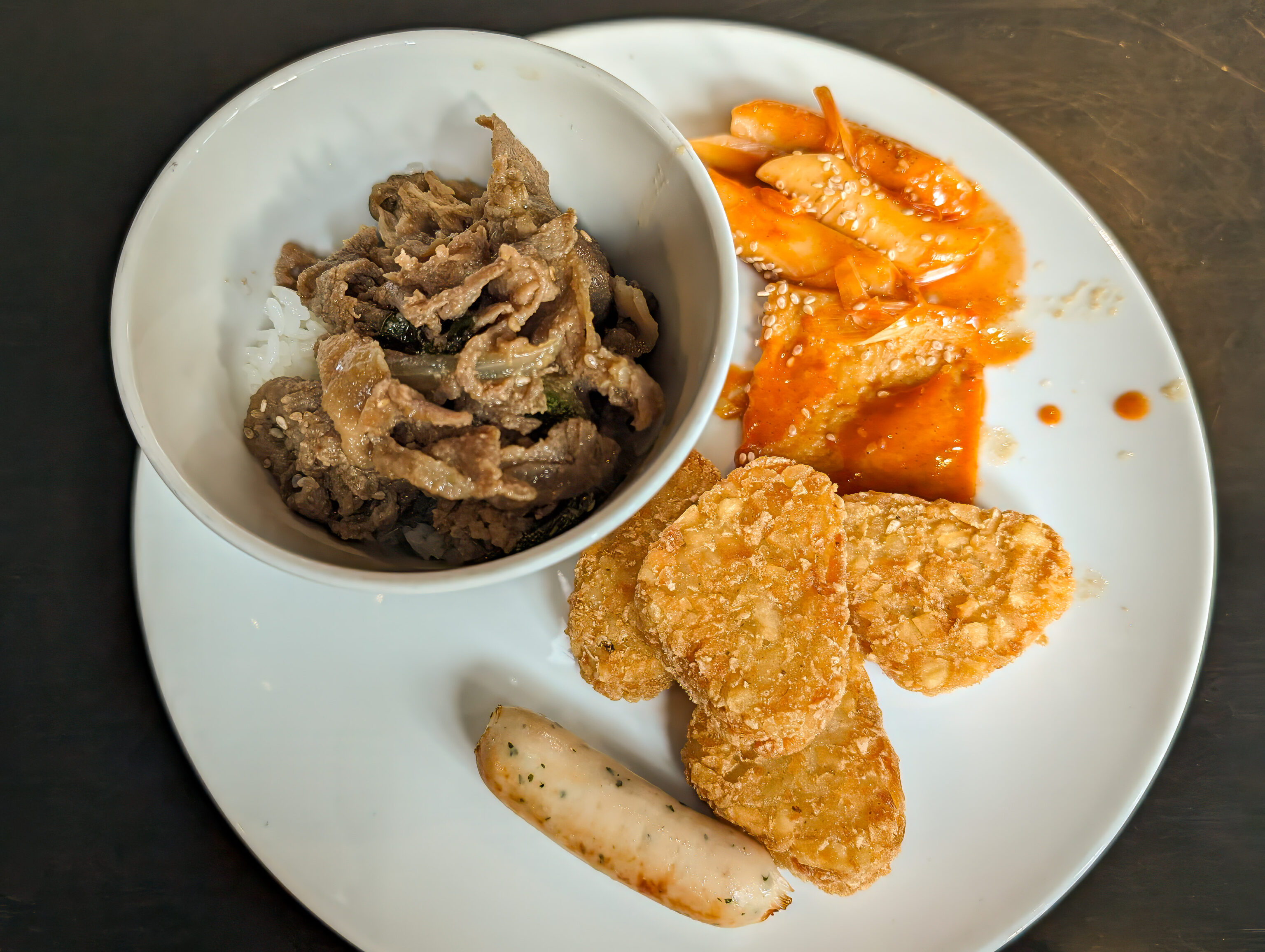
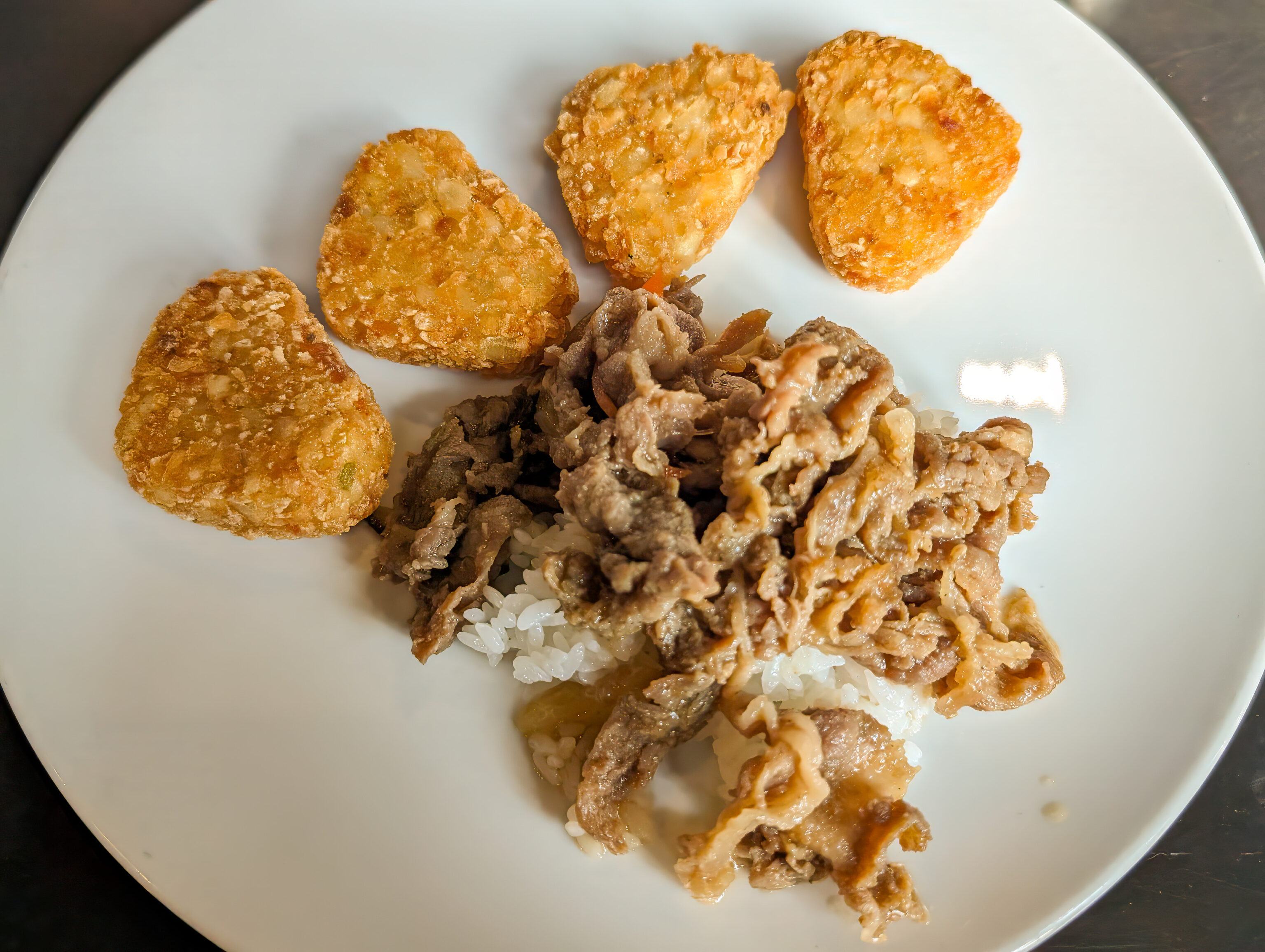
After waking up at the RYSE, we headed downstairs for breakfast. Bulgogi and hash browns, east meets west!
After breakfast, we headed to the subway station to travel to the 삼성 (무역센터) Samseong (World Trade Center Seoul) Station. The station’s Wikipedia page explains that although the pronunciation and written name in Hangul for Samseong is the same as Samsung, they are different words as their Hanja names are different.
The trip takes about an hour when traveling counter-clockwise on Line #2, the green colored circle line. It is also possible to go the opposite direction with the trip taking a little bit longer. We departed fairly late in the morning by our standards. But, it was still pretty early on a Saturday for the Koreans so it wasn’t busy at all for the subway ride.
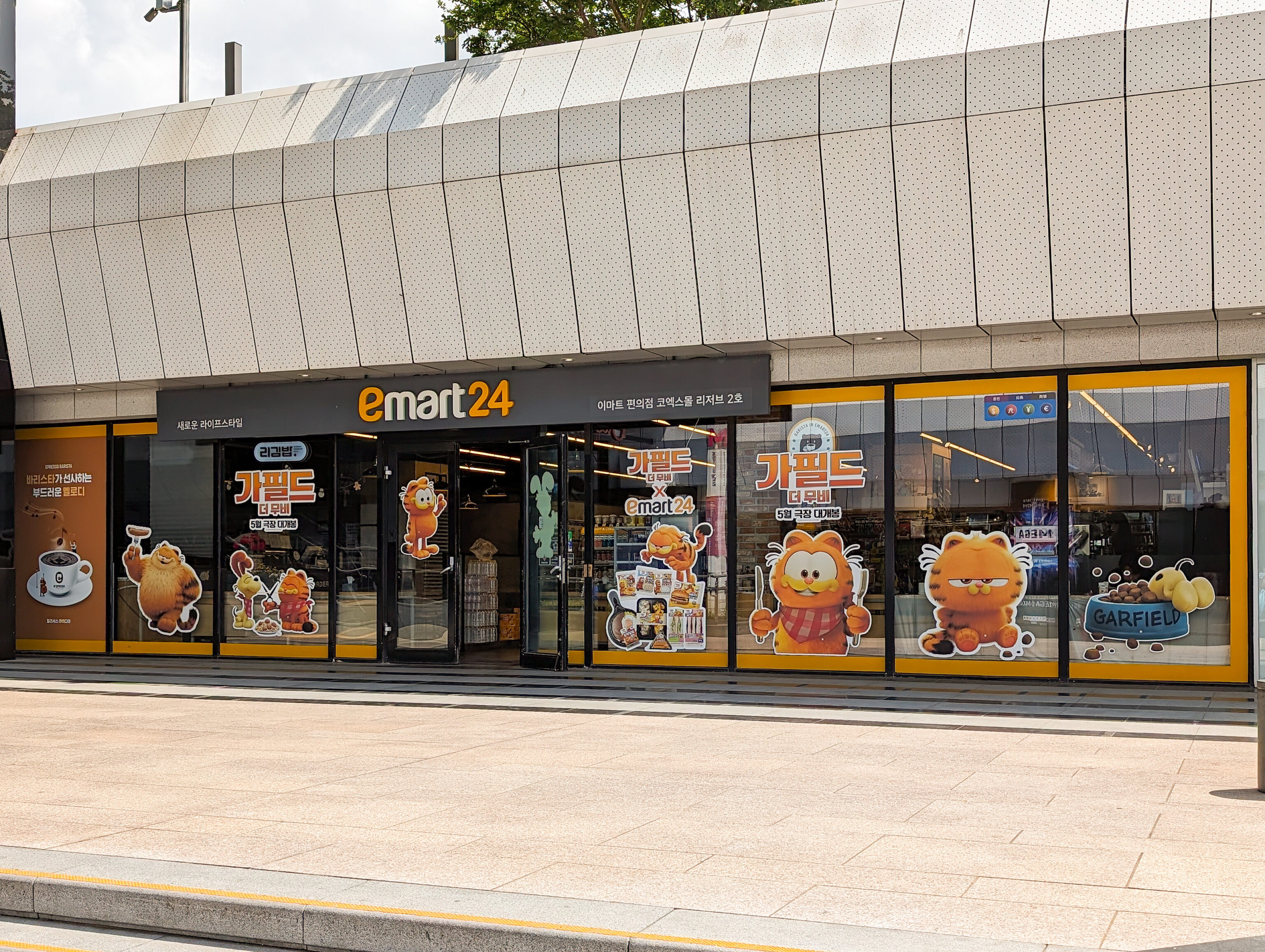
Upon arriving, we exited into an outdoor area between the station and the Starfield COEX Mall. We noticed this convenience store which had promotional window decorations for The Garfield Movie.
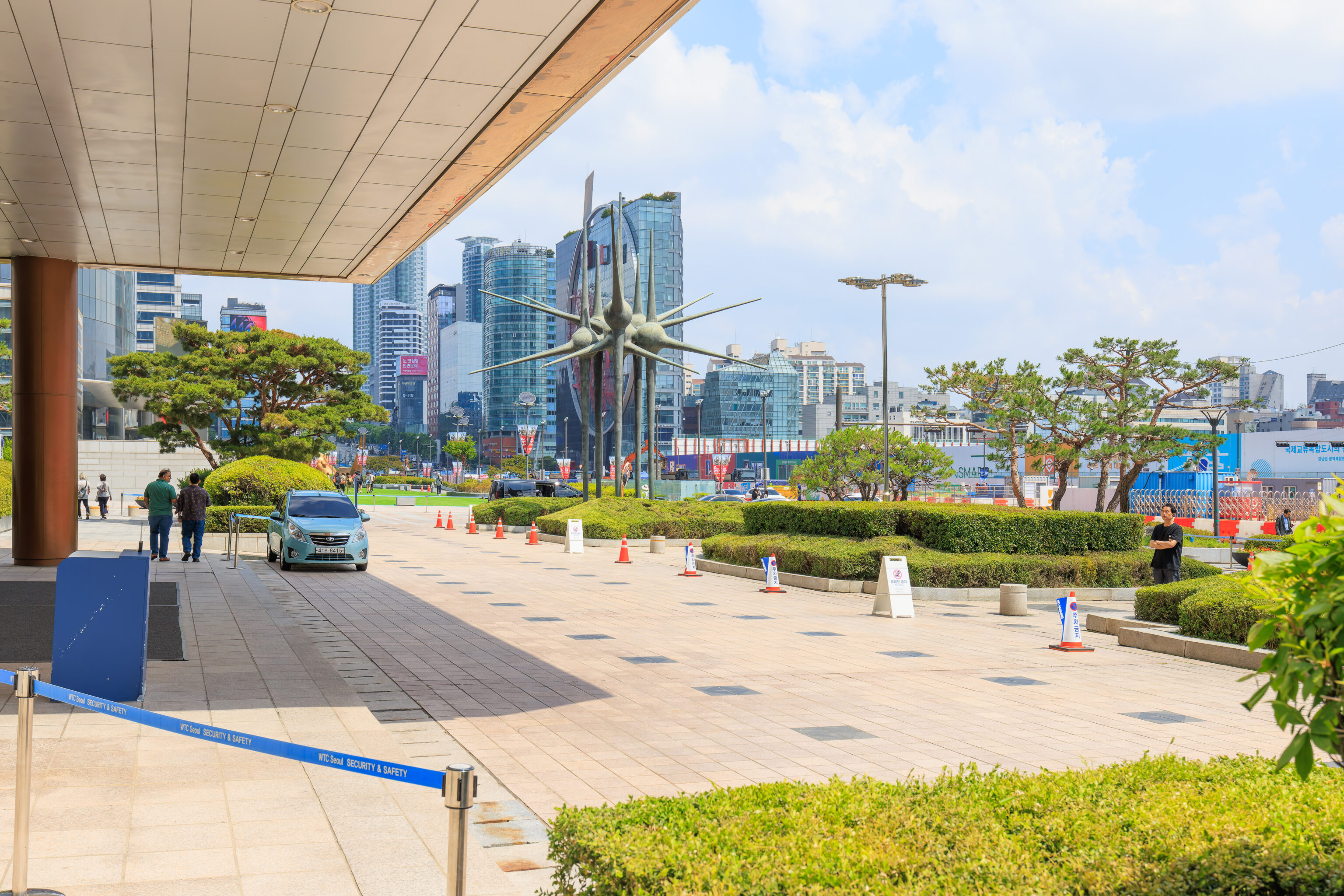
The COEX complex here is huge, consisting of a mall and convention center, which gives COEX its name – Convention & Exhibition Center, as well as a number of hotels and other buildings. We made our way to the east side and started walking to the north.
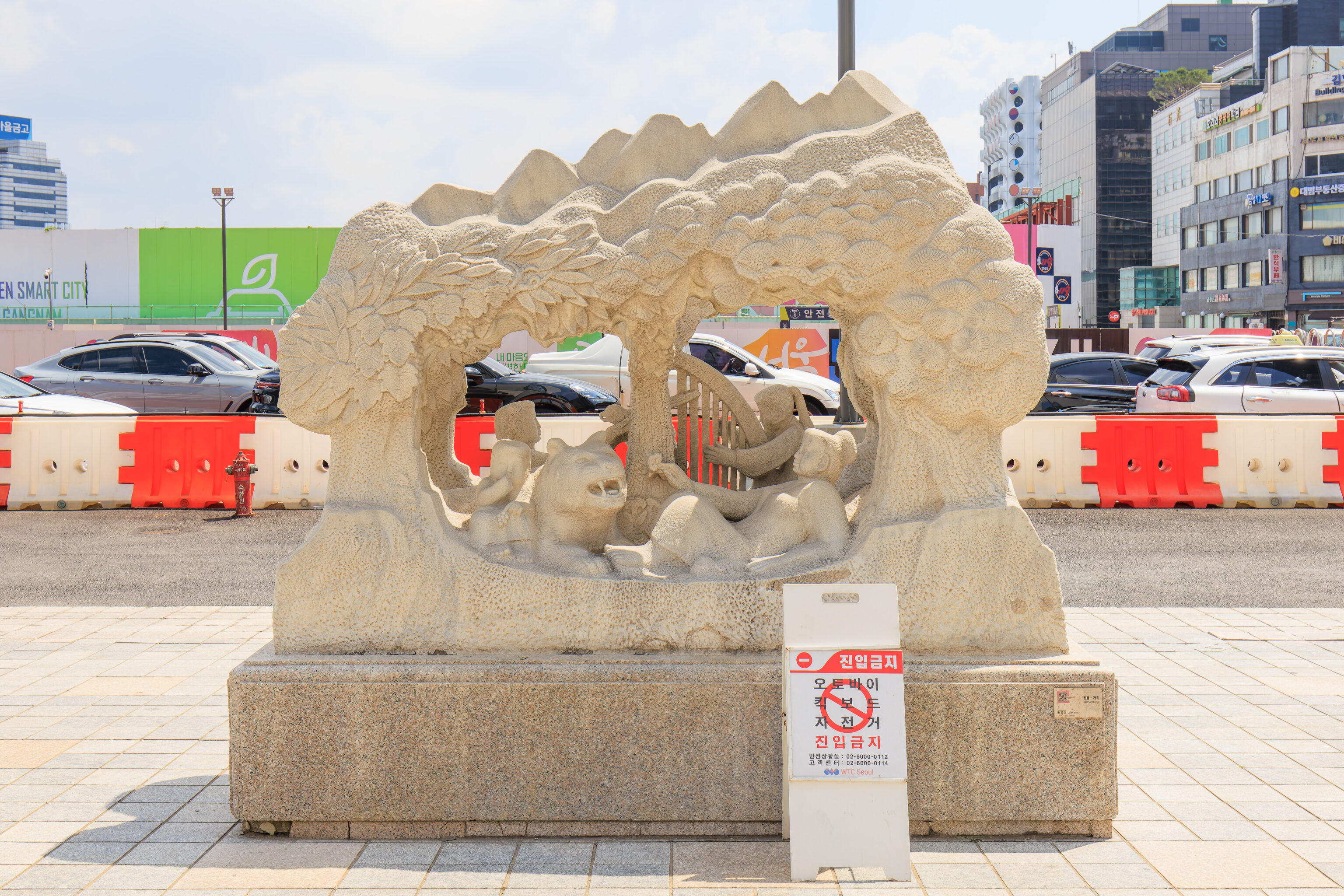
This sculpture reminded us of a European grotto. The tiny plaque on the base of the sculpture shows that it is 선경-가족 Fairy Land Family by 전뢰진 Loi Jin Jeun. It turns out to be a bit difficult to Google for in English but in Korean, there is a helpful Naver blog post about it. It translates well into English.
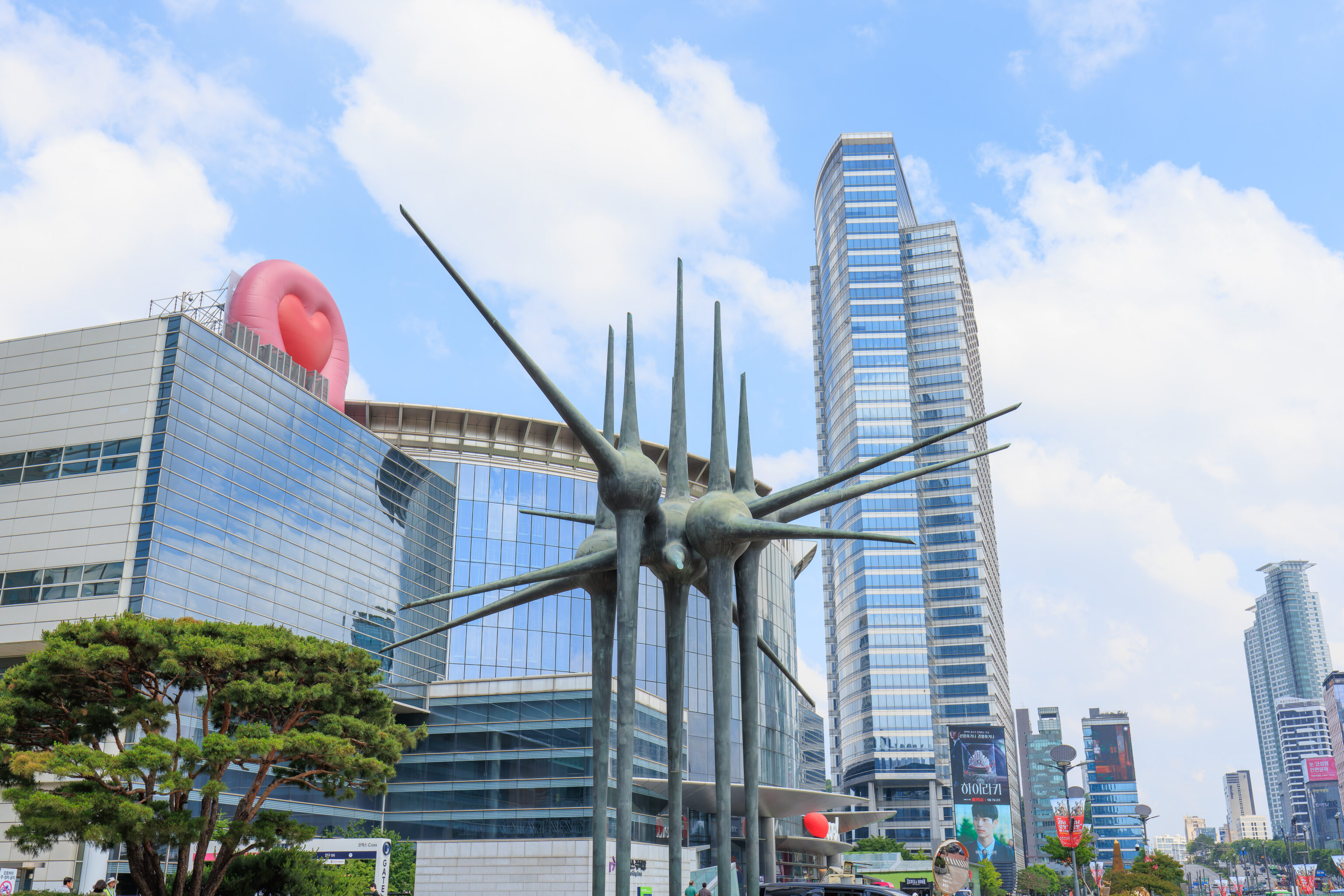
We walked past this spikey sculpture. Also of interest, there is a giant inflatable heart atop one of the nearby buildings!
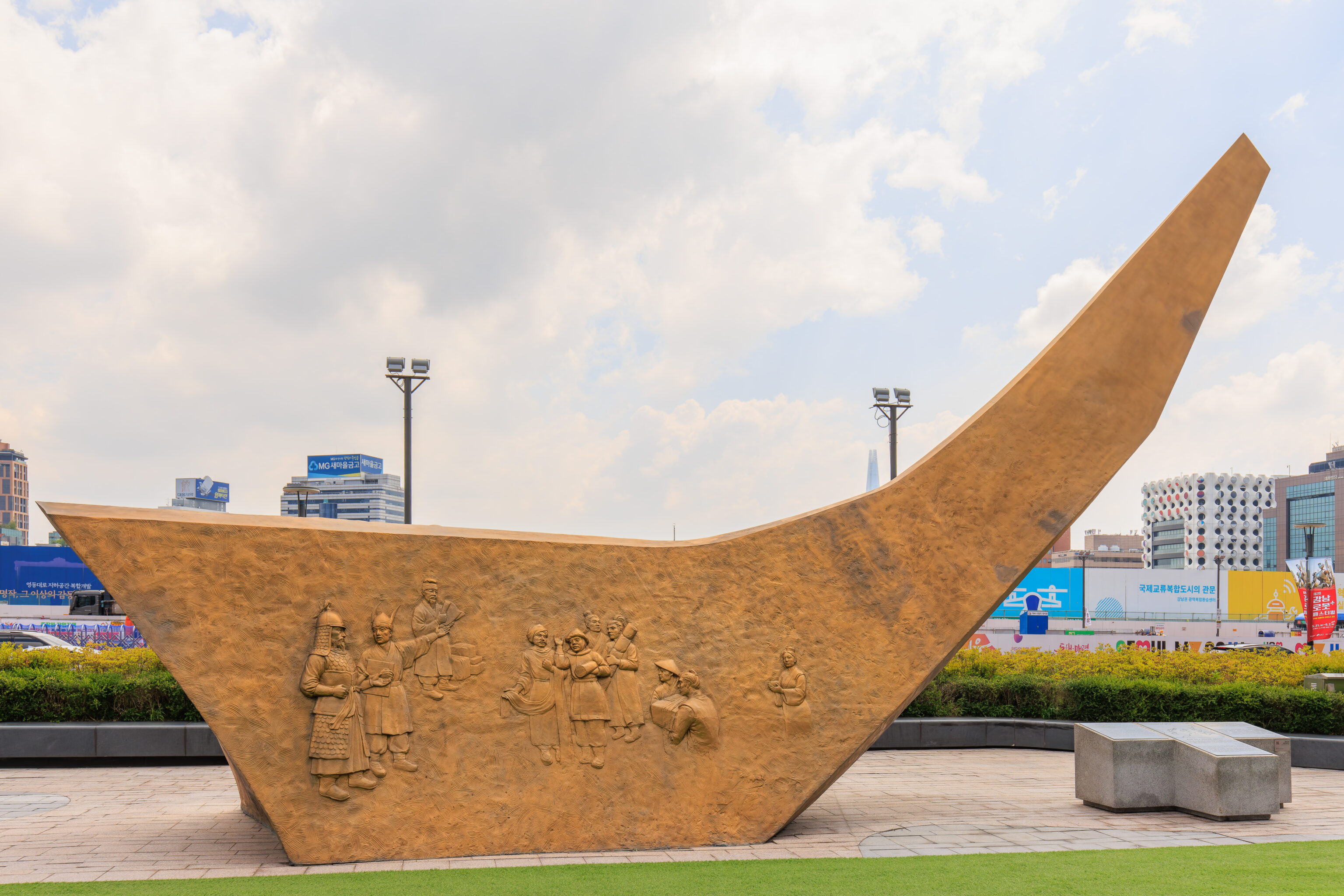
This sculpture probably has something to do with Korean history. Maybe we should have checked out the T shaped stone to the right which has writing on it, possibly in both English and Korean. But, we continued on as we were right next to our first destination!
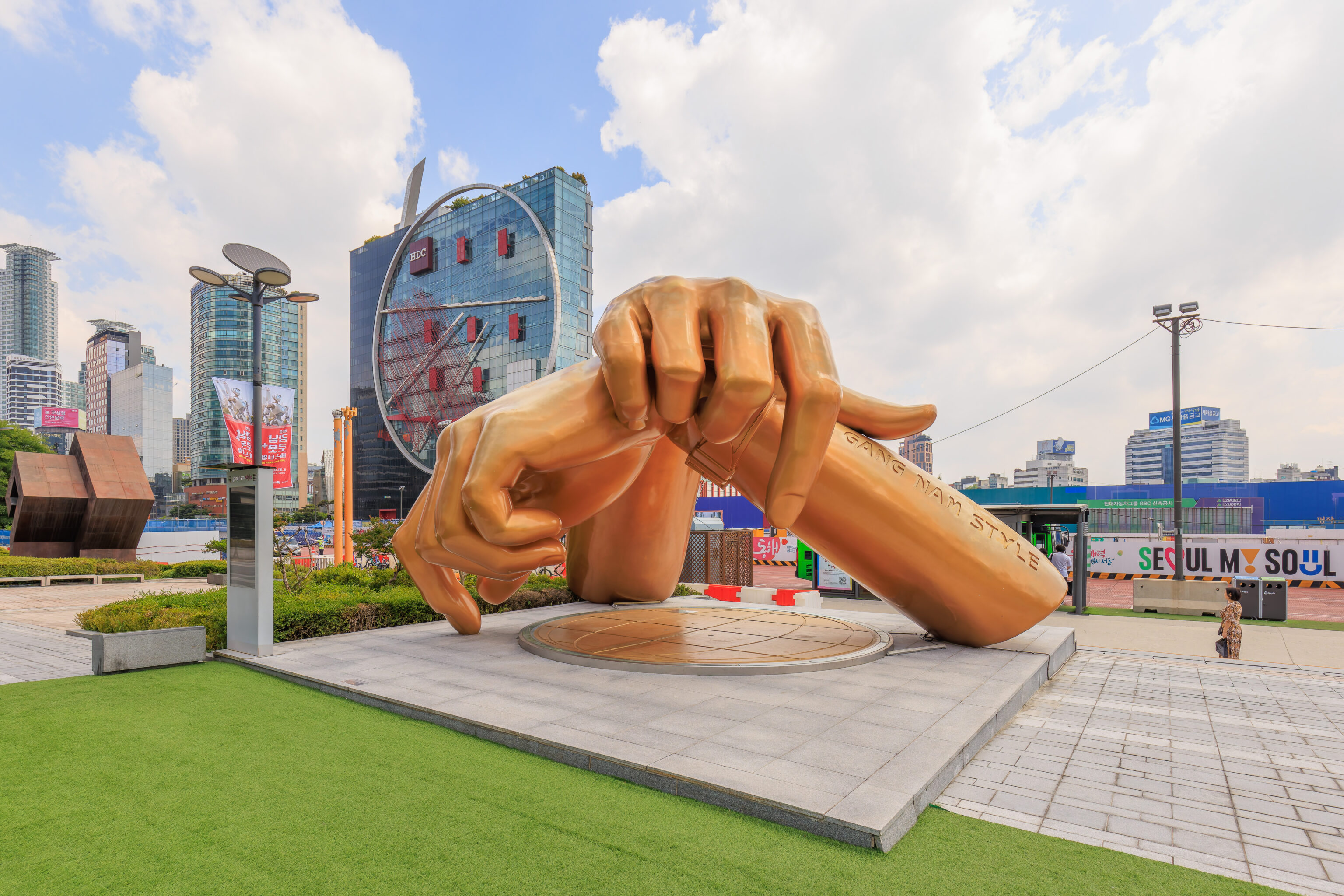
These two hands, of course, represent Psy‘s Gangnam Style. This landmark is where we decided to meet up with our friends as it is an easily identifiable location. The area here is generally pretty confusing, particularly indoors.
Gangnam Style is currently just the 10th most viewed video on YouTube at 5.24 billion views.
After our friends arrived, we, of course, did take a photo with the sculpture. It almost seems mandatory!
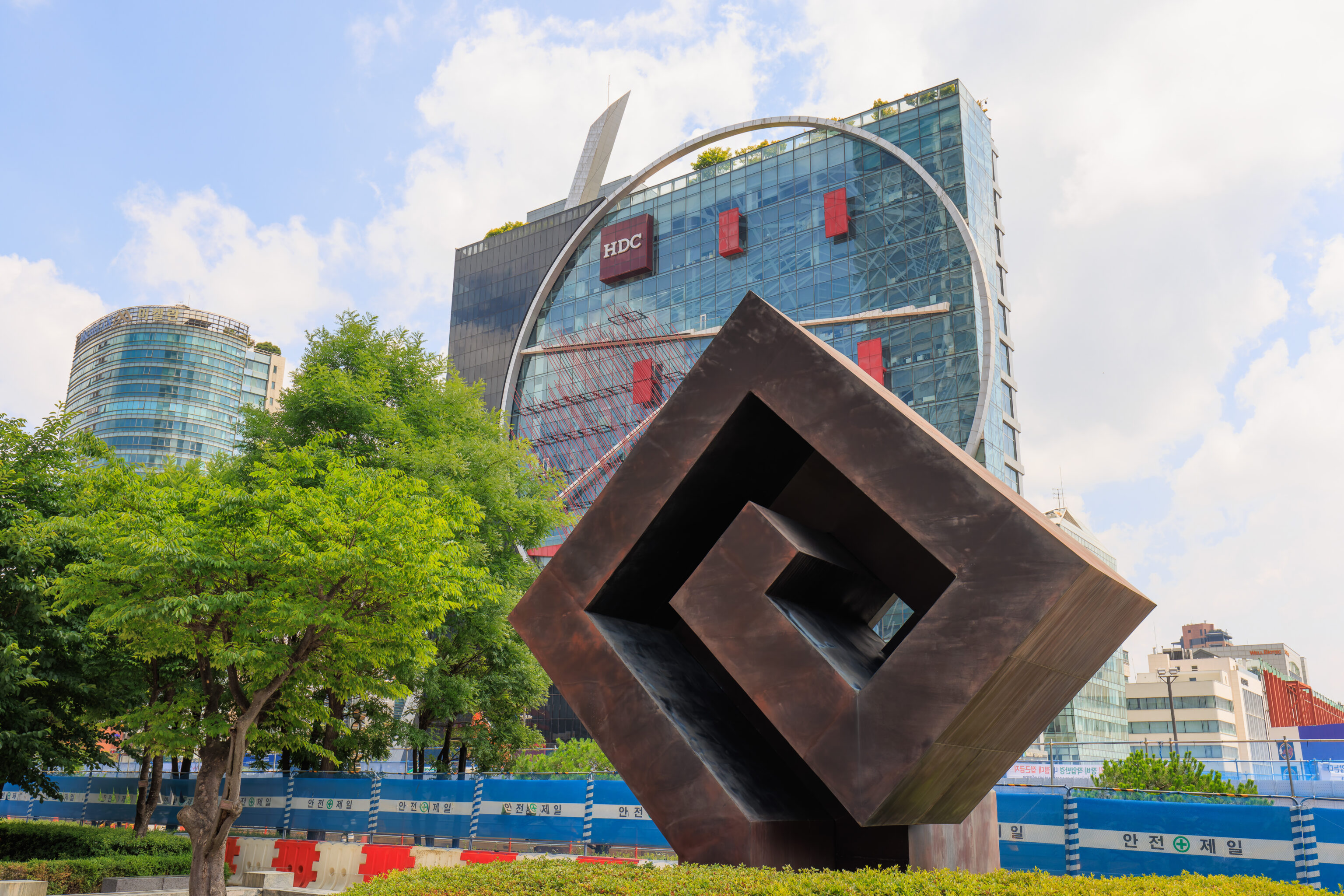
We continued north past the Psy hands. Not sure what this sculpture represents! It seems a bit like it should be a corporate logo?
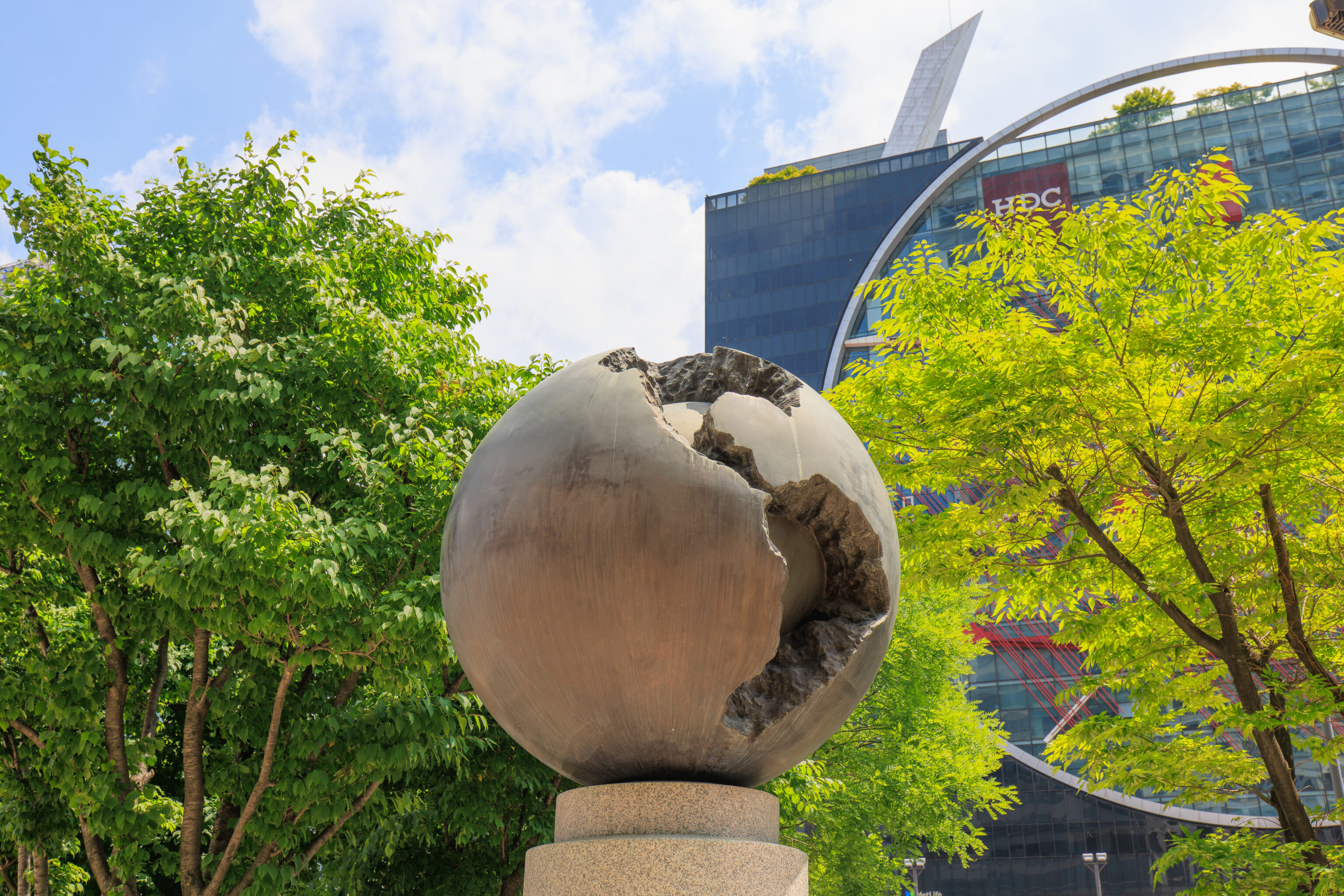
At first glance, this globe almost seems like it has a big gash in it, like The Sphere after 9/11. However, it does seem to simply be a globe. The side facing is is the Americas.
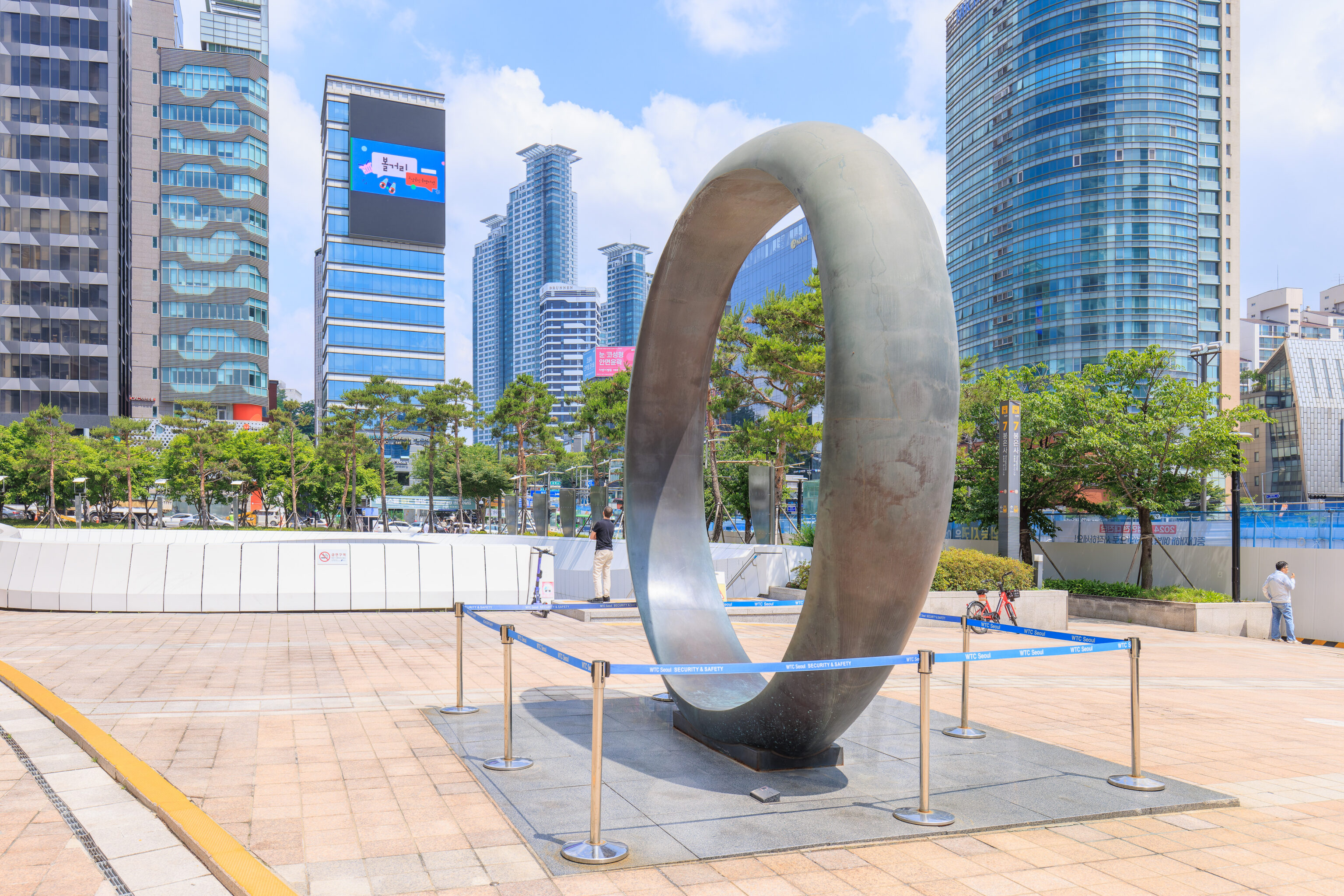
One ring to rule them all… And in the darkness bind them. That’s probably not what this is.
Bongeunsa
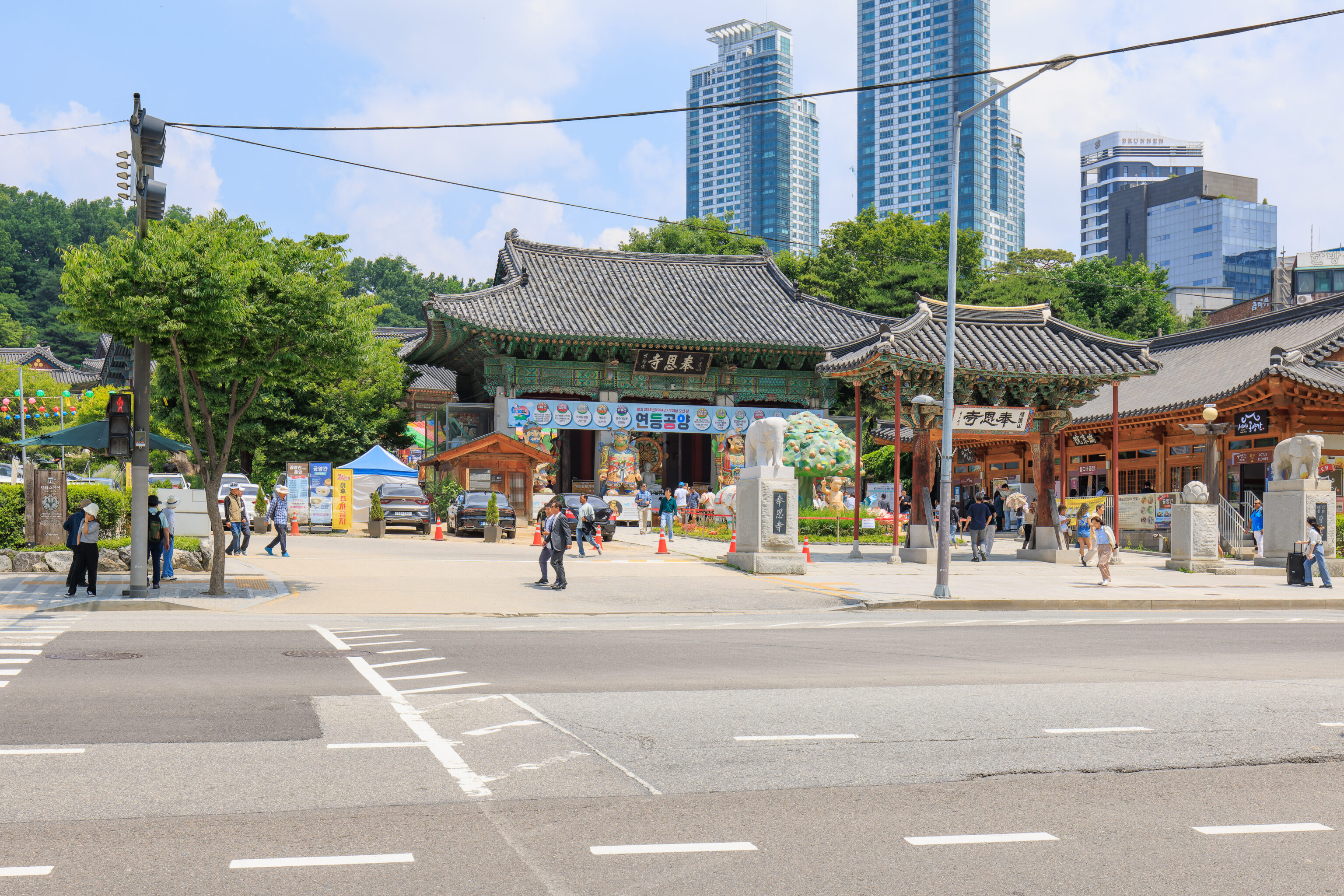
We walked north until reaching the next cross street. The main entrance to 봉은사 Bongeunsa was on the other side.
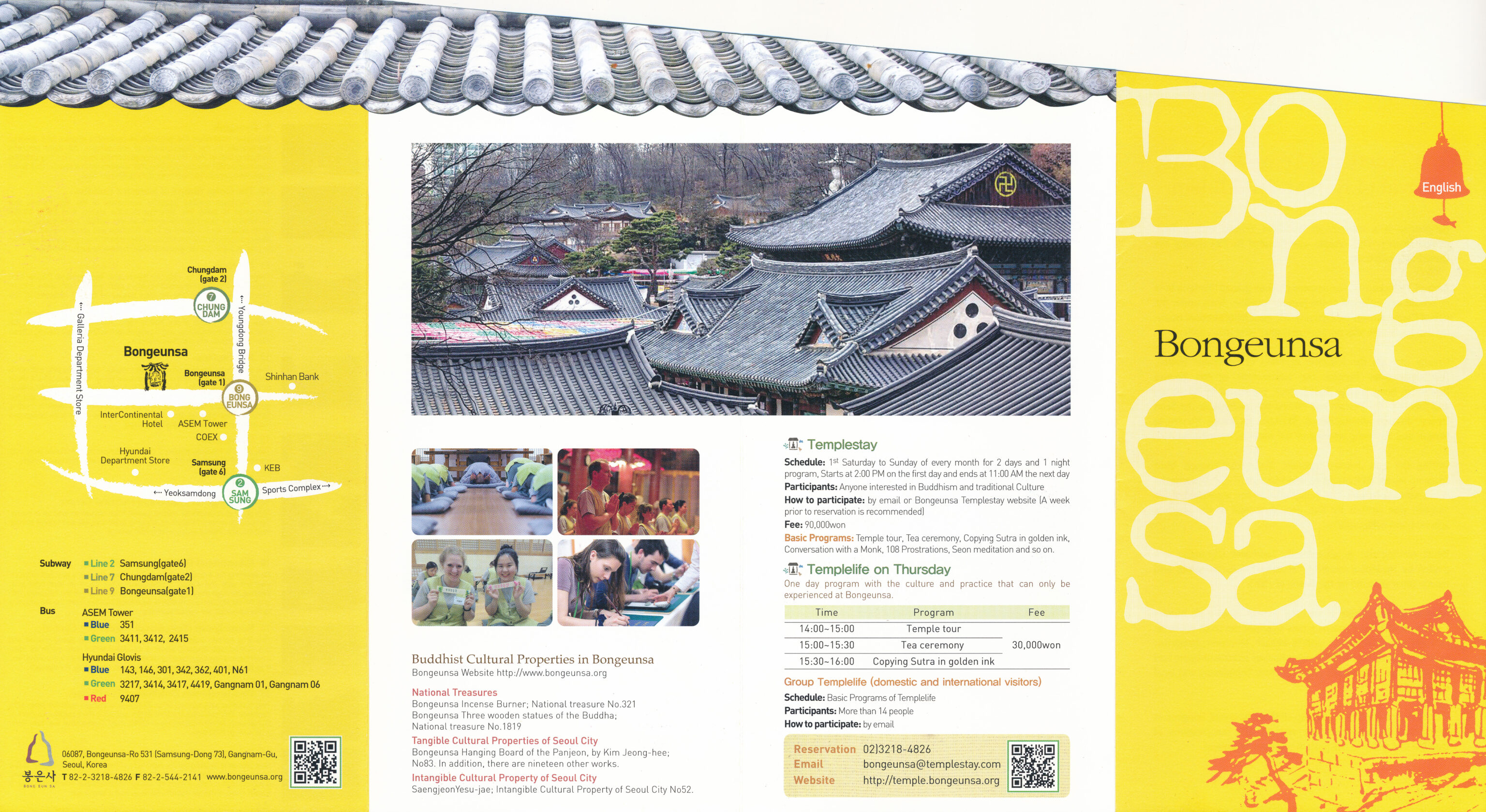
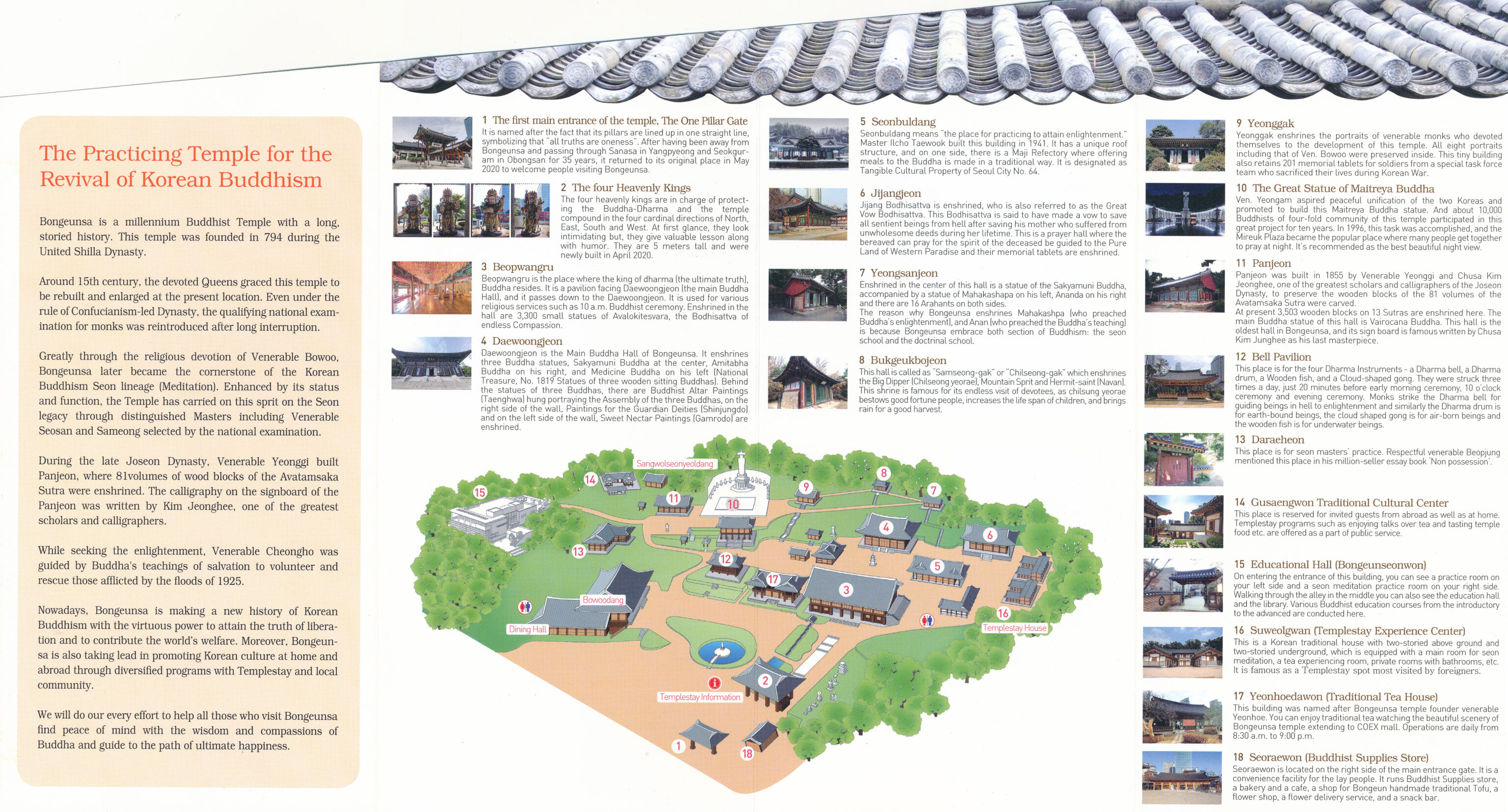
We picked up a pamphlet with map.
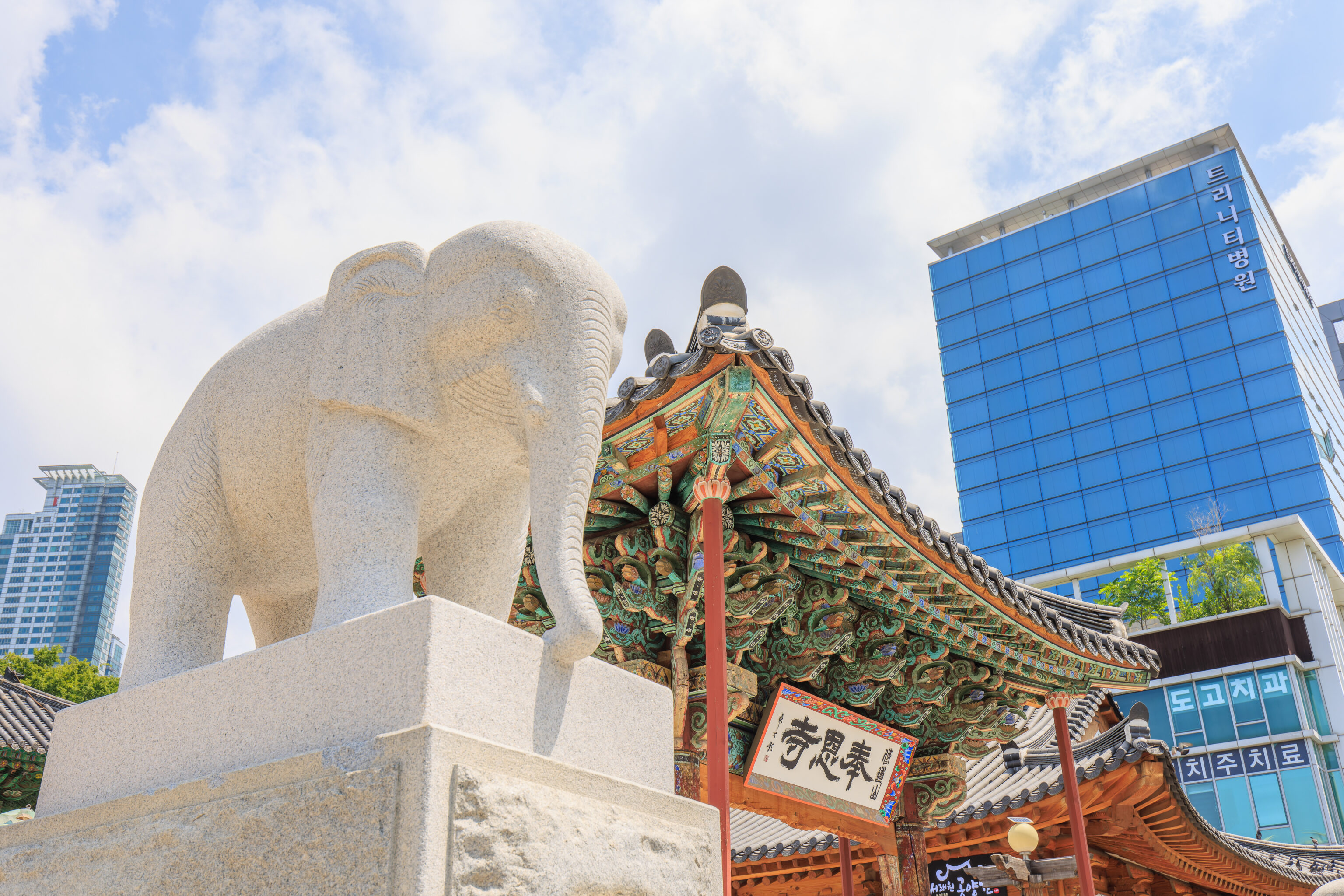
A pair of elephants, one of which can be seen here, flanked the first gate to the temple.
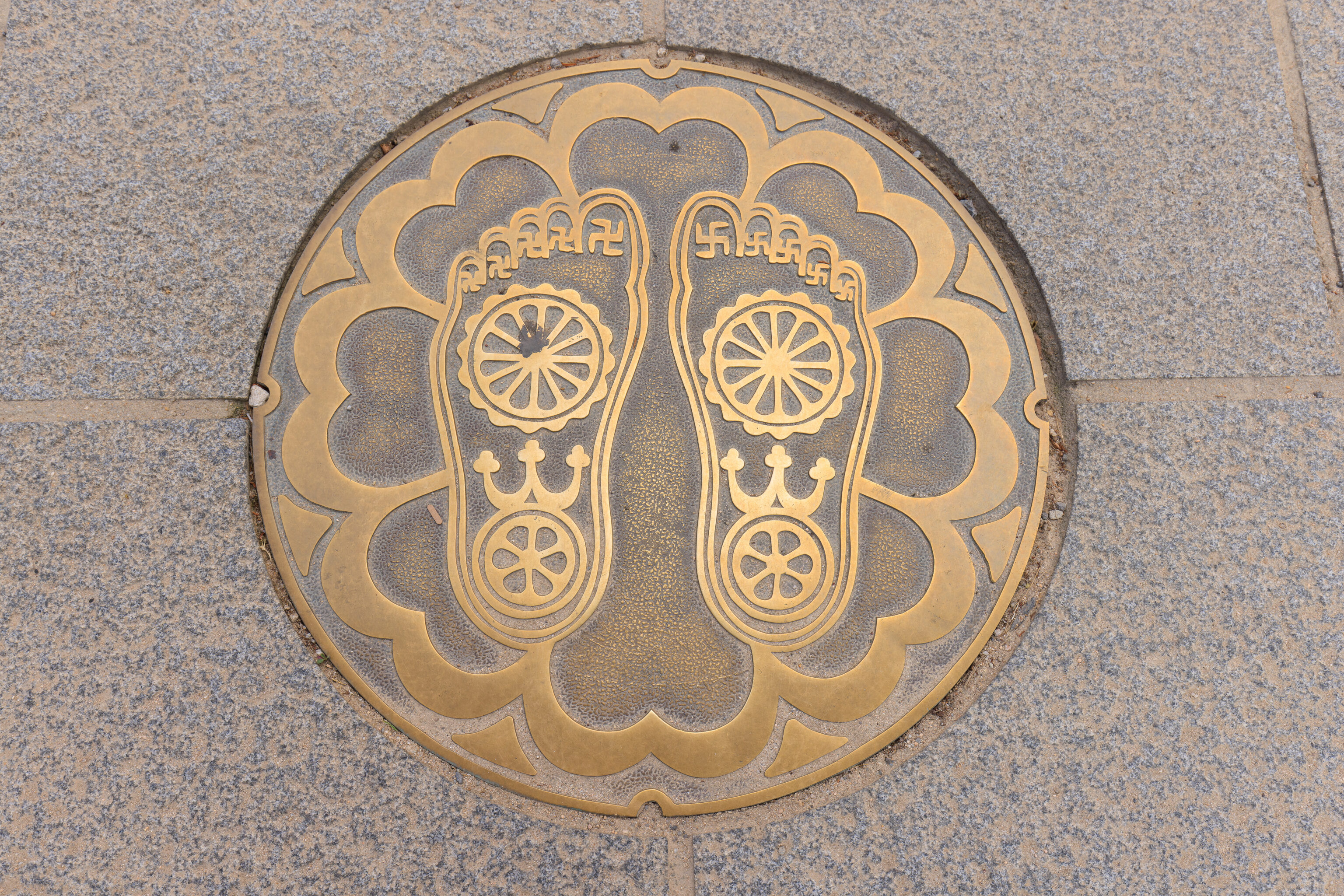
We saw a pair of Buddha’s feet on the ground. A Naver blog entry explains this as a place to stand to pray. The circular copper plate is described as depicting the “Eightfold Path, the Dharma Wheel.”
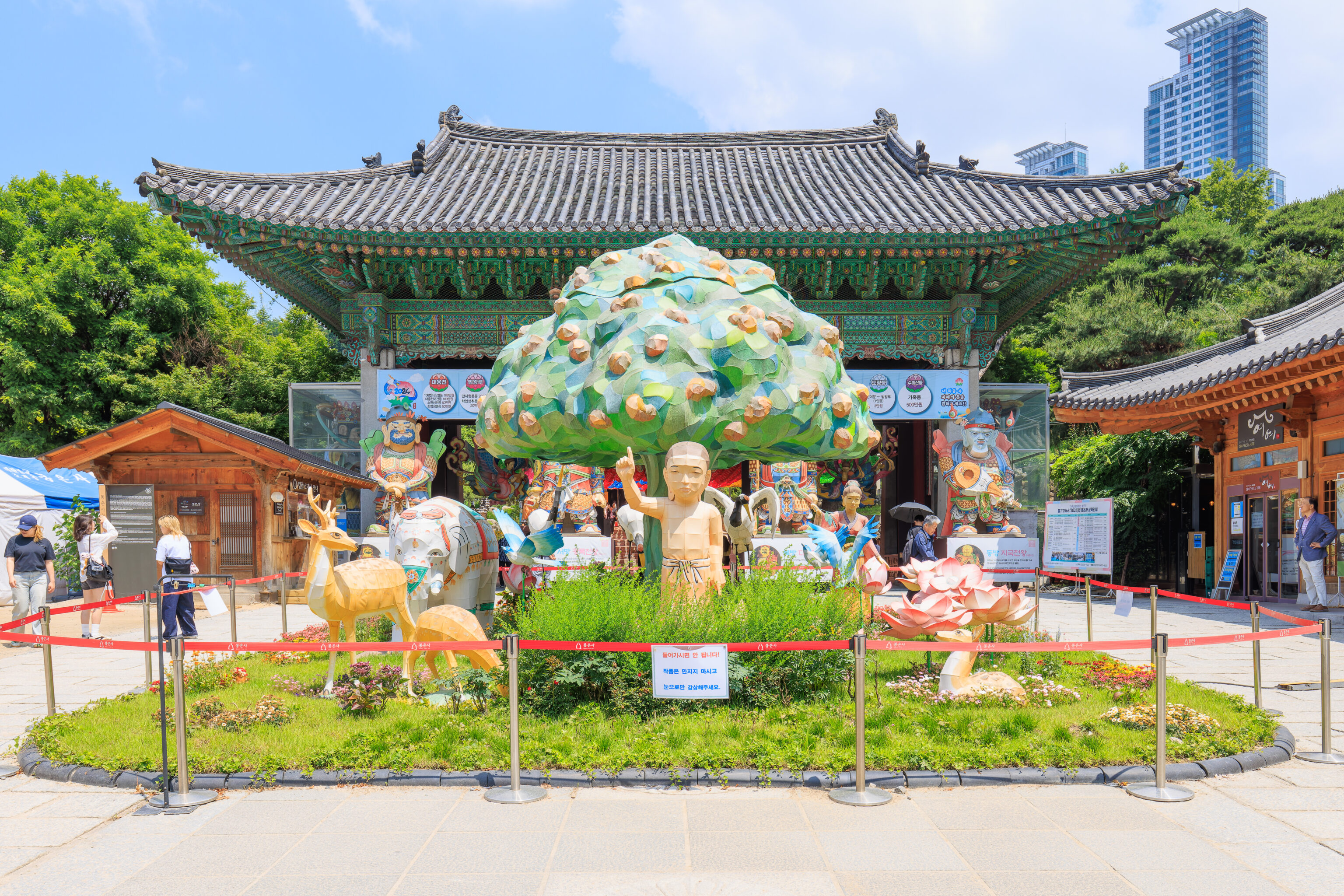
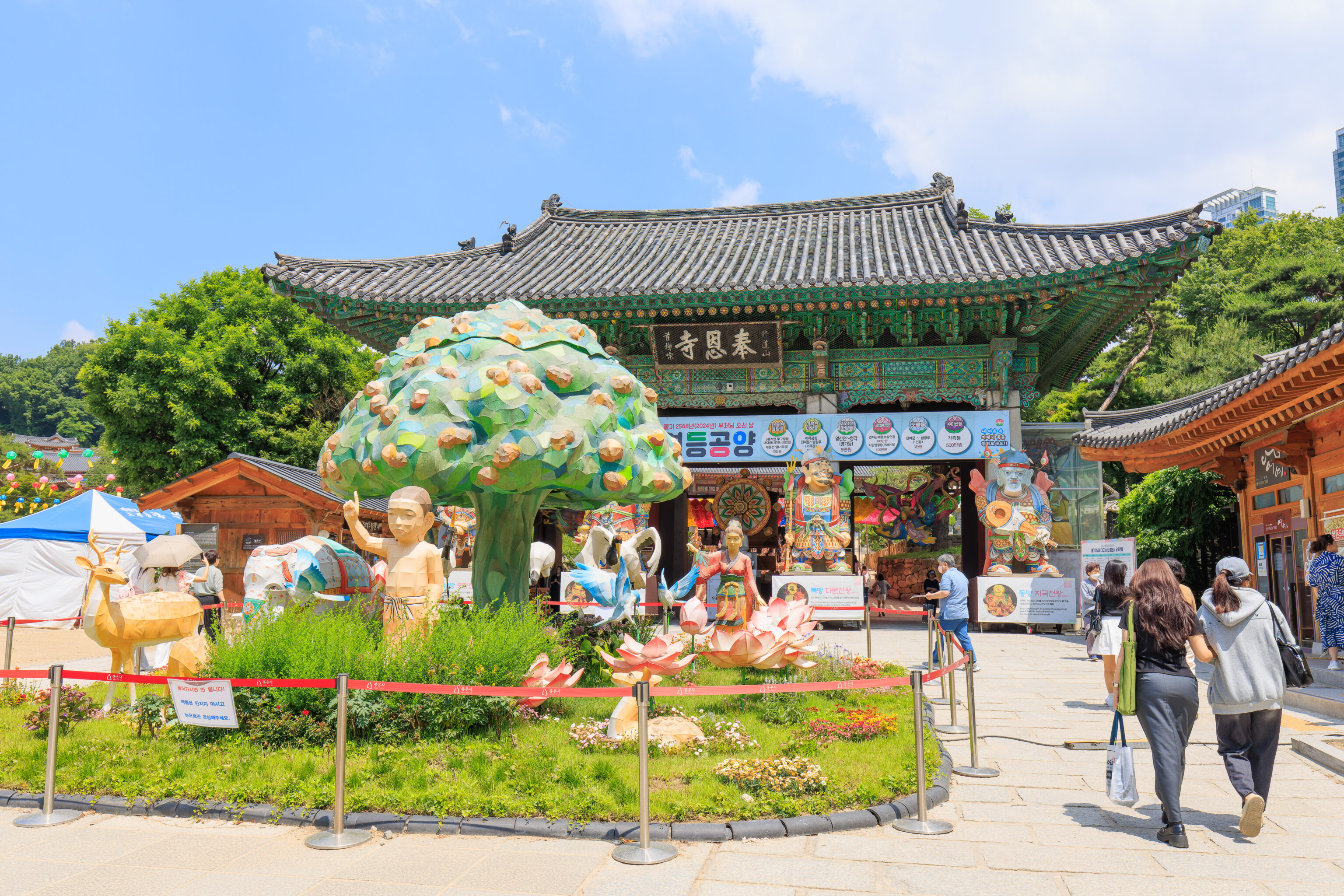
Just beyond the gate, we saw some decorations. They seem a bit like paper mache from a distance.
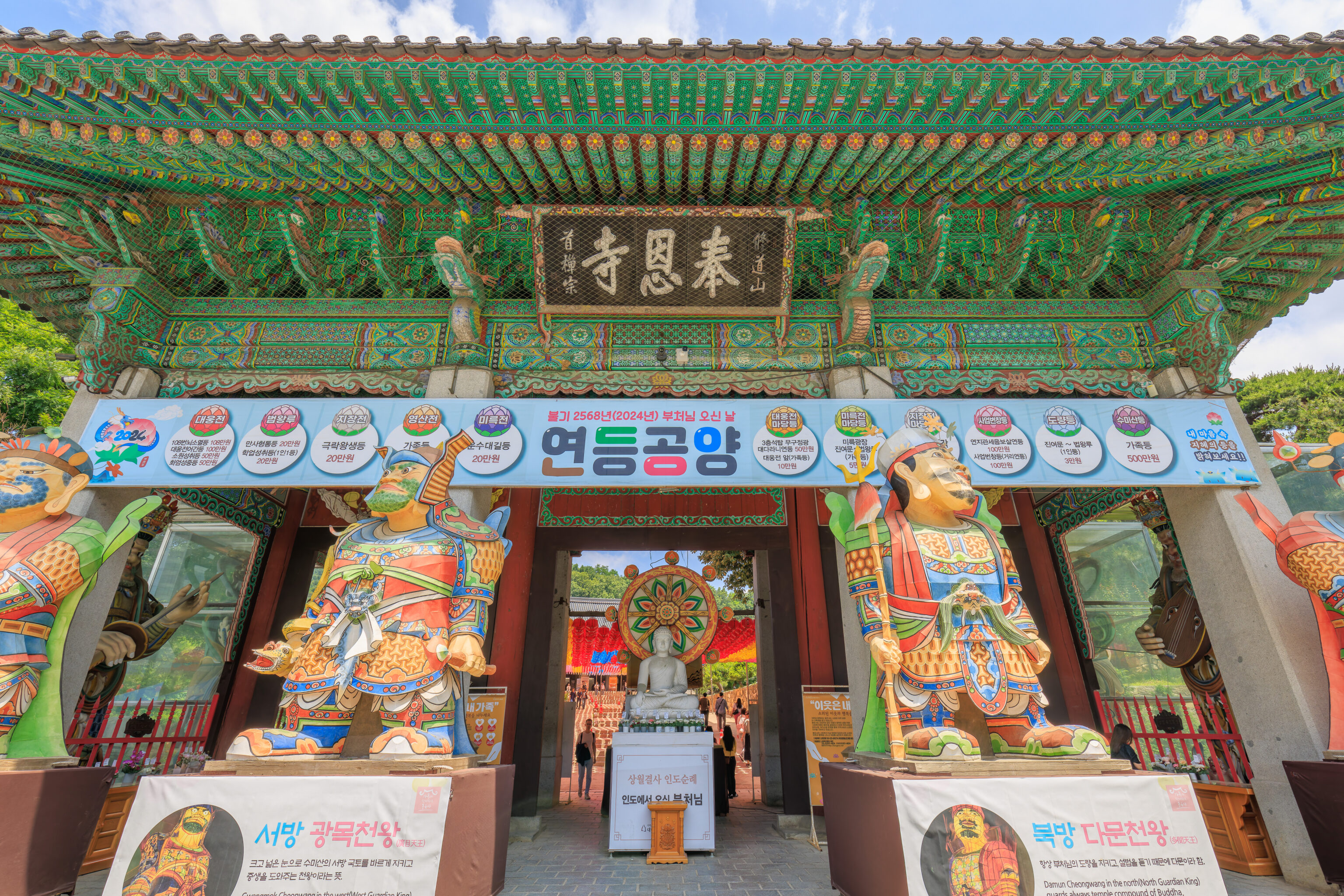
This next gate is much bigger than the first one. This may be somewhat equivalent to a Japanese sanmon?
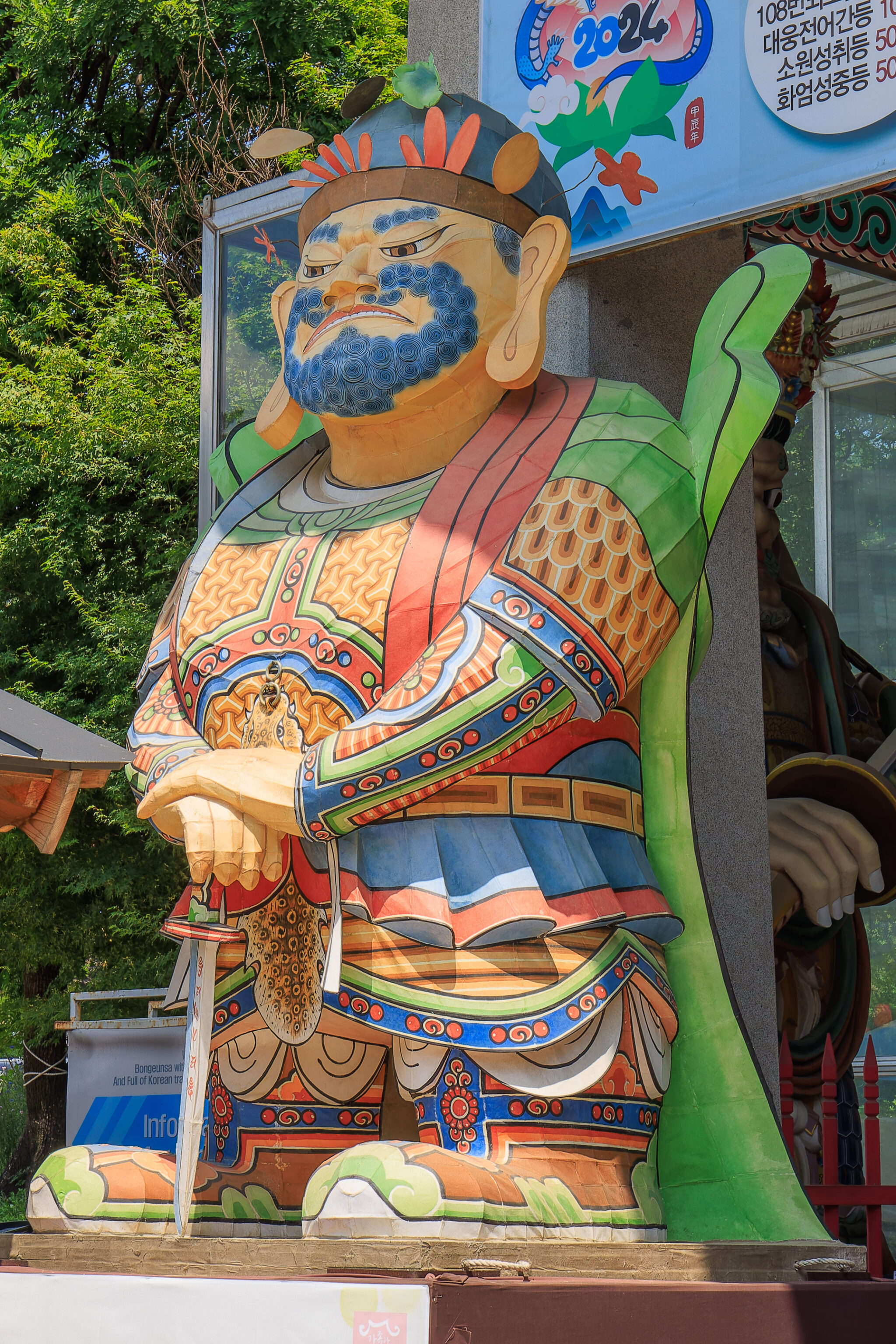
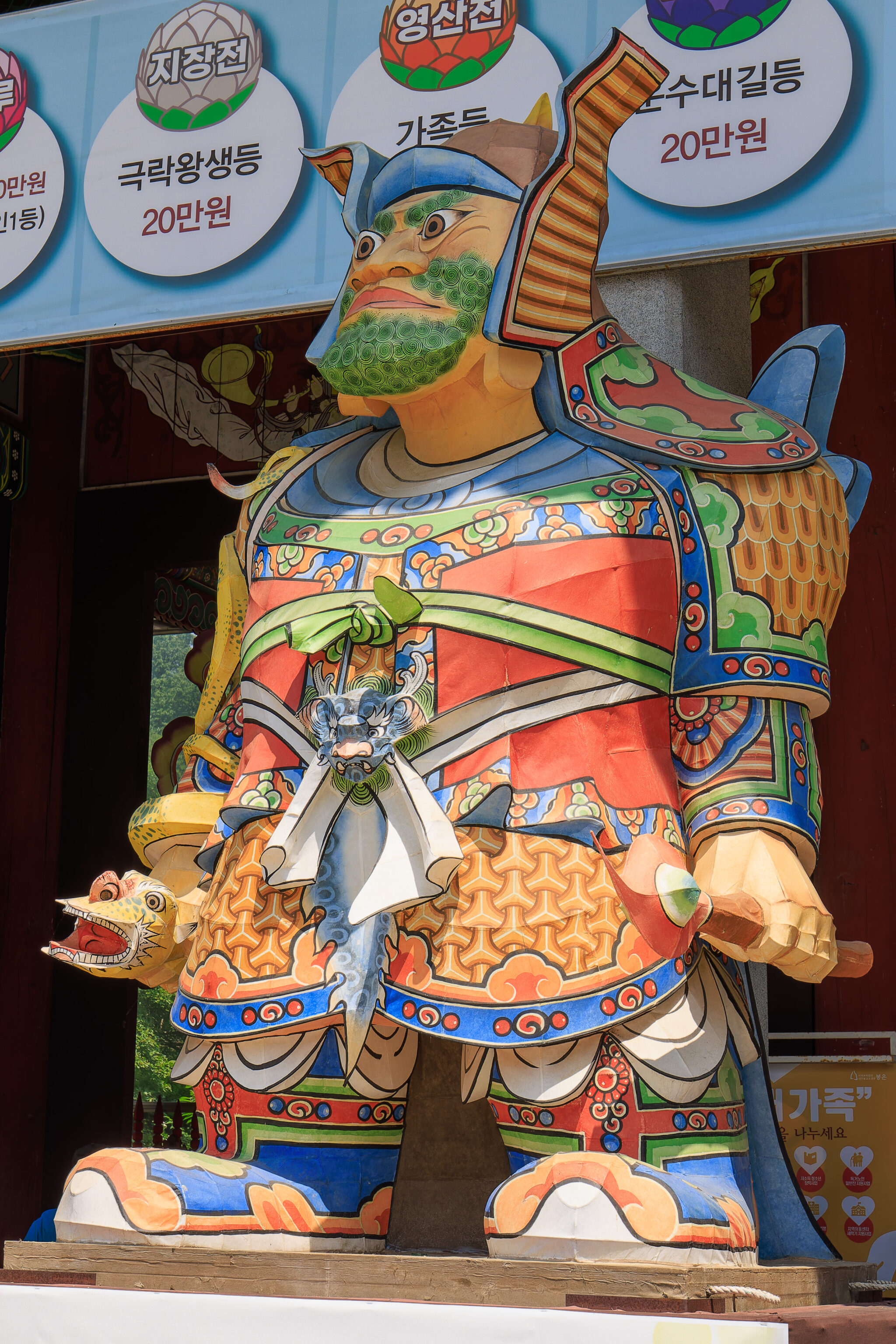
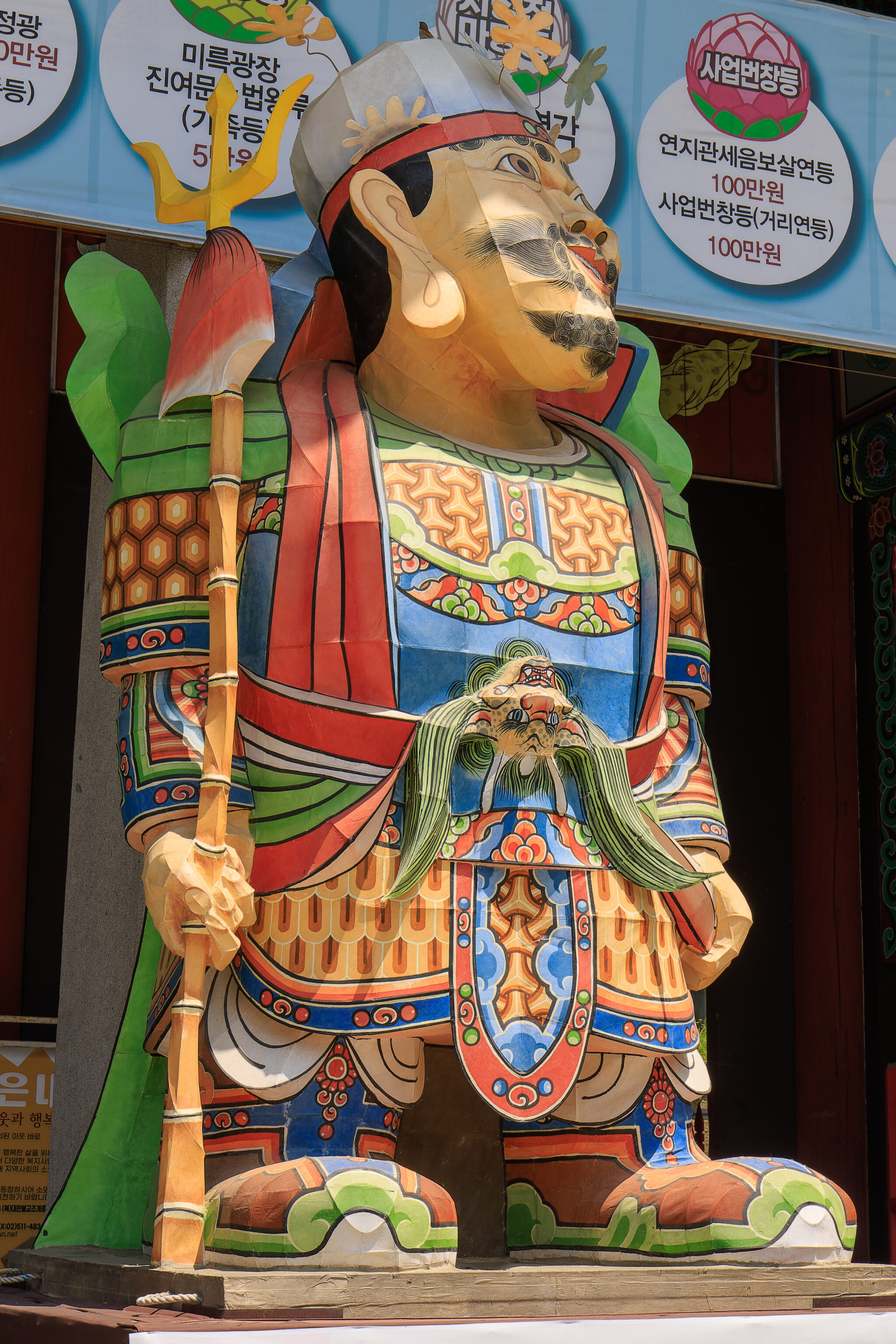
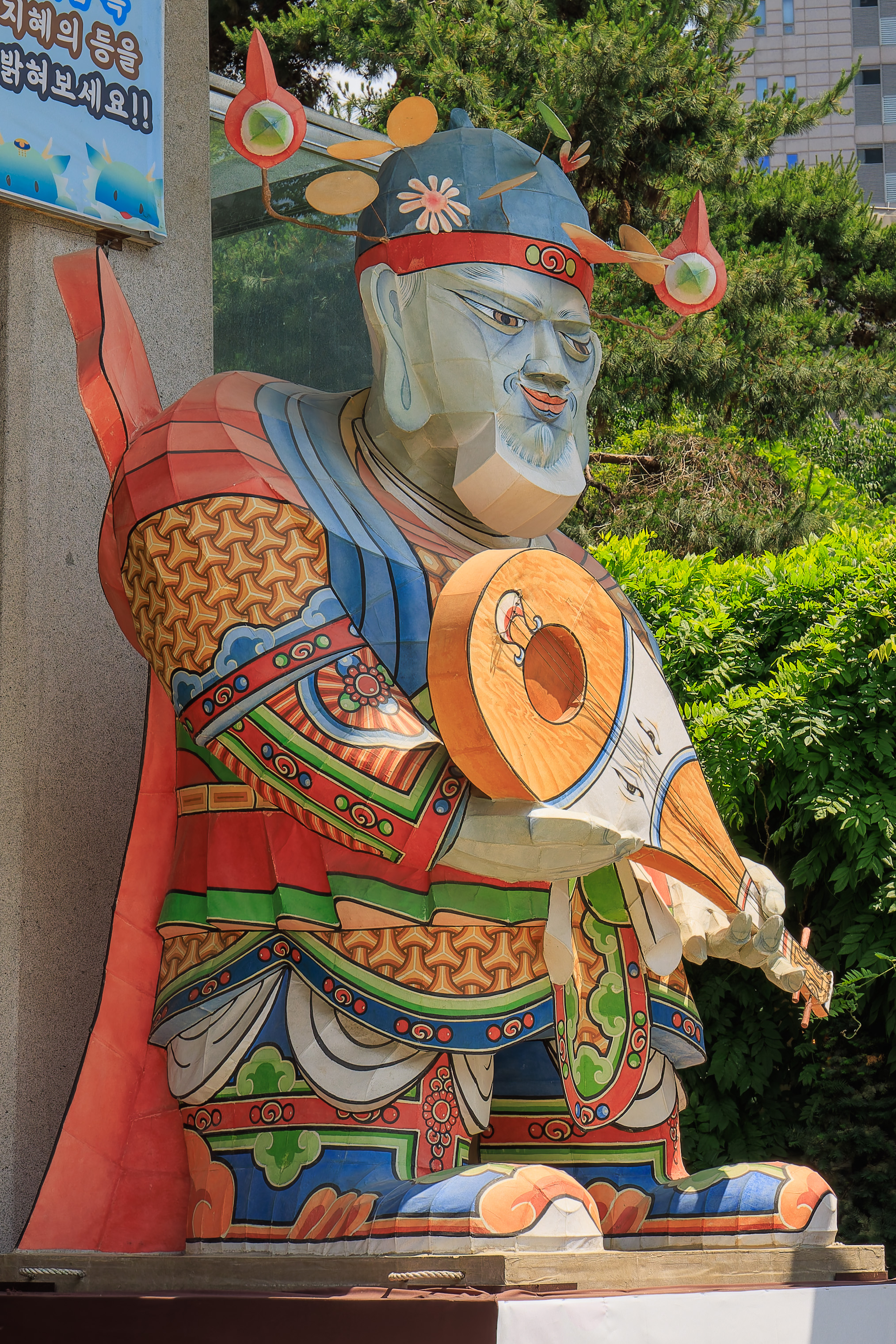
The four figures in front of the gate are the Four Heavenly Kings. We’ve seen them before at Japanese Buddhist temples. These Korean versions appear very different and are rather colorful!
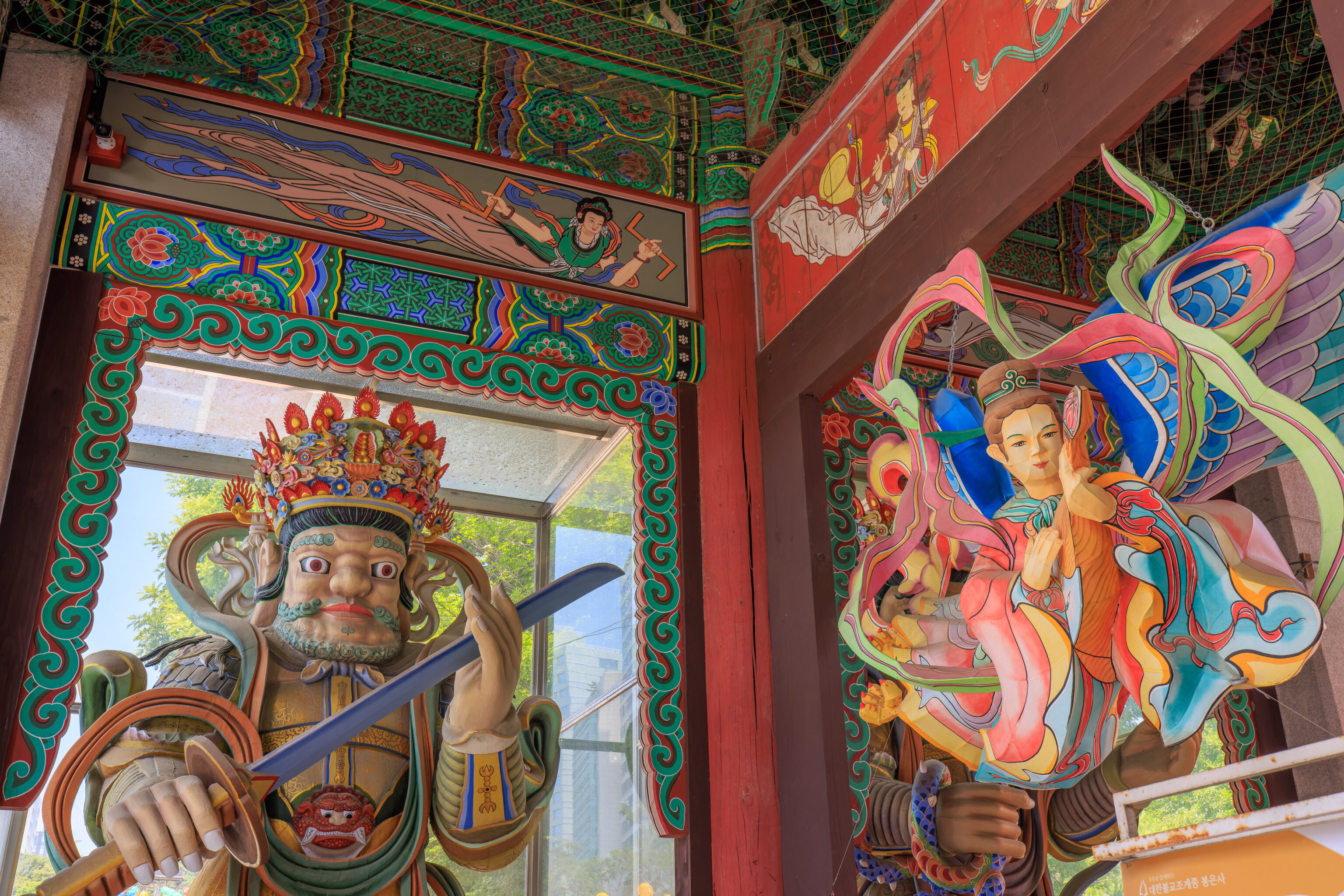
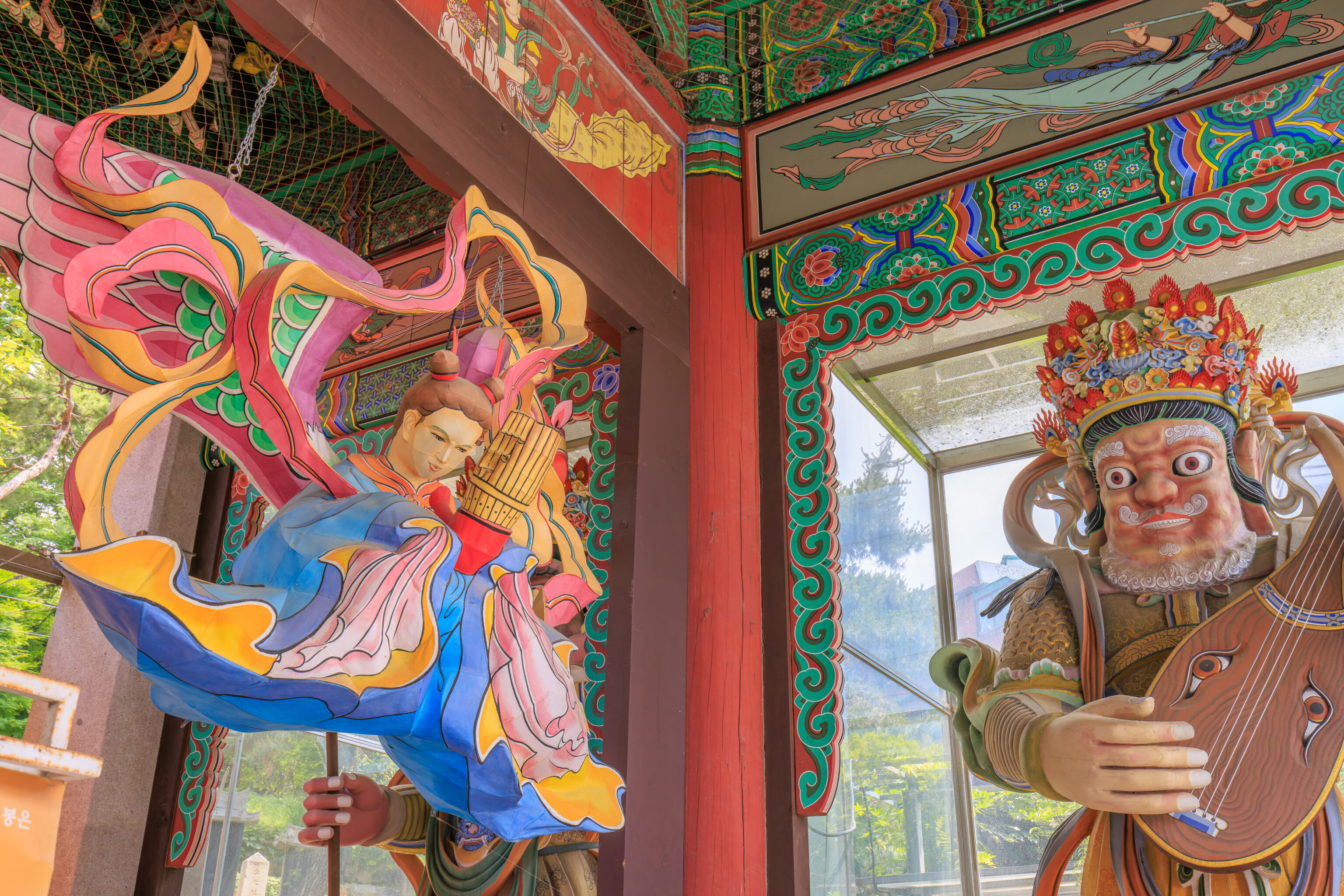
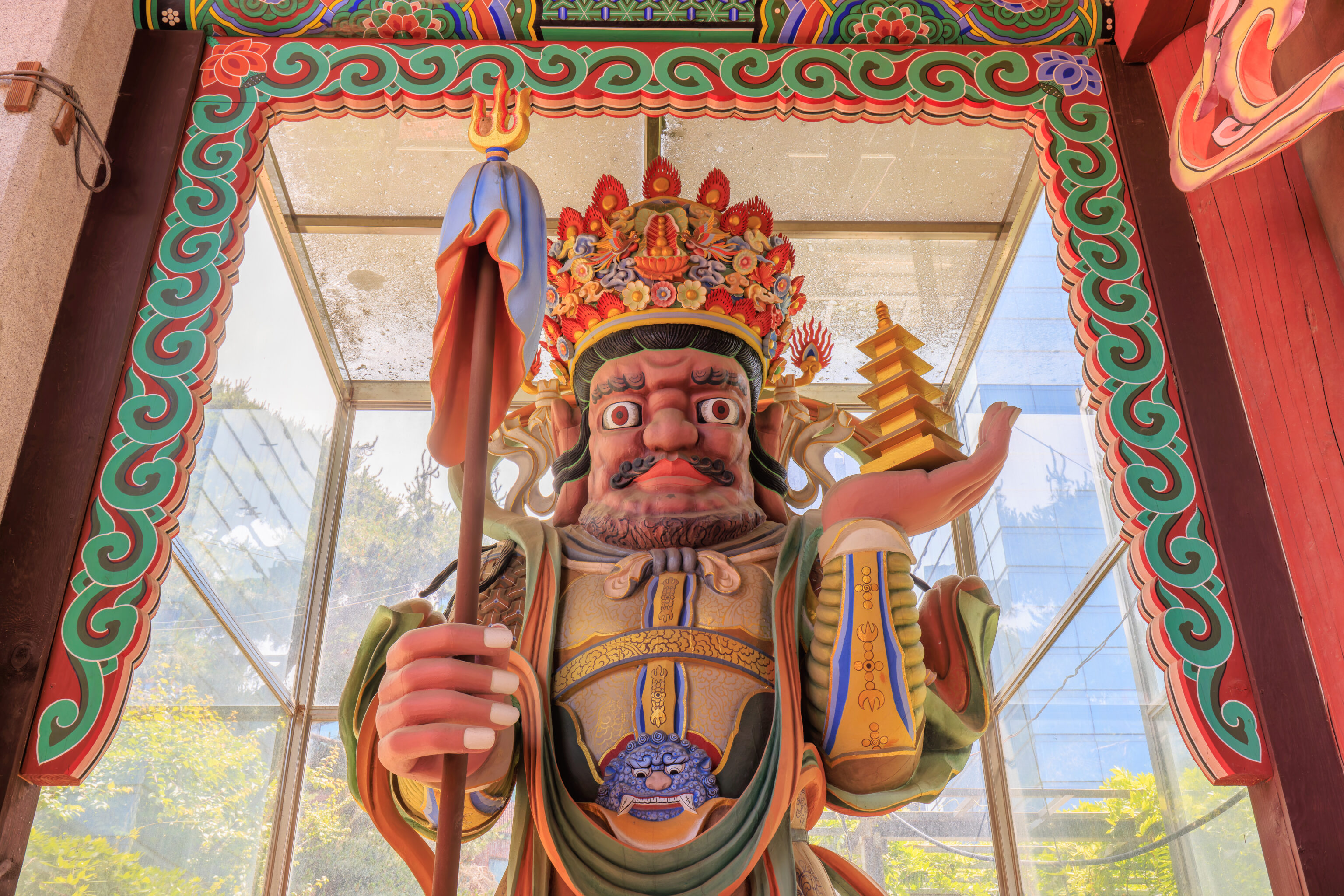
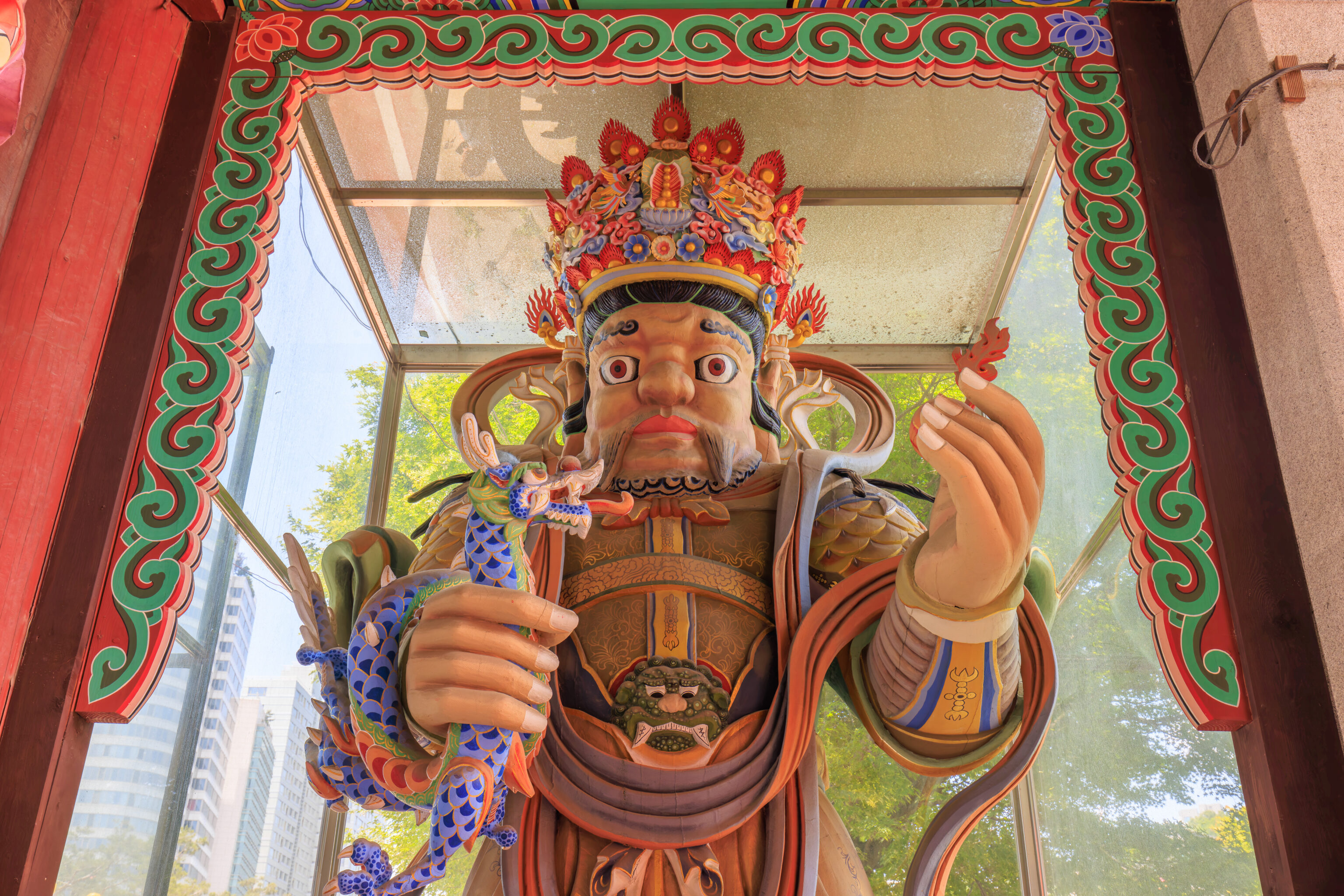
There are more colorful statues inside. Some of these decorations may be for Buddha’s Birthday, which is a national holiday in Korea. It is based on the lunar calendar and took place on May 15th, so not too long ago. The four large statues seem to be of the Four Heavenly Kings and might be permanent features of this gate.
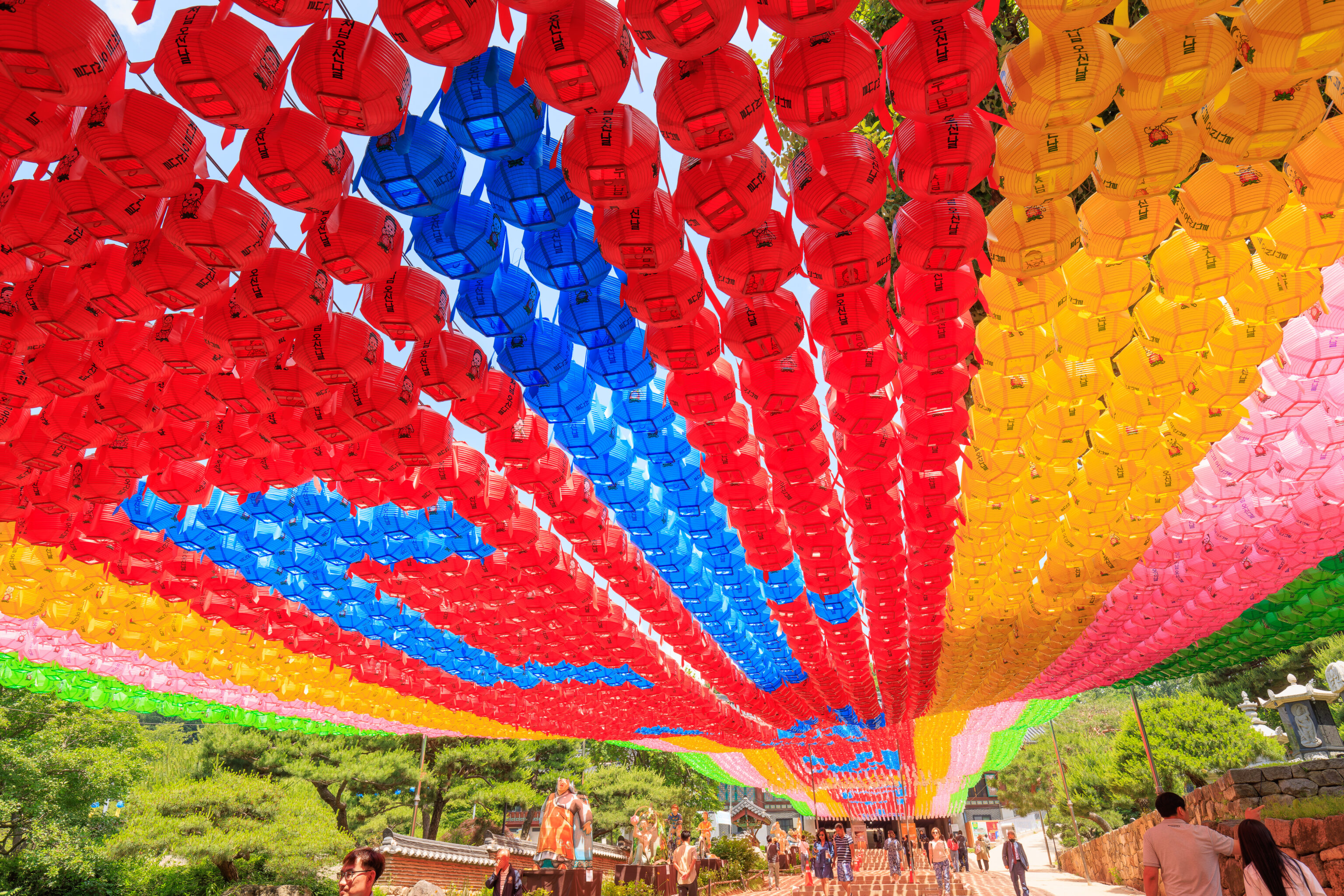
Beyond the big gate, we could see colorful lanterns suspended above the path to the temple buildings. It was very similar to what we saw a few days ago at Jogyesa.
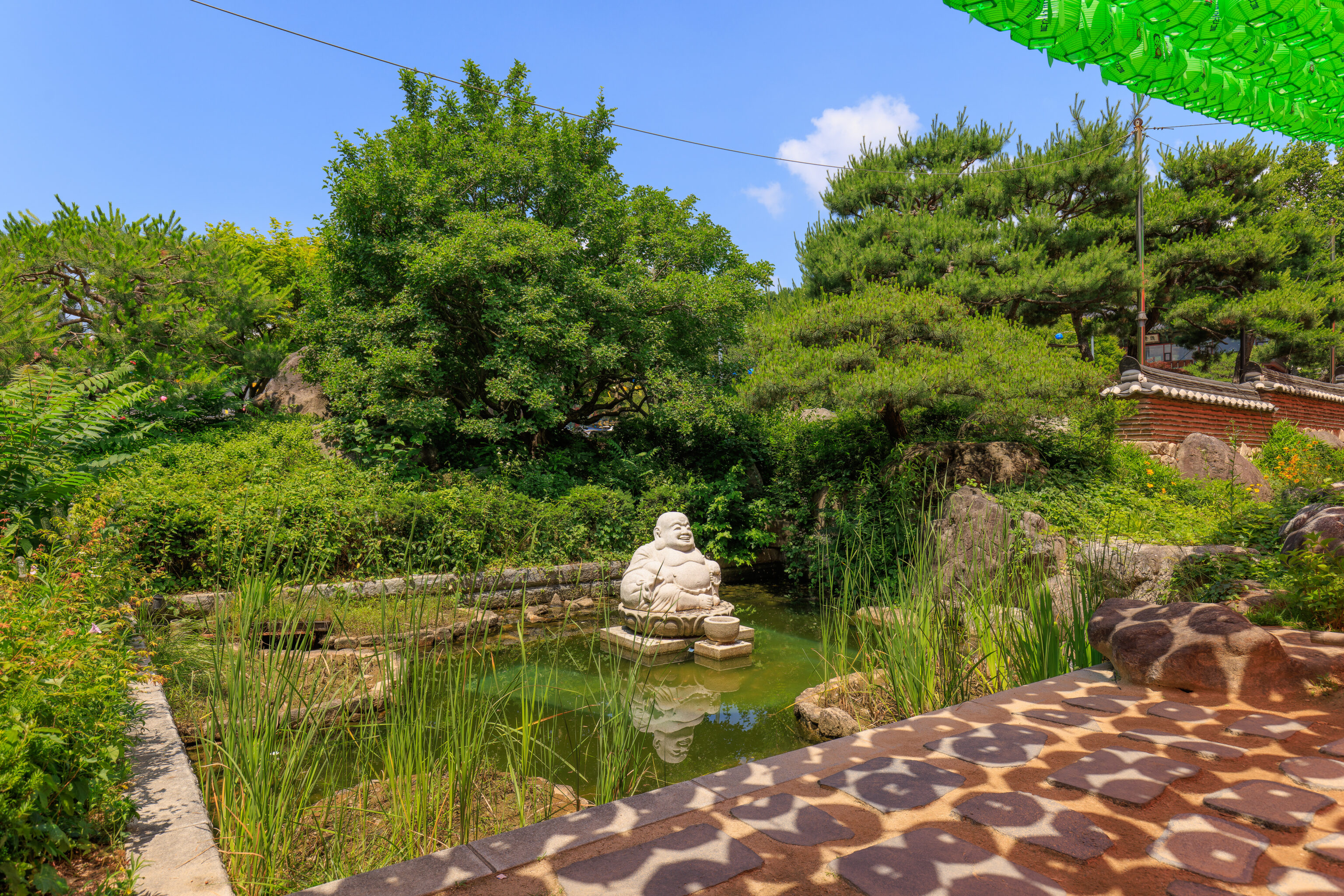
Looking to our left, we could see a Buddha sitting on a pond. Or possibly more accurately, sitting on a stone lotus on a pond!
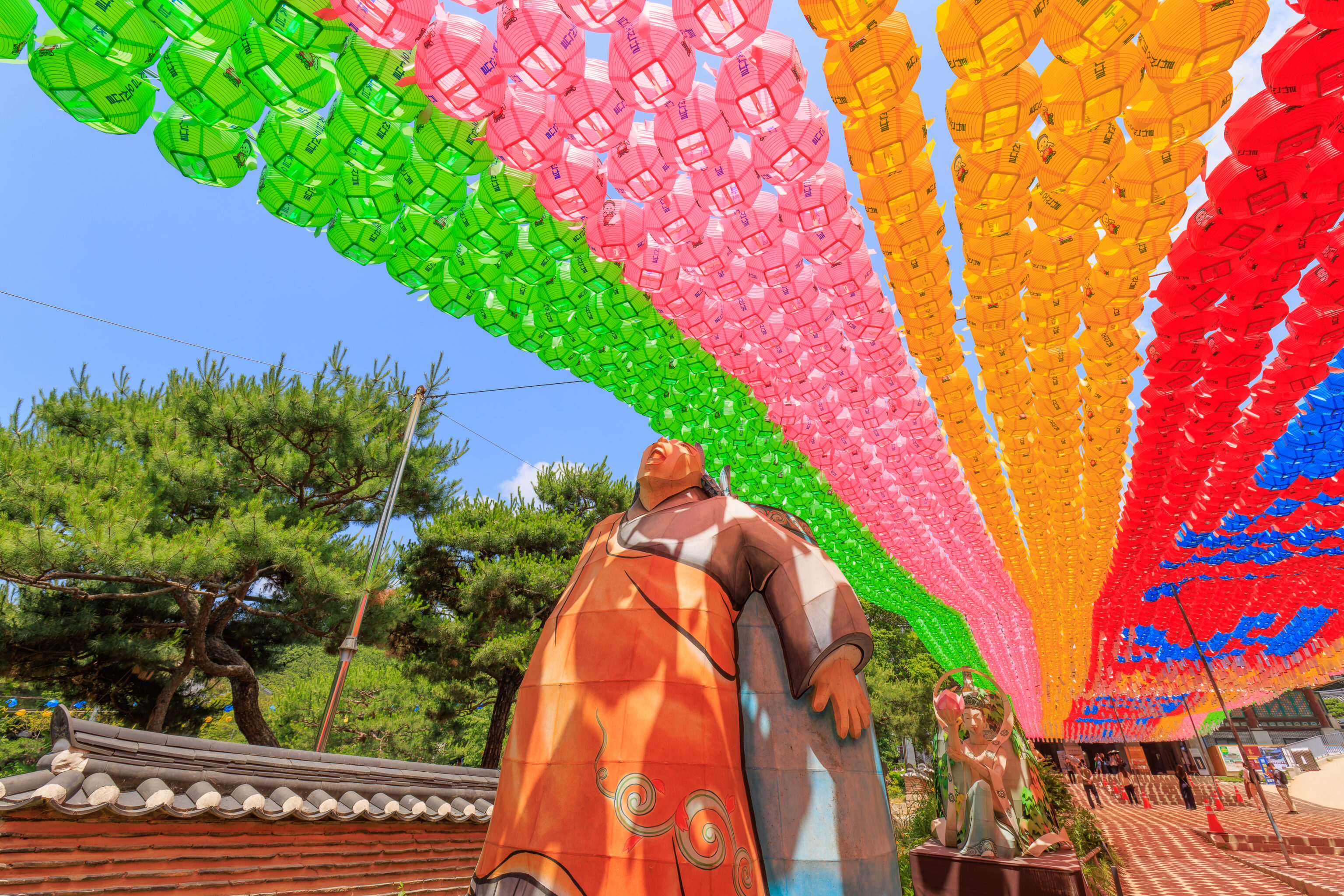
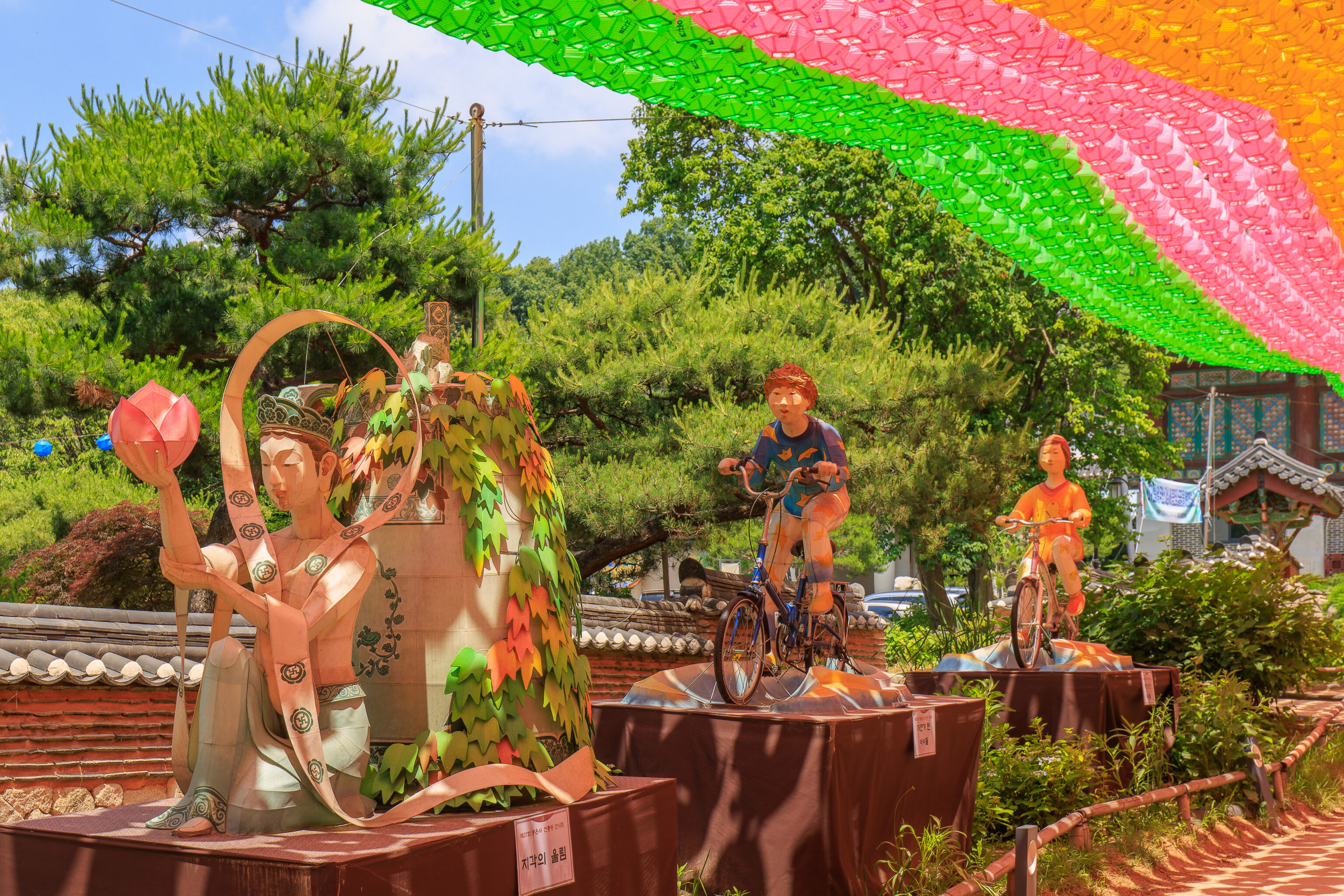
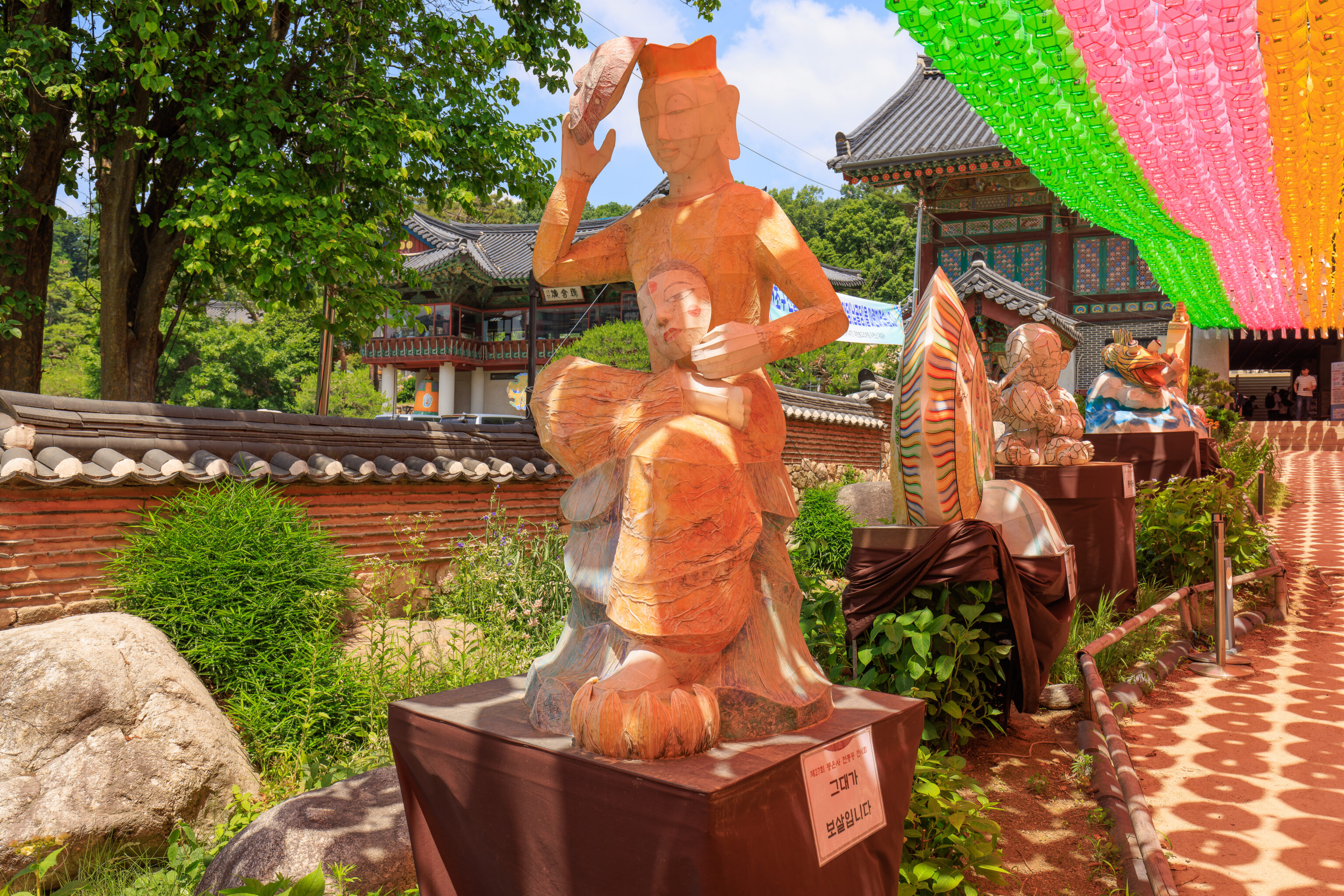
There were various statues on the side of the path.
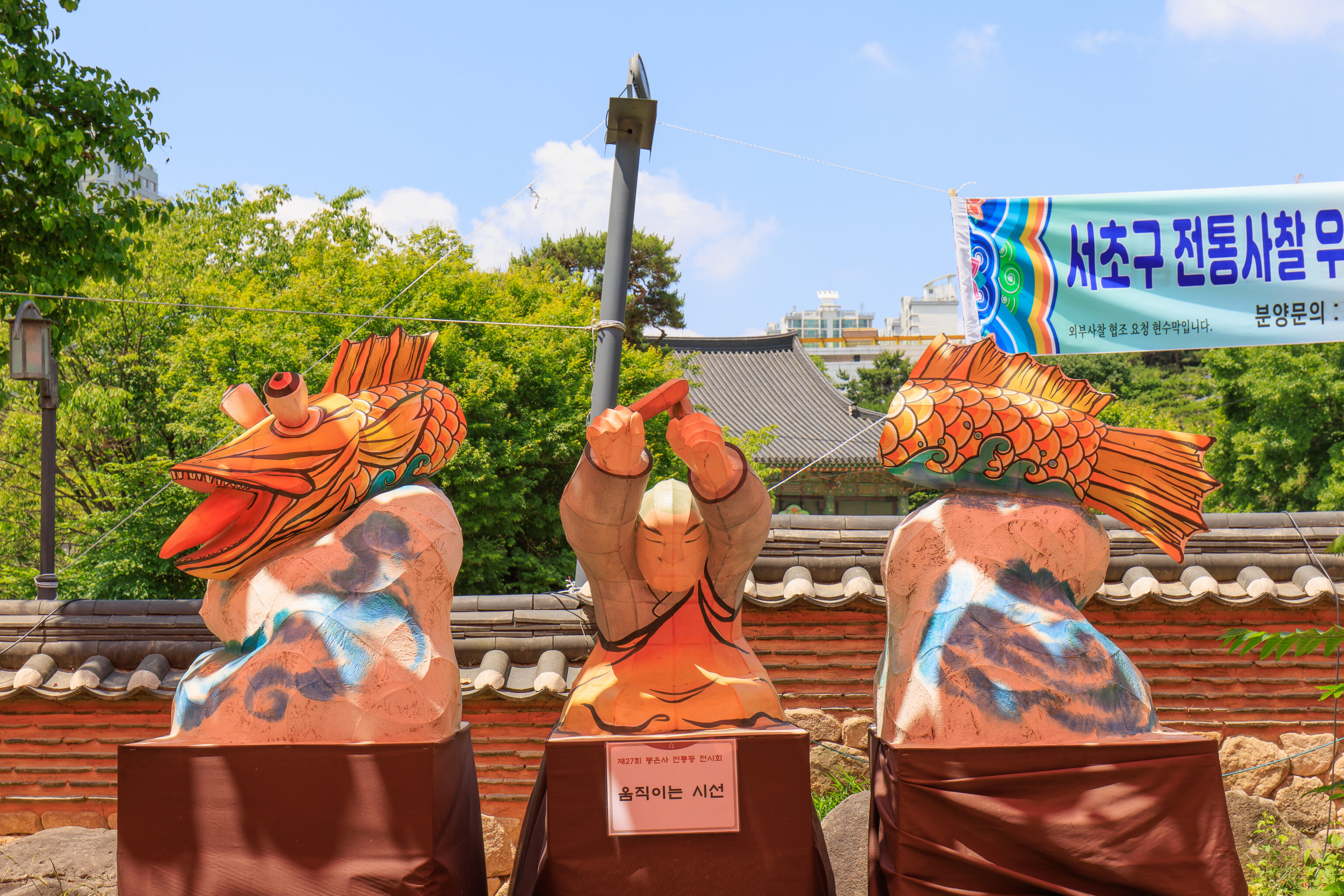
This one depicted a fish cut in half! The sign shows that these are for the 27th Bongeunsa Traditional Lantern Exhibition. The title below, 움직이는 시선, seems to translate to Moving Gaze, though titles and names often don’t translate well into English.
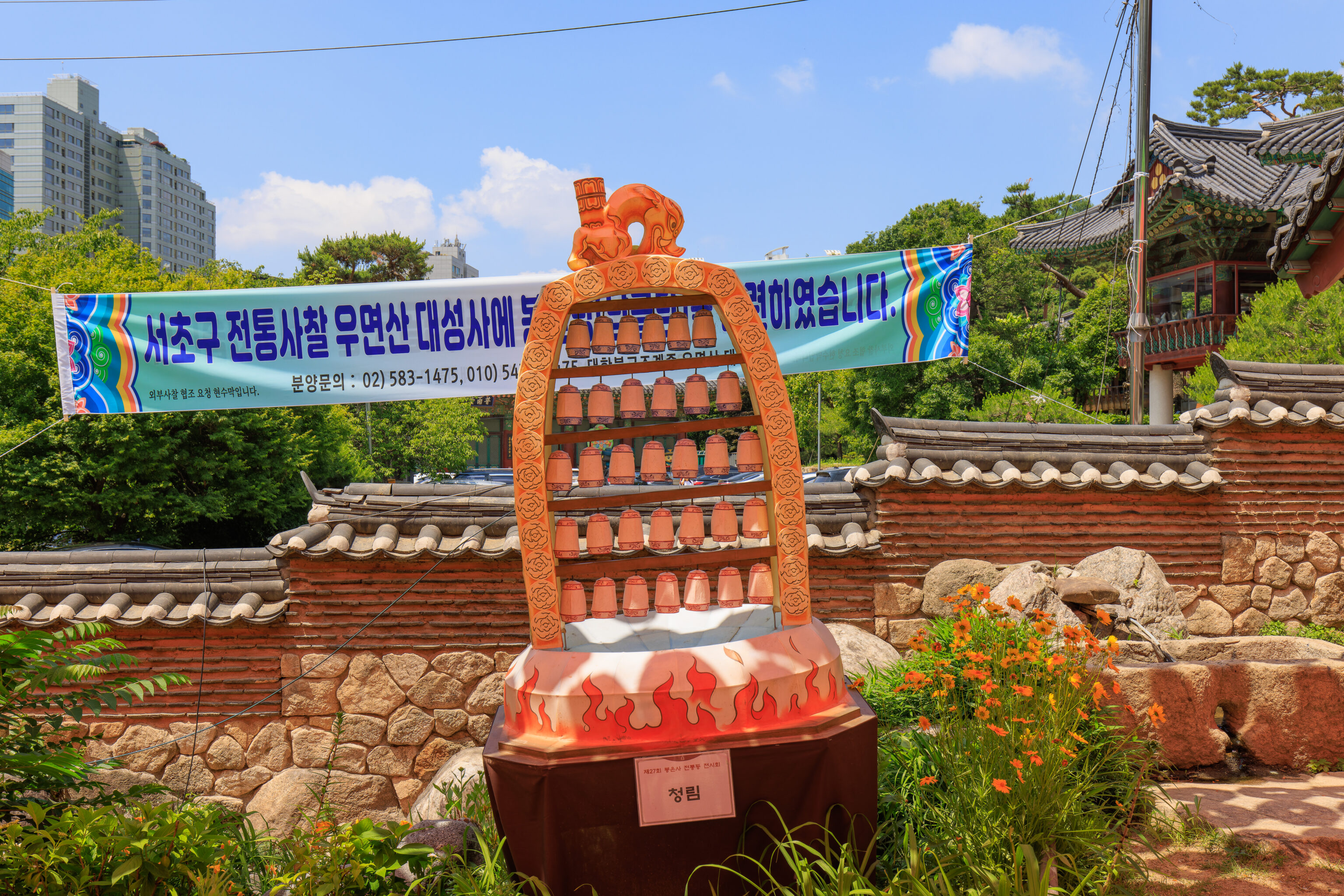
This one seems to involve bells and fire?
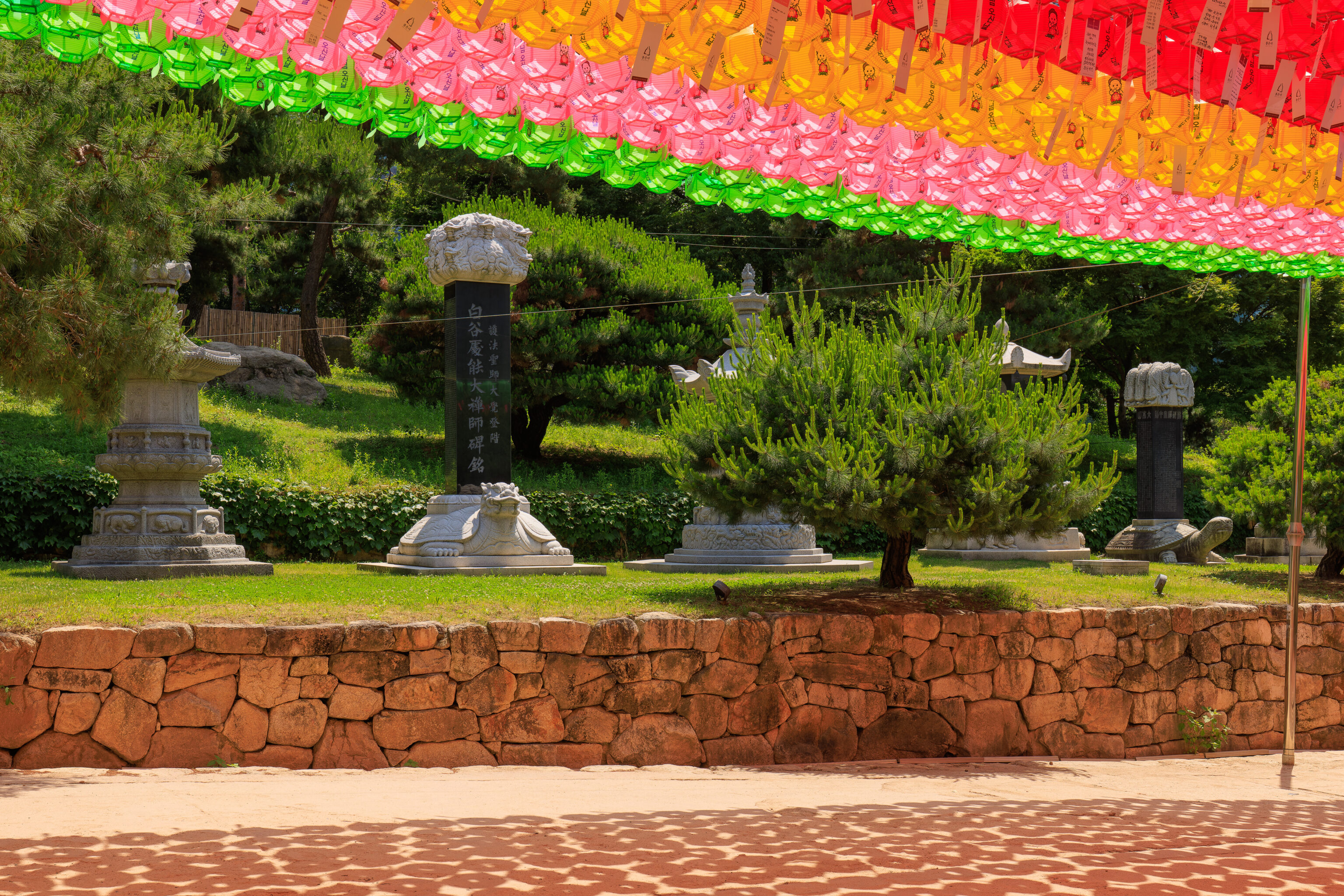
To our right, there were some stone sculptures.
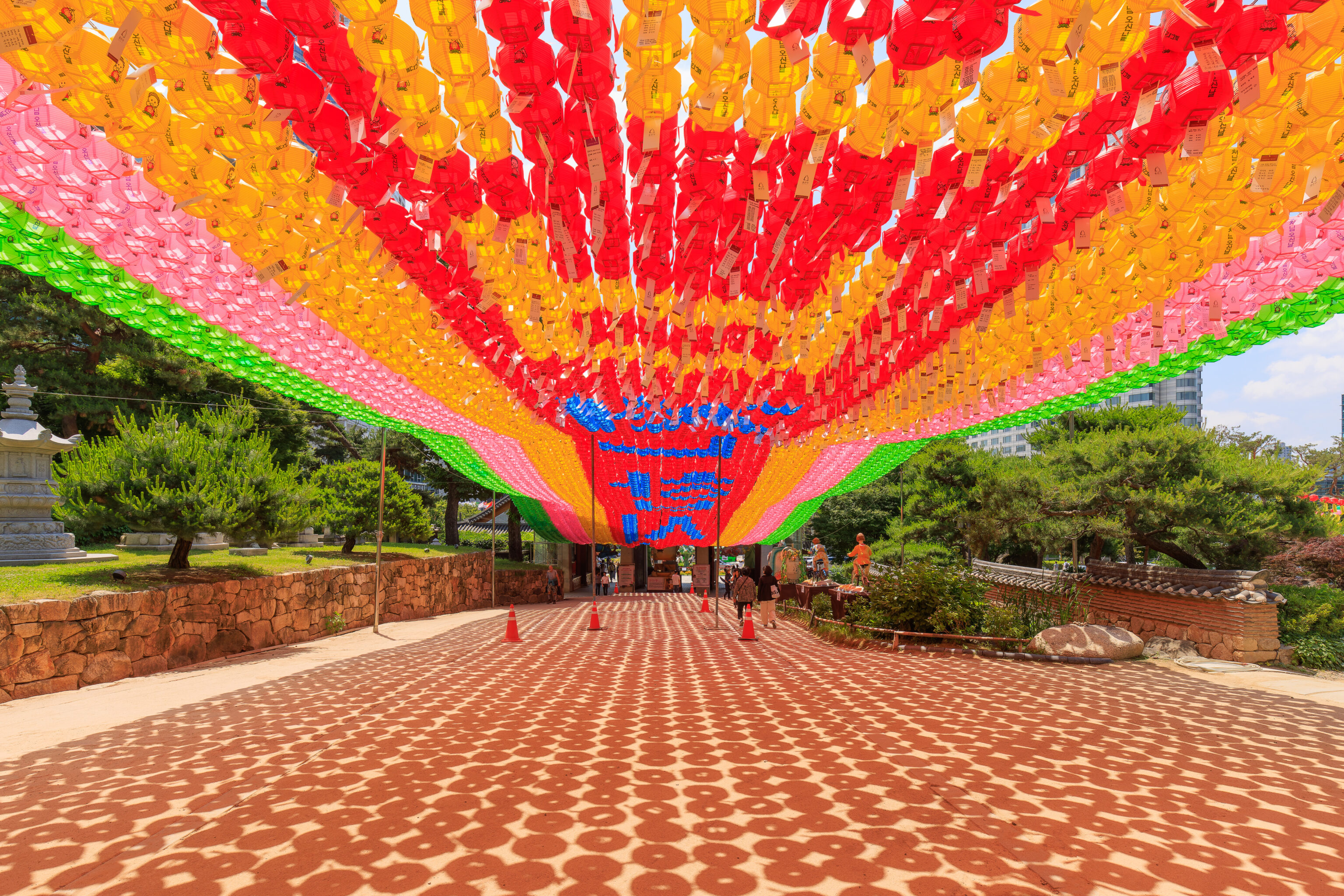
The view from the path, looking back to the gate that we passed through. The lanterns above definitely write something.
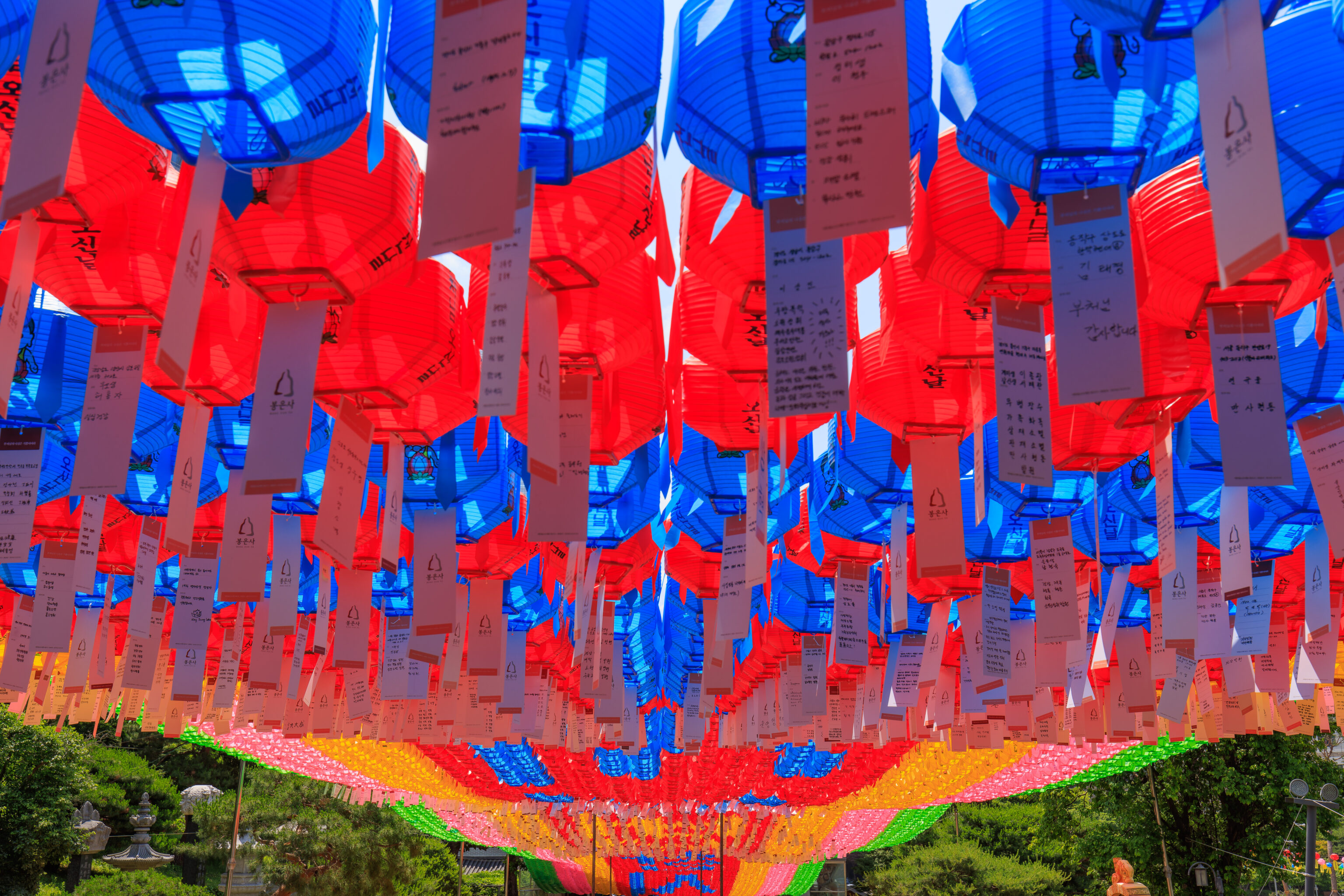
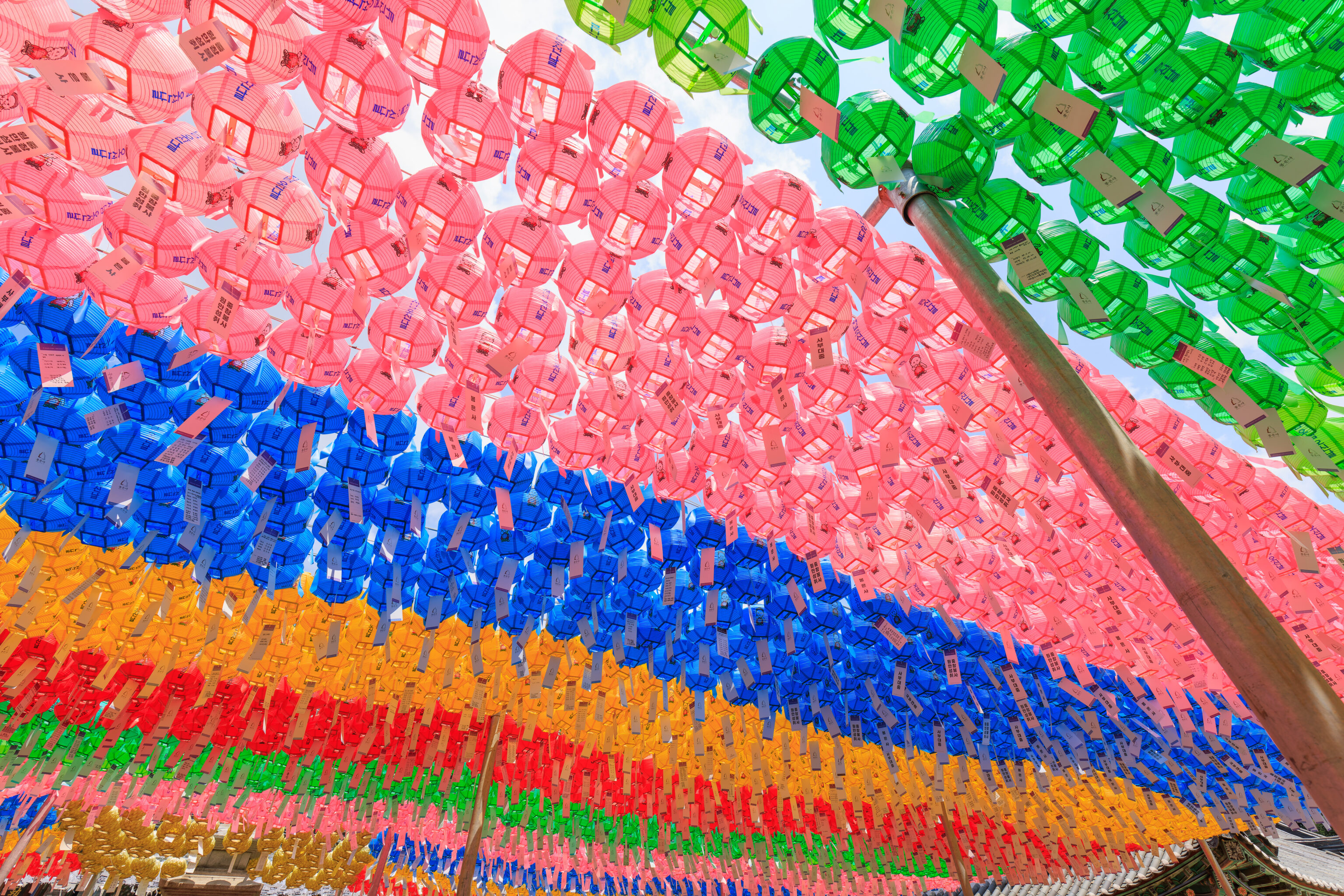
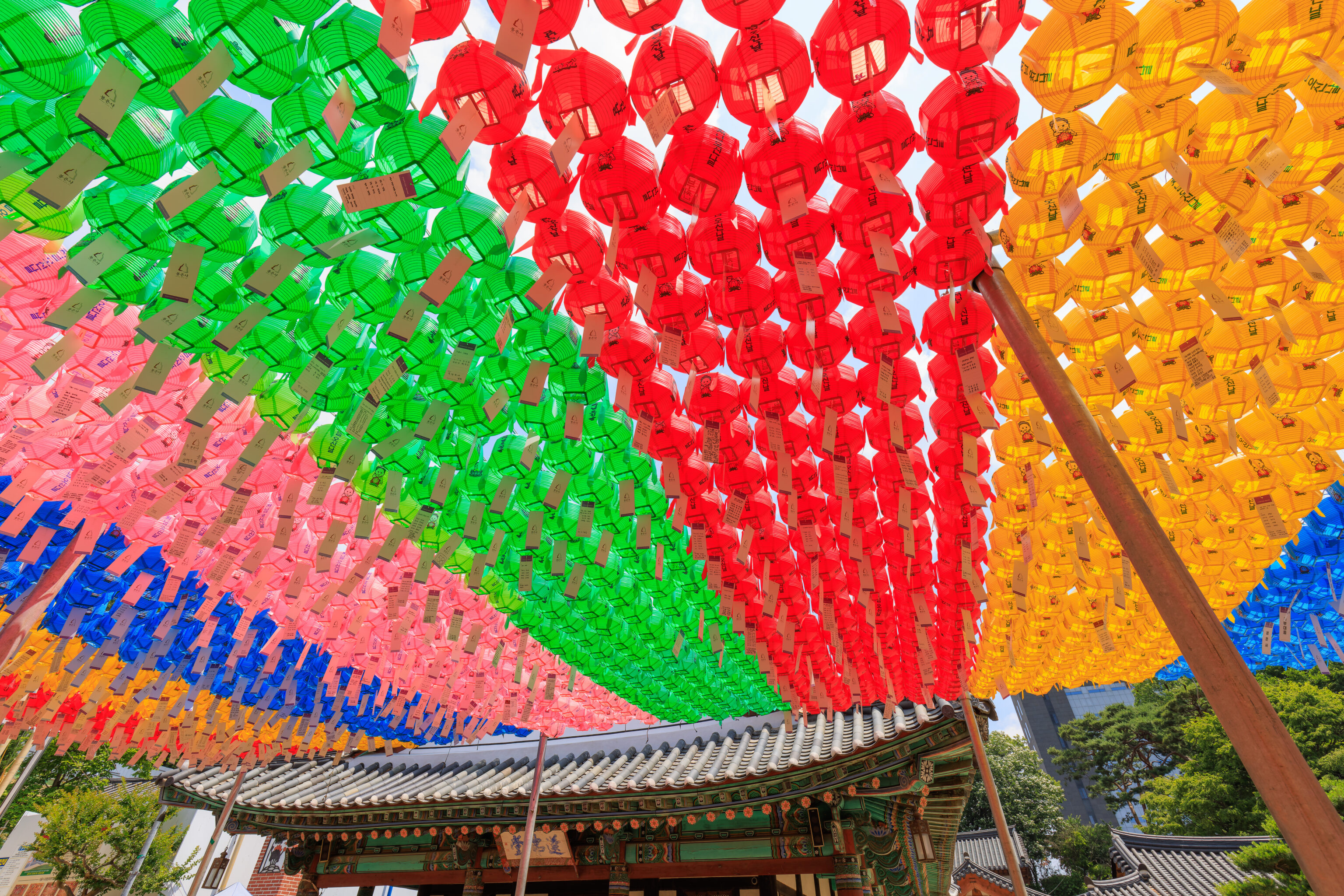
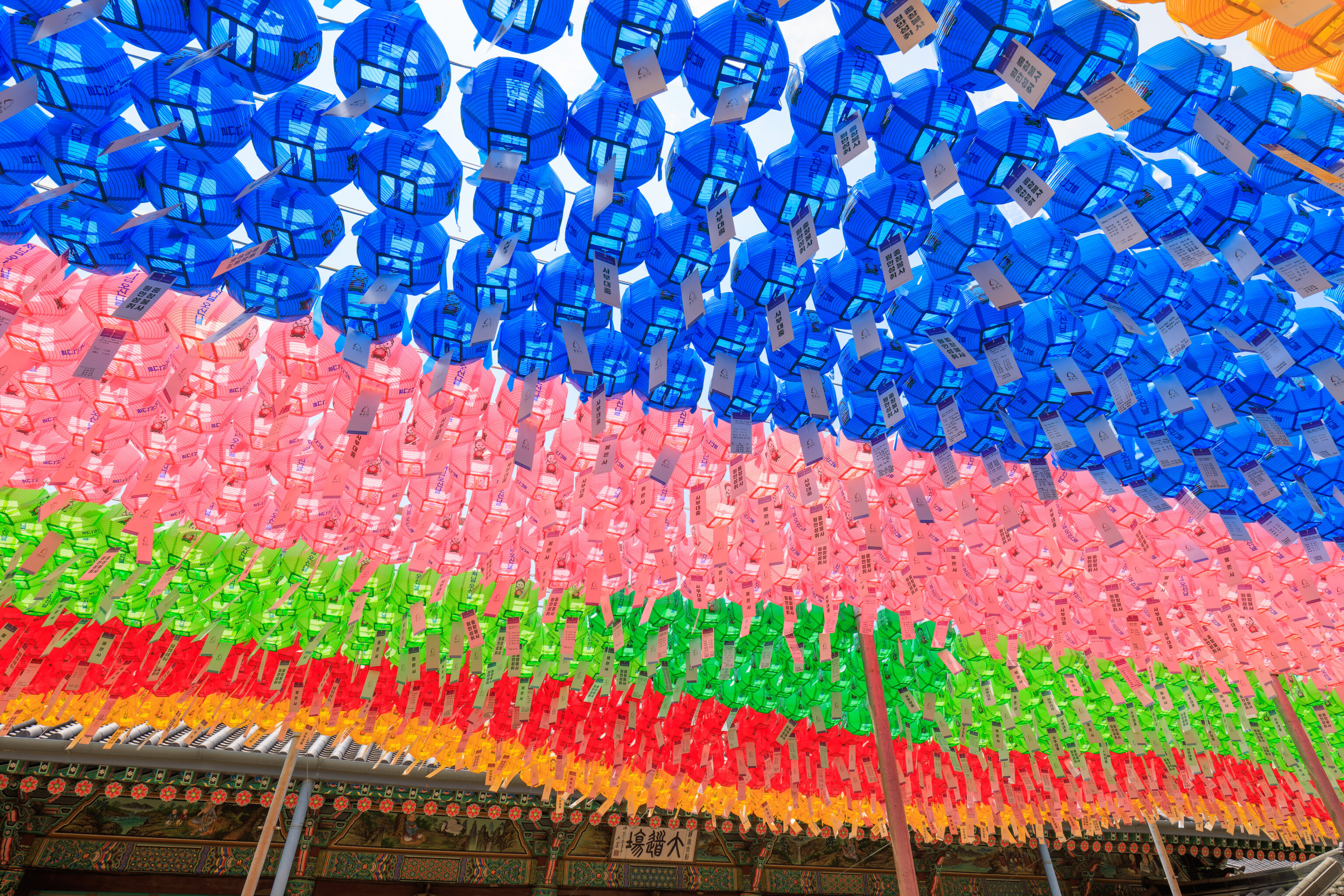
The lanterns have prayers, or probably whatever text the purchaser wanted to write, attached below the lantern on slips of paper.
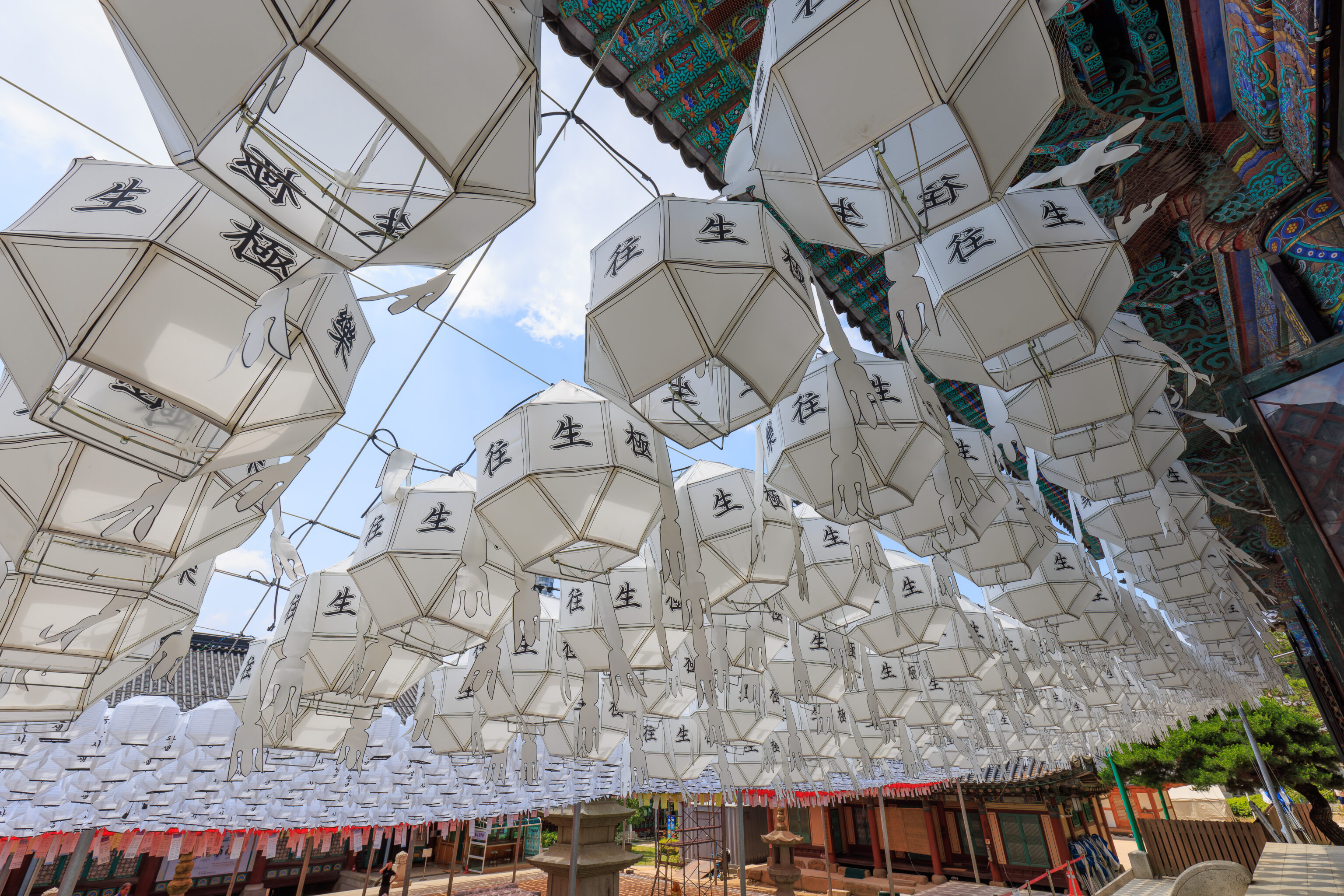
These white ones are a bit different from the colorful ones.
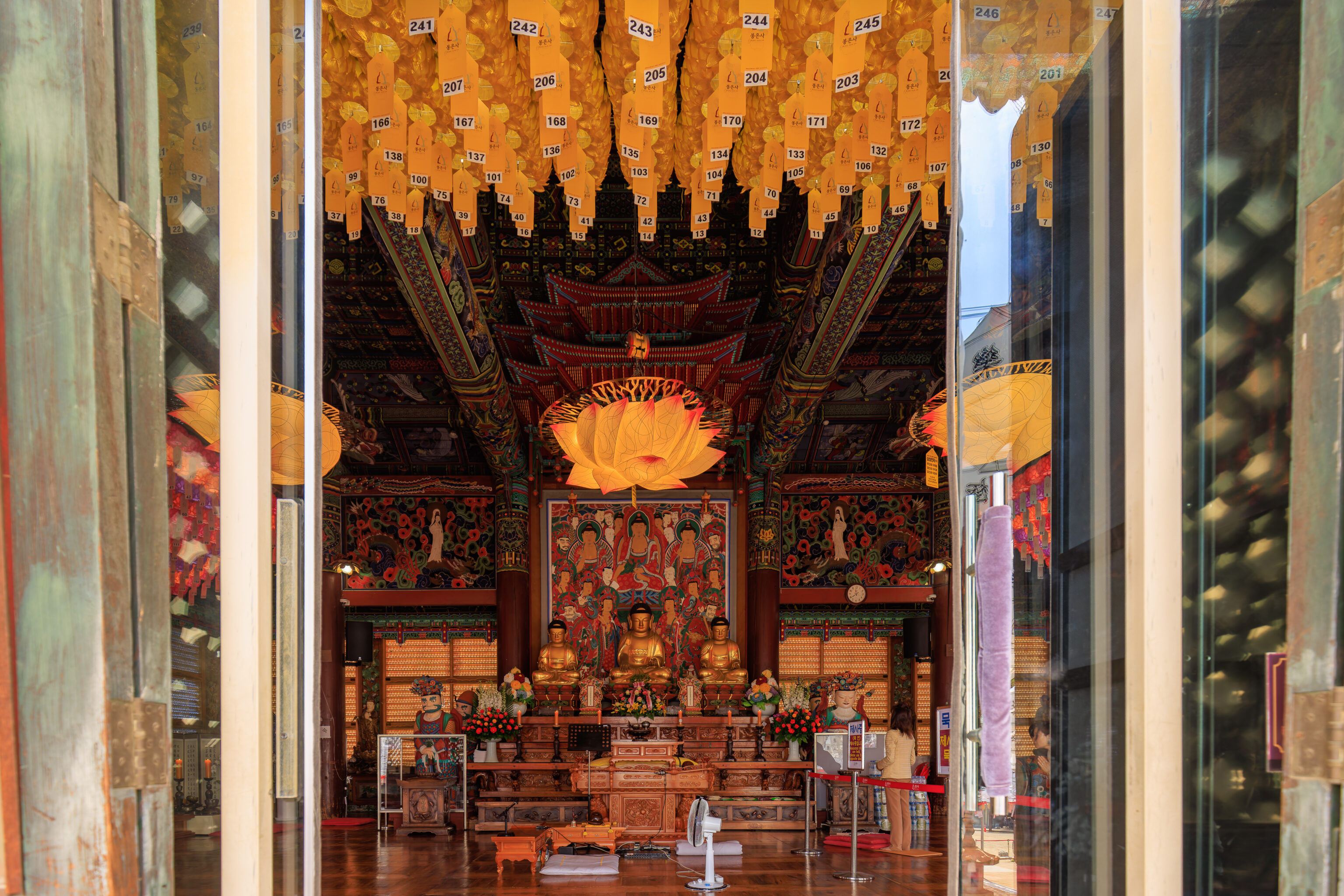
We briefly peeked inside Beopwangru 법왕루, the temple hall at the end of the pathway that we arrived on. Nearby signs provided some additional description of the temple. One explained the Four Heavenly Kings:
The wooden statues of the Four Heavenly Kings used to be enshrined inside Cheonwangmun Gate in Bongeunsa Temple. Now, they are enshrined inside Jinyeomun Gate. The Four Heavenly Kings are known as the deities who reside on the mid-slope of Sumisan (Mt.), and guard the four directions and the Dharma. The Four Heavenly Kings are portrayed as armed warriors. They are Vaisravana, guardian of the North holding a lute, Dhrtarastra, guardian of the East holding a sword, Virupaksa, guardian of the West holding a banner, and Virudhaka, guardian of the South holding a naga. The statues in Bongeunsa share the same stylistic features as the other statues from the 18th century. Only, they are distinguished by the fact that they are made of wood and that they are smaller in size than others even though they are standing statues. Also, they show humorous and friendly looks instead of the frightening expressions like the Four Heavenly King statues. Recently, a written statement of vows and on the production of the statues, and other relics were retrieved from inside the statues. The written document says the state artists like Yeochan, Sinchal, Seonghyeon, Jeongil, Haeun, and Minhwi produced the statues in 1746.
The next sign described the temple’s bronze bell:
The inscriptions on the side of this bronze bell indicate that it was produced in Jangheungsa (Temple) in 1392, the last year for the Goryeo Dynasty and the founding year for the Joseon Dynasty, which enhances its value. The loop at the top of the bell for hanging is missing. On the upper portion, there are two bands of floral patterns and four trapezoidal decorations with knobs, below which hang two tassels. On the lower portion of the bell, four standing Bodhisattva images are represented as honored ones, joining their palms together and riding on clouds. It is the first such example to appear among the bronze Buddhist bells. An additional floral band lines the bottom rim of the bell, and the gong base is decorated with detailed lotus flower design. This bell follows the style typical of bells produced in the late Goryeo period. This bell serves as a fine example for the study of the production method of Buddhist bells from the Goryeo period, as well as the related patronage and the positions of the local government
The next sign describes statues within the 대웅전 Daeungjeon, a hall on the hill behind the main hall:
They are Sakyamuni, Bhaisajyaguru, and Amitabha Buddhas, all made of wood. The records say that they were made in 1651 as the Sakyamuni Trinity for Daeungjeon Hall of Bongeunsa. The Gaegeumgi (Document of Gild Work) also tells us that the Sakyamuni statue in the center was damaged in fire in 1689 and was repaired afterwards. Gaegeumgi from 1765 makes it clear that the statues are the Sakyamuni Trinity. It has thus put an end to the controversy and confirmed that the Sakyamuni, Bhaisajyaguru, and Amitabha statues enshrined in Daeungjeon Hall were the Sakyamuni Trinity. These statues look full of strength with their broad, flat, yet voluminous faces. The upper bodies are relatively short but robust, and the knees are broad and high, showing power in simple images. These kinds of features were prevalent in statues made around 1650, and the style is characteristic of the works by Sculptor Monk Seungil and others. Master Monk Gakseong, who was one of the leading priests in Korean Buddhism at that time, participated in the production of these statues. Also, Sculptor Monk Seungil and his followers who were active in Jeolla-do and Gyeongsang-do devoted all their energy to the production of these statues. The Wooden Statue of Sakyamuni Trinity is representative of Buddhist sculptures from the mid-17th century.
The final sign described four paintings within the Daeungjeon:
Four pieces of paintings of the Guardian Deities, Three Tathagatus, Three Bodhisattvas, and Amita-raja are enshrined in Daeungjeon Hall. The Painting of the Guardian Deities was done in 1844 with the patronage of court ladies. The painting comprises Brahma and Indra, Ilgungcheonja (God of the Sun) and Wolgungcheonja (God of the Moon), and heavenly beings playing various musical instruments, such as the lute, mouth organ, bamboo flute, reed recorder, and hourglass drums. The painting also comprises deities that guard the Dharma, heavenly beings and children carrying an incense bumer and banners, Skanda, the Eight-fold Congregation of the Guardian Deities, the Mountain God, Jowangsin (the Kitchen God), and Naga. The Paintings of Thre Tathagatas, Three Bodhisattvas and Amrta-raja were produced in 1892 with donations by Min Duho, one of the civil officials from the late Joseon period, and court ladies. The Painting of Three Tathagatas comprises of Sakyamuni (center), Bhaisajyaguru (right), and Amitabha (left) and their company, symbolizing that Dharma is everlasting in time and space. Below Sakyamuni are disciples, such as Mahakasyapa (right) and Ananda (left), and behind Bhaisajyaguru and Amitabha are Nagaraja and Queen Naga, respectively. Three Bodhisattva refers to the Heaven Store Bodhisattva (center) who is the host of the Heavenly realm, Earth Store Bodhisattva (right), host of the Earthly realm, and the Ksitigarbha Bodhisattva (left), host of the Underground realm. Surrounding the Heaven Store Bodhisattva are Jinju Bodhisattva and others. Beside the Earth Store Bodhisattva are Nagarjuna Bodhisattva, Dharani Bodhisattva and company, and beside Ksitigarbha Bodhisattva is his company. The painting of Amrta-raja is used during a ceremony to lead the lonesome spirits to Paradise. In the upper part of the painting, Illowang bosal (Leading King Bodhisattva), Chiryeome (Seven Buddhas), Arnitabha Triad, Earth Store Bodhisattva, and Guanyin, who are to lead the souls of the deceased to Paradise, are lined up. In the center is an altar where food is prepared and a priest who is conducting the ceremony. In the bottom part of the painting, various scenes from everyday life are depicted in a realistic manner. a couple of ghosts kneeling down, people working in the forges, clowns walking on a tightrope, etc. This is one of the representative paintings of Amrta-raja that were widely popular in Seoul and Gyeonggi-do in the latter half of the 19th century.
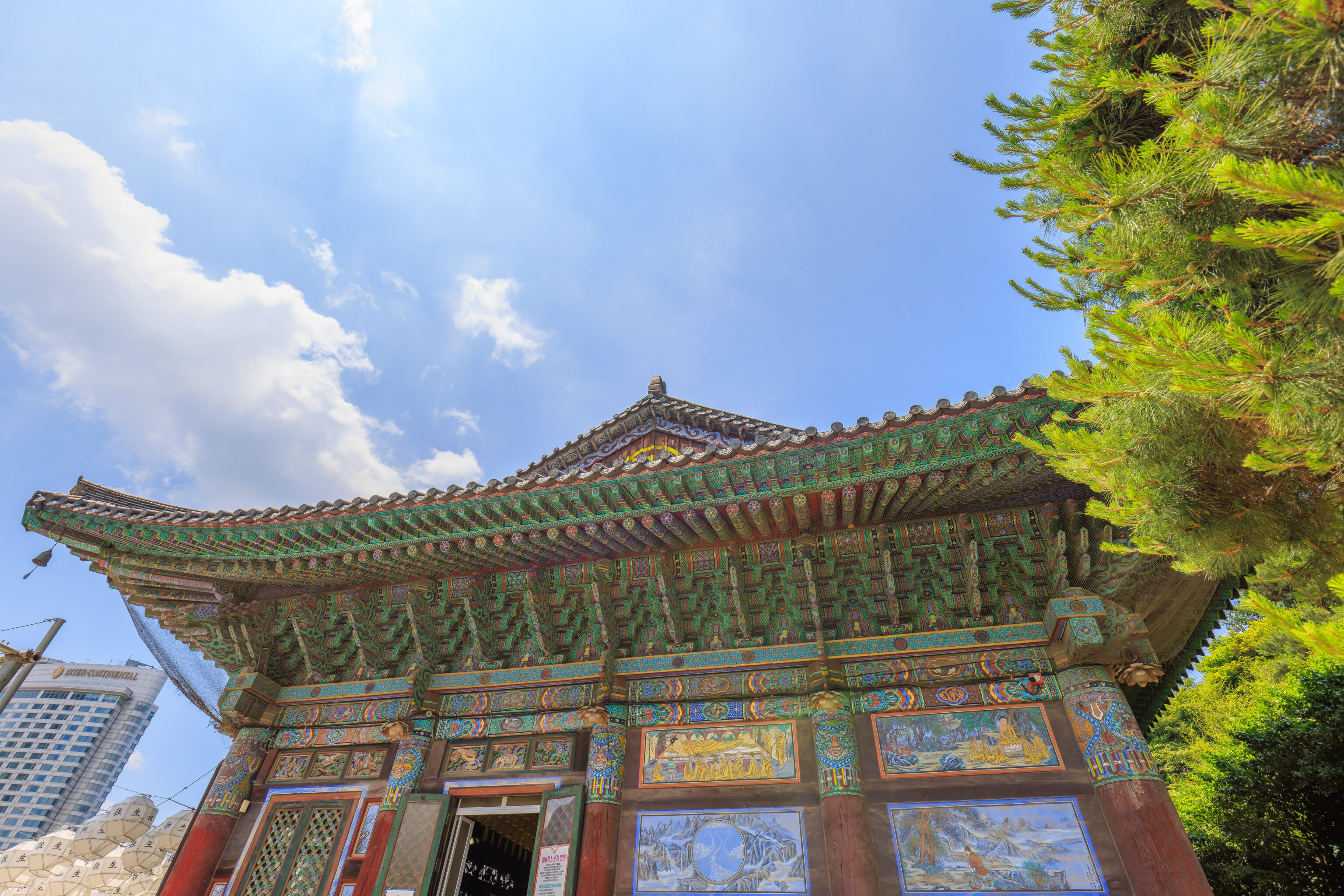
The entrance to the Beopwangru is actually from this door on the east side of the building. The side of the building has some colorful murals.
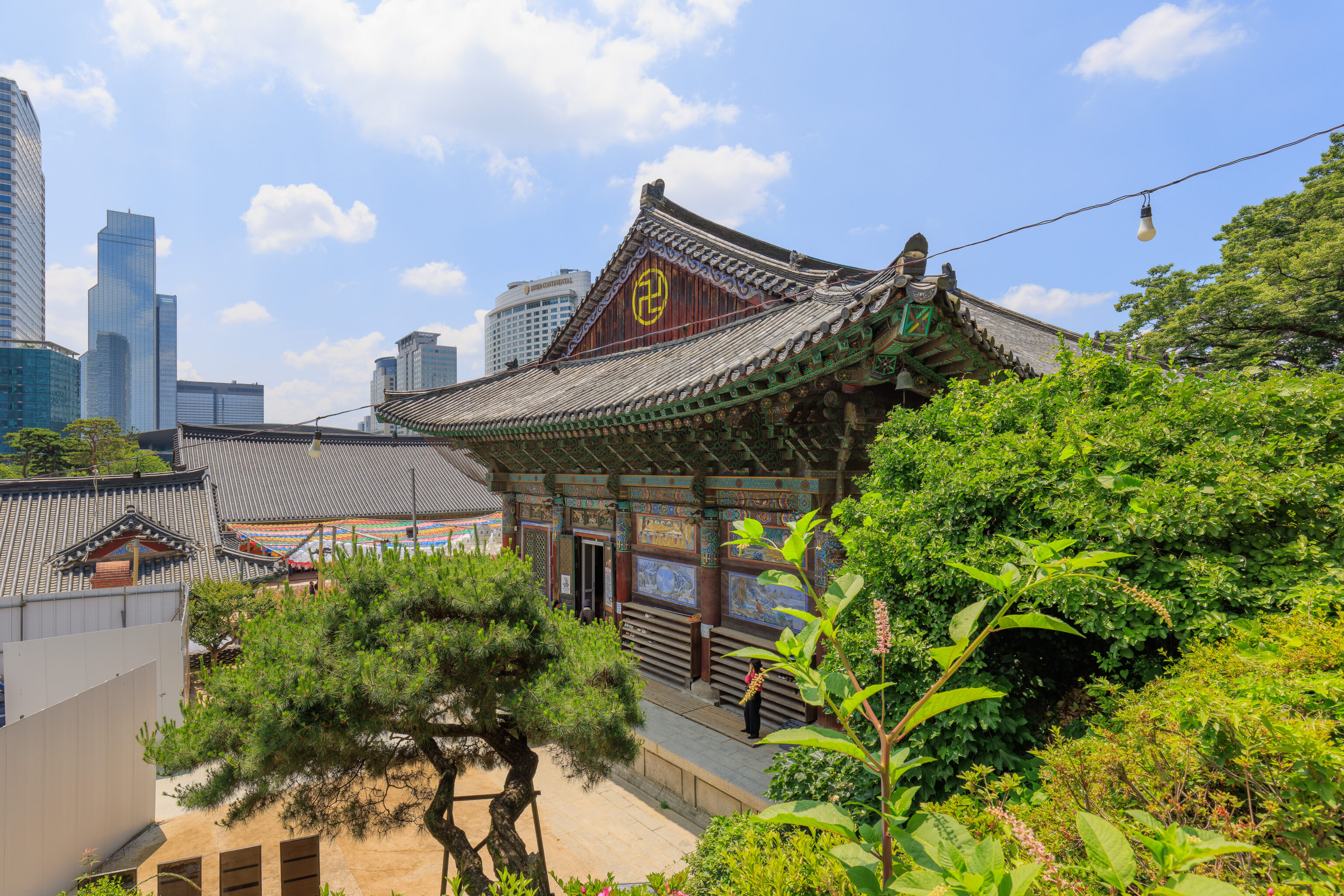
We walked up the hill behind the Beopwangru.
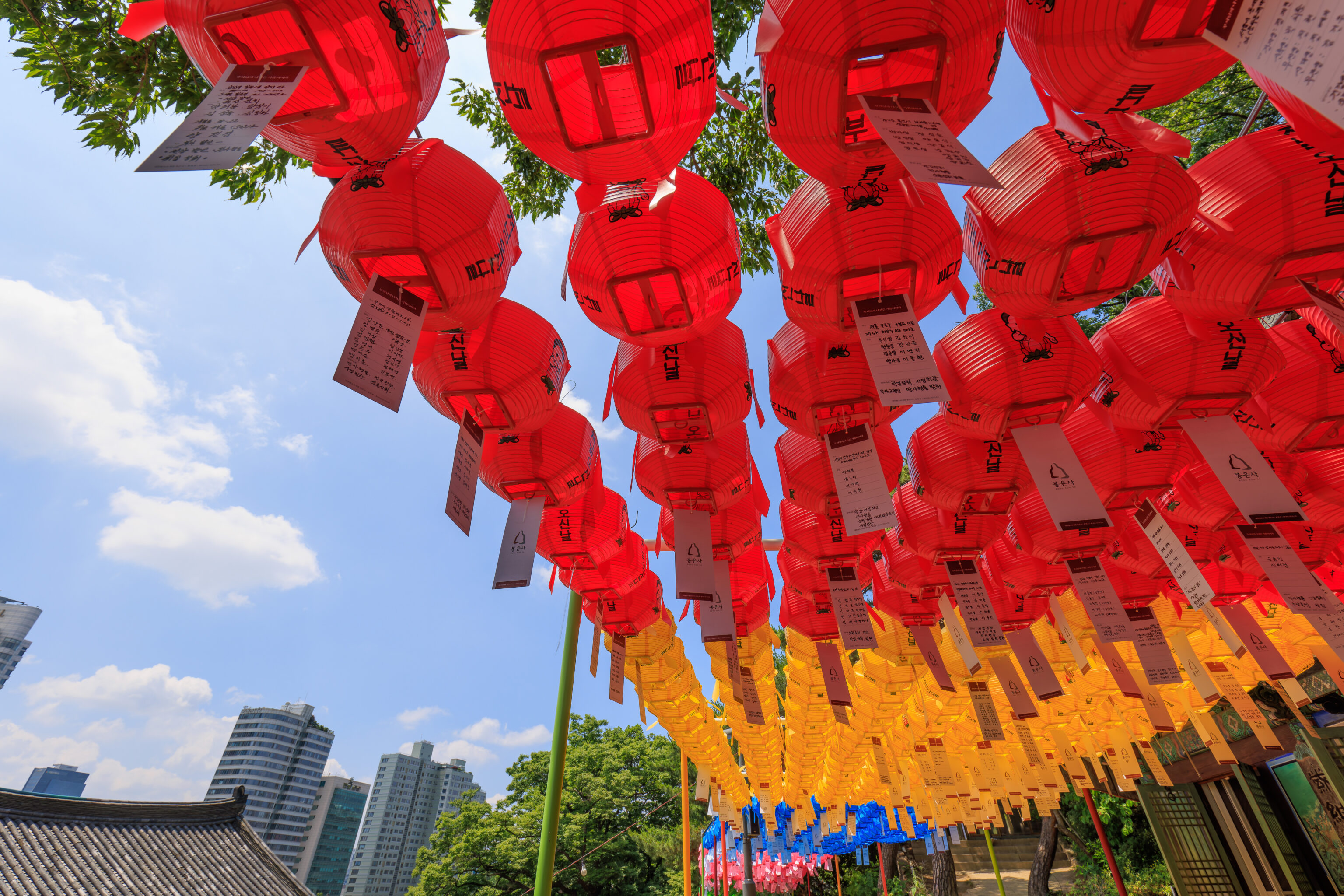
There were more colorful lanterns outside of the Daeungjeon, the hall above and behind the Beopwangru. We didn’t photograph the hall as it was busy.
There were a few signs nearby. The first describes sixteen statues within Yeongsanjeon, a smaller building behind the Daeungjeon.
The statues enshrined in Yeongsanjeon Hall of Bongeunsa Temple are statues of 16 Arhats, each holding various artifacts in various postures and seated on the rock pedestals. Arhats are saints who abandoned their carnal desires and attained enlightenment, and are equipped with virtues so as be honored by the people. Among the sixteen statues, four were newly added. They are arranged on each side of Sakyamuni, Mahakasyapa, and Ananda in the groups of 8. According to the written record found in the Main Platform Painting of this Hall, the statues of 16 Arhats were produced in 1895. The statues are important cultural properties of which the specific year of production is identified as in the late Joseon period.
A second sign describes three statues within the same hall:
The statues of Sakyamuni Buddha and his two disciples form a set of triad, which are enshrined in Yeongsanjeon Hall of Bongeunsa Temple. On each side of the Buddha are the statues of the 16 Arhats. The inscriptions found on the Main Platform Painting hanging on the wall behind the statues give the information that the Sakyamuni Buddha statue was recoated with gold in 1895 (32nd year of King Gojong's reign), and that it was then that the statues of Mahakasyapa and Ananda were newly added. The Sakyamuni statue is seated on a unique wooden pedestal decorated with elaborate carving and is flanked by Mahakasyapa and Ananda who clasp their palms together. Mahakasyapa is an old monk who had gone through a long discipline, and Ananda is a young monk.
A final sign describes paintings within the same hall:
Several paintings are enshrined in Yeongsanjeon Hall, and they are of Sakyamuni's Preaching on Vulture Peak, 16 Arhats, Guardian Deities, and Messengers. These paintings were painted together in 1895. The Painting of Sakyamuni's Preaching on Vulture Peak shows Sakyamuni seated in the center, flanked by six Bodhisattvas, disciples, Four Heavenly Kings, and Vajra Protectors. Each of the Four Heavenly Kings hold a lute, a sword, a reliquary pagoda and a naga, or a jewel, and are guarding Sakyamuni and his company. The Painting of the 16 Arhats portrays the 16 disciples of Buddha. Arhats are represented in various appearances and poses: a young Buddhist acolyte, an old man with white hair, one with a rosary in hand, one leaning against a tree trunk at ease and reading a sutra, one laughing cheerfully as he watches the children, etc. Among the 16 Arhats, the tenth, eleventh, thirteenth, and the fifteenth Arhats had been missing, until they were newly added in 1955. The overall arrangement became somewhat mixed up in the course of this addition. The Painting of the Guardian Deities shows the deities that guard and protect Dharma. Skanda, wearing a headpiece decorated with bird wings, is placed in the center. On each side of Skanda are Brahma ding are and Indra, then other guardian deities. In the front row, six guardian deities holding swords are arranged, so as to make the Eight Congregated Devas, including Skanda, the central figures. The Painting of Messengers portrays two Messengers of the Dead wearing swords at their sides and holding banners with two hands, as well as a couple of Vajra Kings. Red, green, blue, white, yellow, and blue are applied, among which red is the most prevalent color.
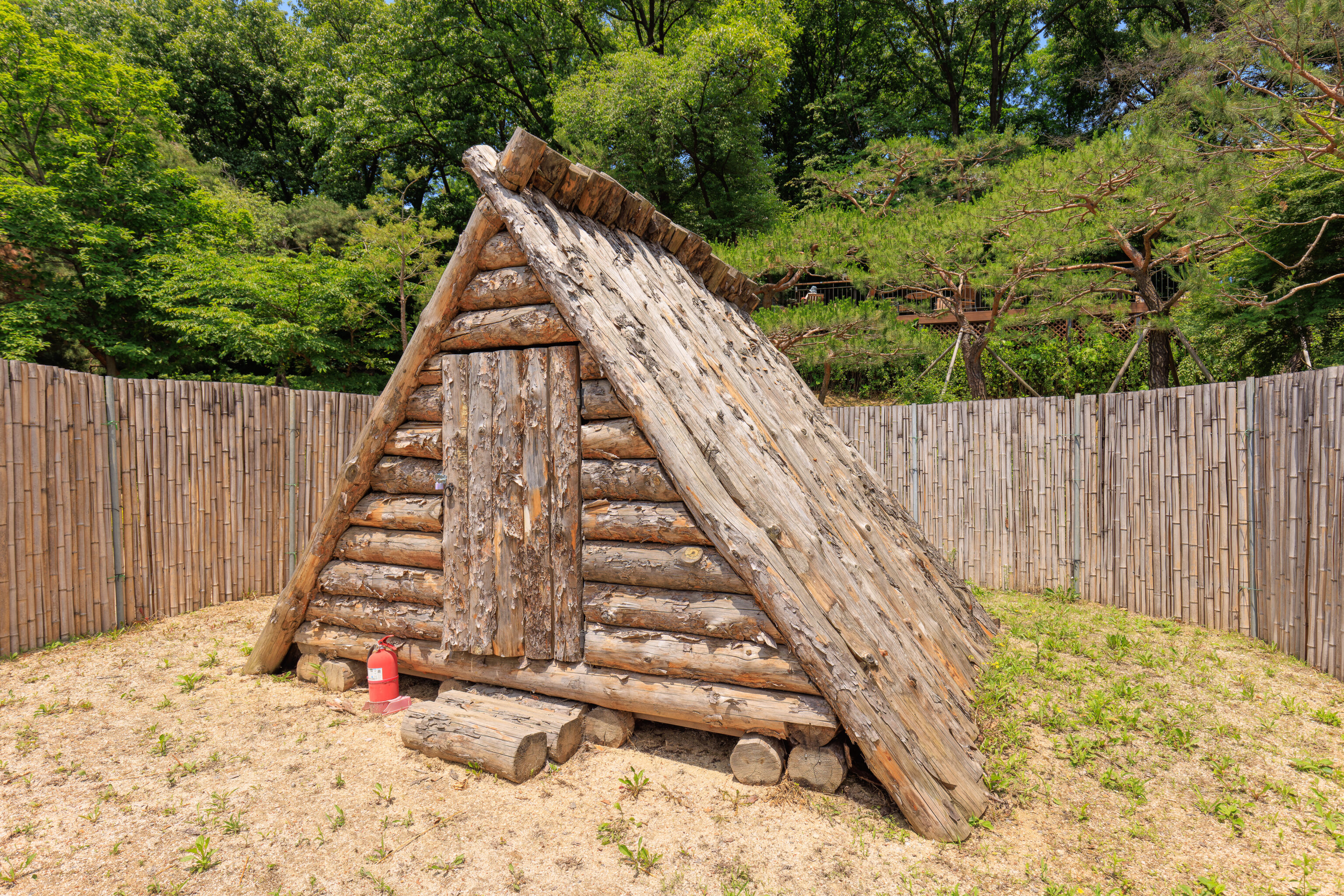
We continued past the Yeongsanjeon, coming across this wooden structure. We don’t know anything about it. Doing a Google Lens image search, a Korean language blog entry comes up from earlier this month. In the text, the author mentions not knowing anything about it as well. Unfortunately, this structure’s appearance is pretty generic. I’ve seen similar structures in Colorado that appear just as if it was a roof with no building below.
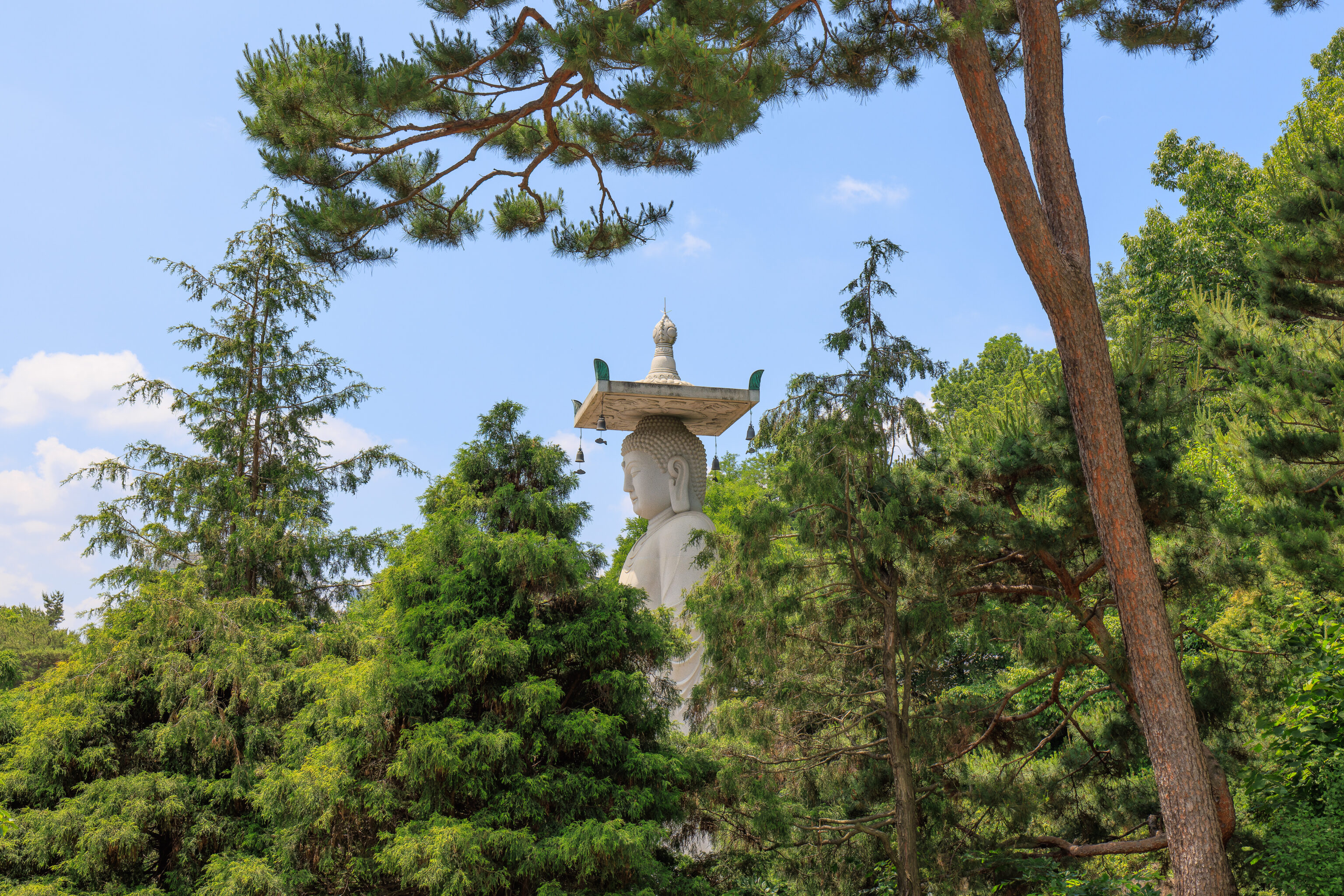
This area, behind and above most of the temple buildings, is part of a 1.2 kilometer meditation trail. We were able to see the top of a giant Buddha statue, which we haven’t reached yet.
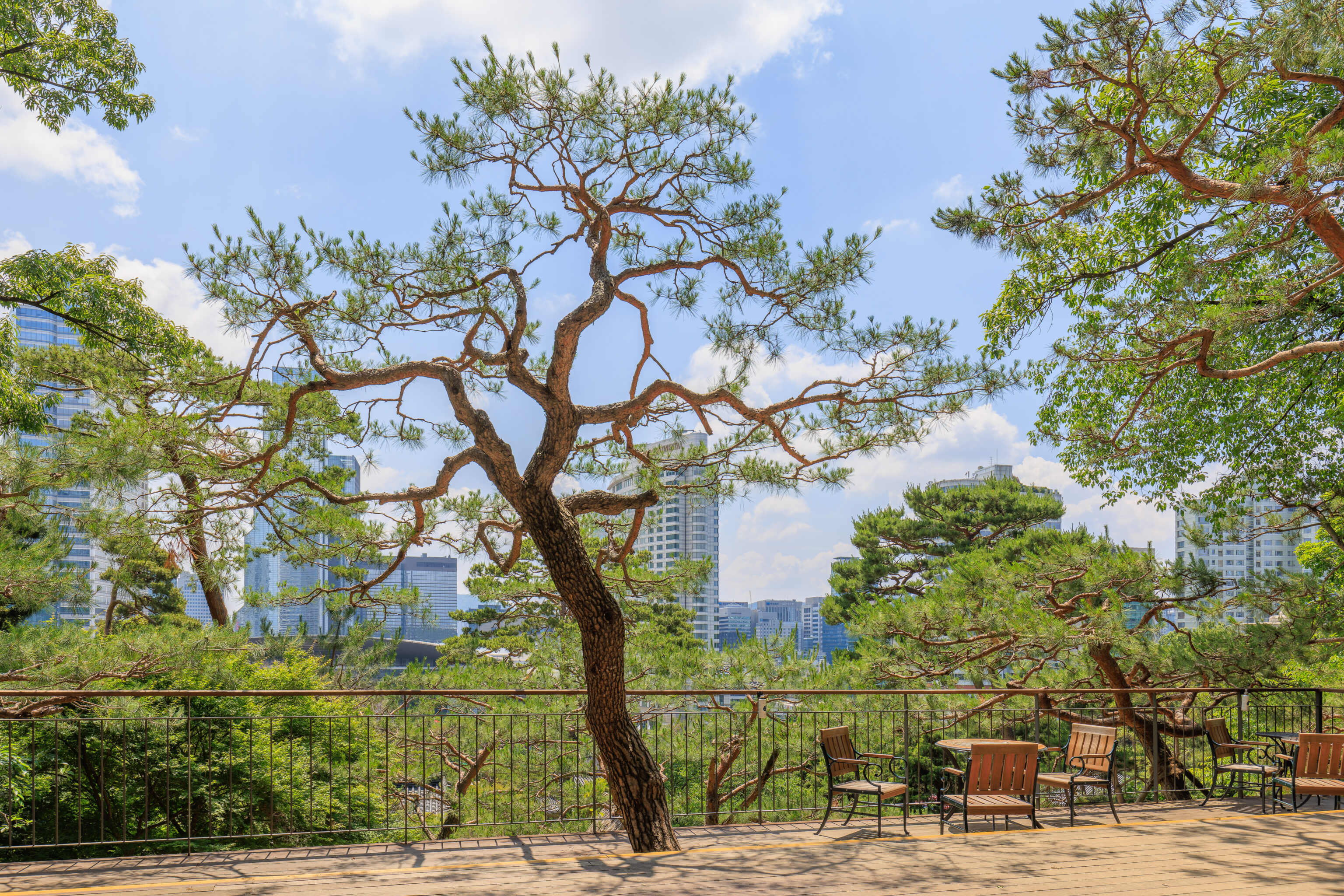
We went as far as this overlook, which wasn’t very far at all. It was more or less a huge outdoor deck with tables an chairs.
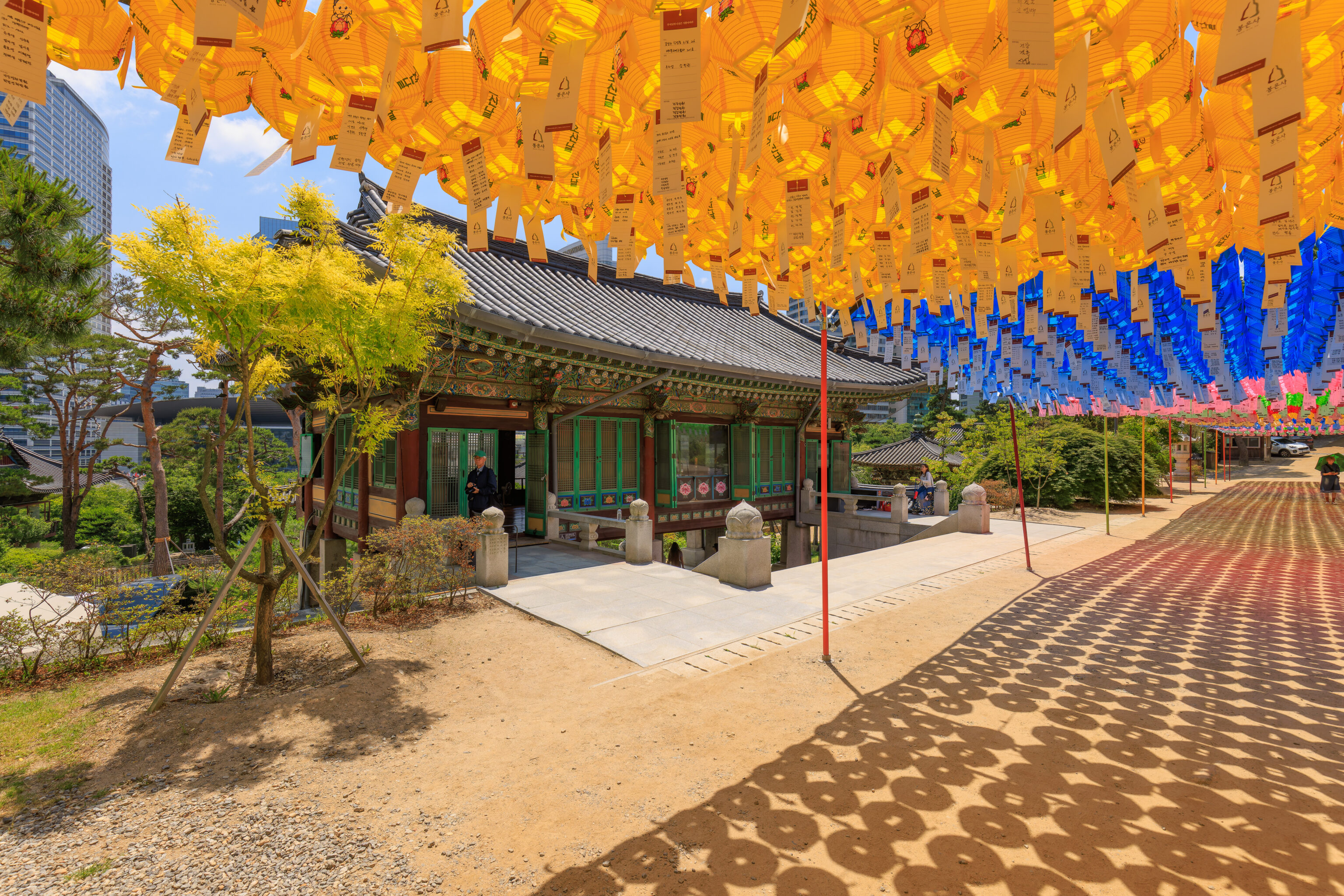
We headed back down to see the temple buildings on the west side of the grounds.
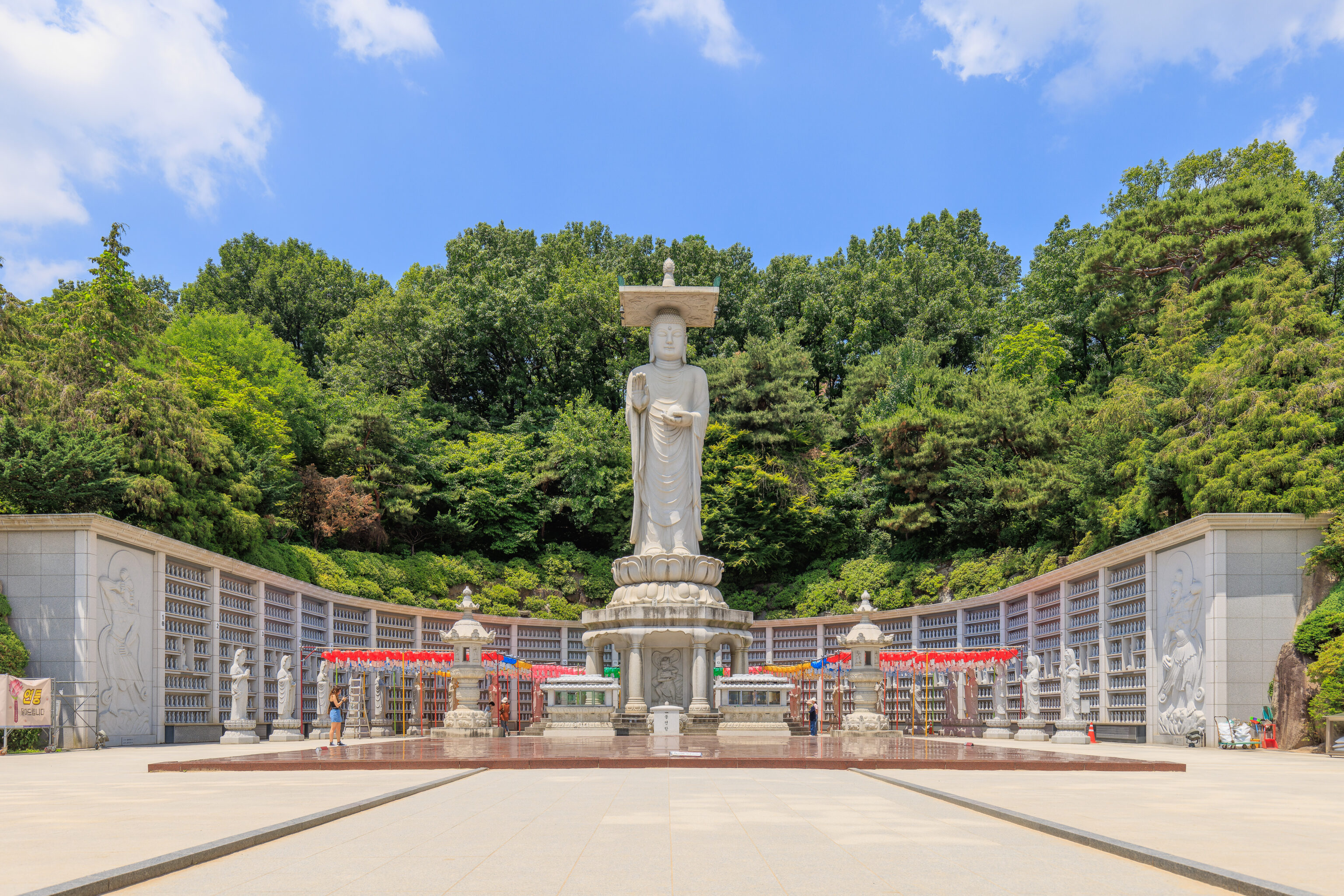
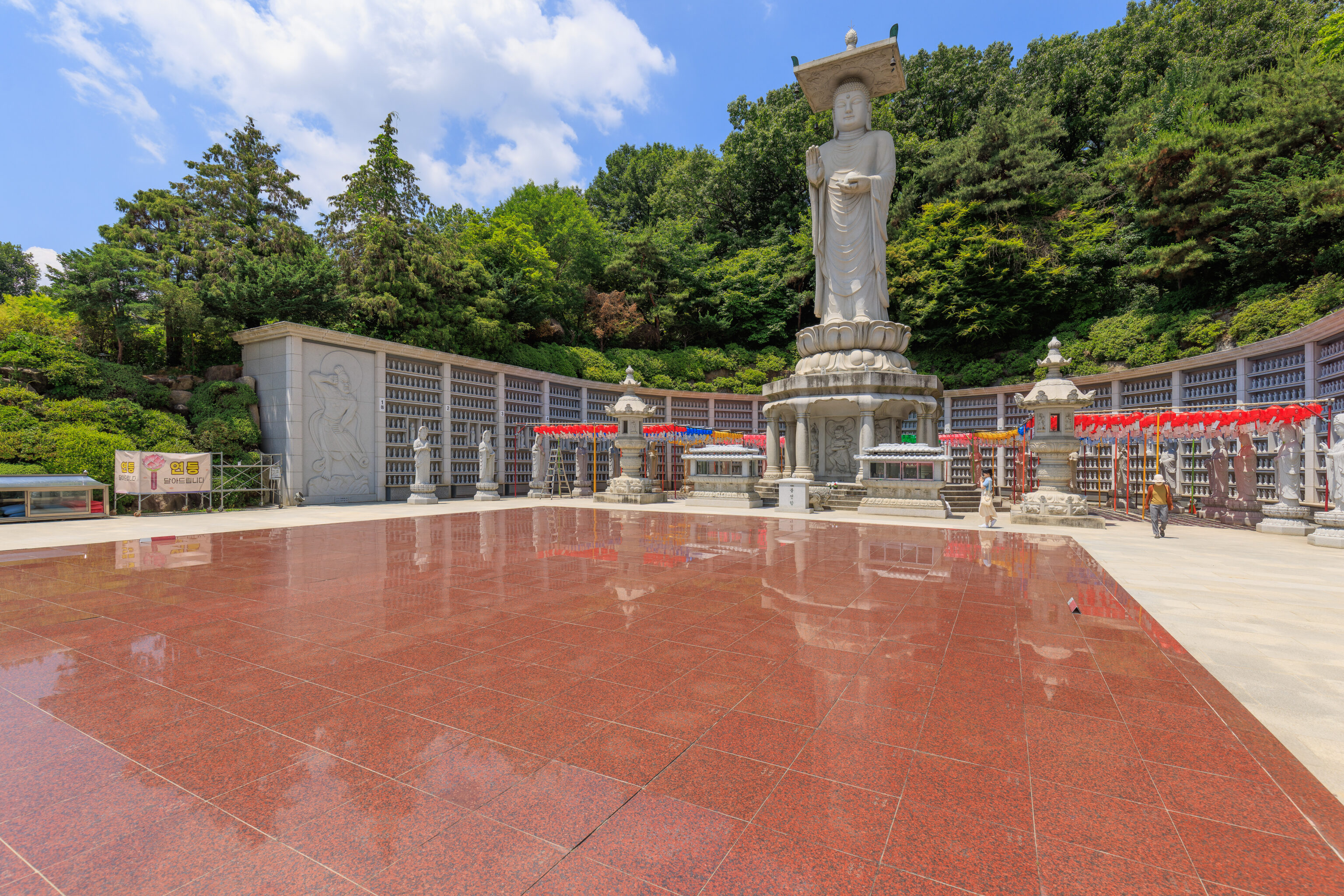
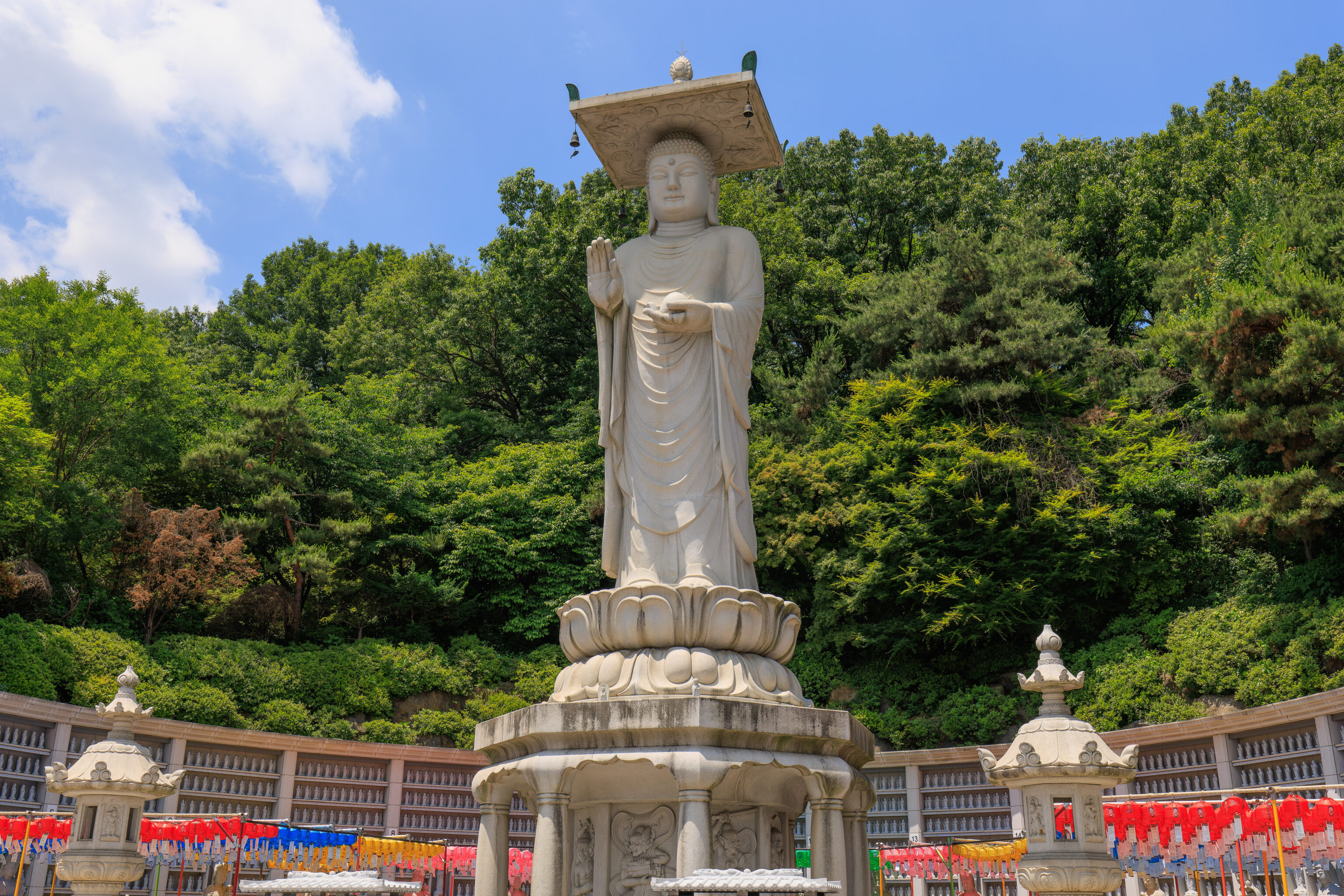
Soon, we made it to the base of the giant Buddha statue. This is the 미륵불 Maitreya Buddha.
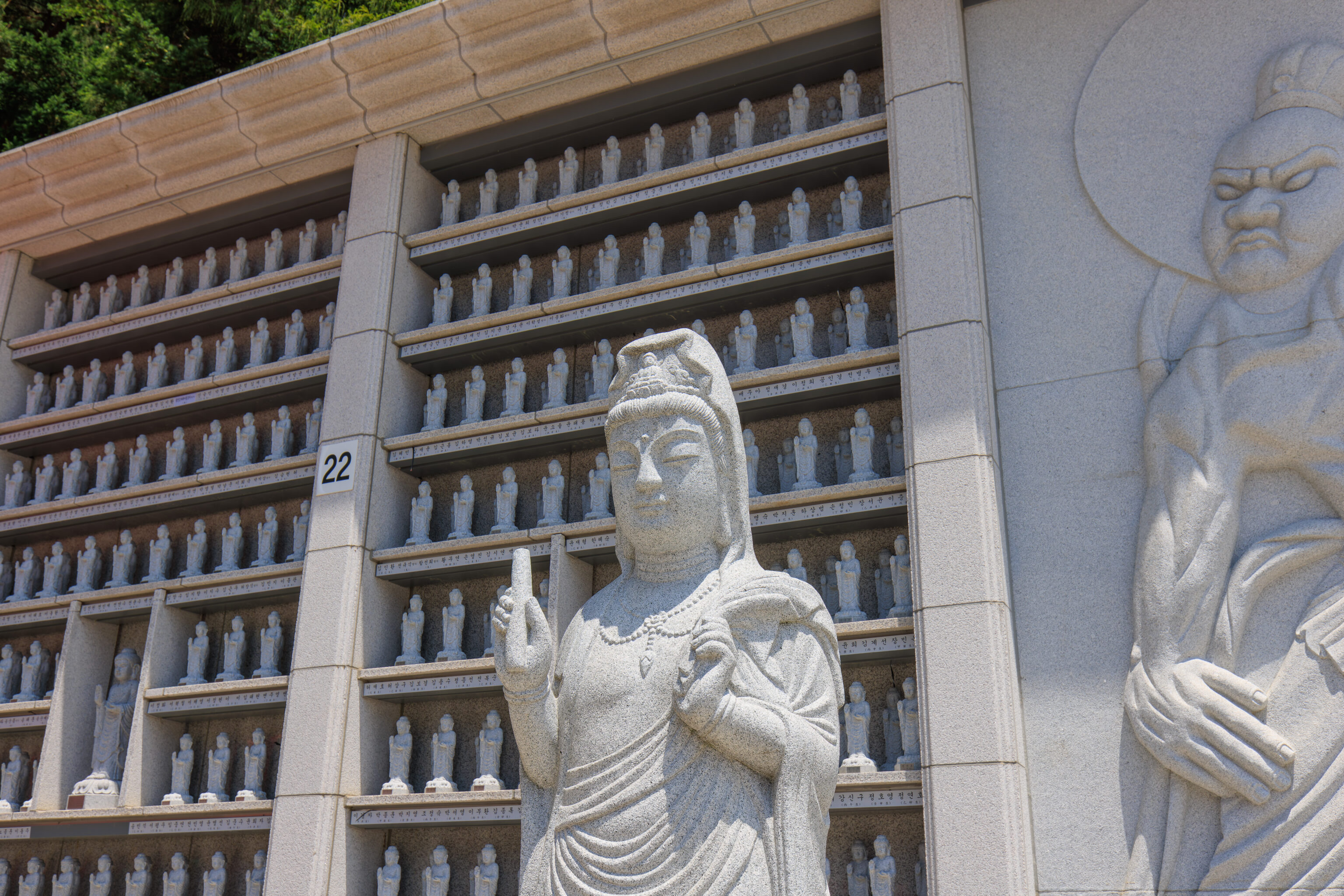
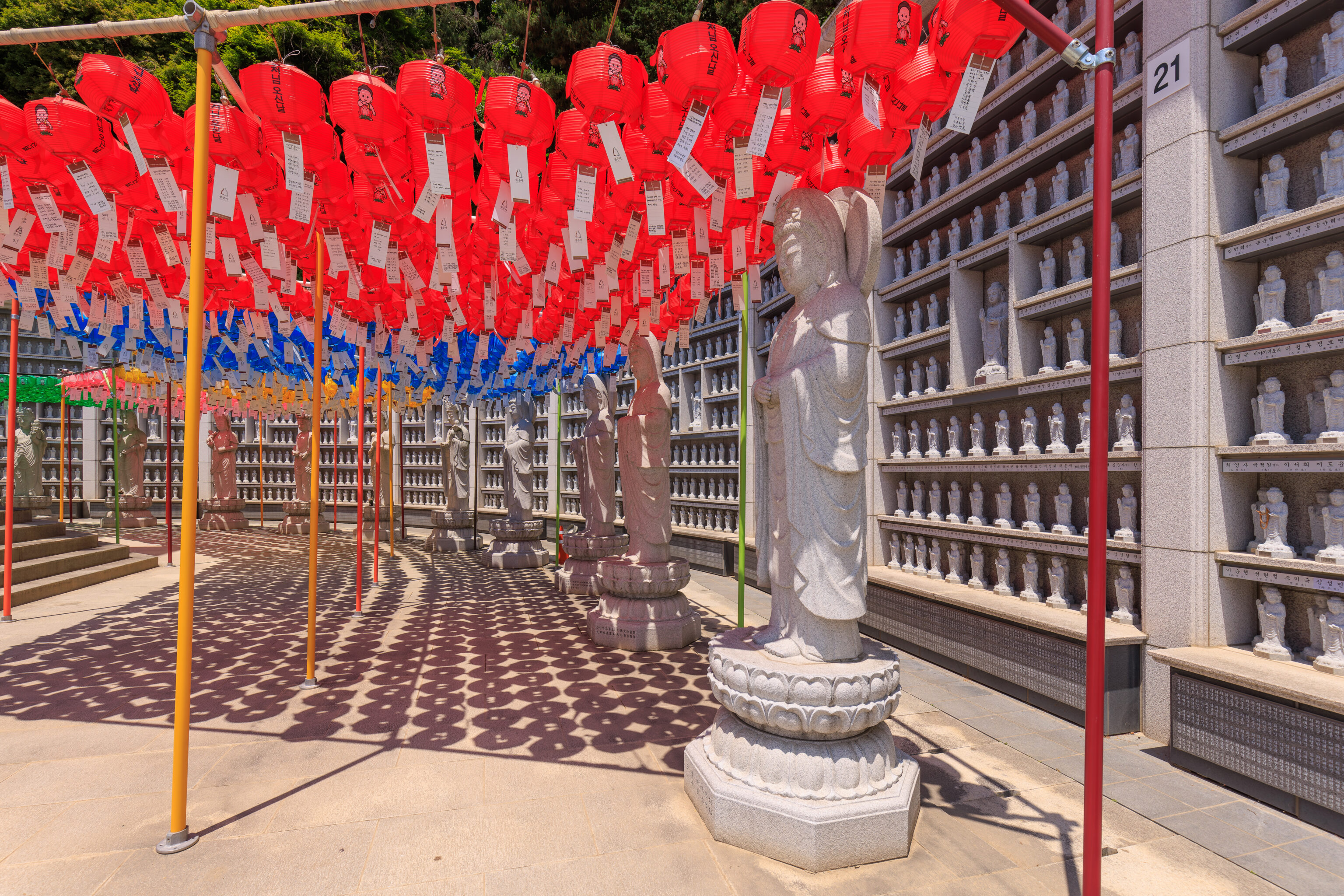
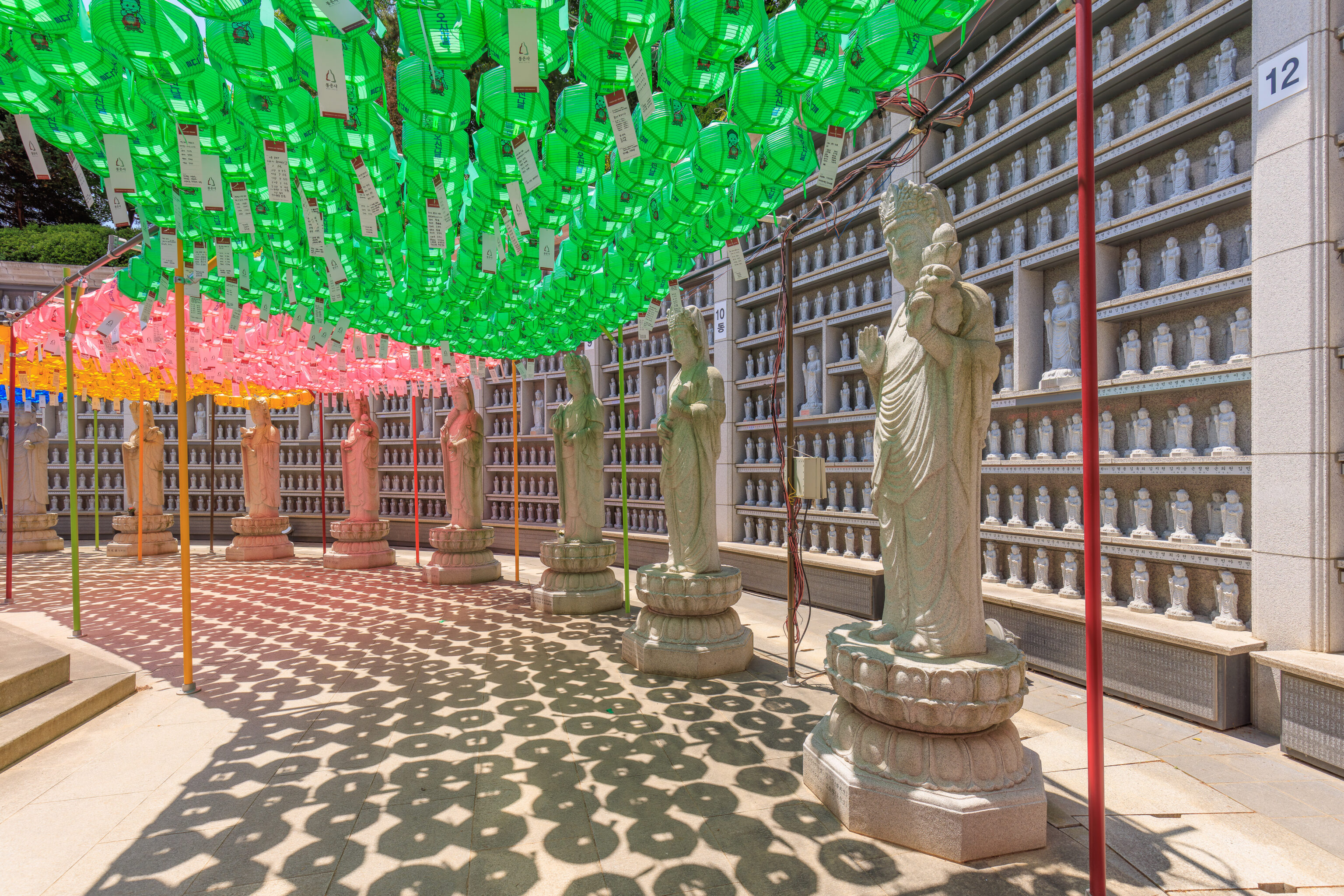
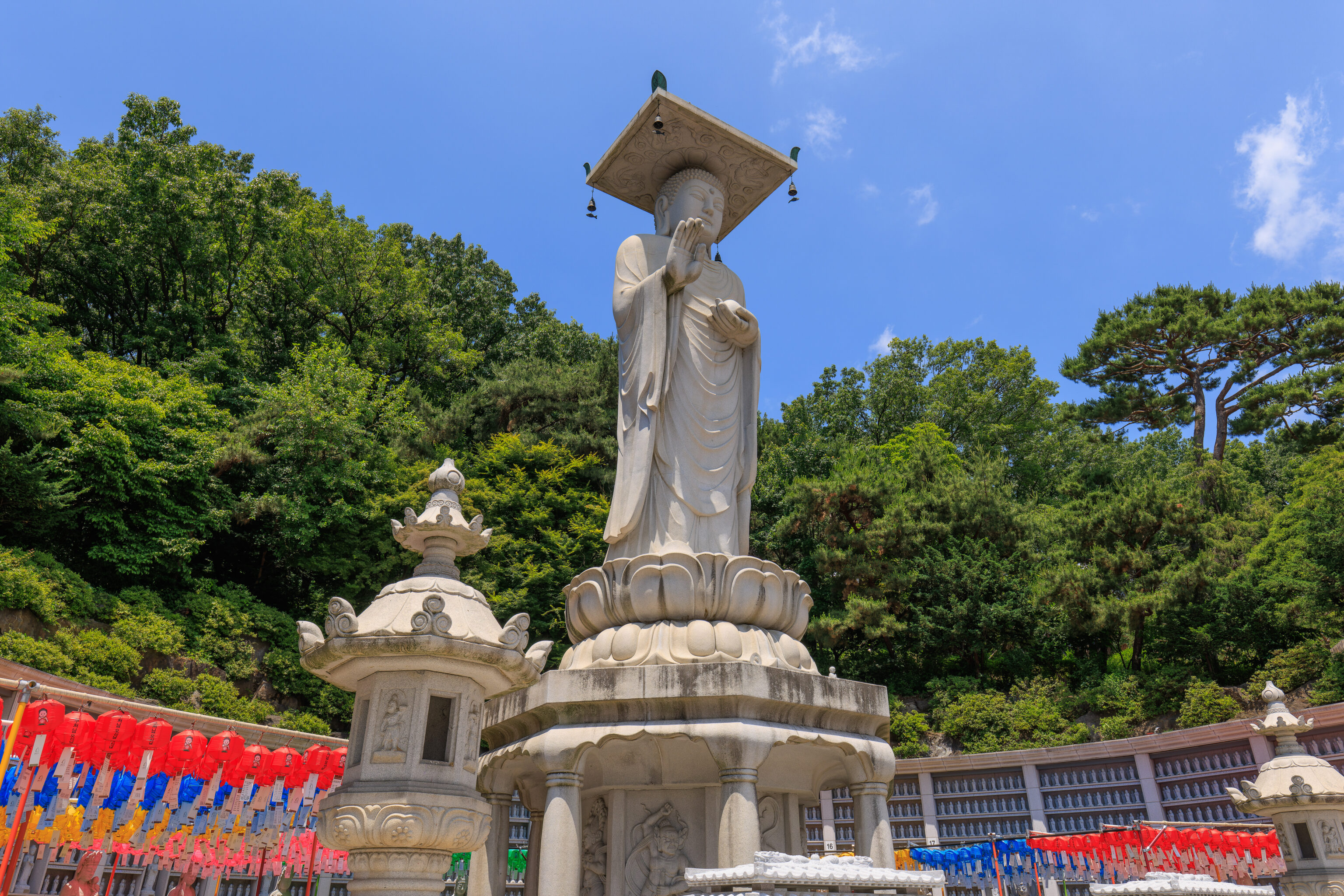
We looped around the statue. It is surrounded by shelves holding hundreds of smaller statues. Each one seems to be labelled with a name.
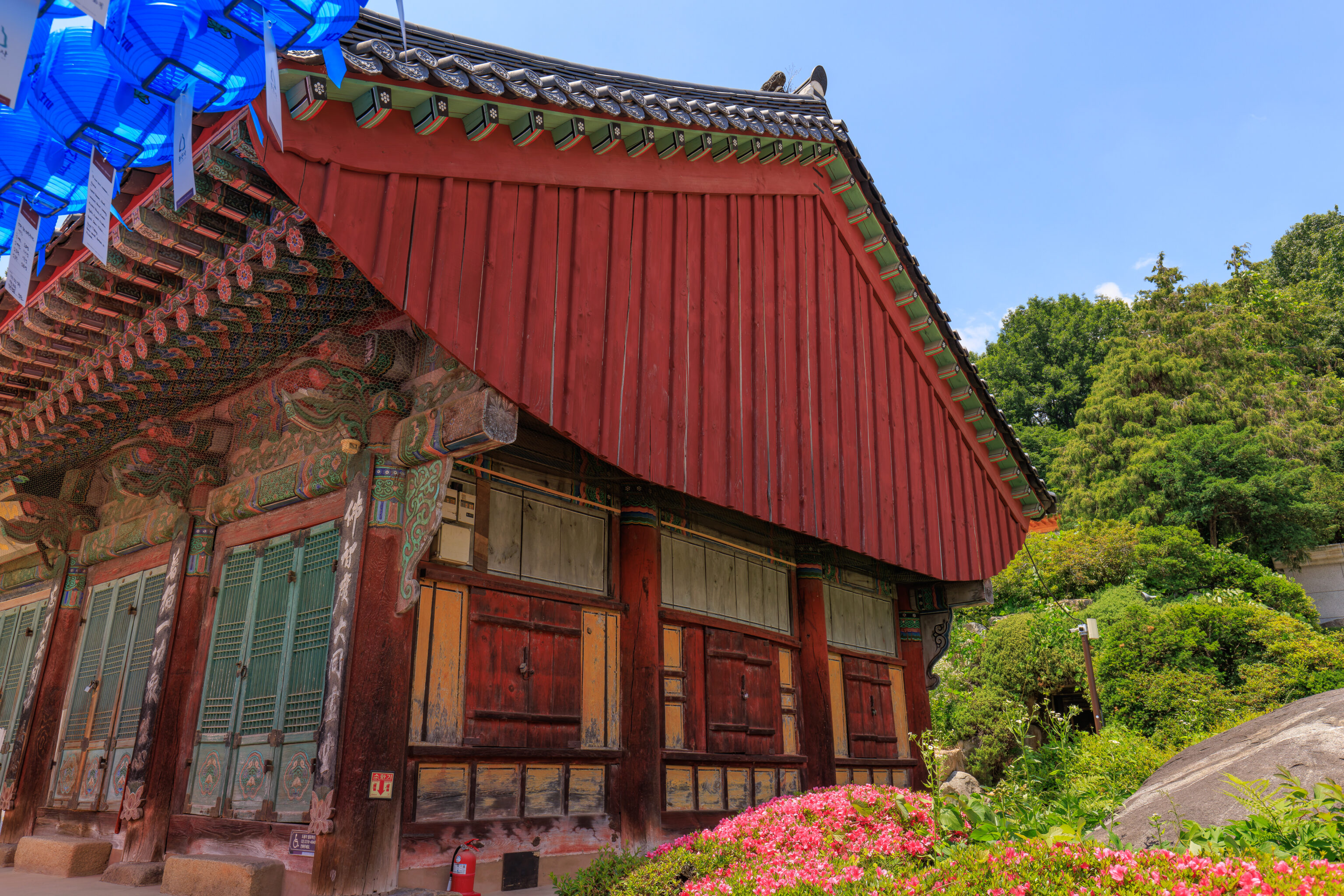
We continued on, reaching this large wooden building, the 판전 Panjeon. The paint was rather faded, though part of the roof structure seems to have been recently renovated.
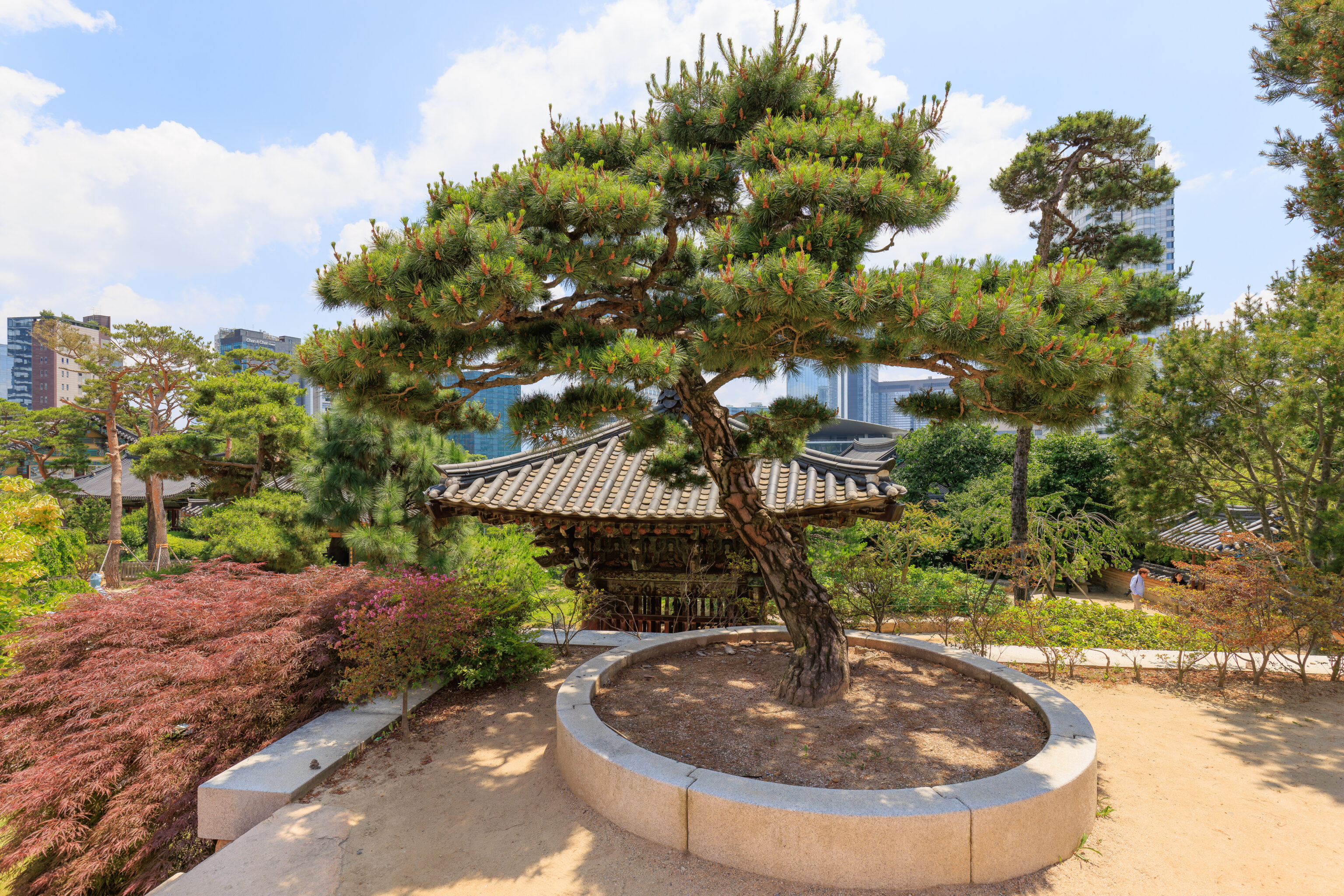
We walked by this tree that was in front of the Panjeon.
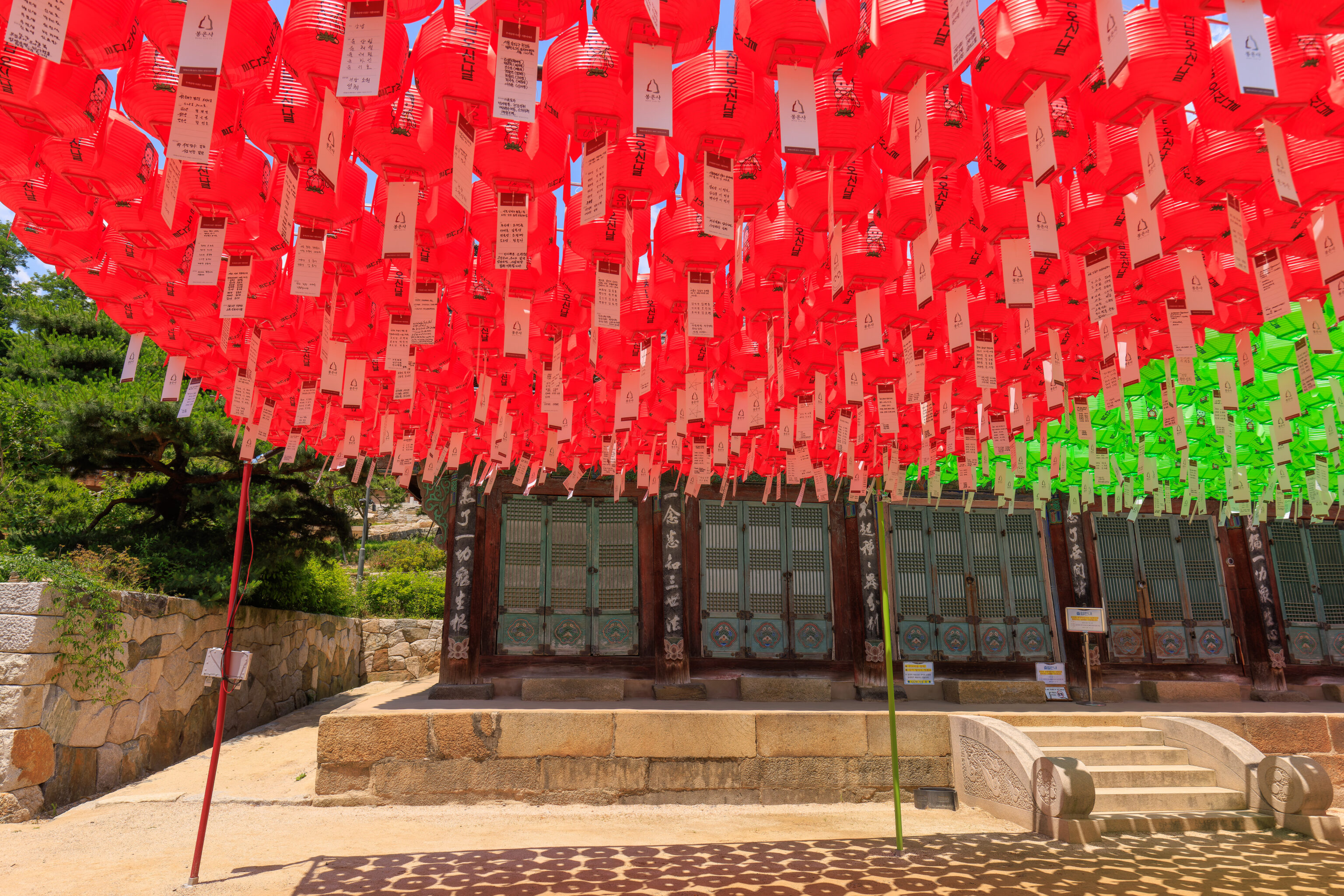
The Panjeon was not open.
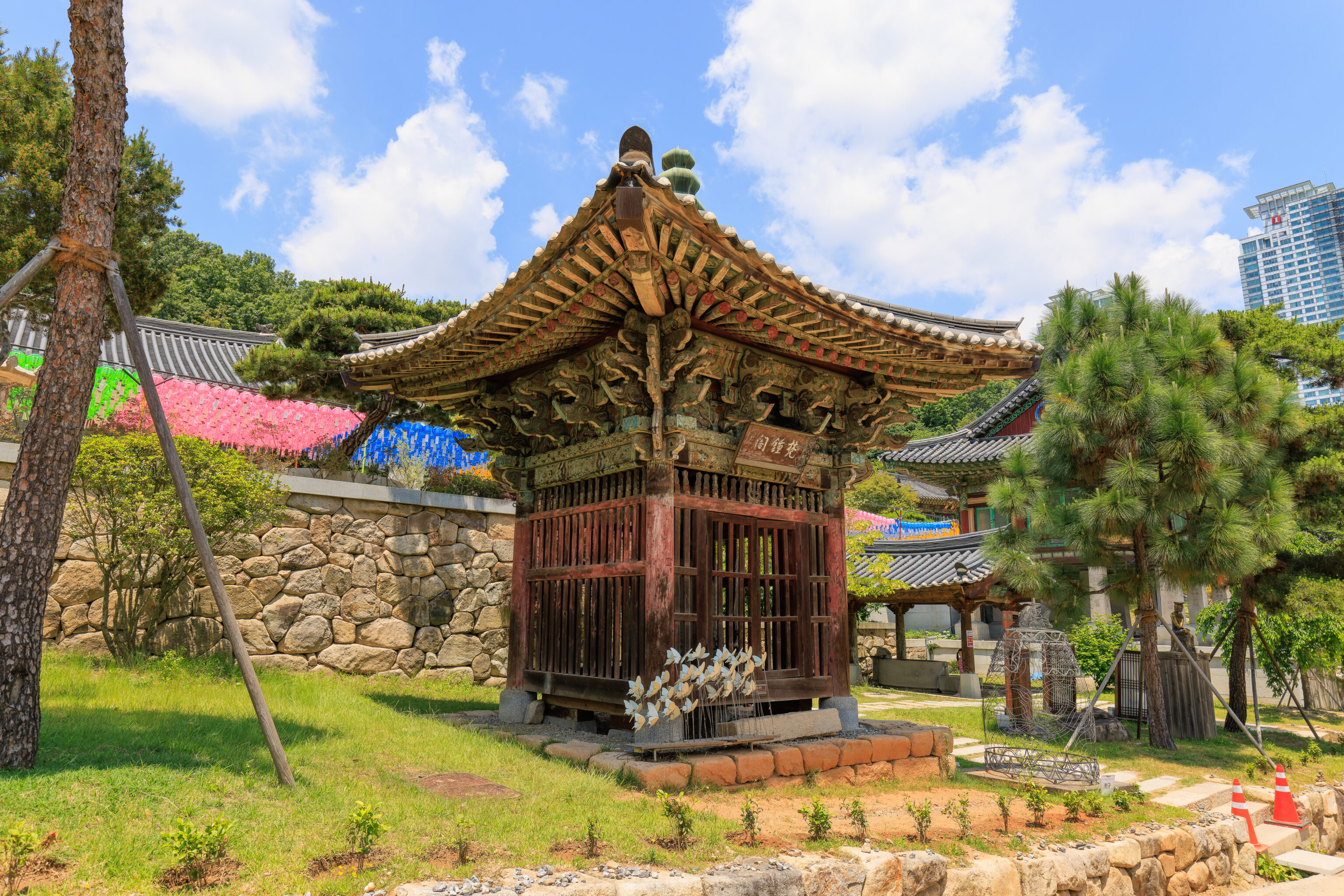
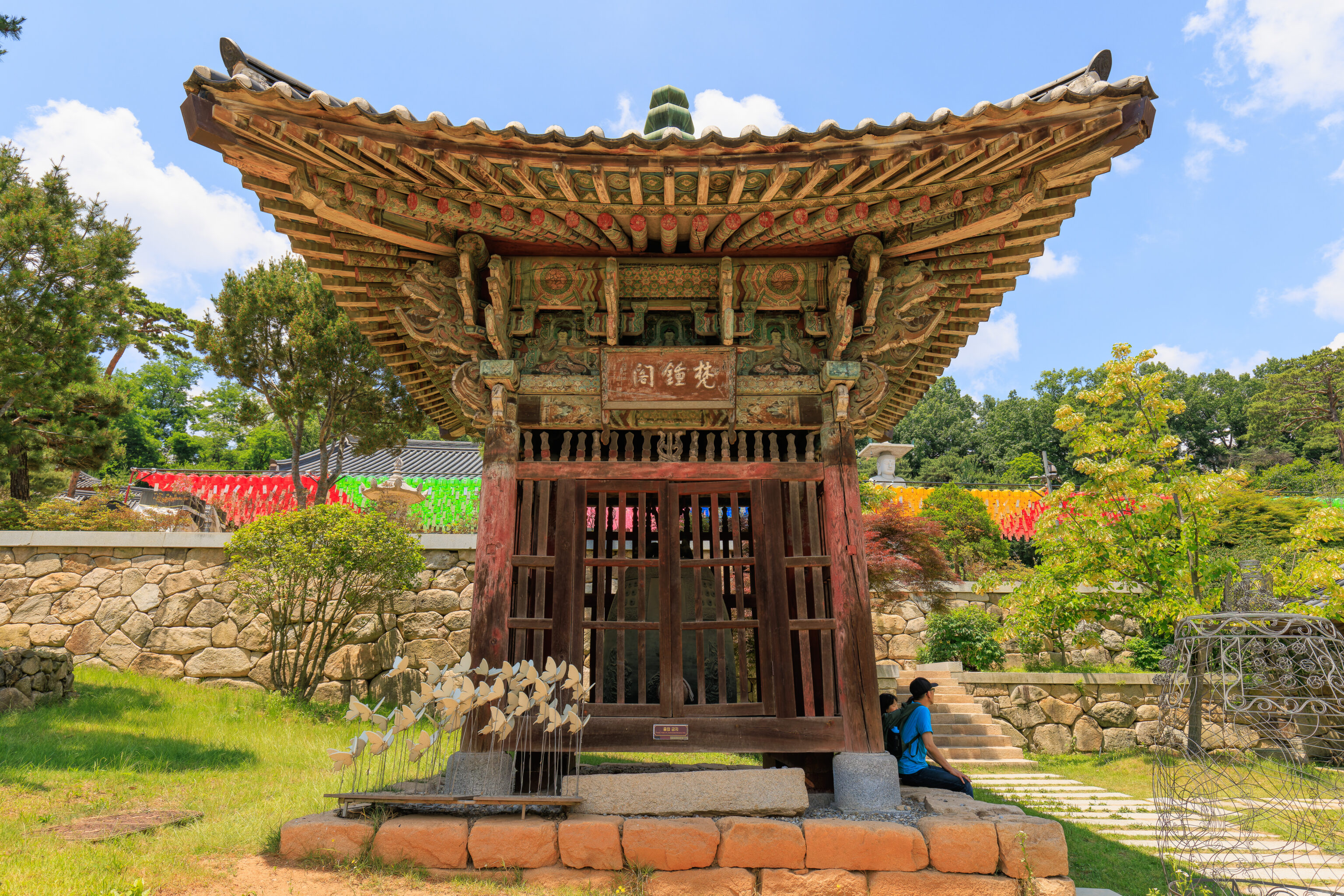
Below the tree in front of the Panjeon, we came across this small building which holds a bell. Is this the bronze bell that was referenced earlier on a sign?
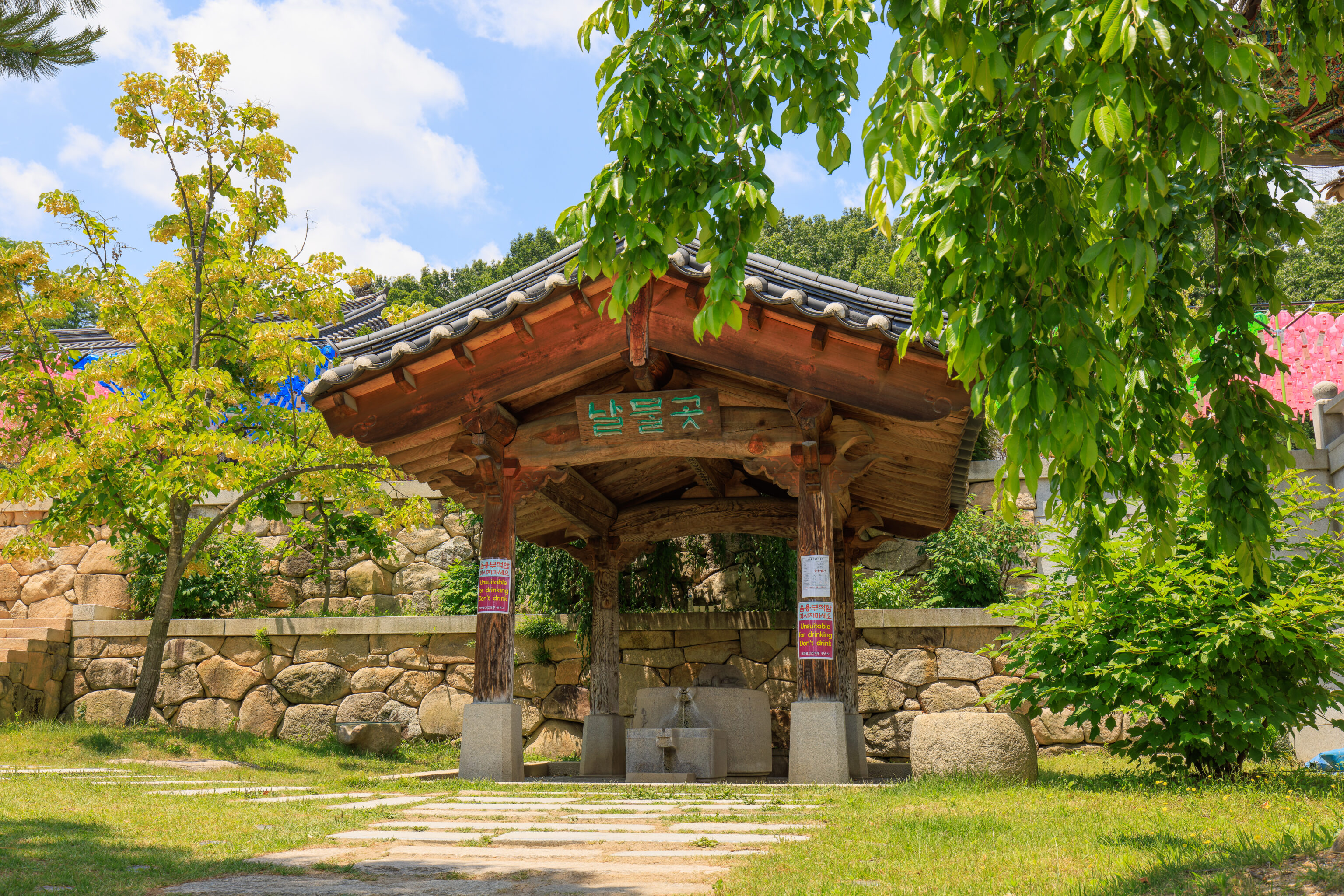
We also came across what seems to be a cleansing station, something very common and busy in Japanese temples. It doesn’t seem to really be a custom at Korean Buddhist temples though.
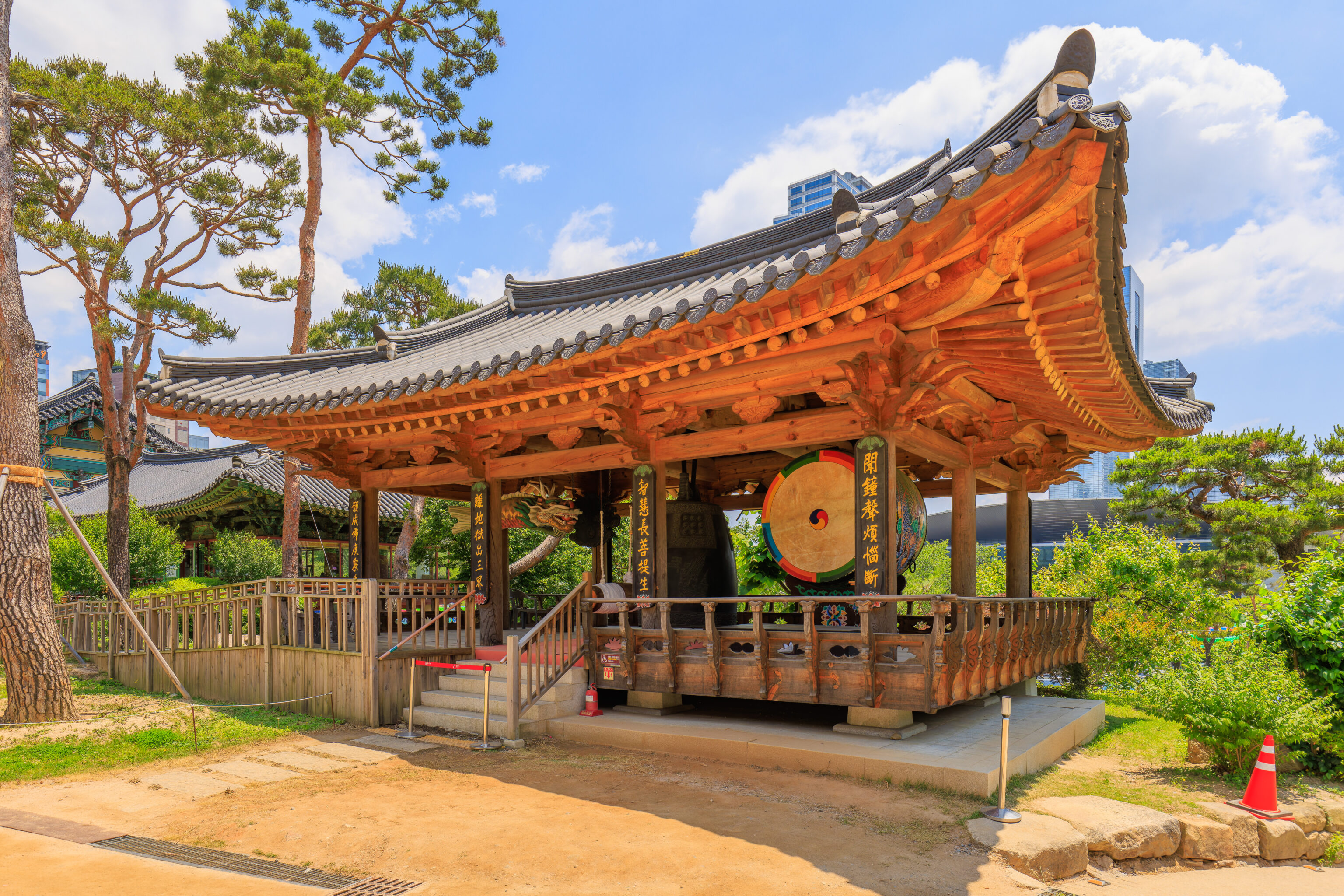
This larger pavilion was nearby. It held a drum, like the ones we saw at the royal guard change ceremonies at Deoksugung and Gyeongbokgung. There was also a large bell. It seemed to be very similar to the one we saw locked away within the small pavilion. Maybe this is a reproduction for use?
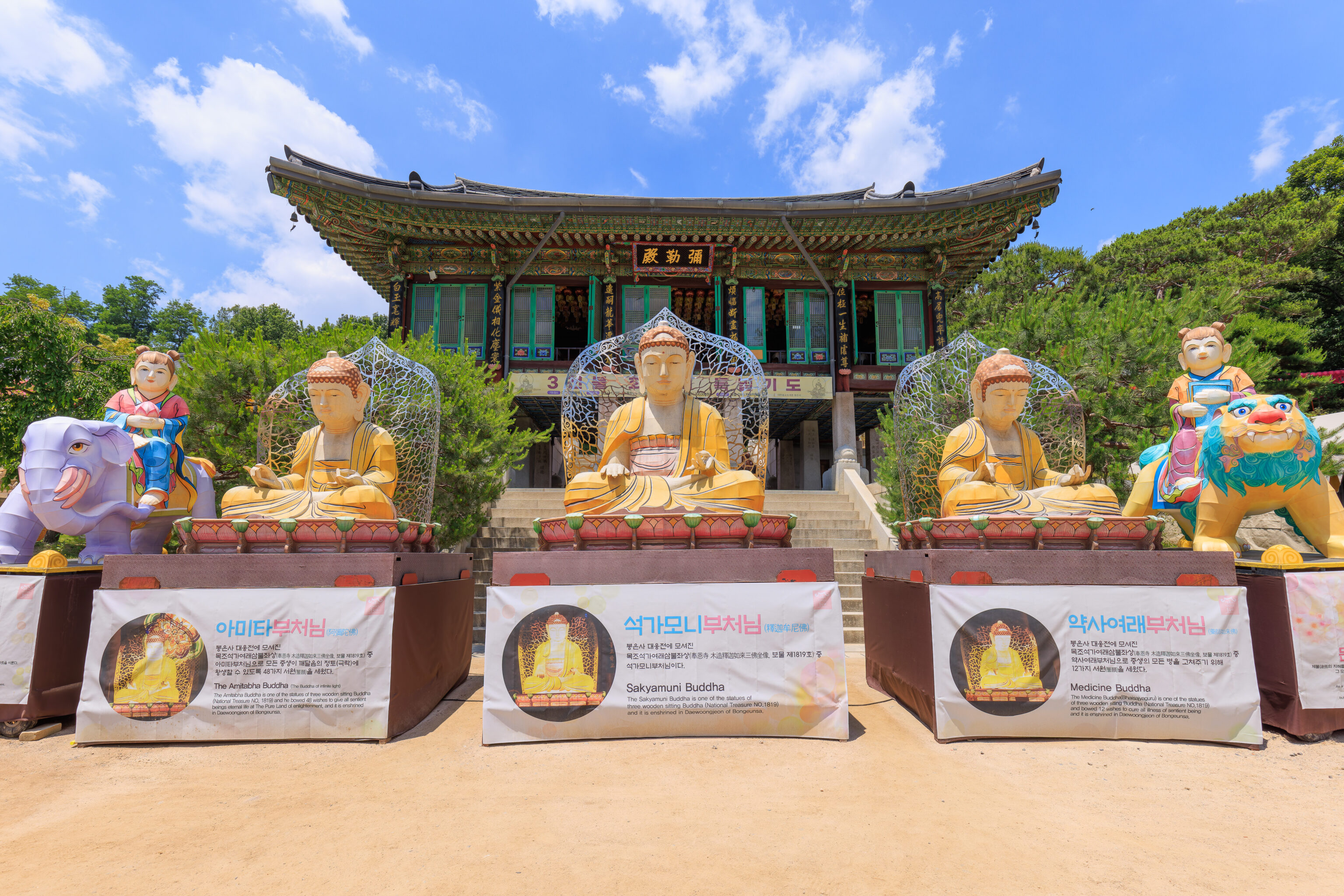
We started to head back towards the main gate to exit. We passed by these statues depicting Buddhas and Bodhisattvas.
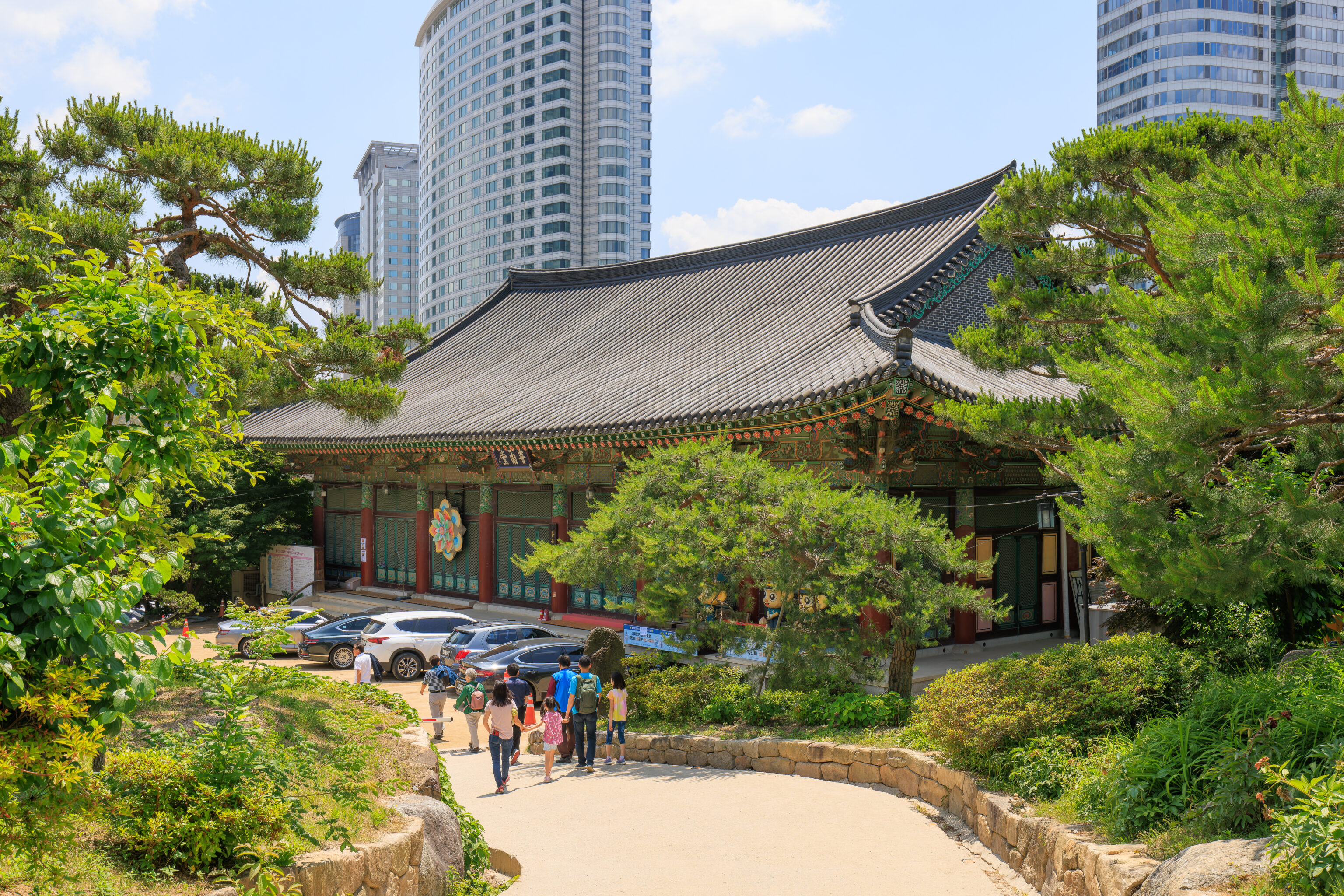
We spotted a large building near the temple’s parking lot.
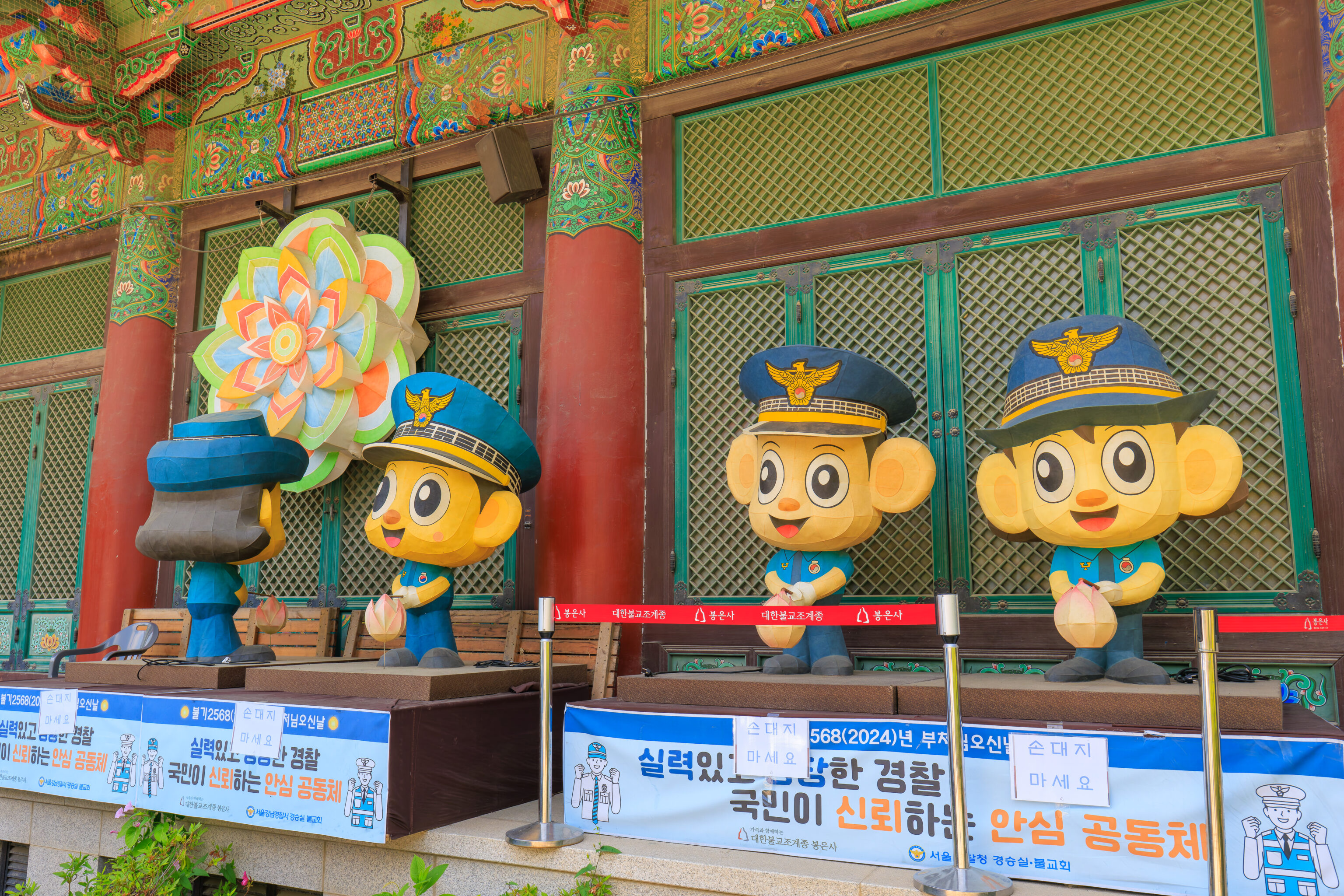
There was a sculpture of a large lotus, not unexpected at a Buddhist temple. There were also four police officer statues. Part of the words on each of the identical banners below are covered, however, they seem to say something like this:
A safe community trusted by competent police officers and the public.
Bongeunsa Temple, Jogye Order of Korean Buddhism
Seoul Gangnam Police Station Gyeongseungsil Buddhist Association
The banner references 2568, which is the year now after Buddha’s birthday in the Buddhist calendar.
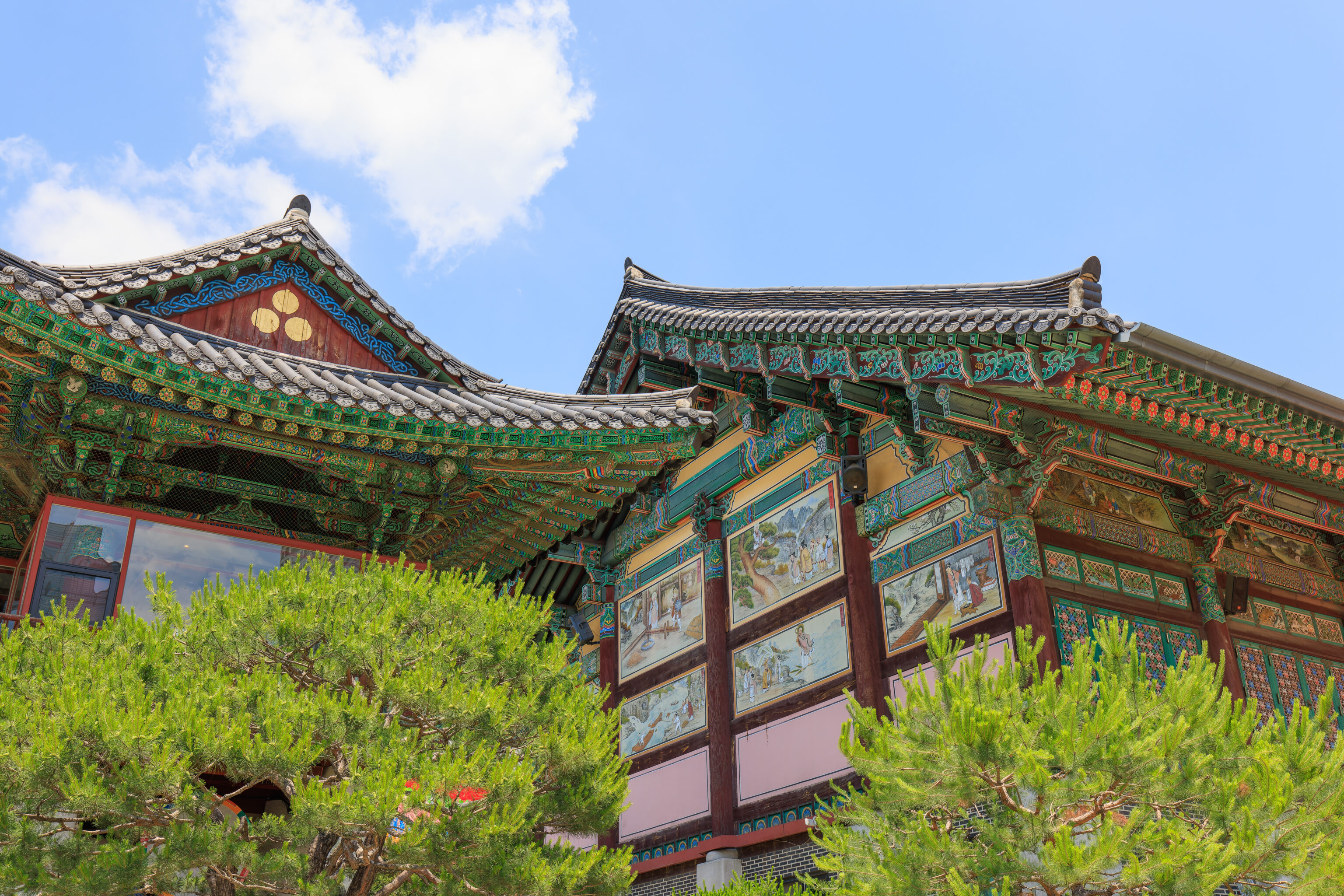
We returned to the Beopwangru from the west. Earlier, we had walked past it to the east. The west side is also painted with murals on its side.
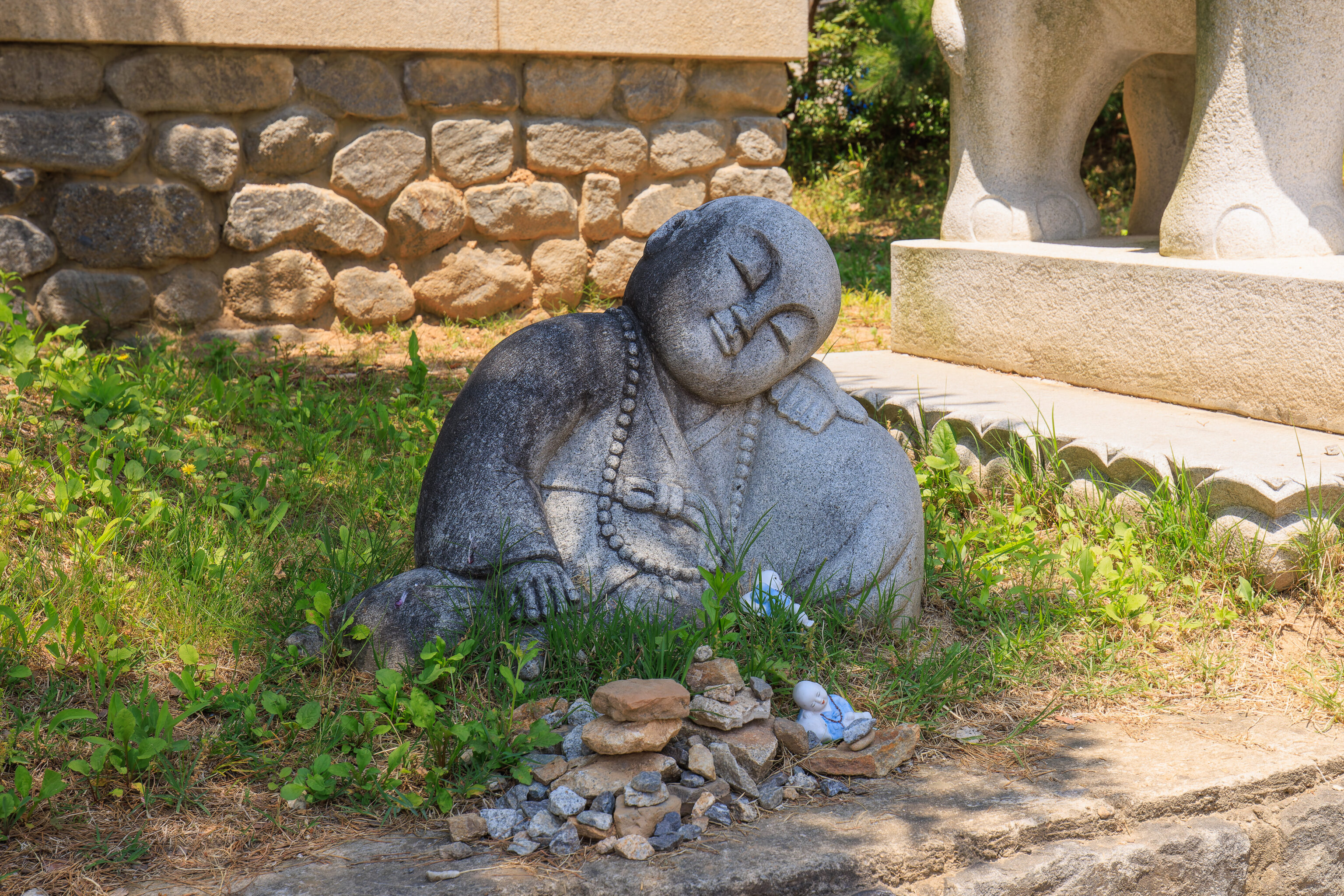
We passed by this small happily resting Buddha sculpture. It was accompanied by two smaller colorful Buddhas in the same pose.
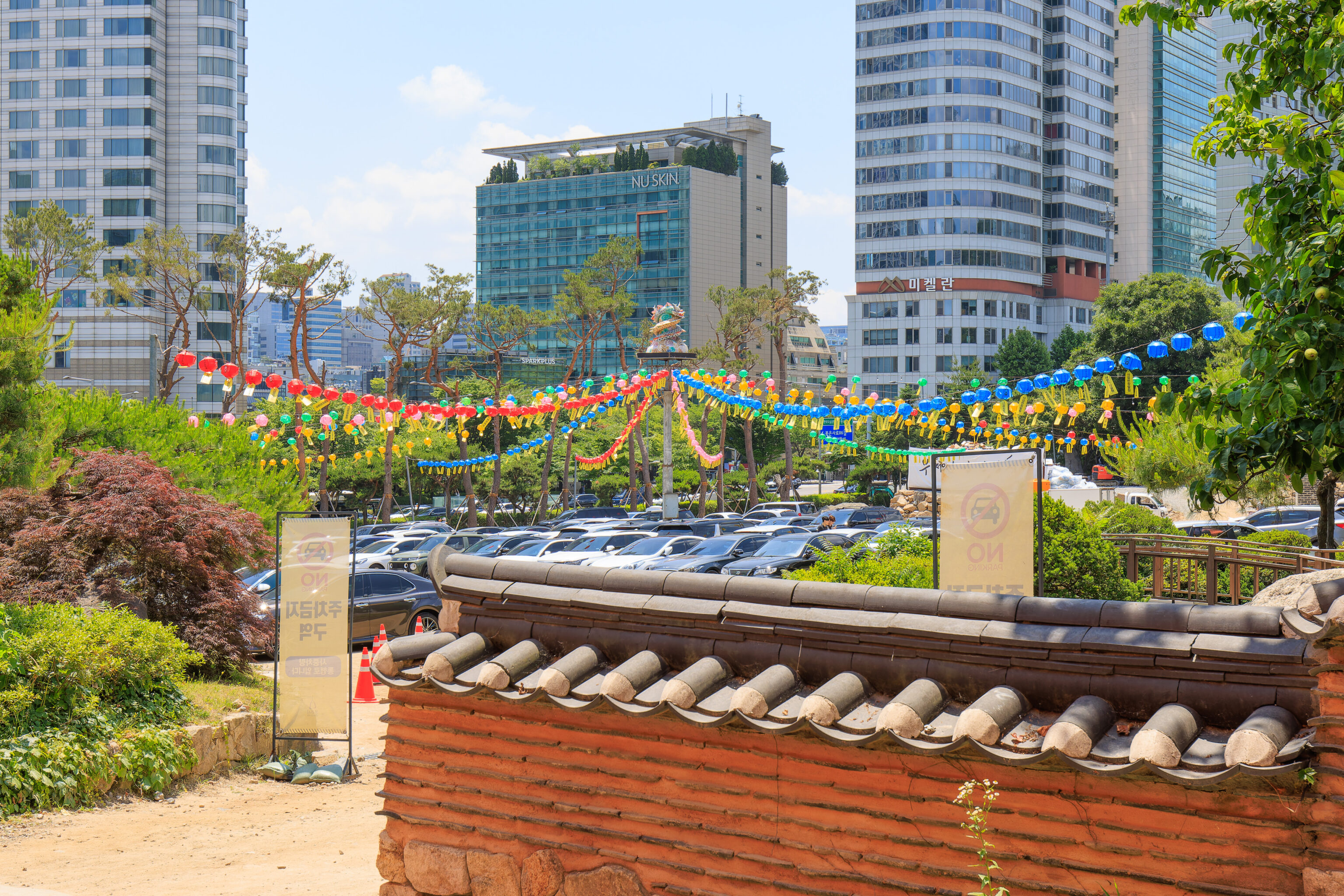
We noticed this pole in the middle of the parking lot. It was reminiscent of a European maypole.
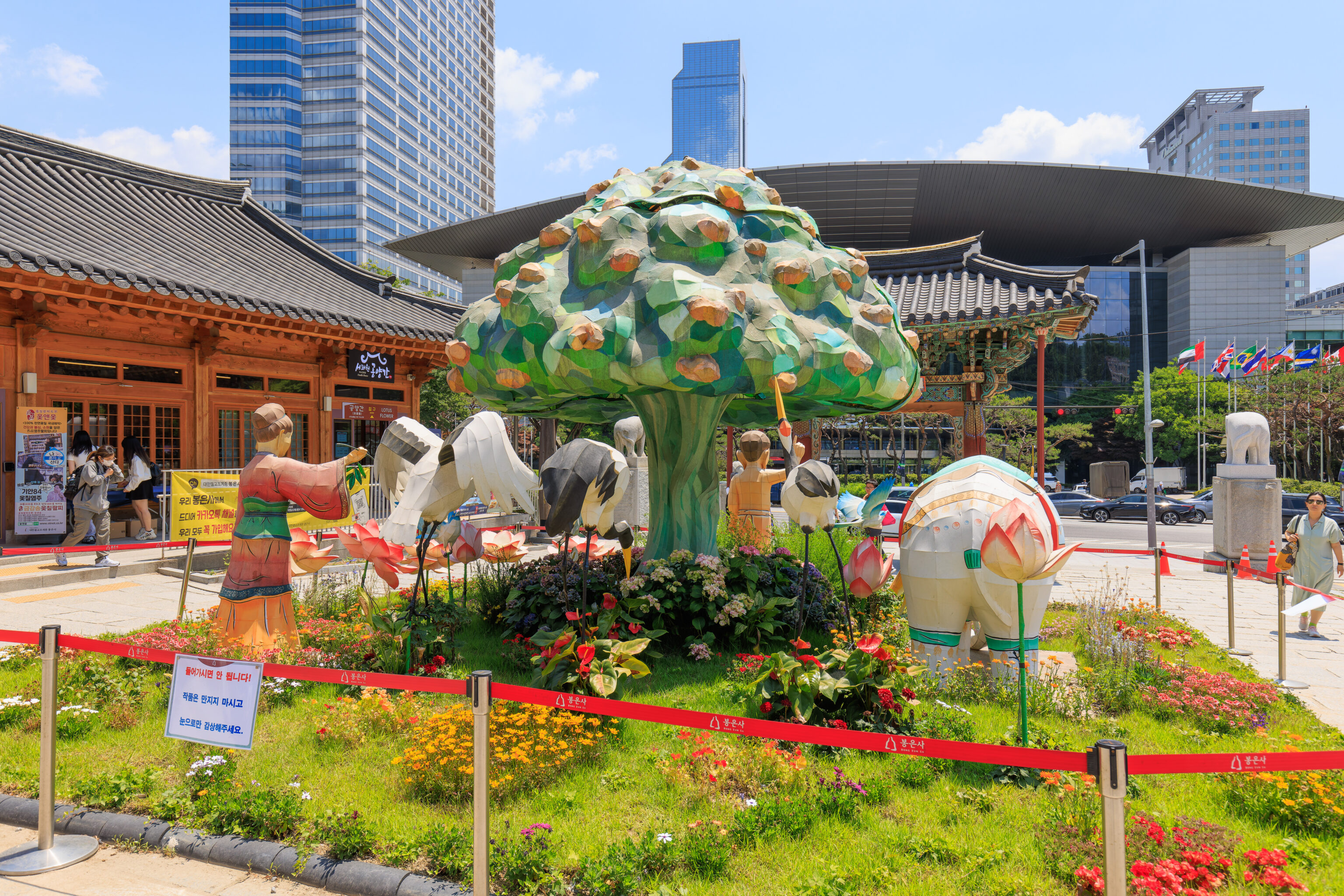
We made it back to the entrance! We briefly checked out the temple shop on our way out.
Lunch
It was almost 1pm by the time left Bongeunsa. We decided to get lunch at the Starfield COEX Mall.
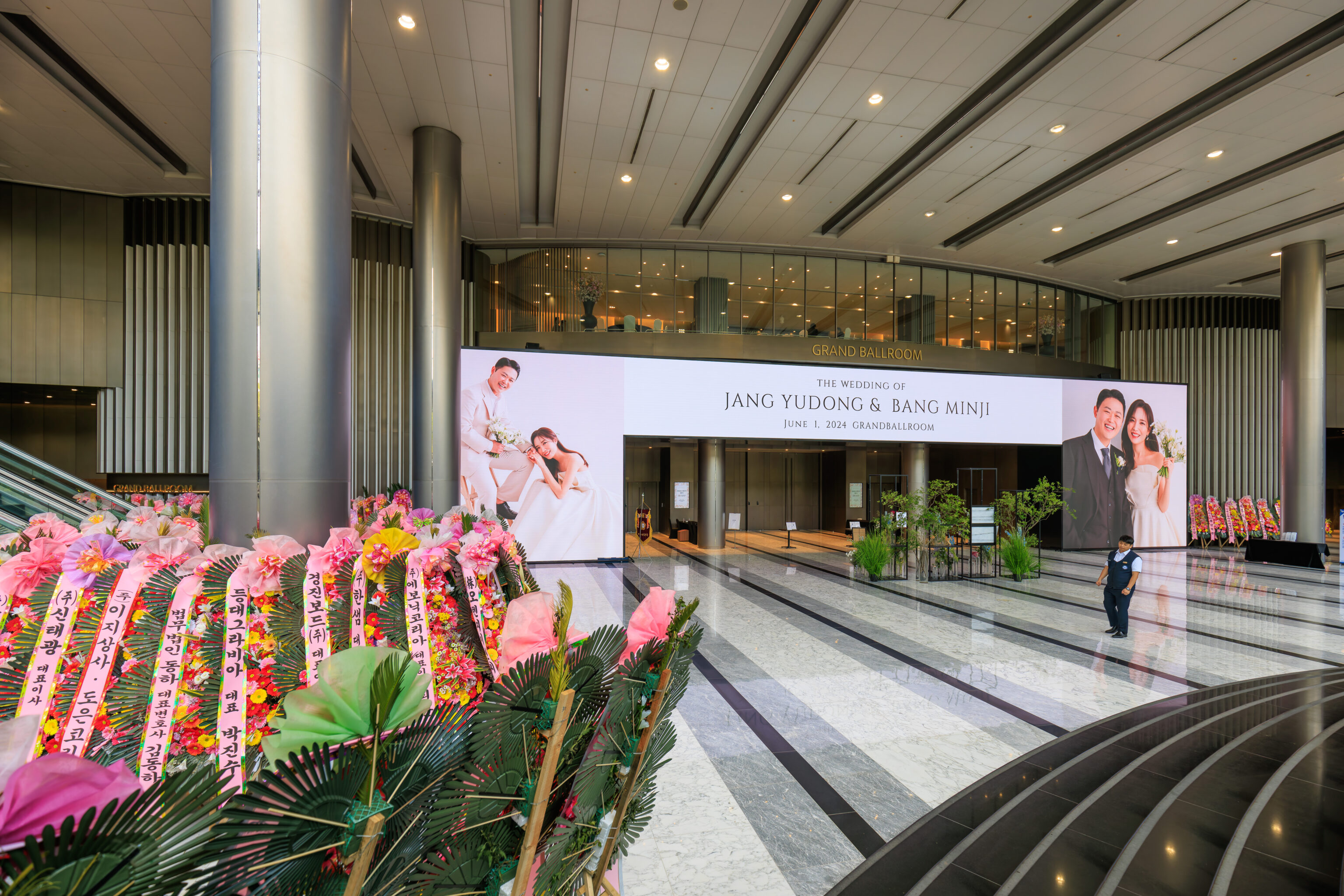
It wasn’t obvious how to best go into the mall from Bongeunsa. We crossed the street and went into the nearest building. It turned out to be a large lobby in front of an event space. A wedding was being held at the time. We decided not to crash the wedding and turned left where we found a way to go down into the mall.
We found out that there is a Haidilao in the mall. Haidilao is a Chinese, from China, hot pot restaurant that is known for its service and food quality. This location just opened earlier this year and was actually pretty hard to find. It seems that it is actually in the underground shopping center of the Oakwood Premier, a hotel. It is right at the very edge where the mall transitions from Starfield to Oakwood.
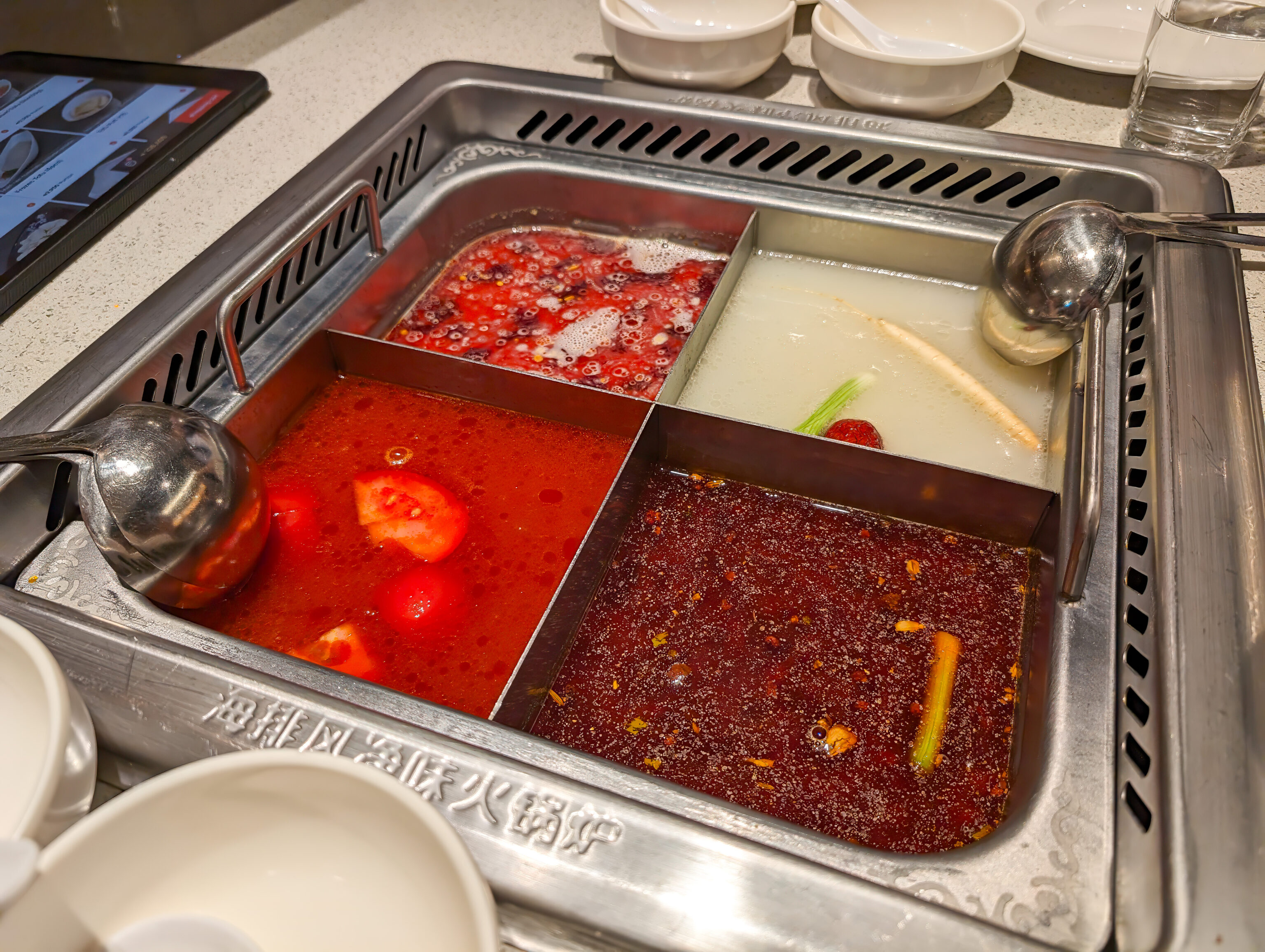
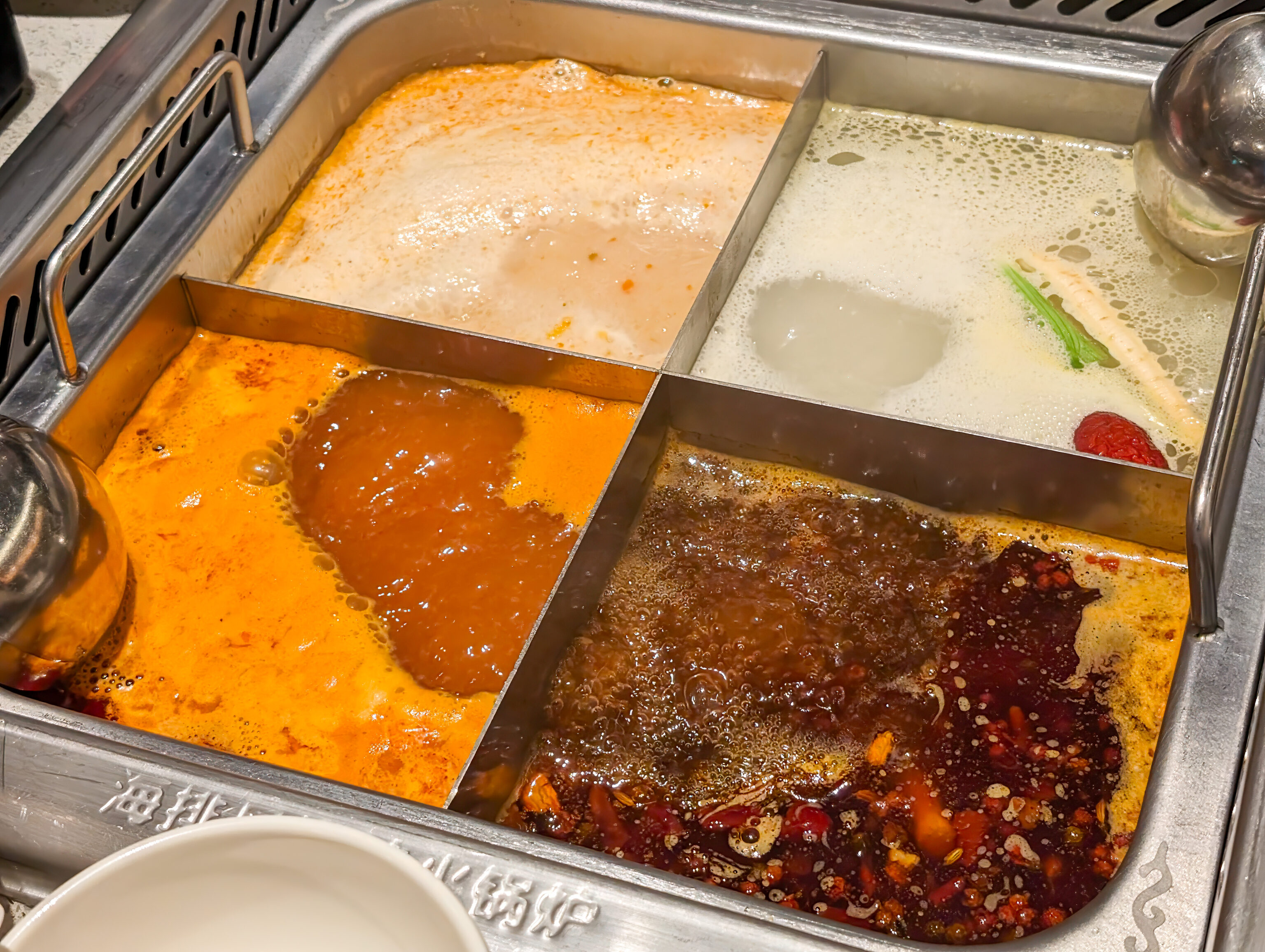
We opted to go for four different soup bases.
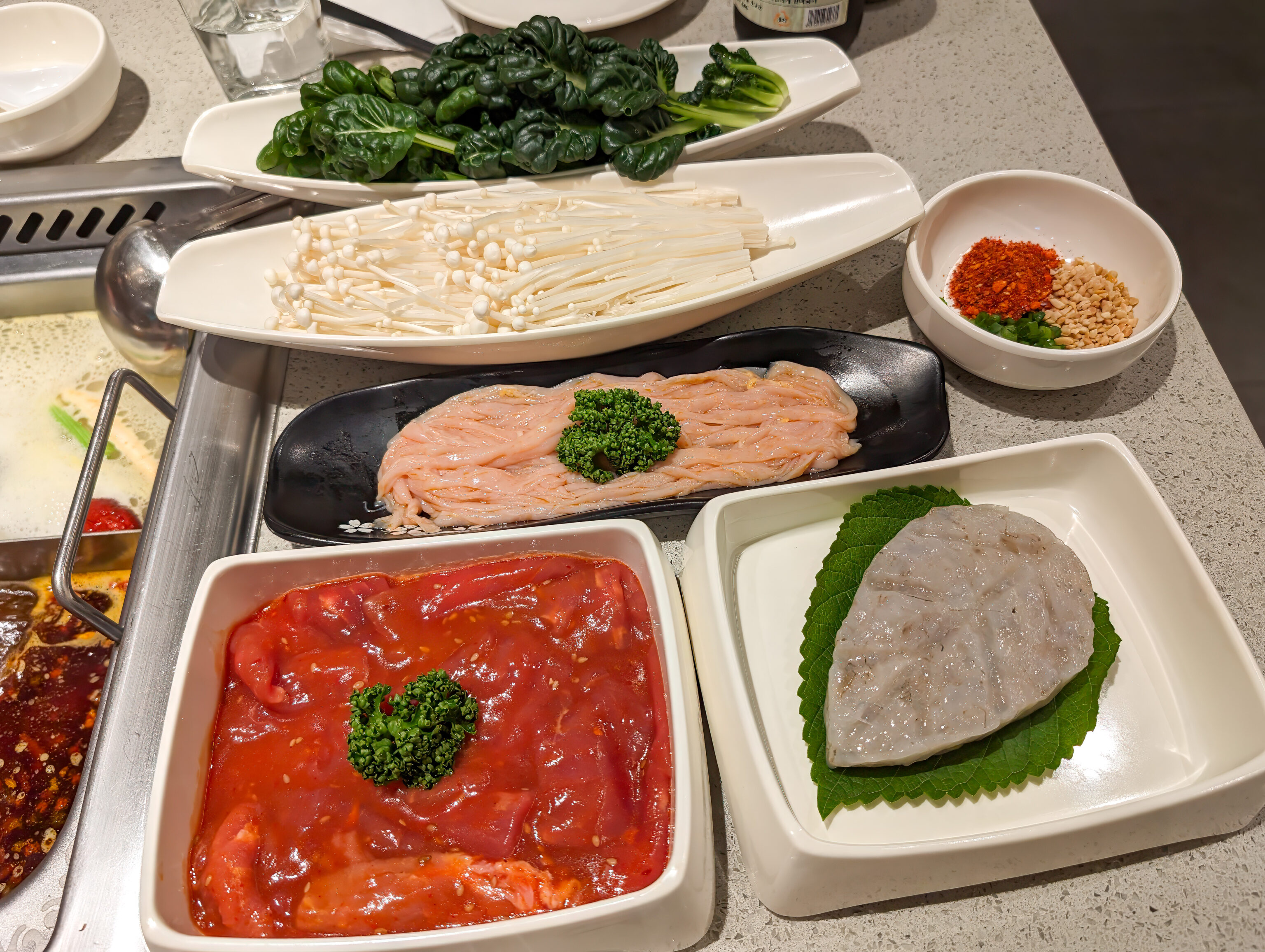
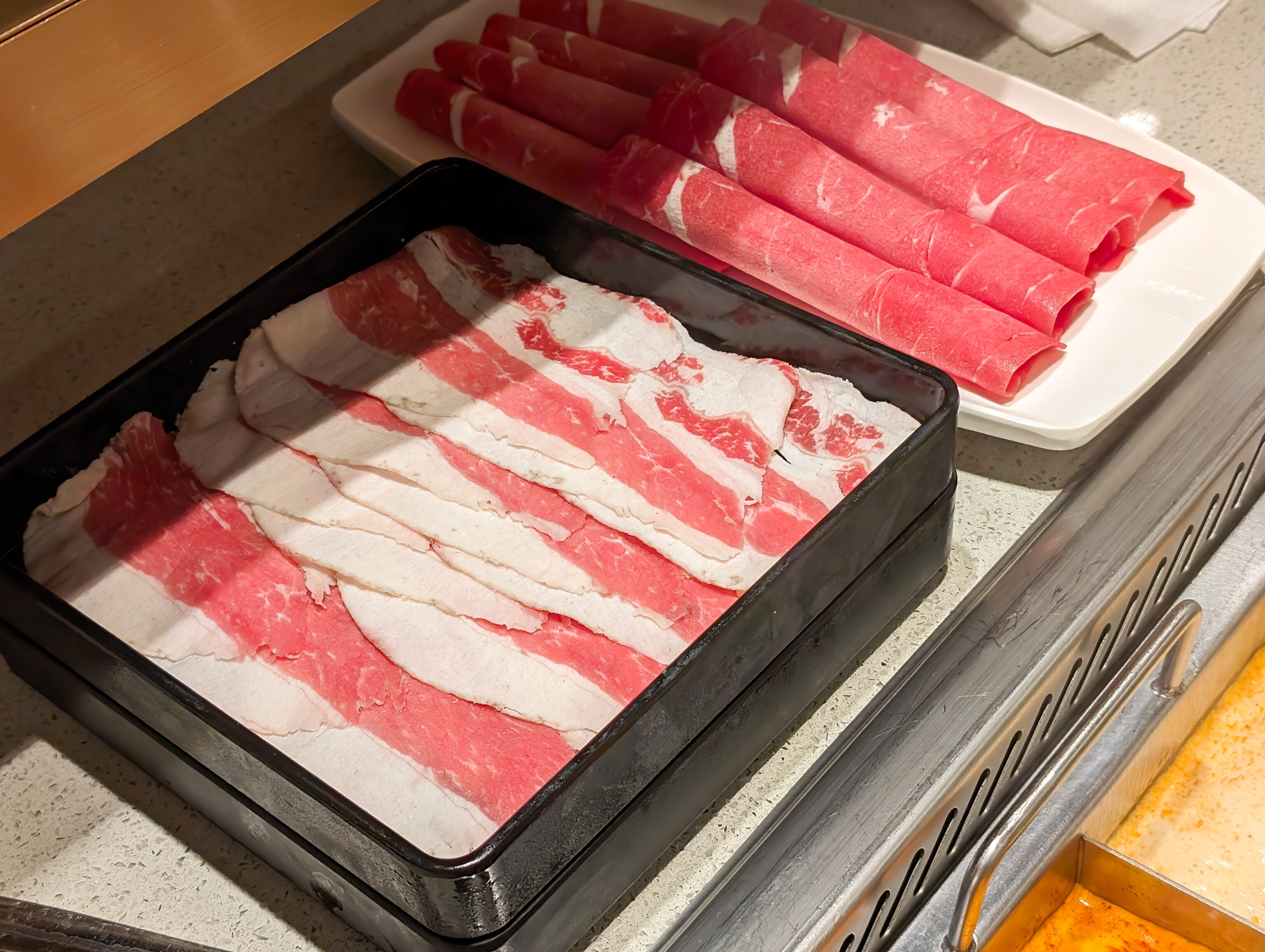
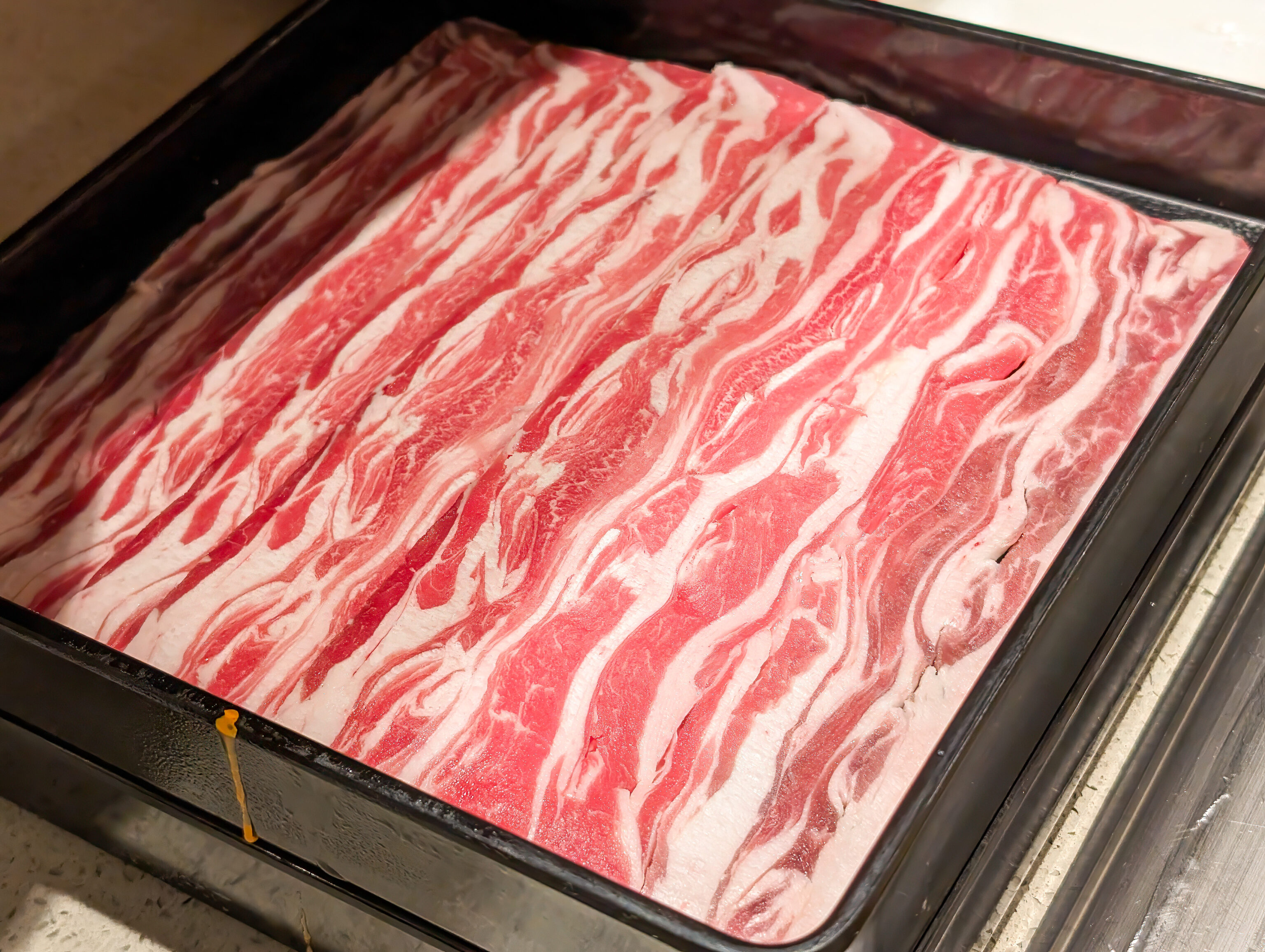
We got a variety of items for the hot pot, not all of which we photographed. Overall, this location seems to have less items than the other Haidilaos that we’ve been to. Service was also not up to the Haidilao standard that we’ve experienced at other locations.
Seolleung and Jeongneung Royal Tombs
After lunch, we walked 10 or so blocks to the west to visit the 선릉과 정릉 Seolleung and Jeongneung Royal Tombs. The two tombs are close to each other and are within the same historical site. These two tombs form the Seolleung Cluster of the Royal Tombs of the Joseon Dynasty UNESCO World Heritage Site with the overall site consisting of 40 different tombs at 18 locations near Seoul.
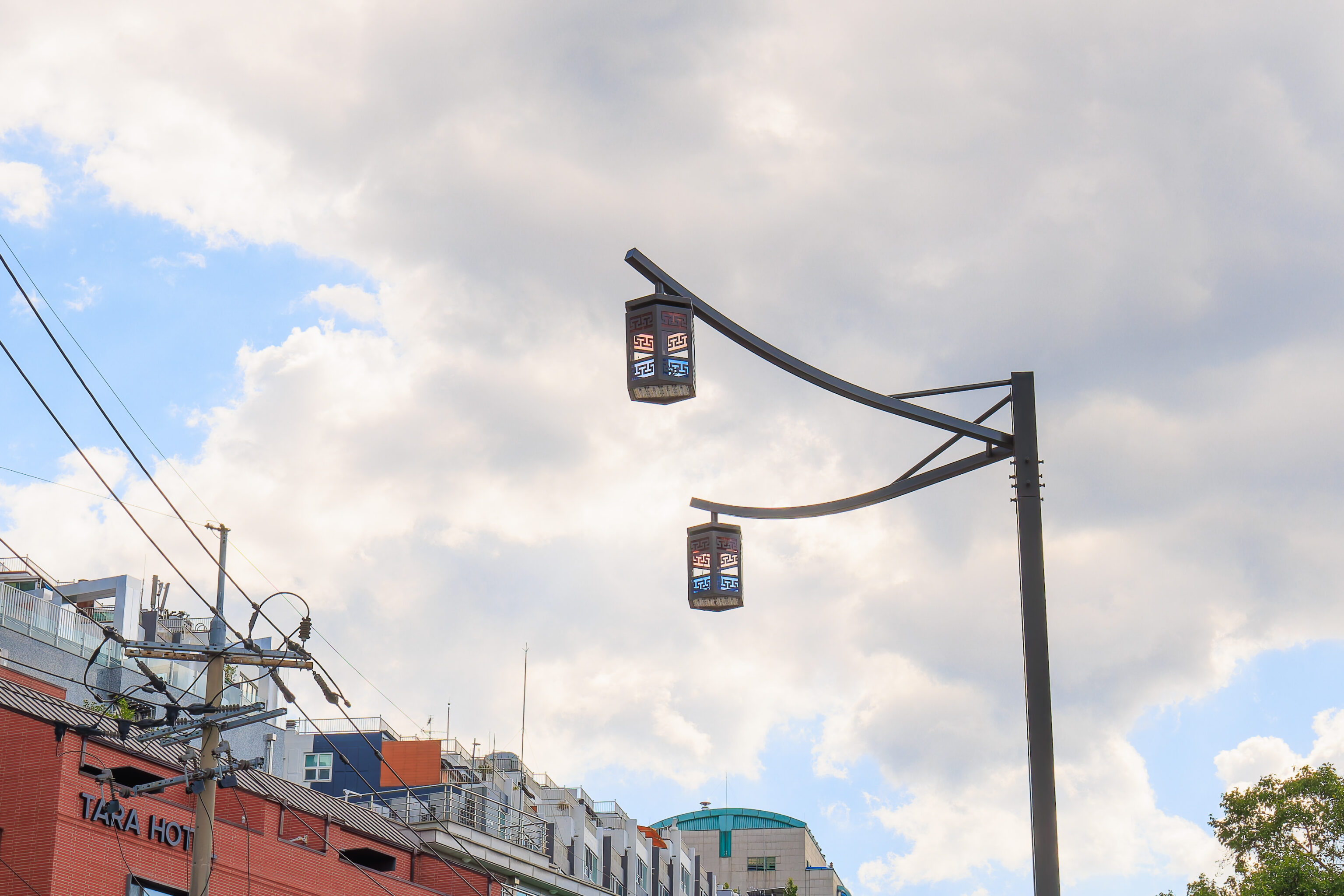
We noticed lantern-like street lamps near the entrance to the tomb site.
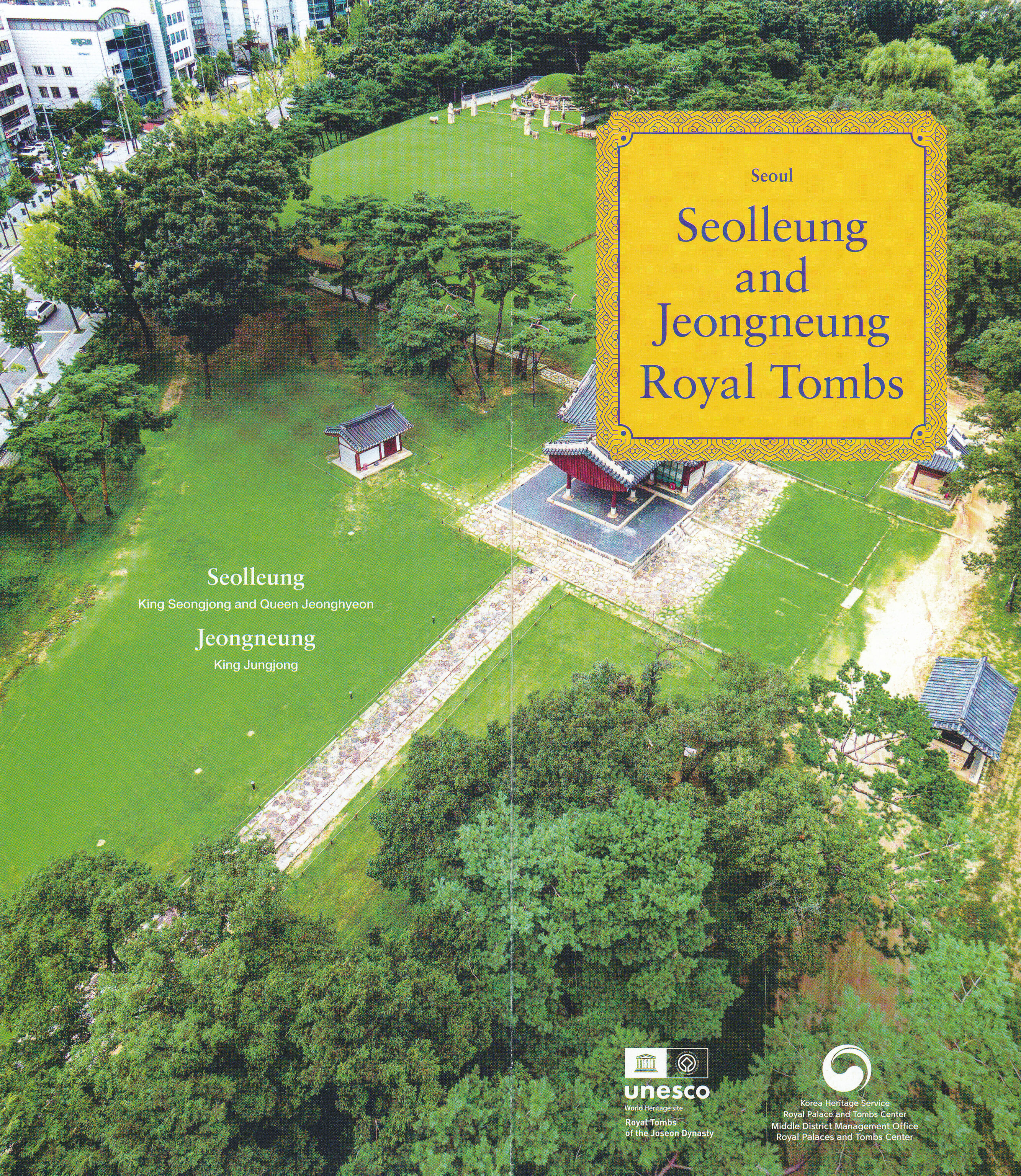
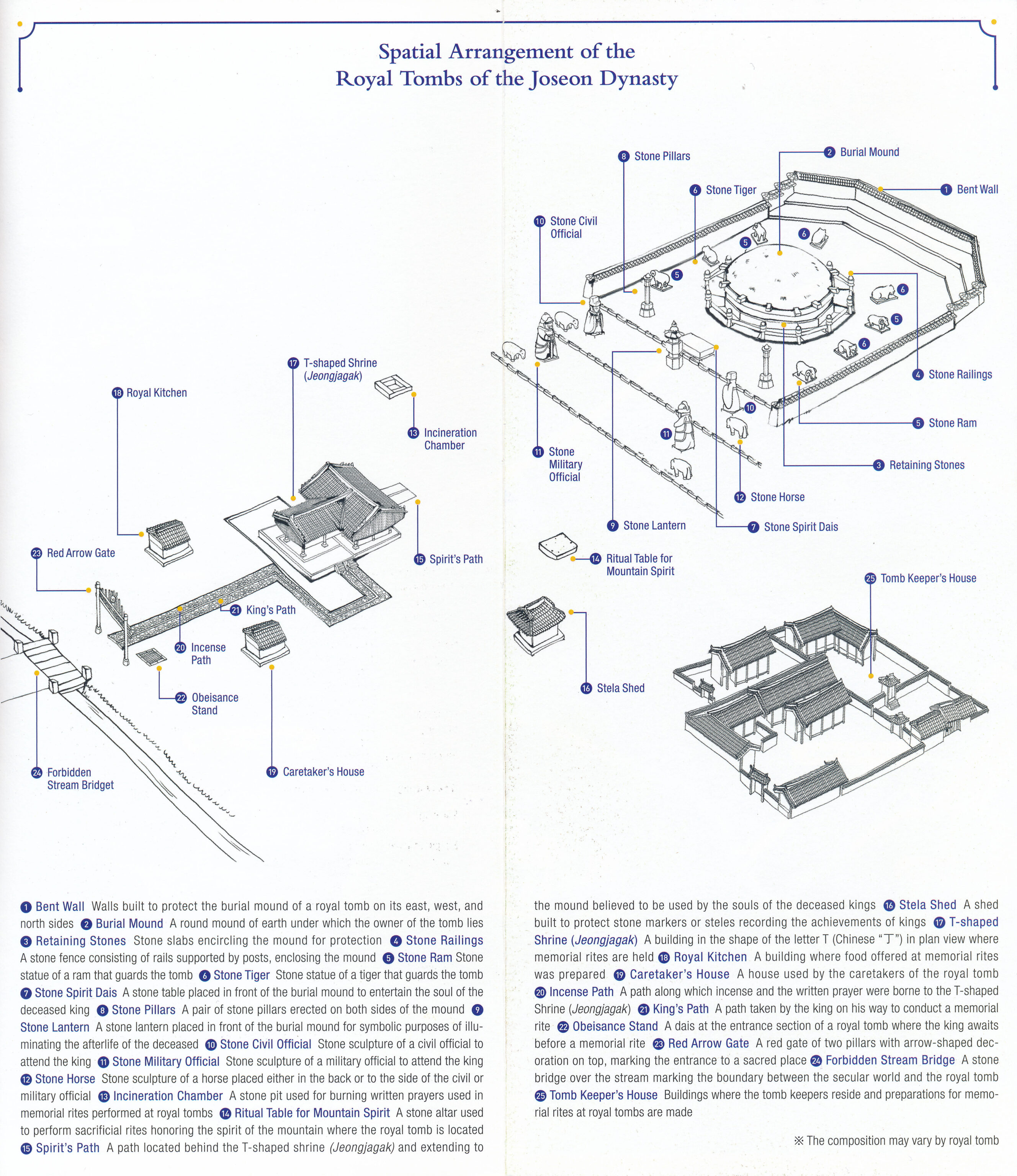
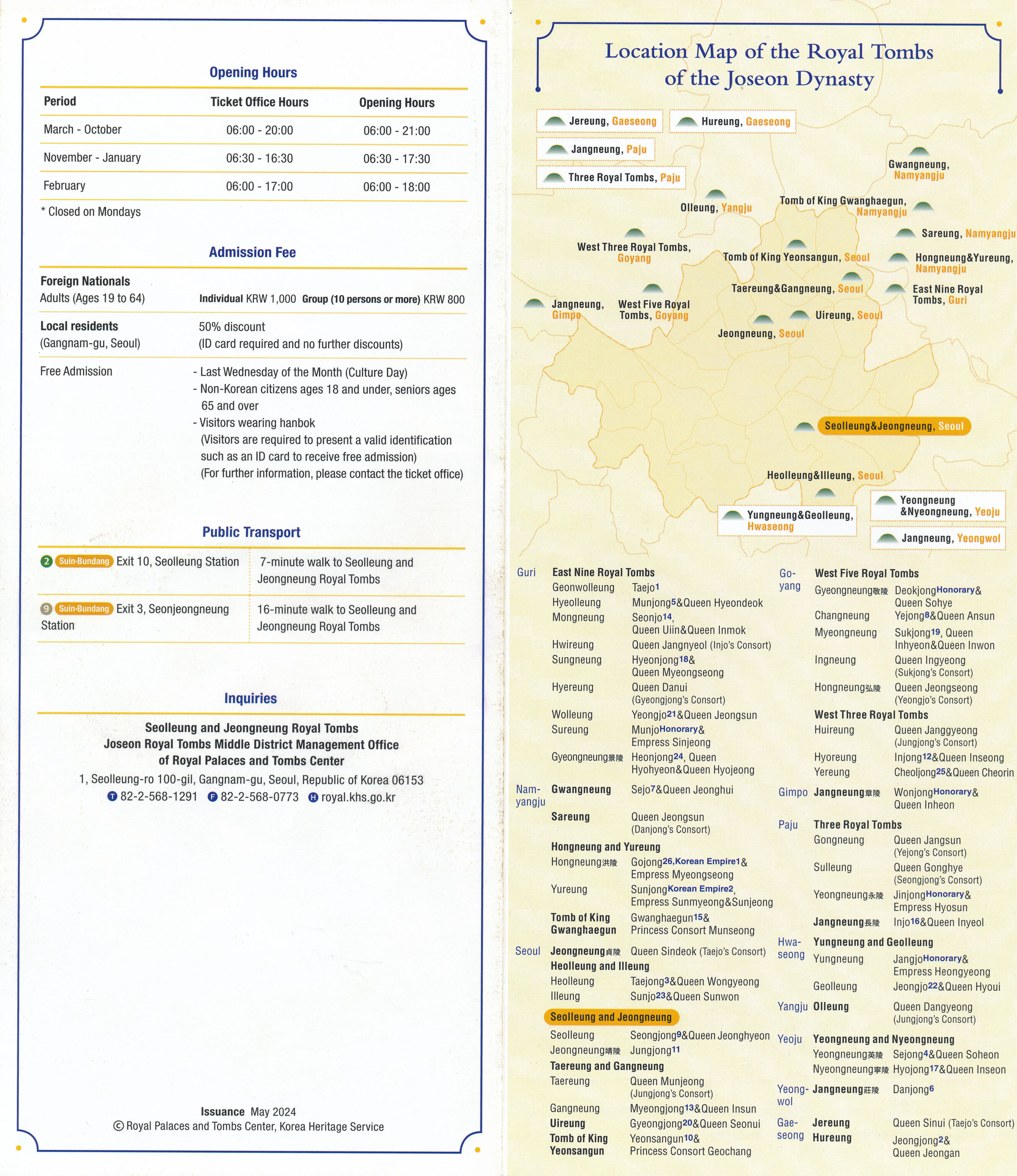
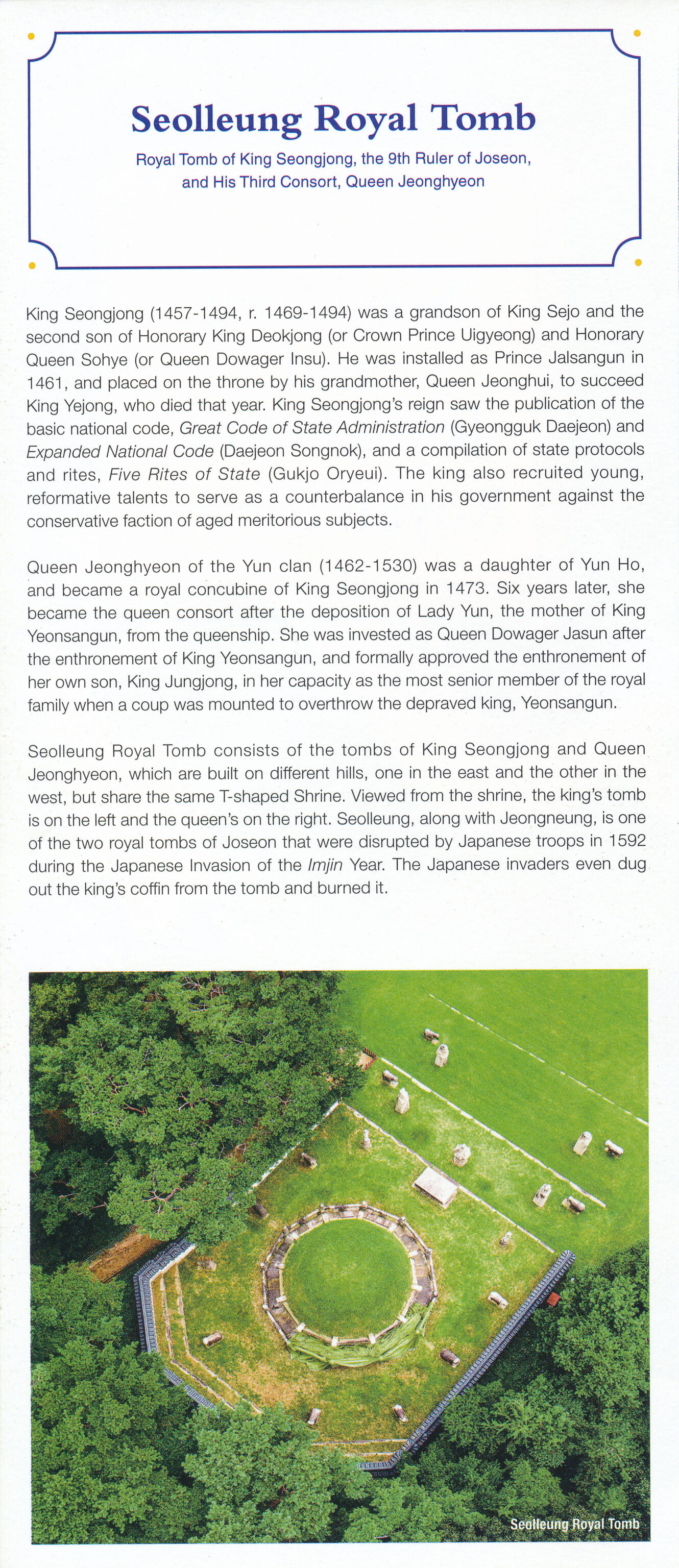
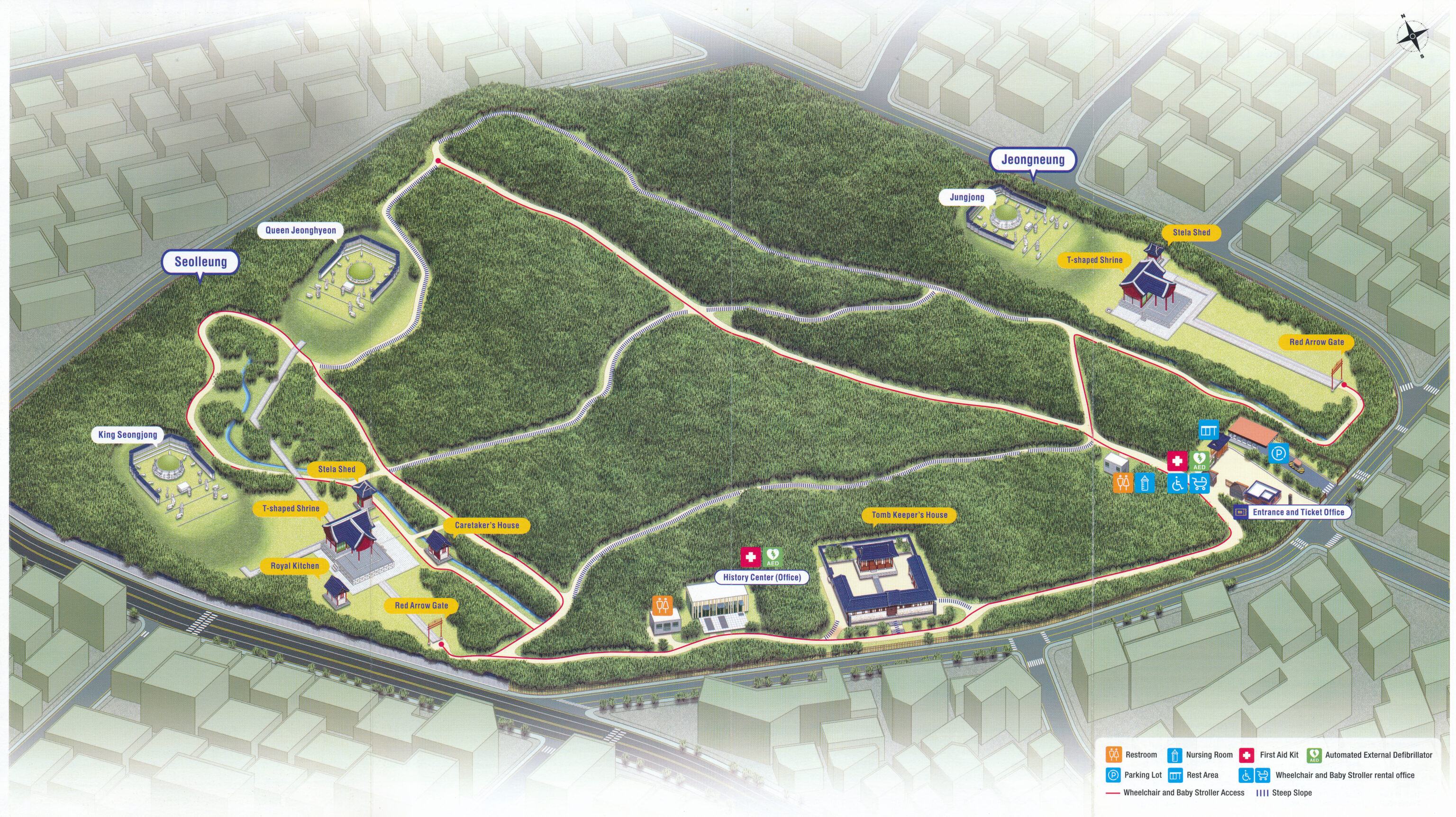
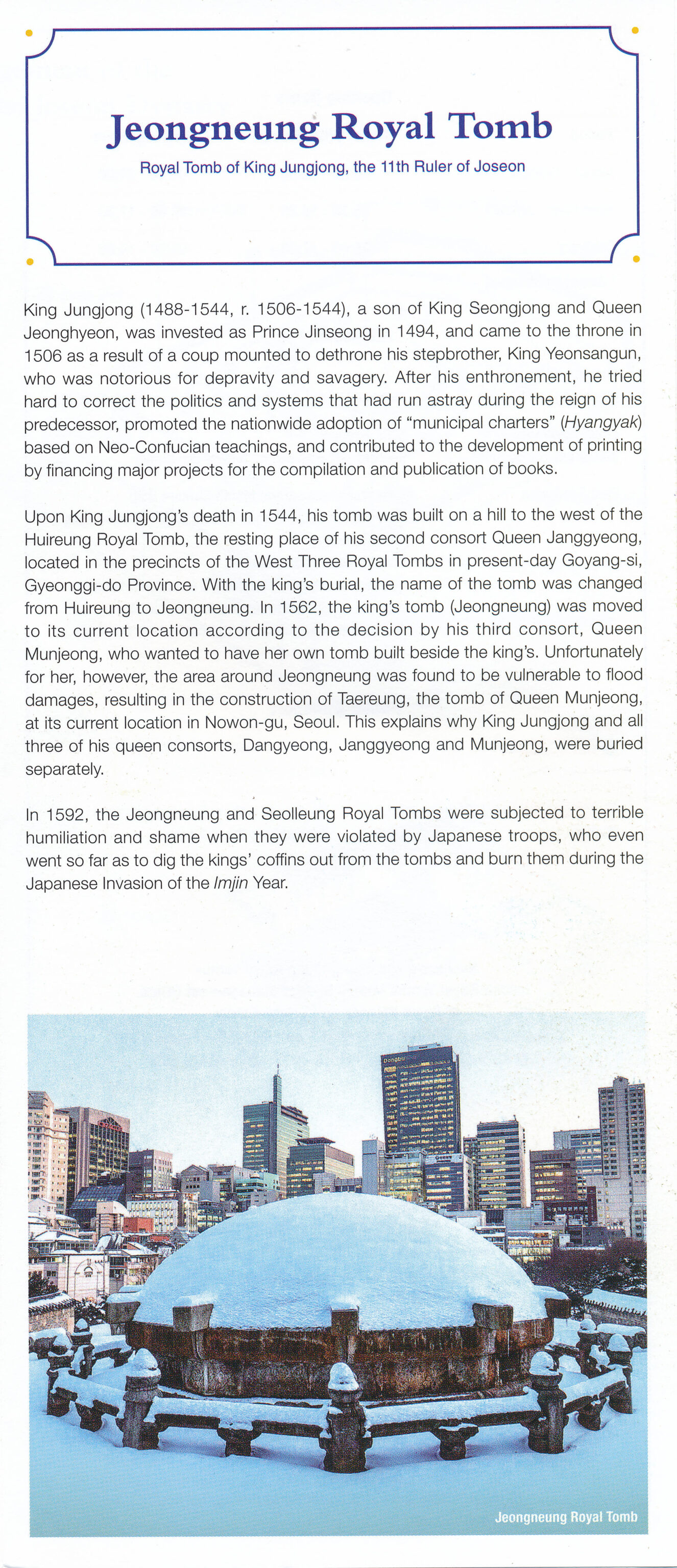
We picked up a map of the tombs at the entrance.
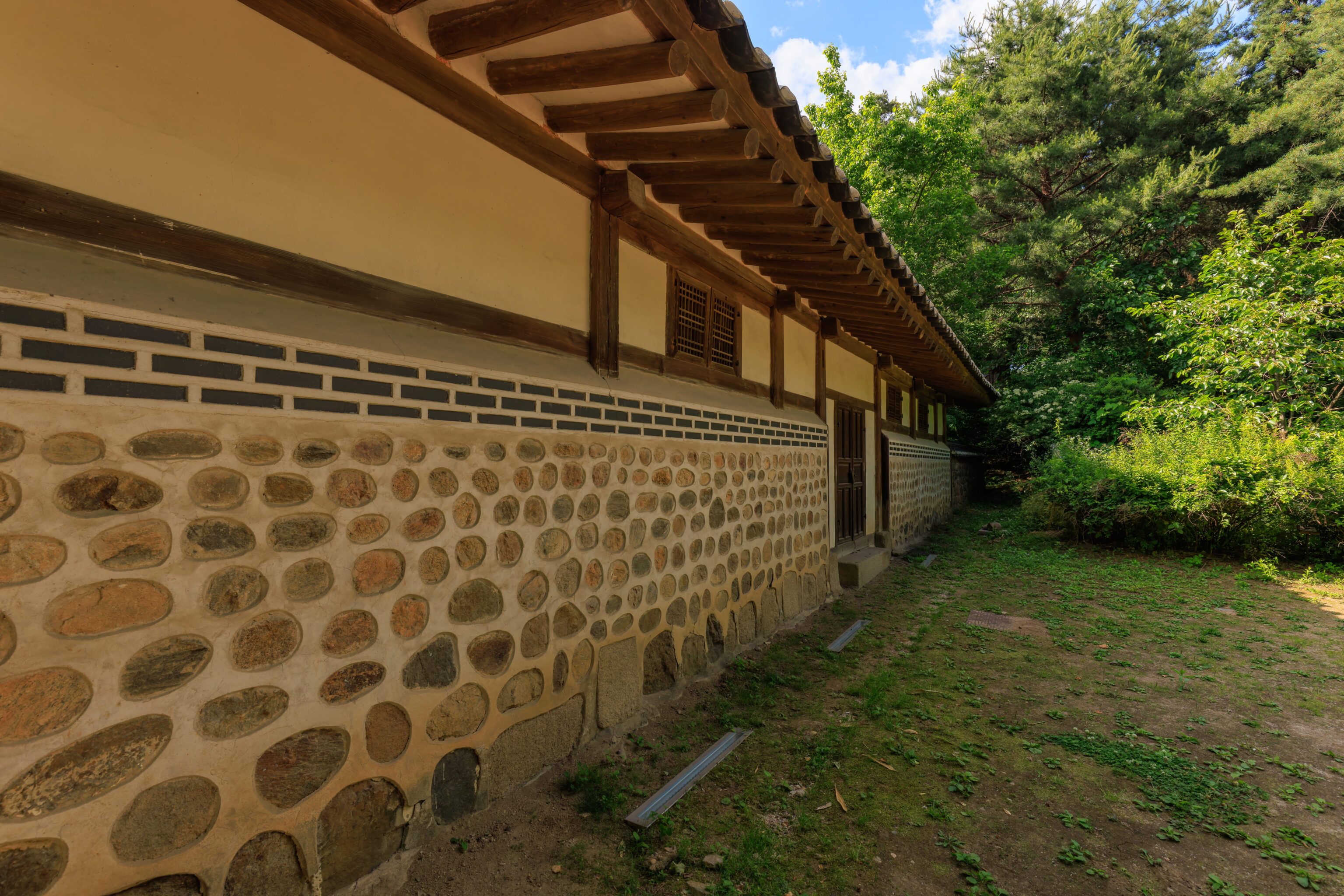
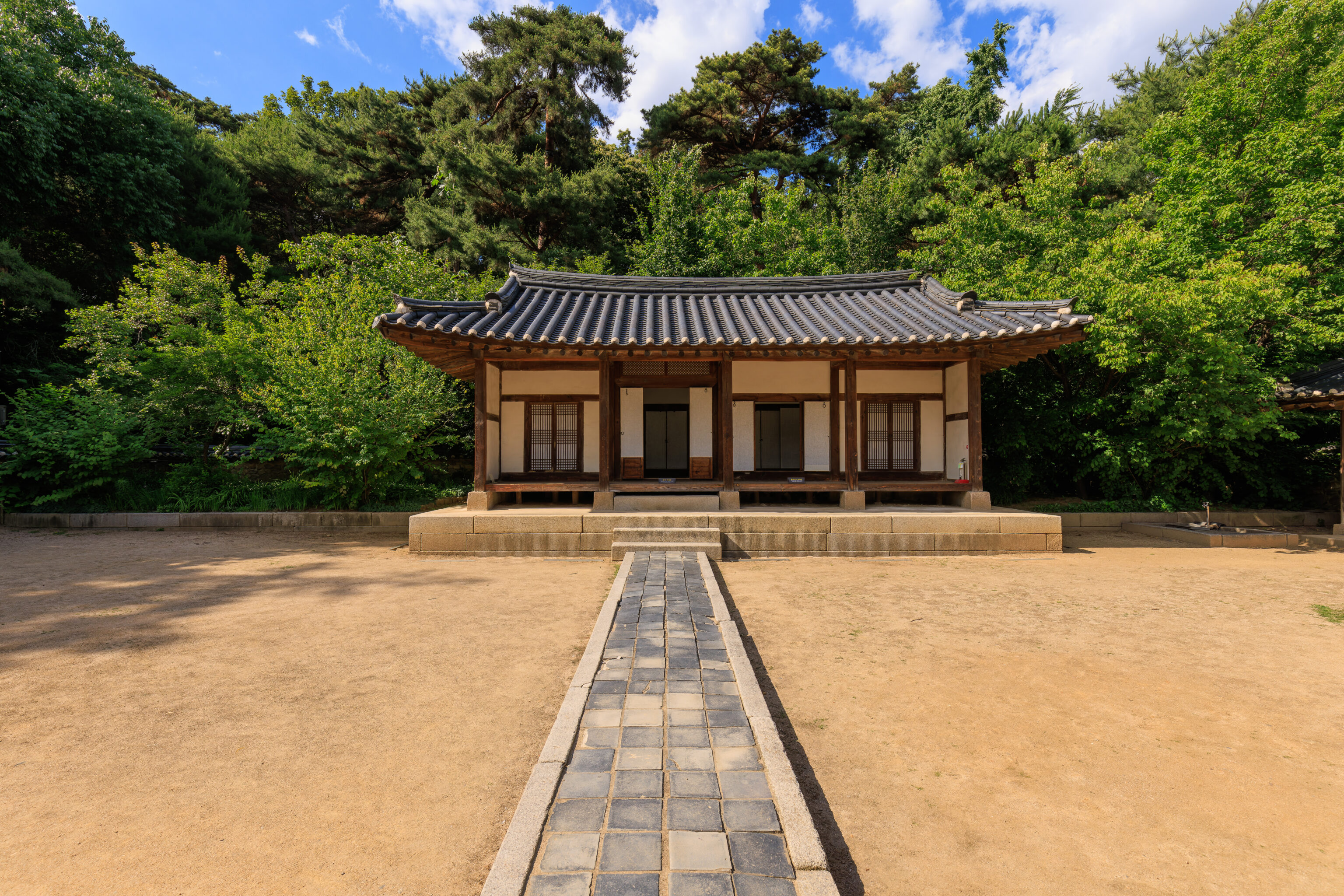
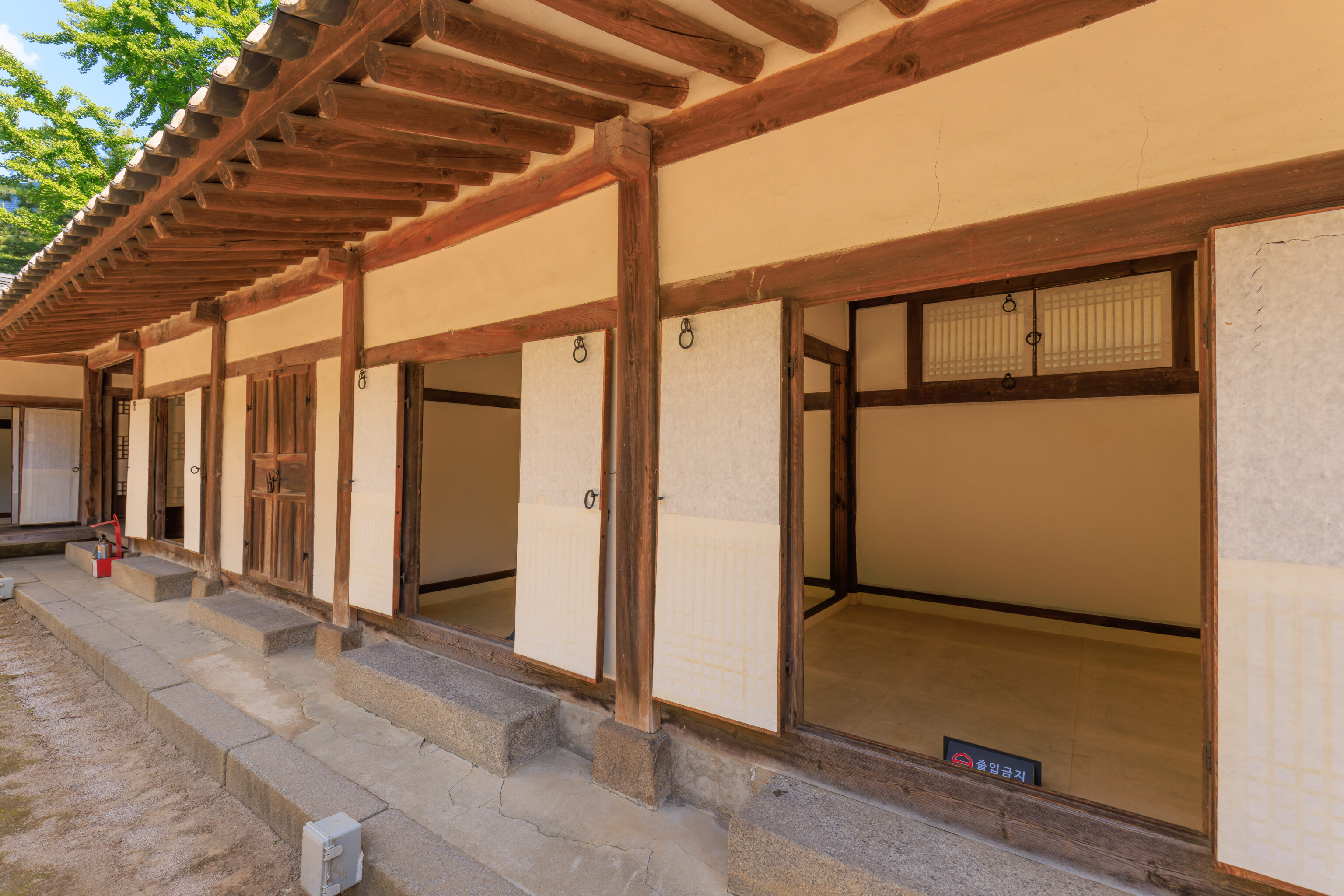
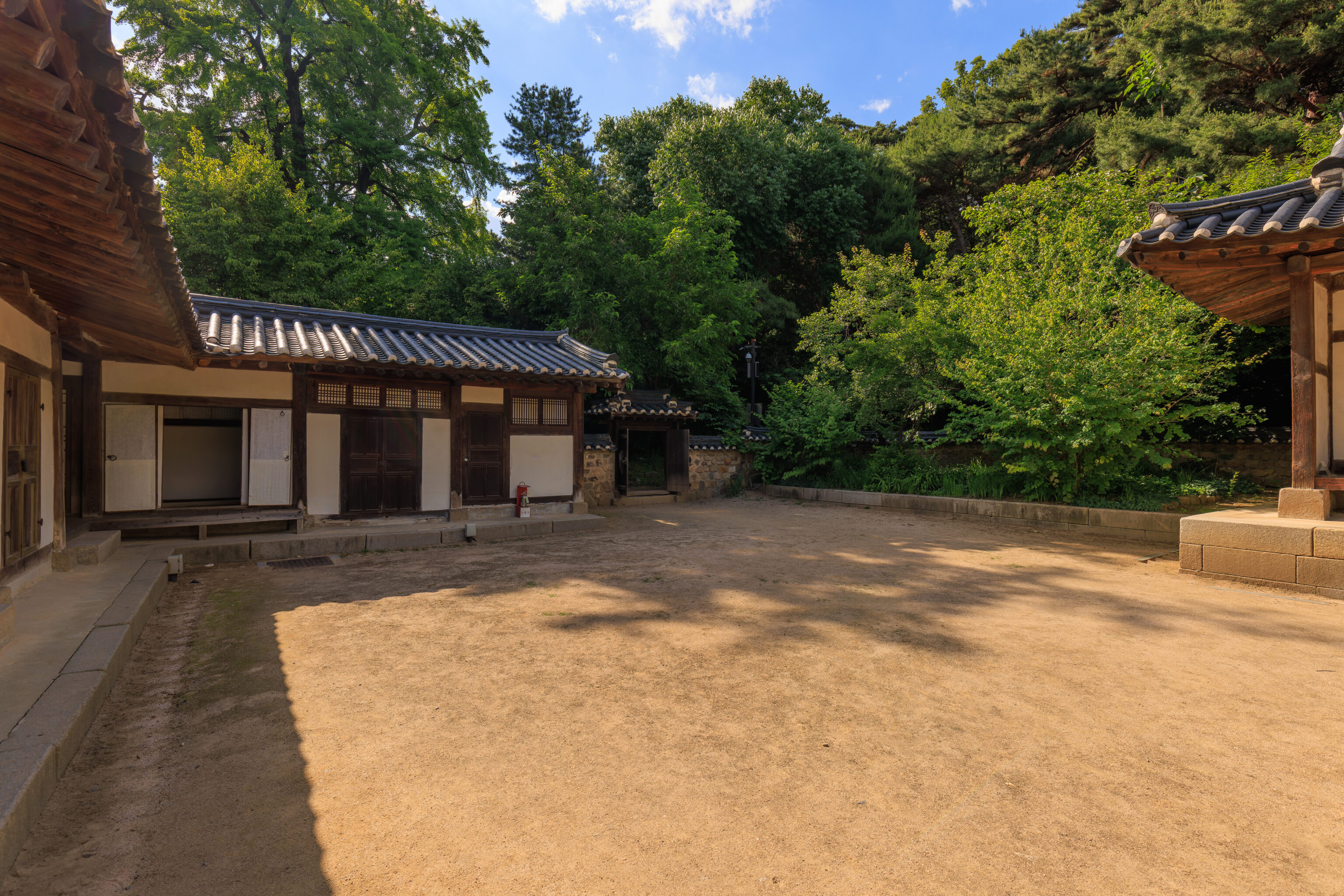
We decided to loop around clockwise through the grounds. Our first stop was the Tomb Keeper’s House. A sign describes this small cluster of buildings:
Tomb Keeper's house is a facility where ritual presiders stay and purify their mind and body for a few days before the date of an ancestral rite.
They also prepare offerings here. Ordinarily, tomb officials station here to take care of the tomb everyday. A jaesil typically consists of incense storage, storage for ritual objects, a royal kitchen, and servants quarters. The building is not decorated with multi-colored paintings.
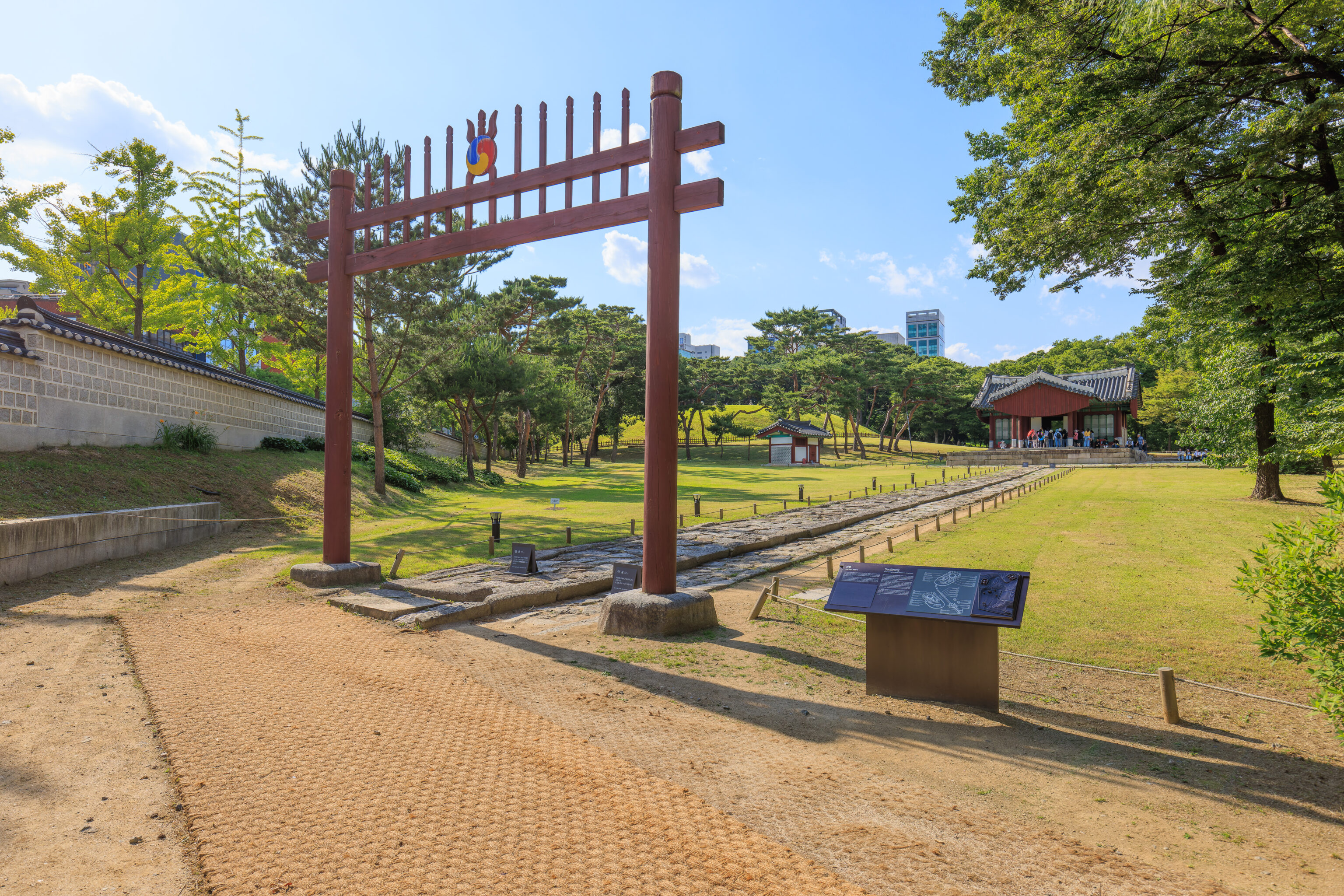
We continued on until we reached the Seolleung, the tombs of King 성종 Seonjong and Queen 정현 Jeonghyeon.
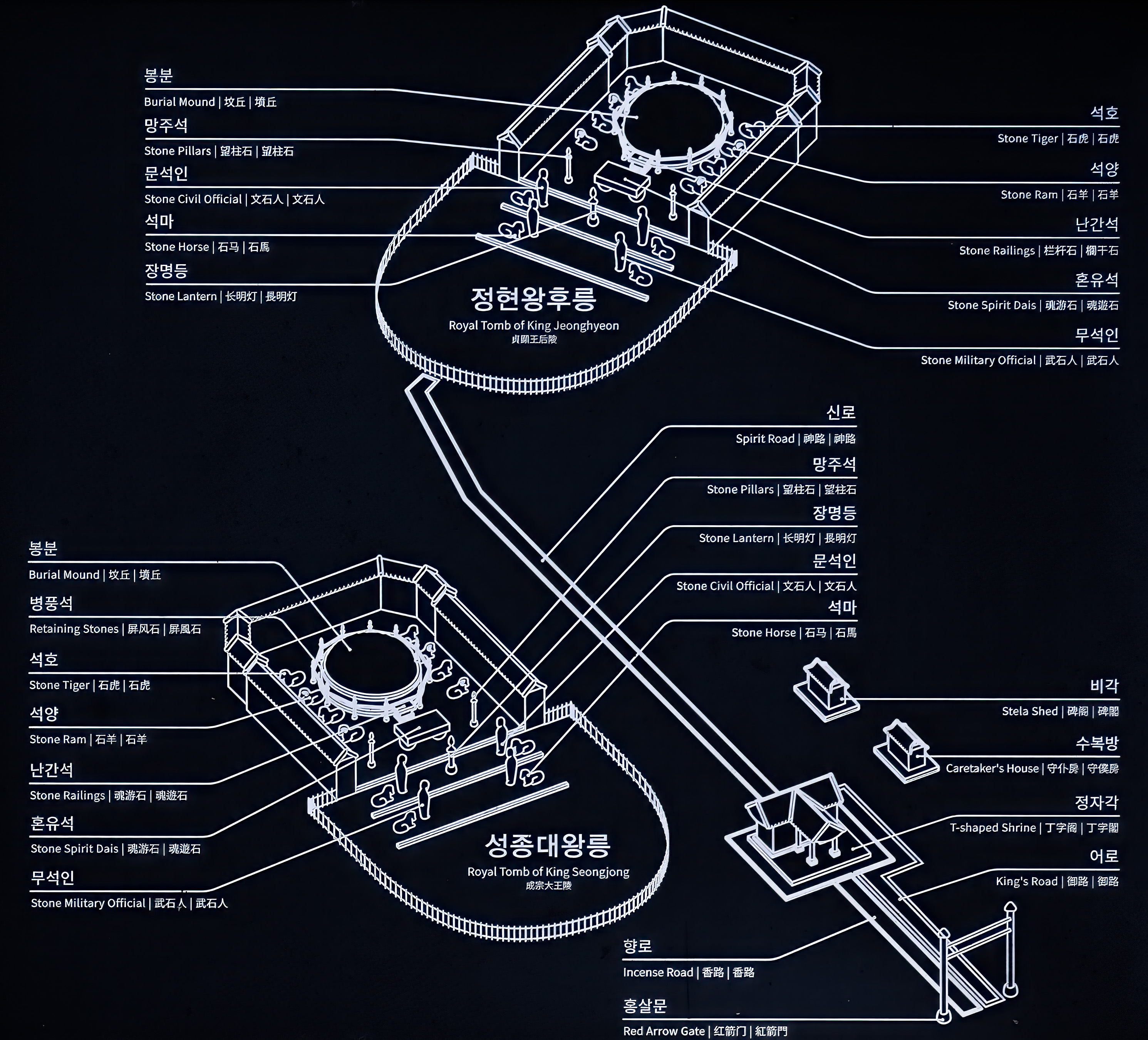
The sign near the Red Arrow Gate depicts the layout of the two tombs here. The sign also has descriptive text in English:
This is the tomb of King Seongjong (1457-1494, r. 1469-1494), the ninth monarch of the Joseon Dynasty, and his third consort Queen Jeonghyeon of the Yun clan (1462-1530). Seen from the ceremonial pavilion, the king's burial mound is on the left hill and the queen's on the right.
King Seongjong, the son of posthumous King Deokjong and Queen Sohye (later Queen Dowager Insu), ascended the throne in 1468 at the age of 13. During his reign, major projects such as publication of Gyeongguk daejeon (national code of laws) and the Five Rites of State (Gukjo orye) were completed, and the legal system for Confucianism-based rule was amended.
The style of Seongjong's tomb followed the protocol set out in Five Rites of State and hence features retaining stones around the burial mound and a stone railing, while Queen Jeonghyeon's burial mound has a stone railing but no retaining stones.
Interestingly, the sign also has braille.
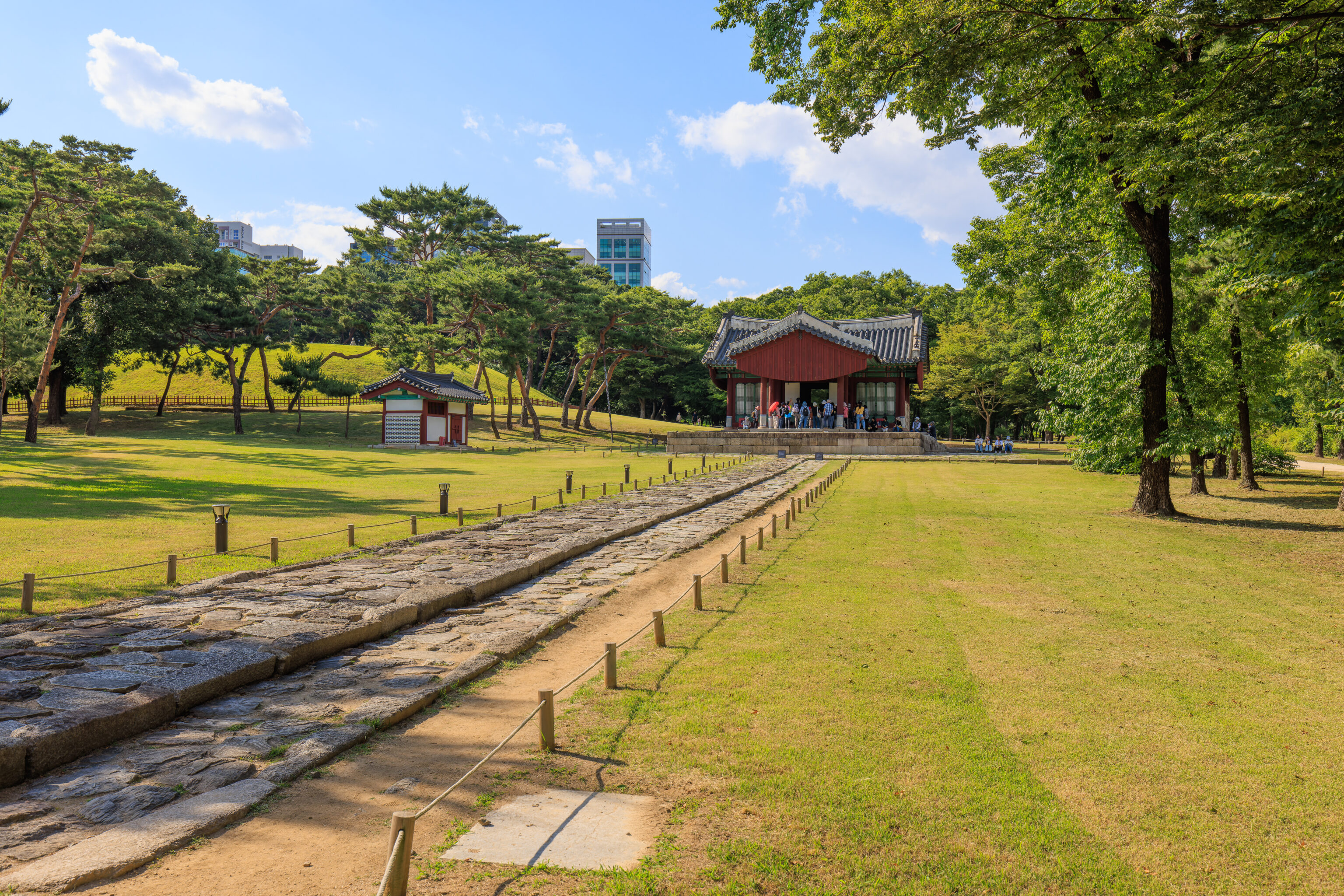
We could see the King’s burial mound from beyond the gate but not the Queen’s.
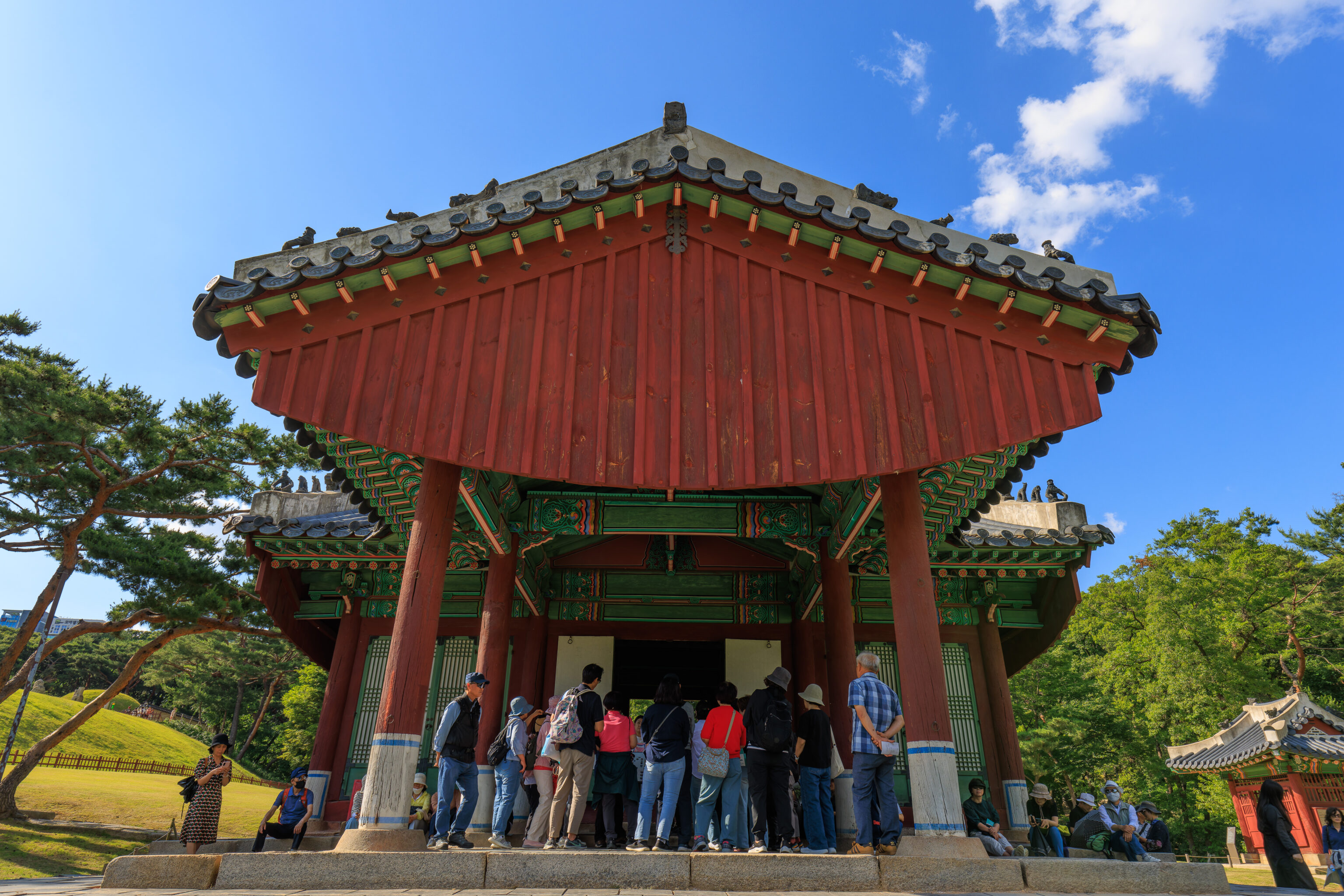
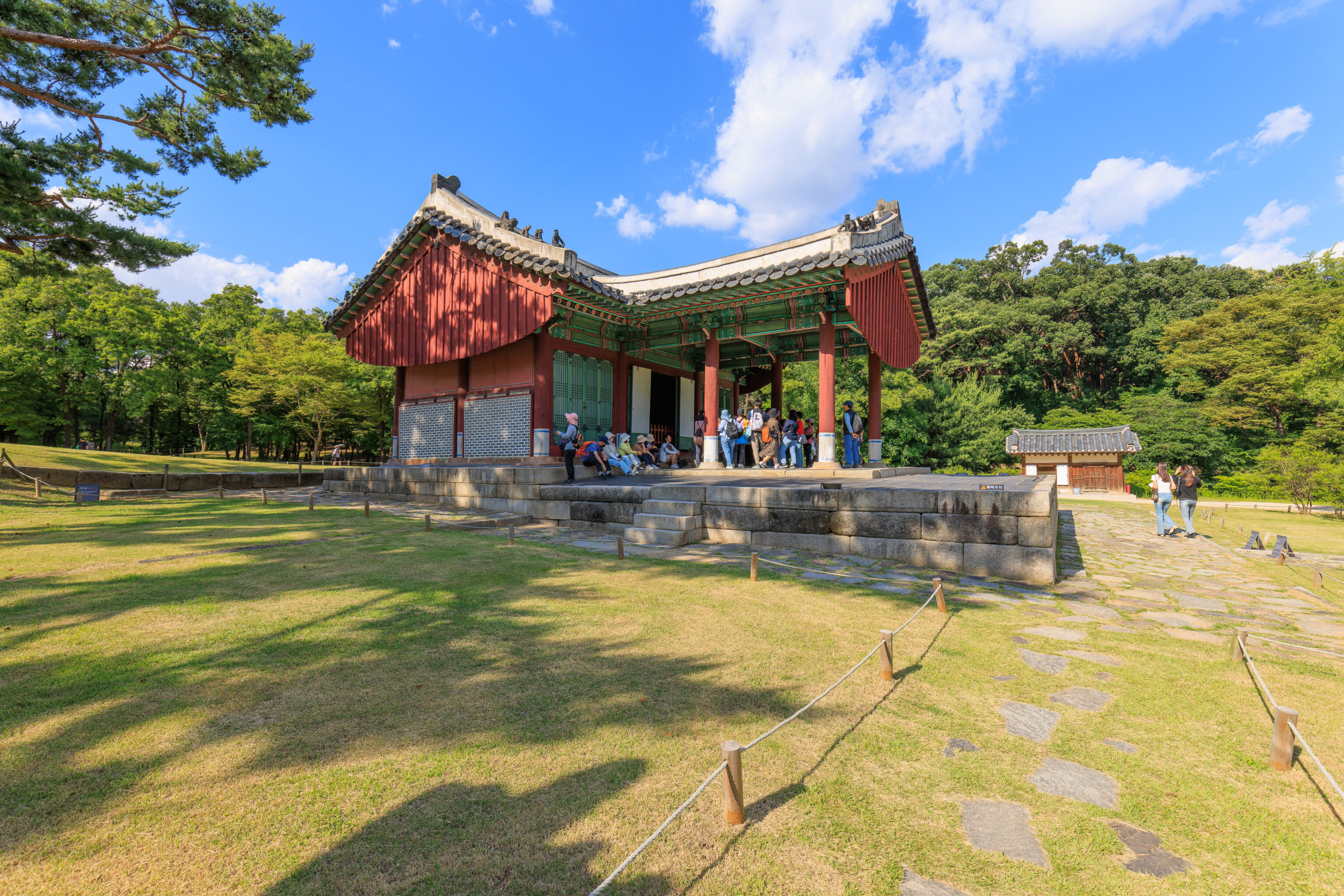
The T-Shaped Shrine was pretty busy with a large tour group when we arrived.
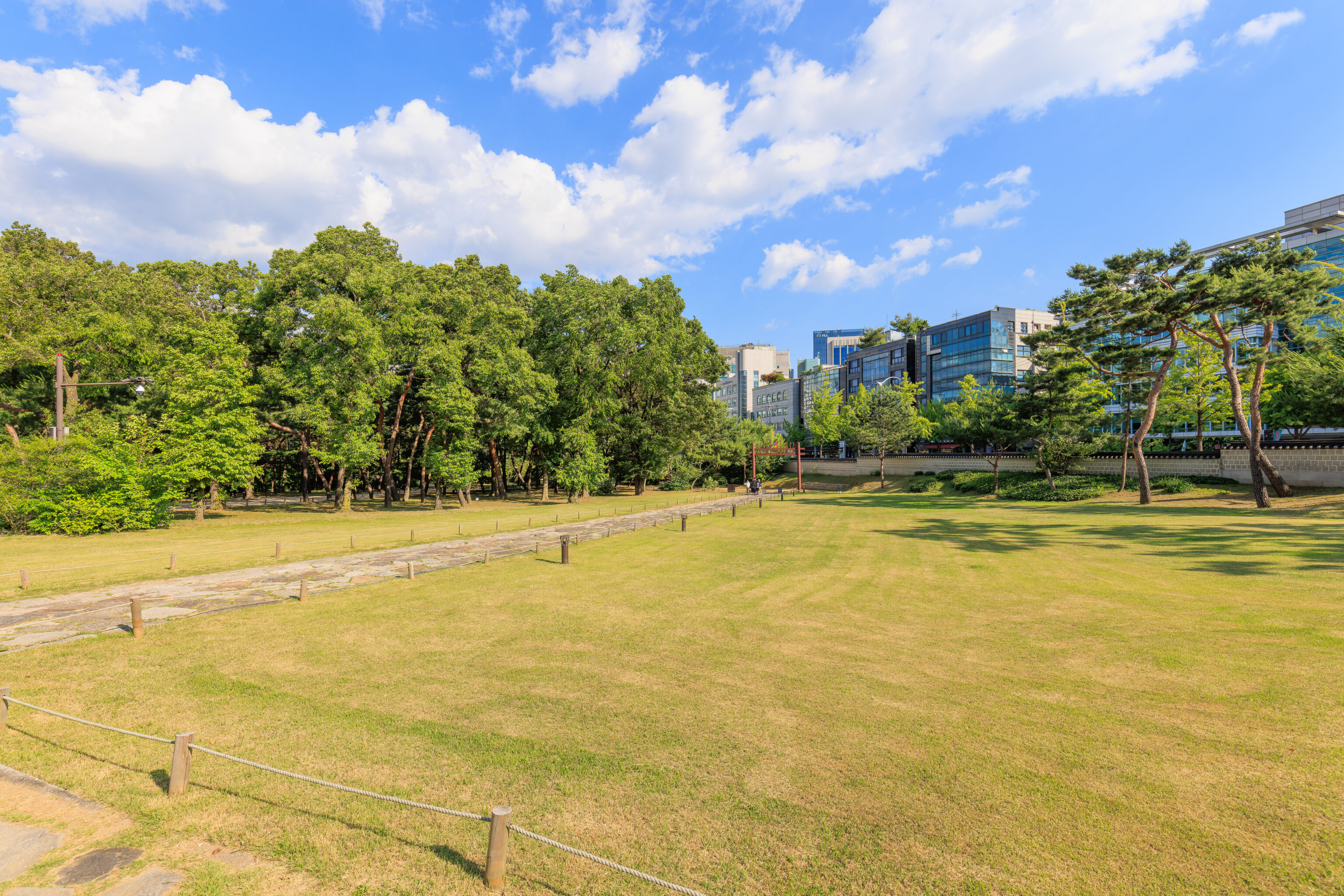
Looking back at the Red Arrow Gate, we could see just a few buildings due to all the trees that surround most of the tomb grounds.
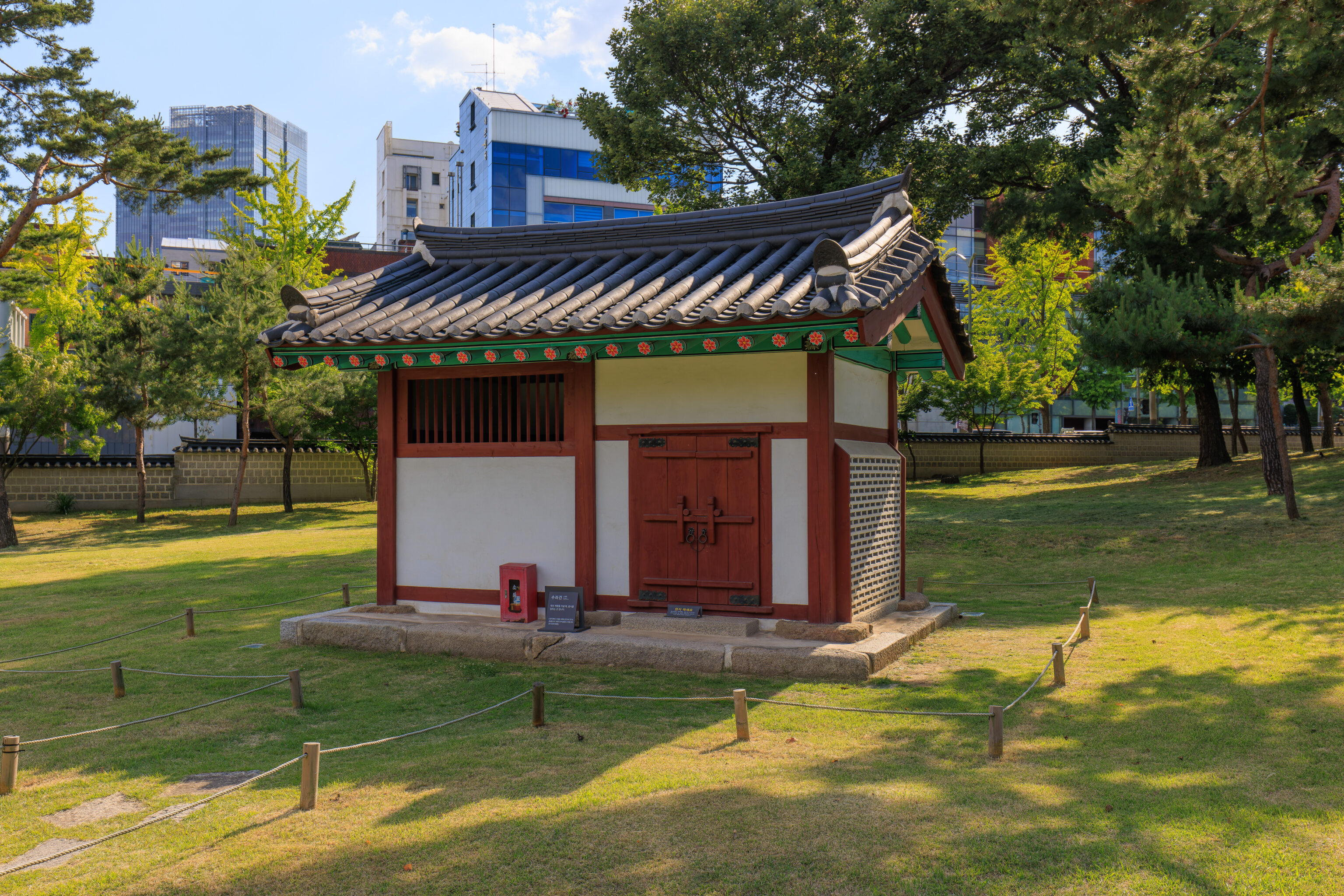
This small building is on the paper map but was not on the Seolleung map on the sign. It is a Royal Kitchen. The small sign by the door is in Korean but it translates fairly well to English:
This is where food is heated every year when ancestral rites are held.
[Records of Chungwan Tonggo, which is said to be located 10 steps west of Jeongjagak, and the foundation stone were found through excavation, and the book was restored in 2014]
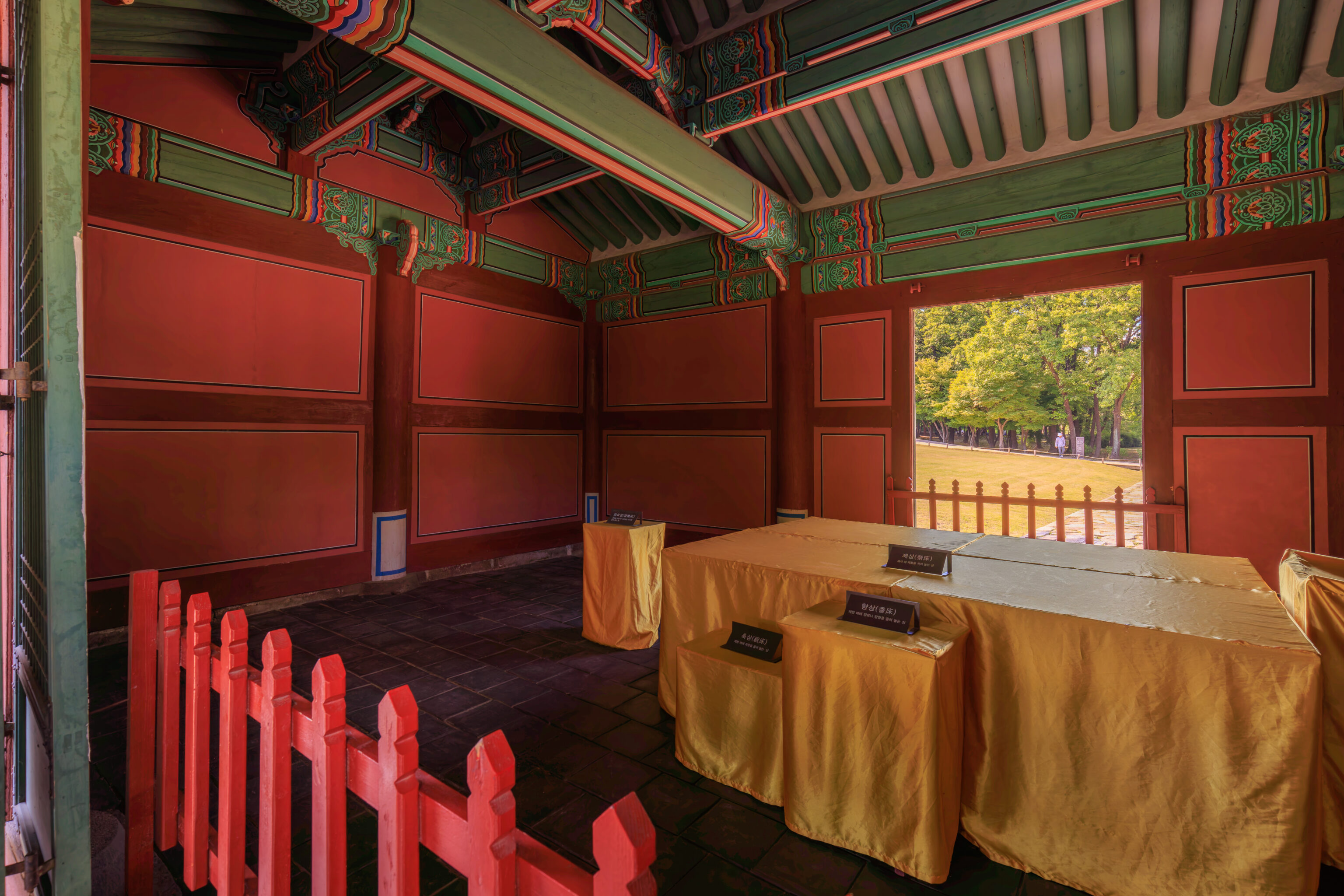
We returned to the T-Shaped Shrine once the crowd cleared a bit. The tables are labelled in Korean indicating what would have been placed on them.
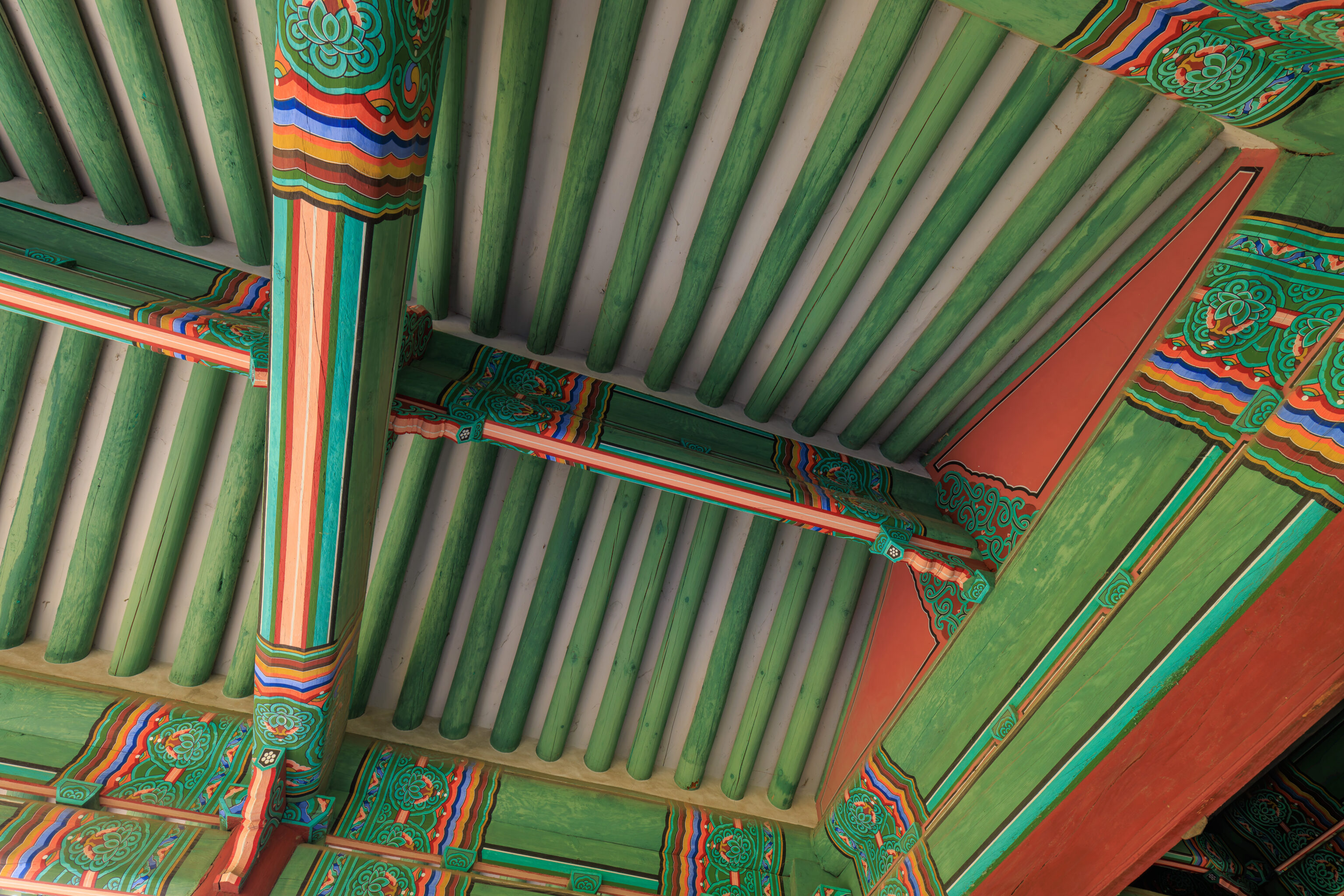
The ceiling is painted the same as other historical buildings that we’ve seen from this era.
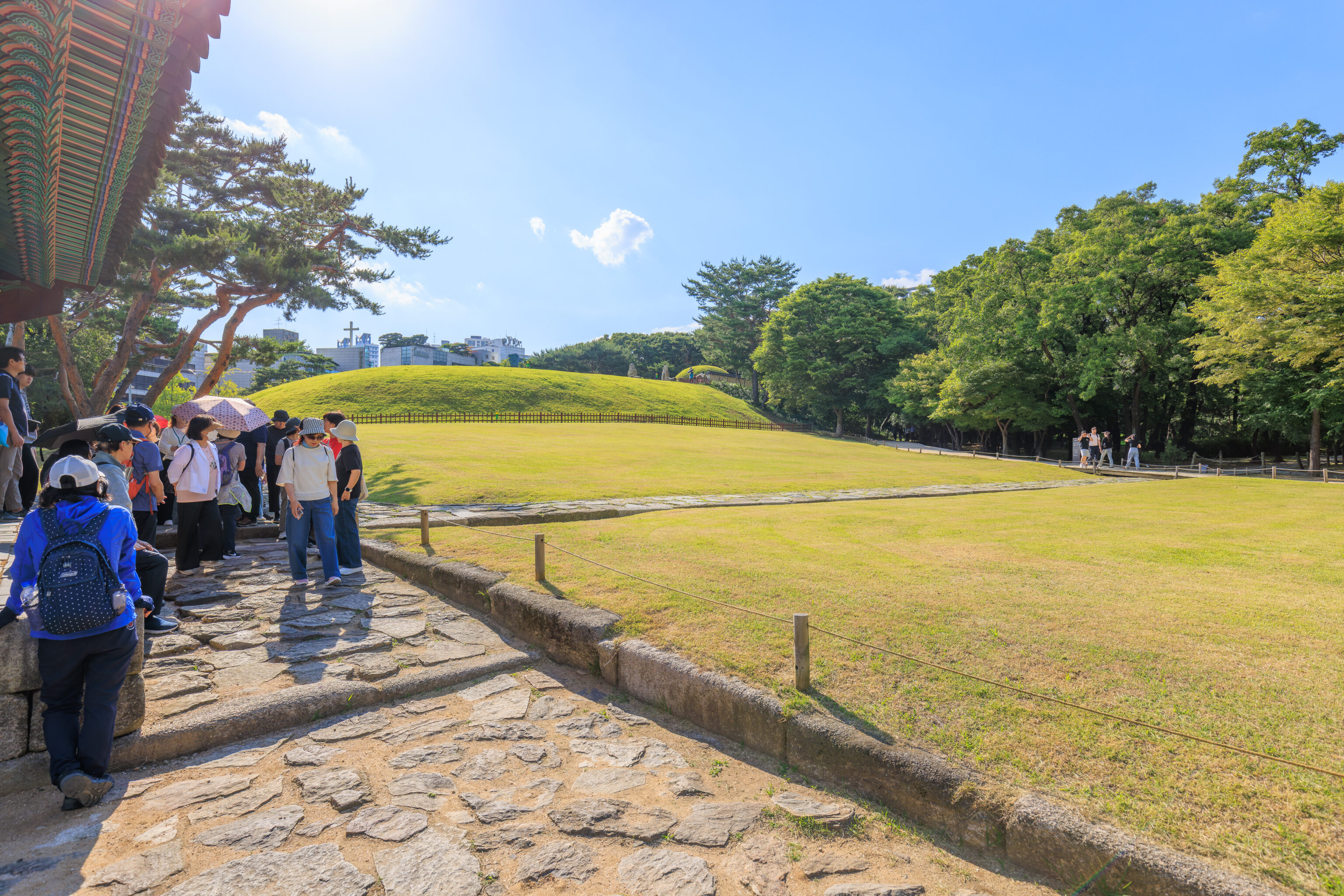
We had a good view of the King’s burial mound from the side of the T-Shaped Shrine. While we couldn’t see much of what was actually atop the mound, we could see that it was possible to get closer further down the path.
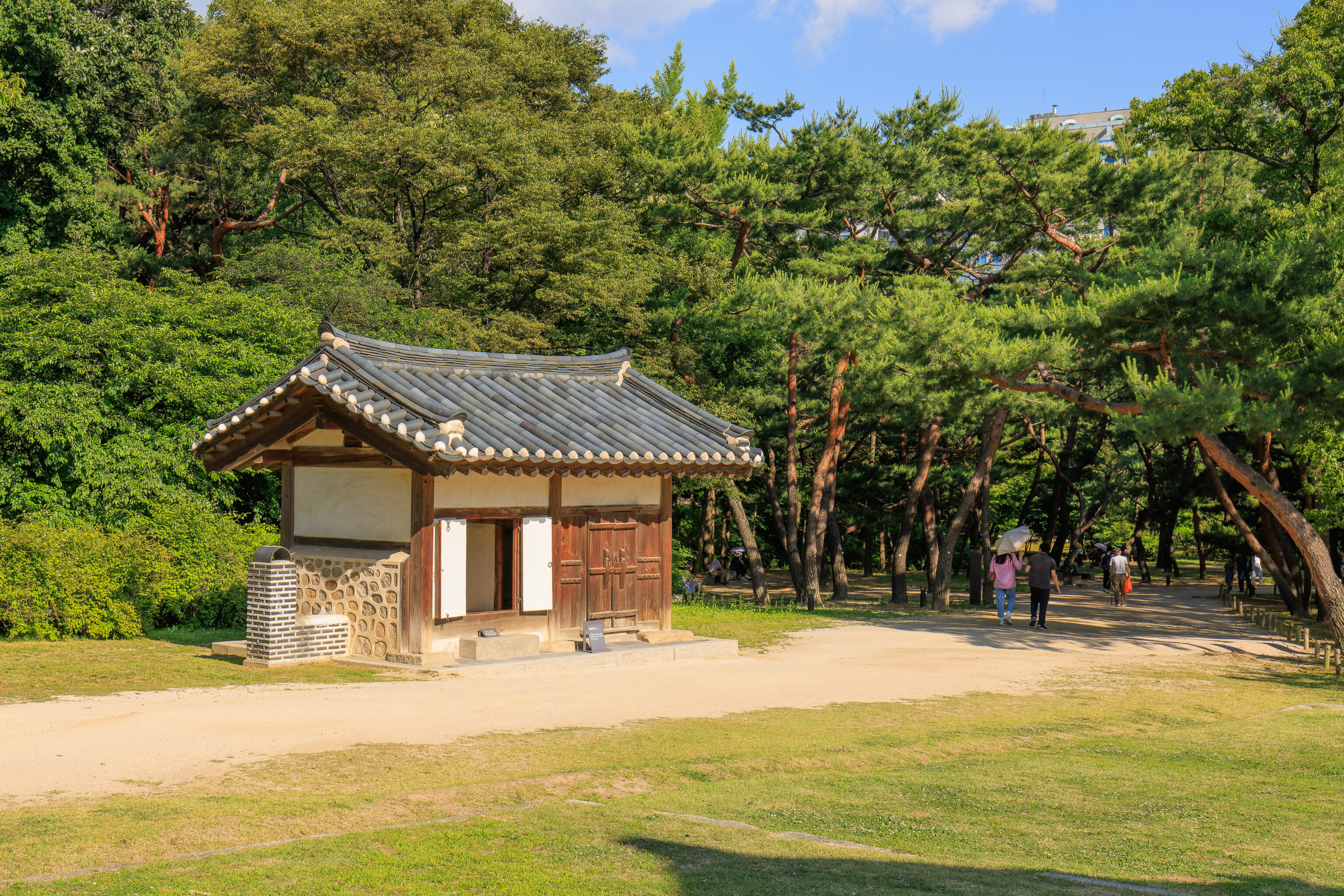
This small structure is the Caretaker’s House.
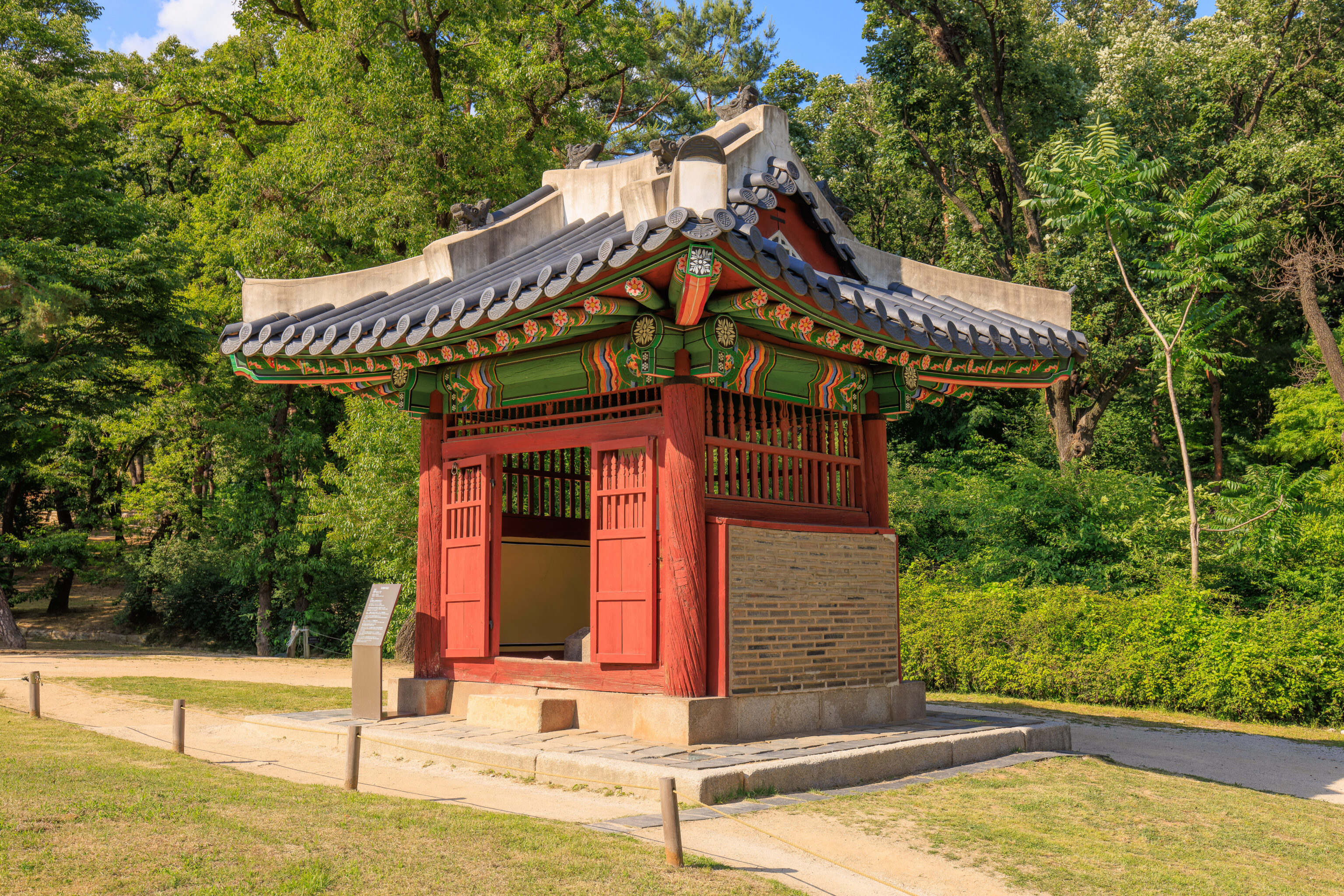
This even smaller structure is the Stela Shed. The English term stela comes from the Greek stele, meaning an inscribed stone tablet or column. We didn’t get a good look at the stela as the horde made it there first.
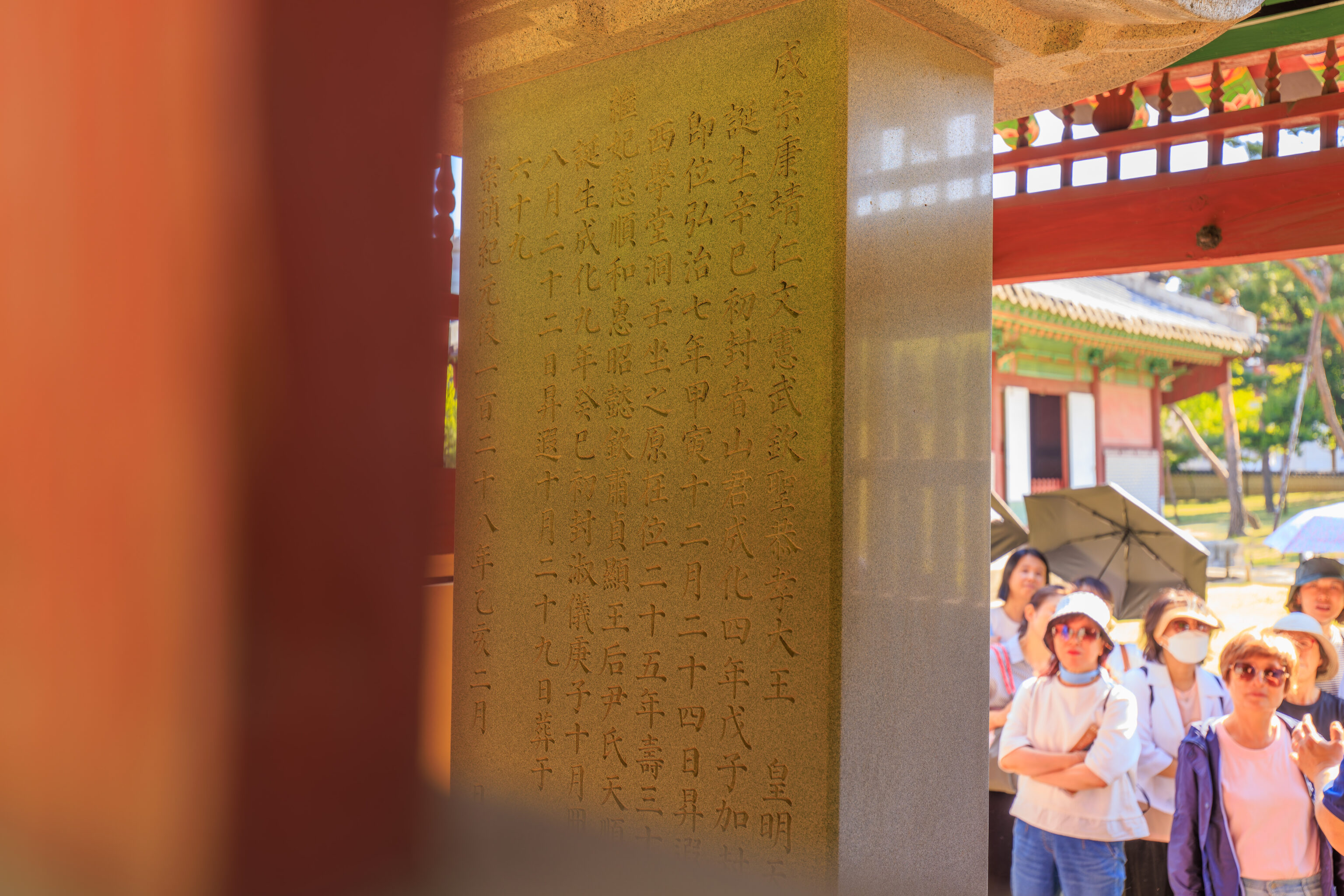
We were able to see the stela from the back though through the small vertical gaps in the wall. They’re too small to be considered windows.
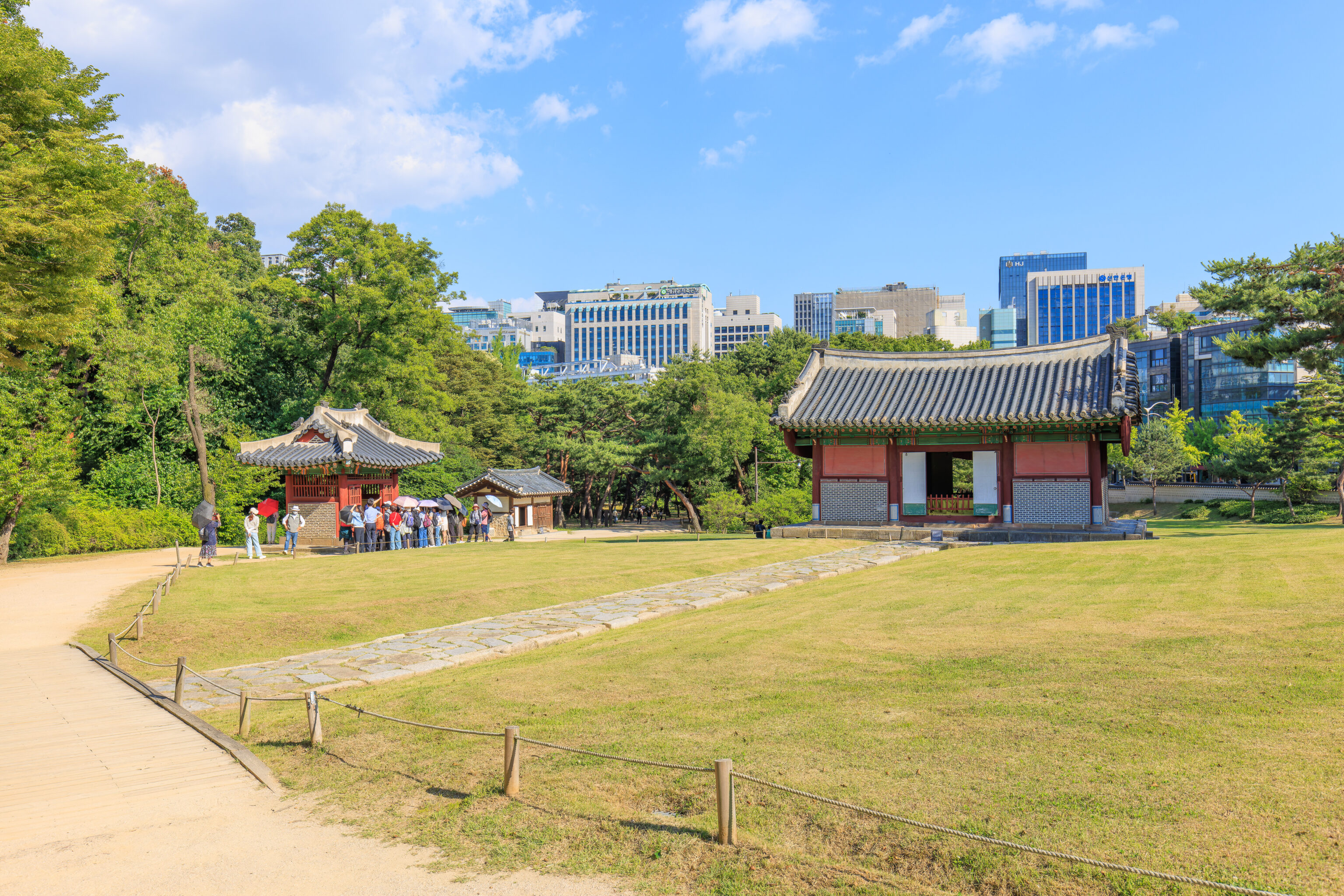
There they are, in front of the Stela Shed.
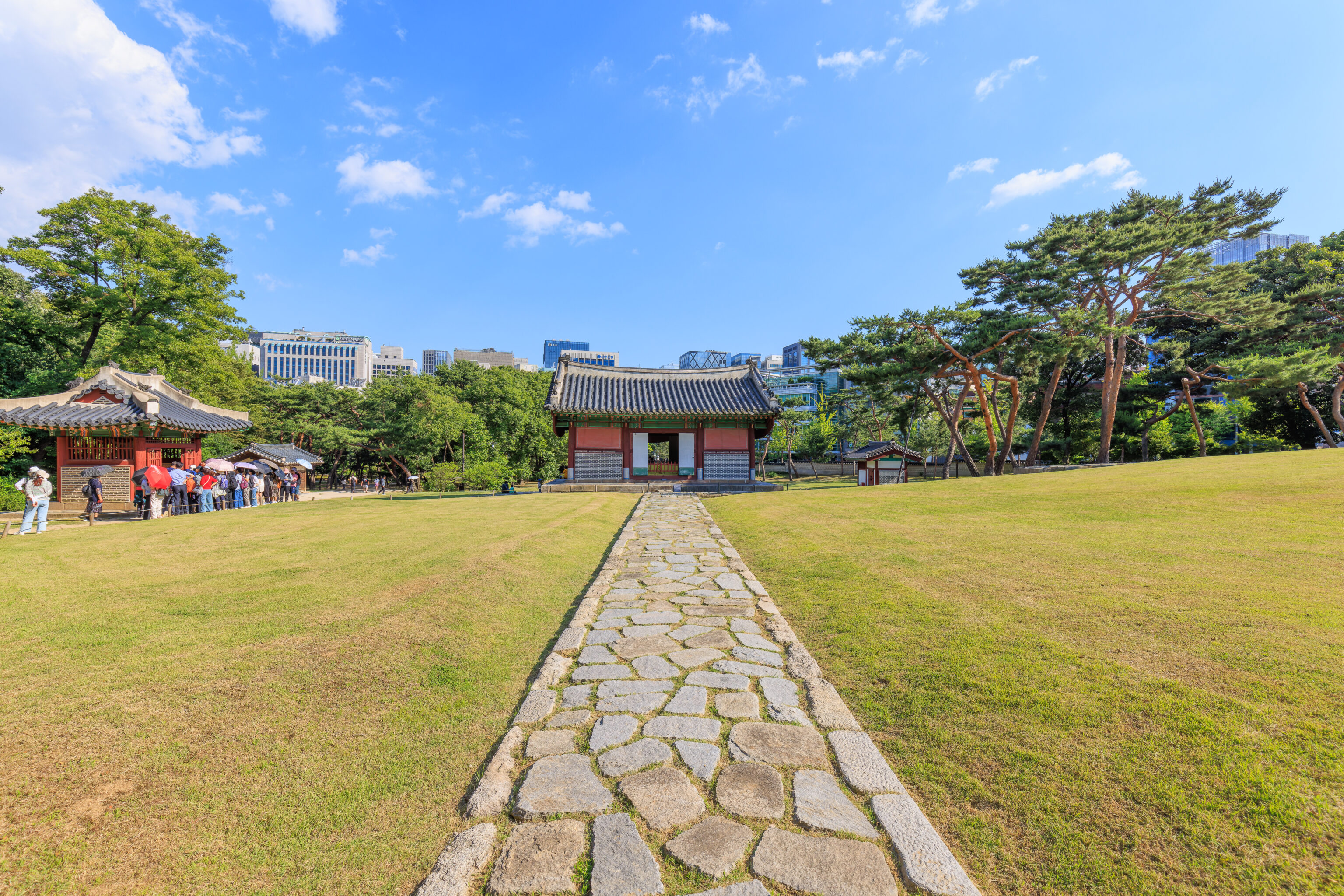
The T-Shaped Shrine, as seen from the path leading away from it to the north. As depicted on the map, the path doesn’t go to the burial mound but instead goes past its east side.
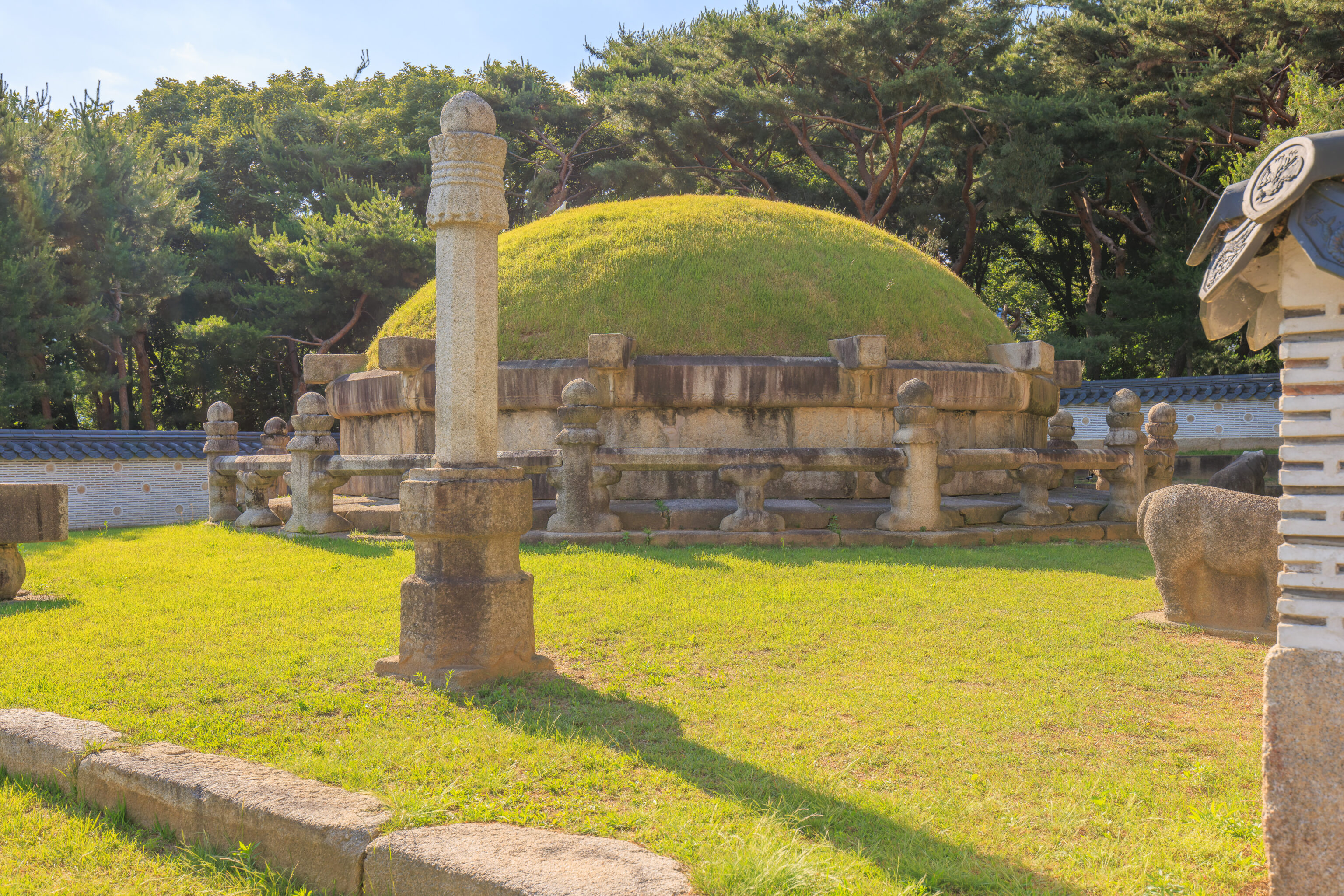
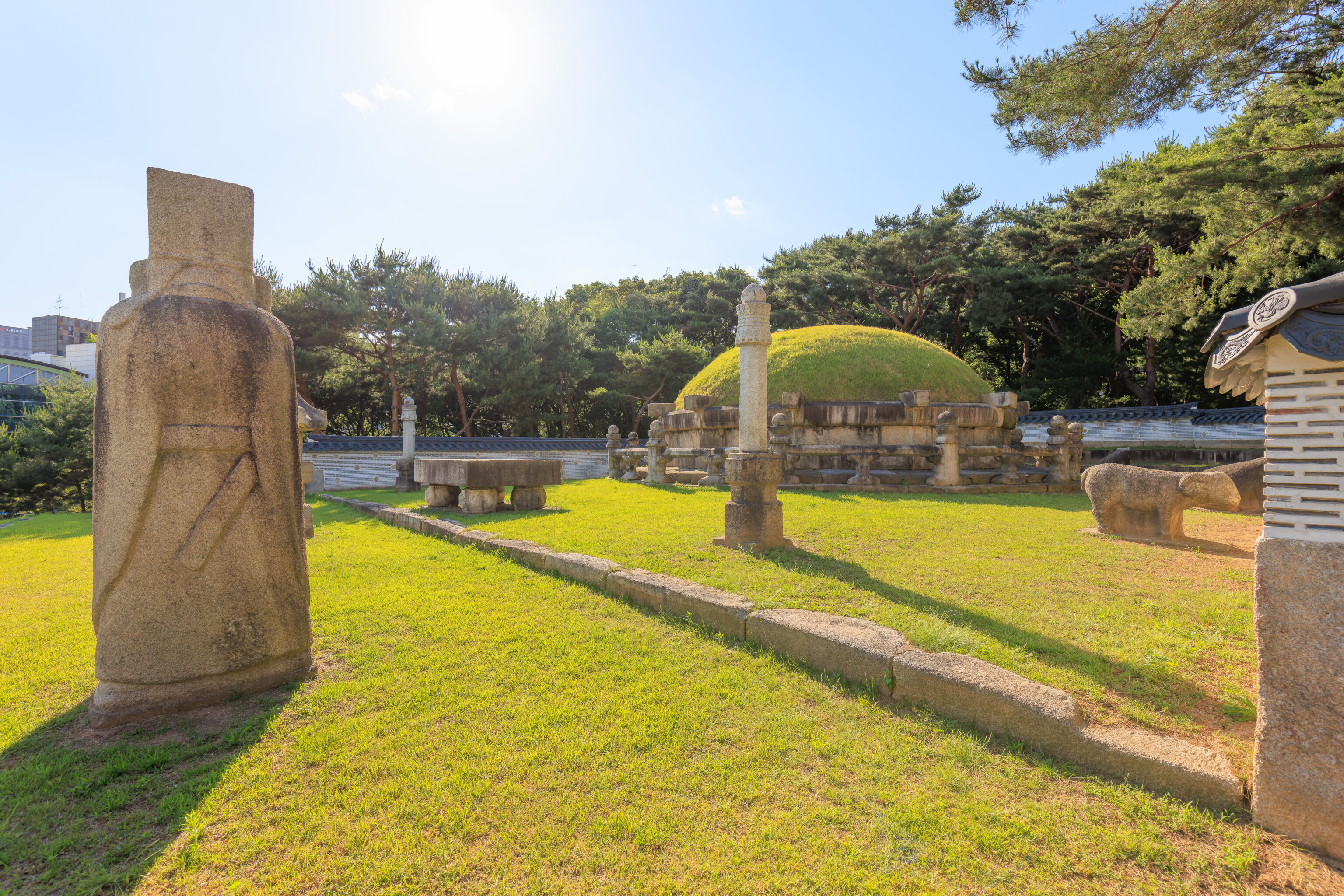
We took a side path which led up to the side of the burial mound. From there, we could see the actual burial mound that sits atop what we should perhaps have been calling the burial hill, or something like that. The mound is surrounded by various sculptures and other things, as depicted on the maps.
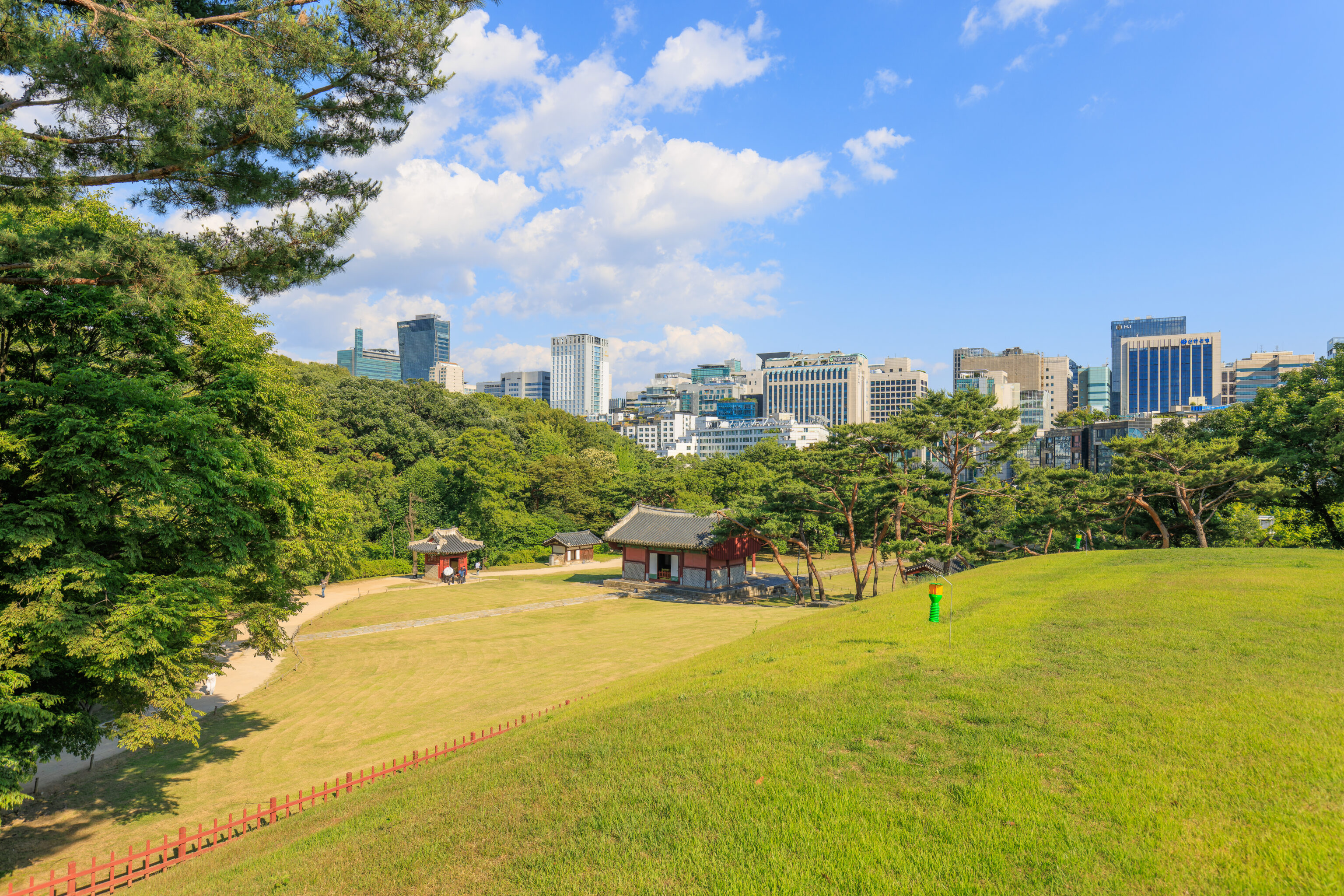
We had a good view of the T-Shaped Shrine from atop the hill. The hill is high enough that we could see many of the taller buildings to the south.
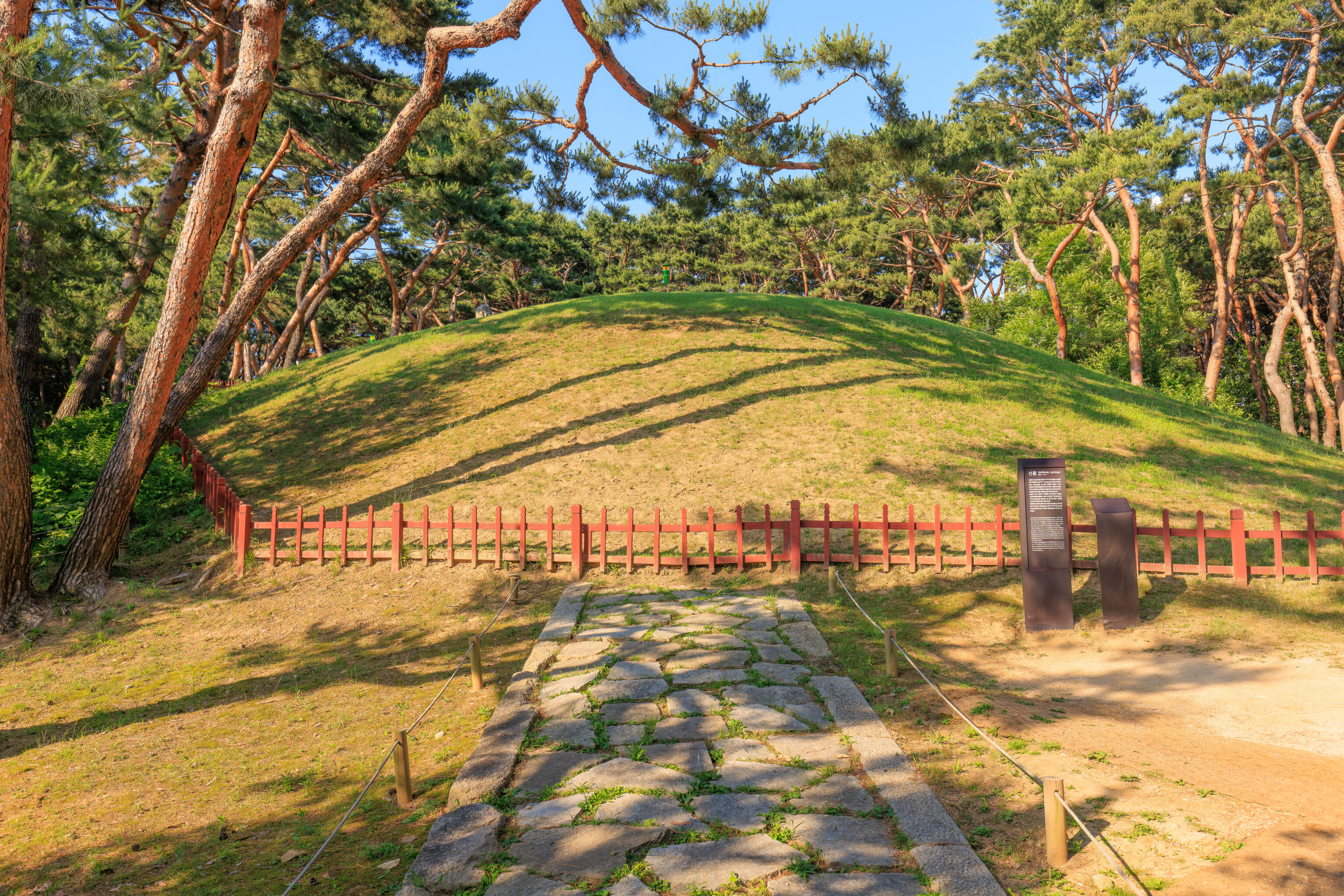
We continued on until we reached the Queen’s burial mound. The sign on the right has the same exact text as the one we saw by the Red Arrow Gate. It even has a separate sign with braille. The only difference is there is no map here.
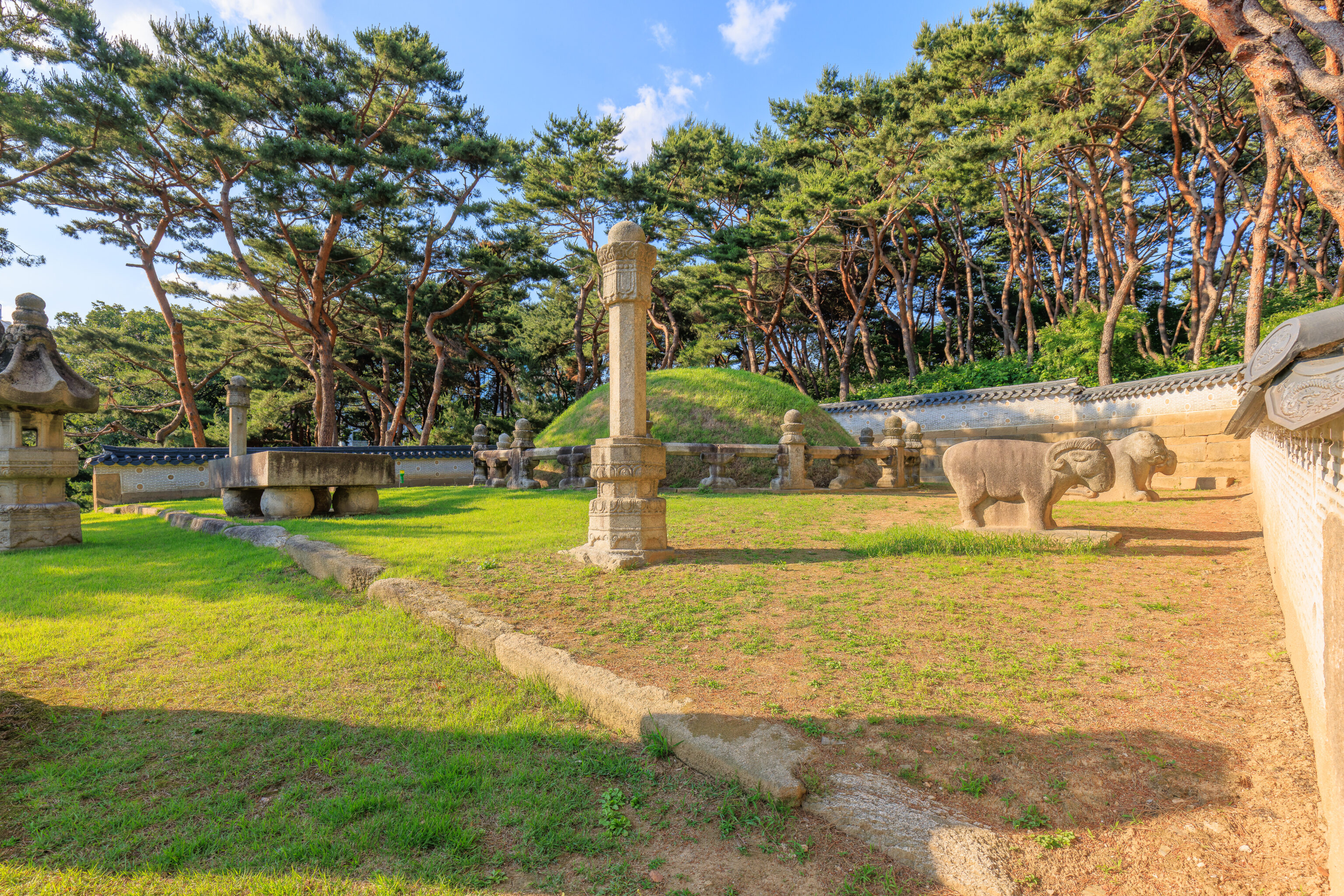
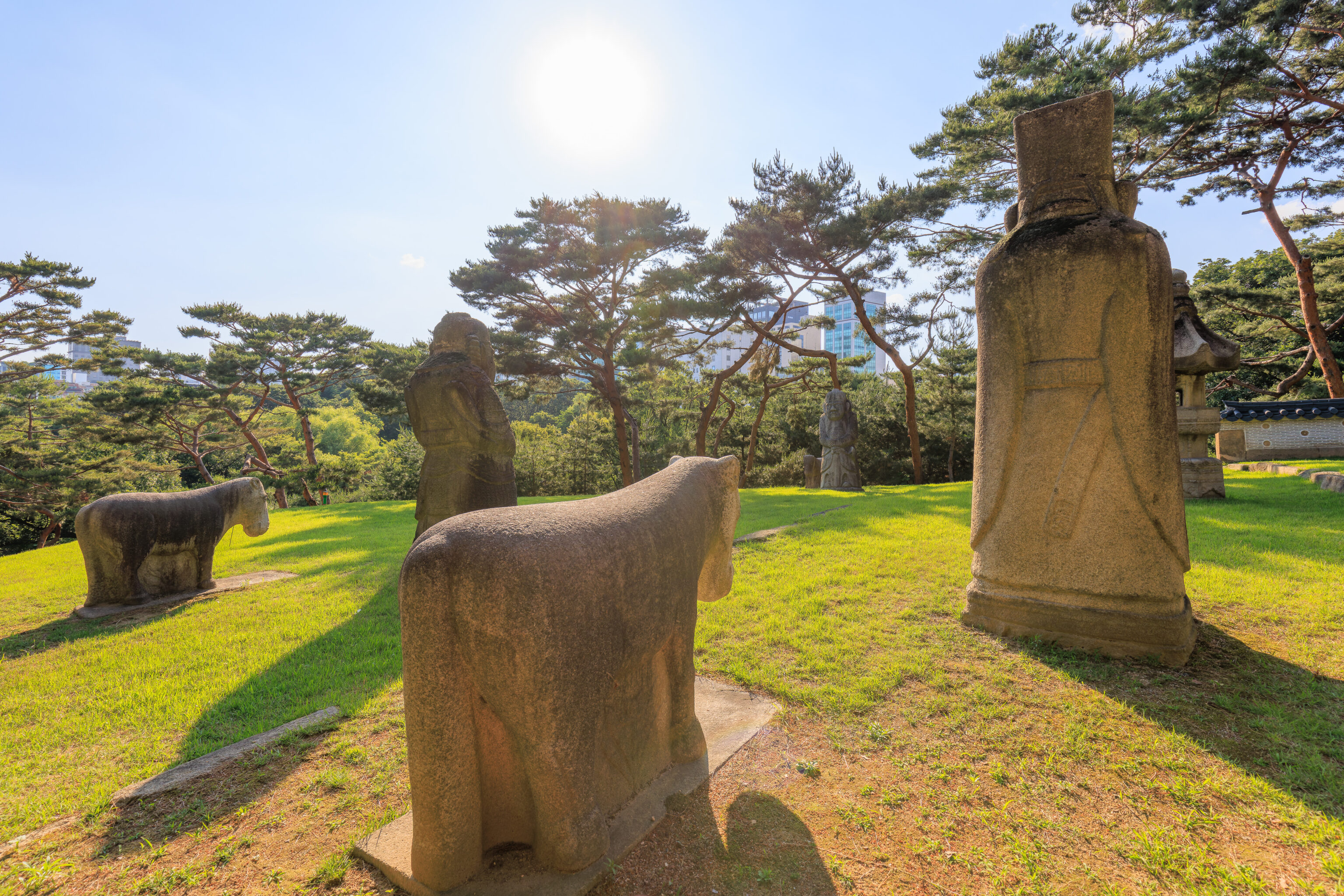
Like the King’s hill, there was a path leading to the side of the Queen’s hill. From here, we could see the Queen’s burial mound as well as all the various other things that sit atop the hill.
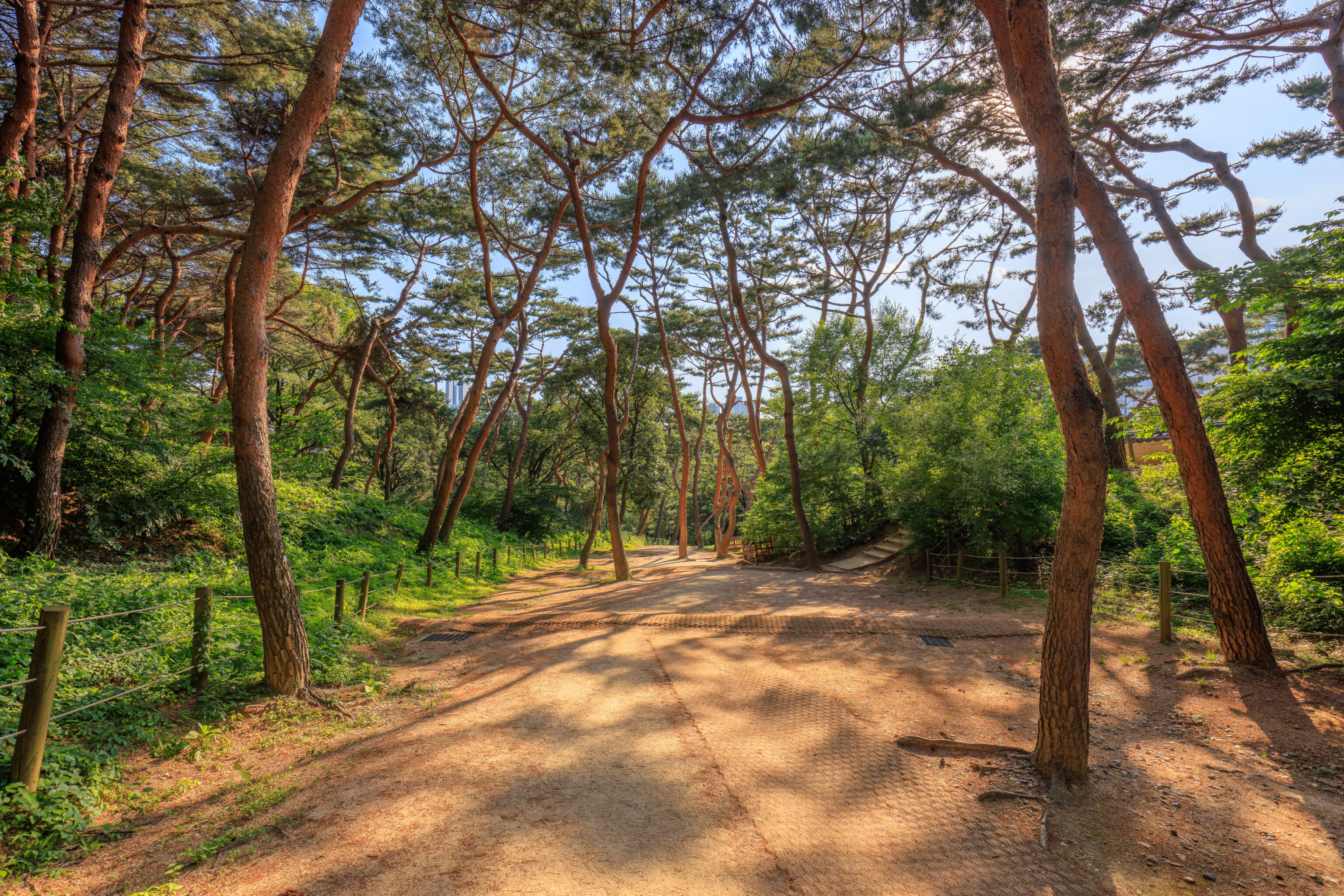
We followed the past as it headed northeast past the Queen’s tomb. It then turns to the southeast for awhile, more or less heading back to the entrance.
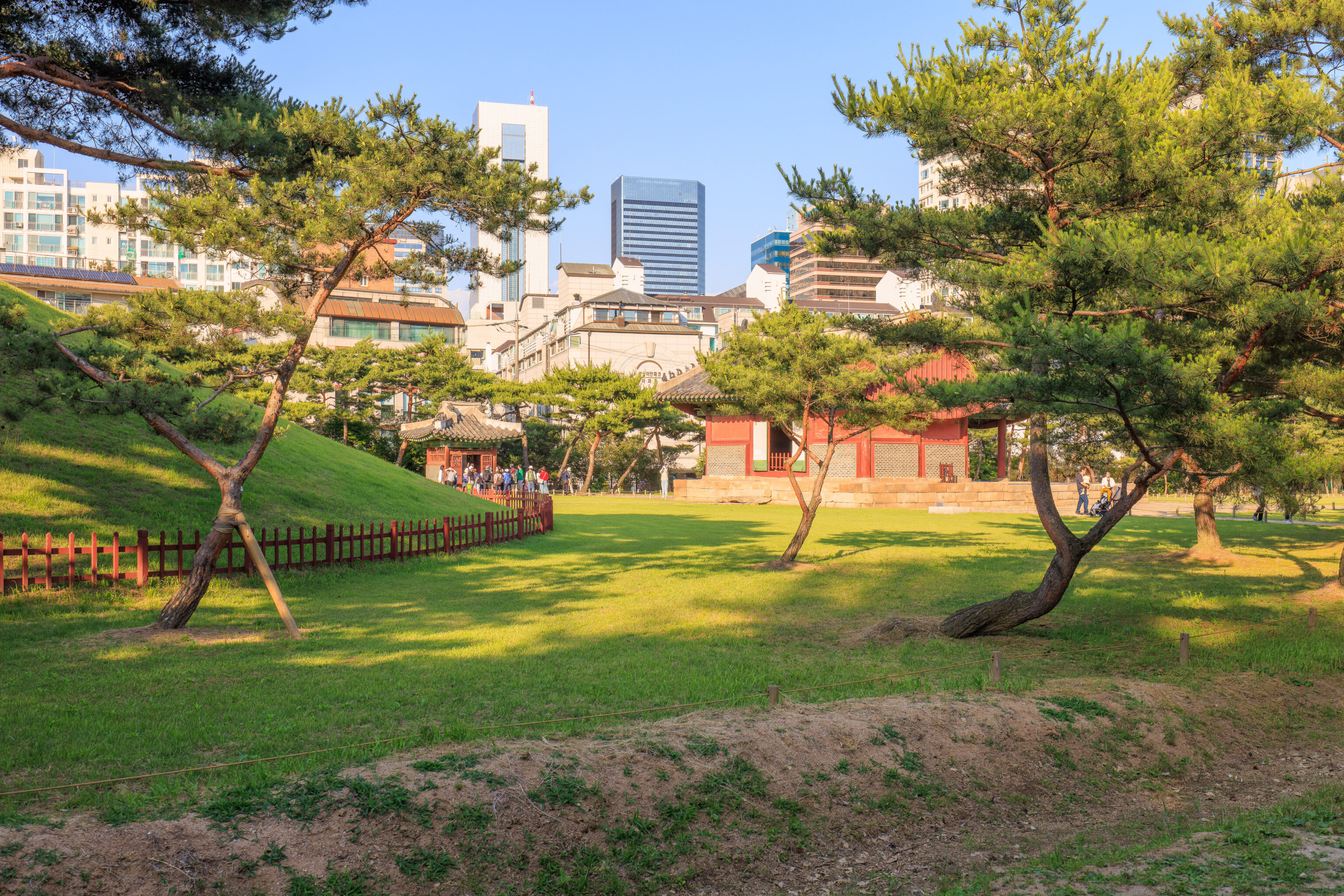
We eventually saw the 정릉 Jeongneung, the tomb of King 중종 Jungjong, on our left.
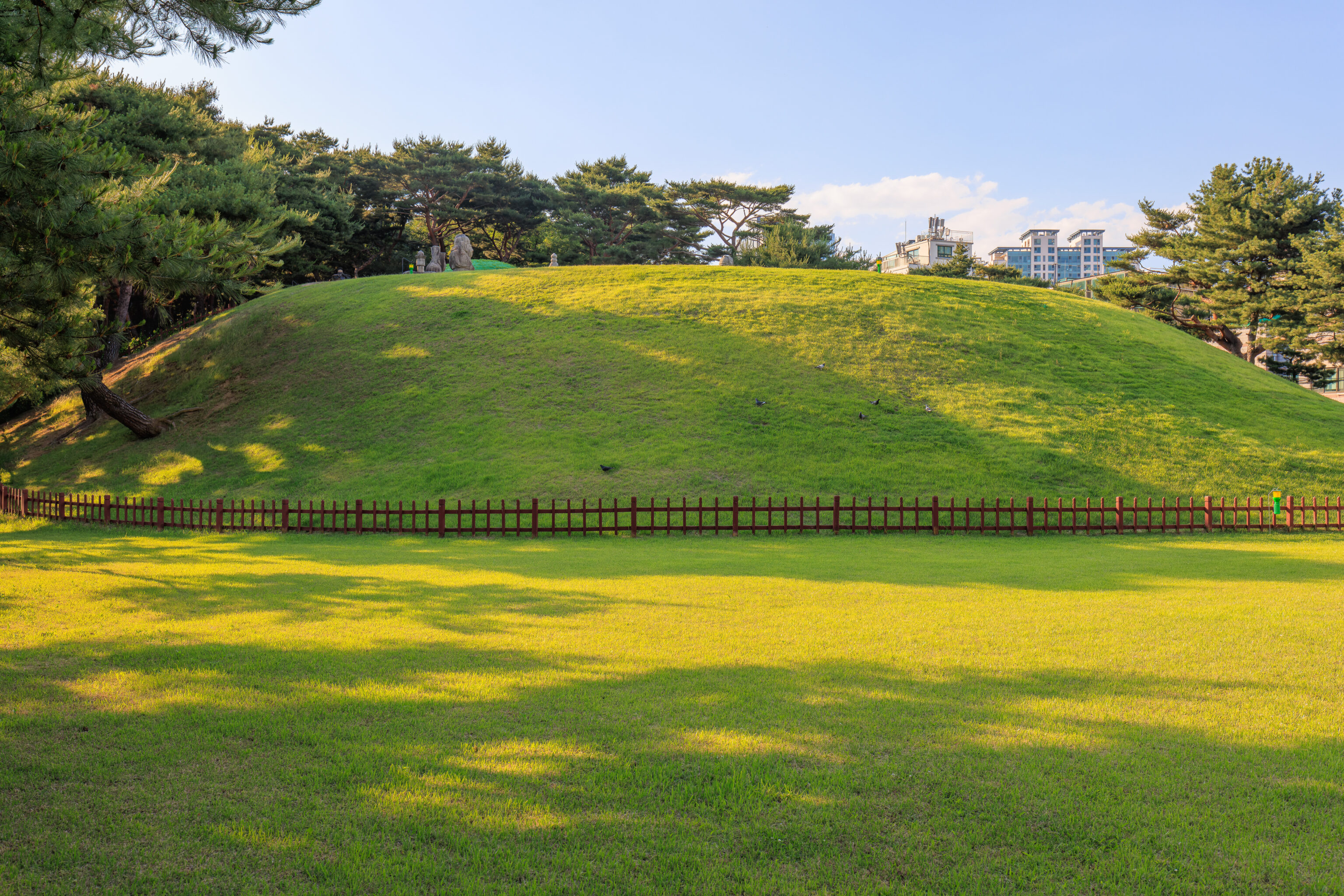
There didn’t seem to be any way to go up onto the burial hill.
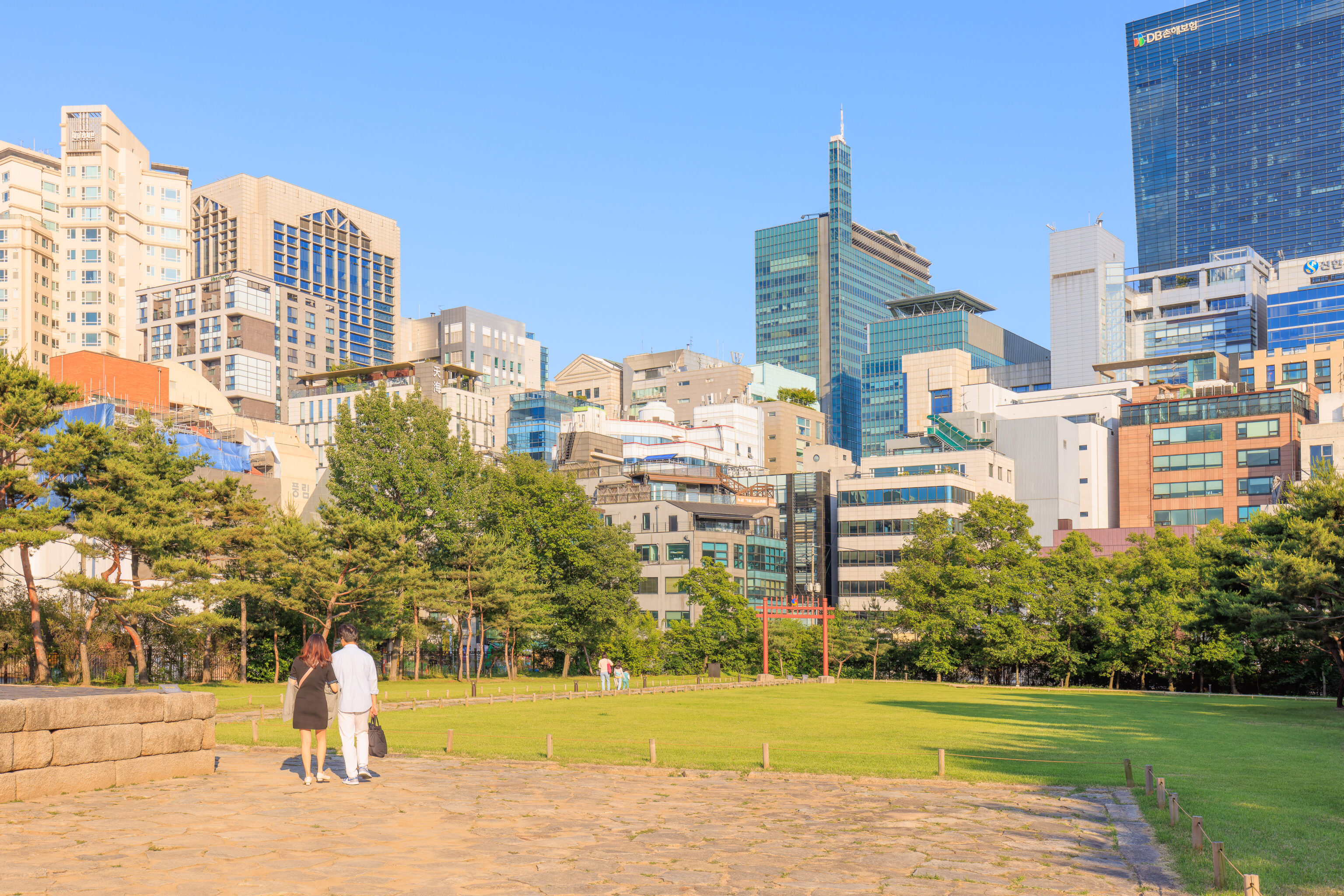
The layout is similar to the Seolleung. We headed to the middle to the T-Shaped Shrine. From here, we could see the Red Arrow Gate. The paper map suggests the royal tomb layouts are more or less standard.
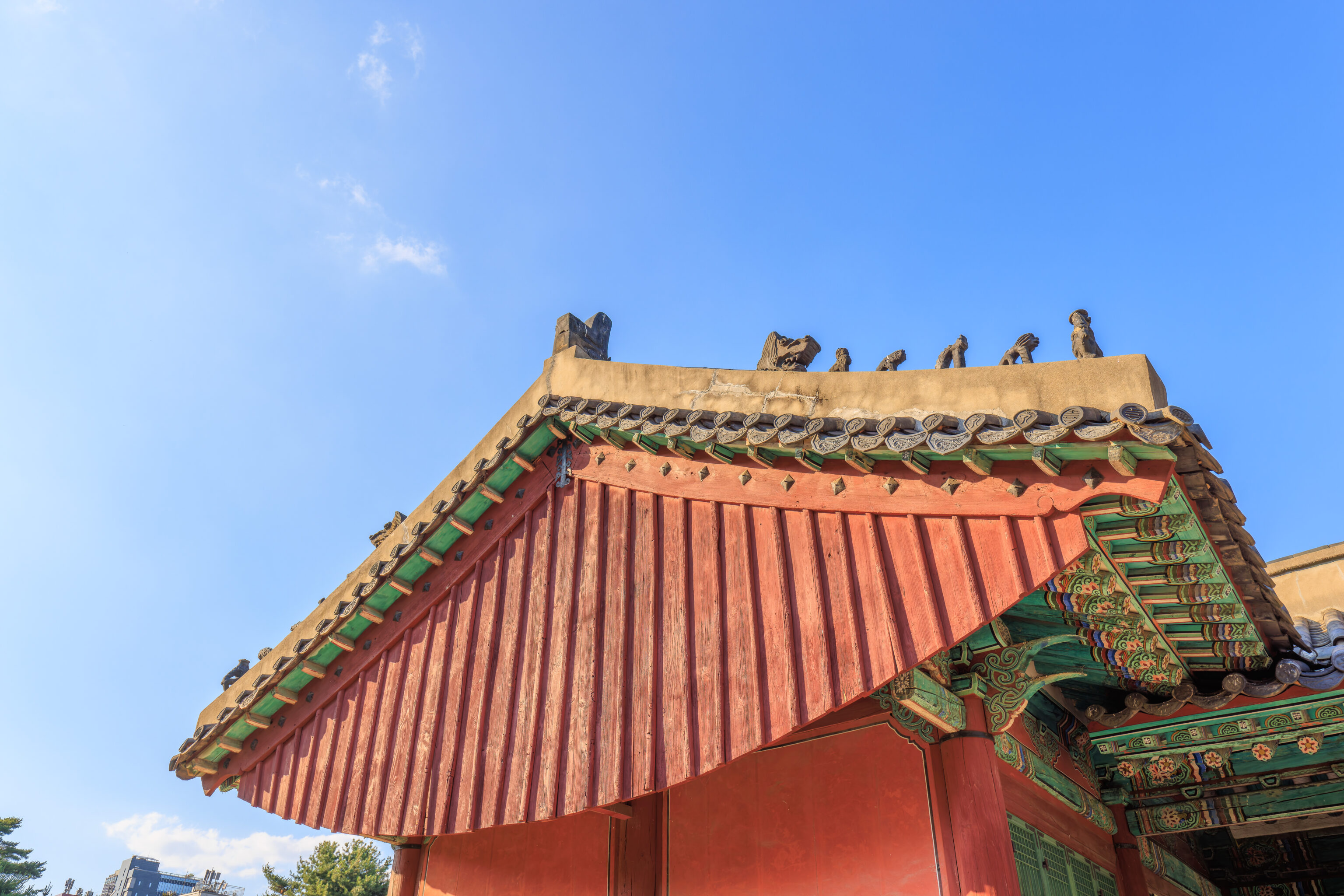
The roof of the T-Shaped Shrine has five 잡상 Japsang.
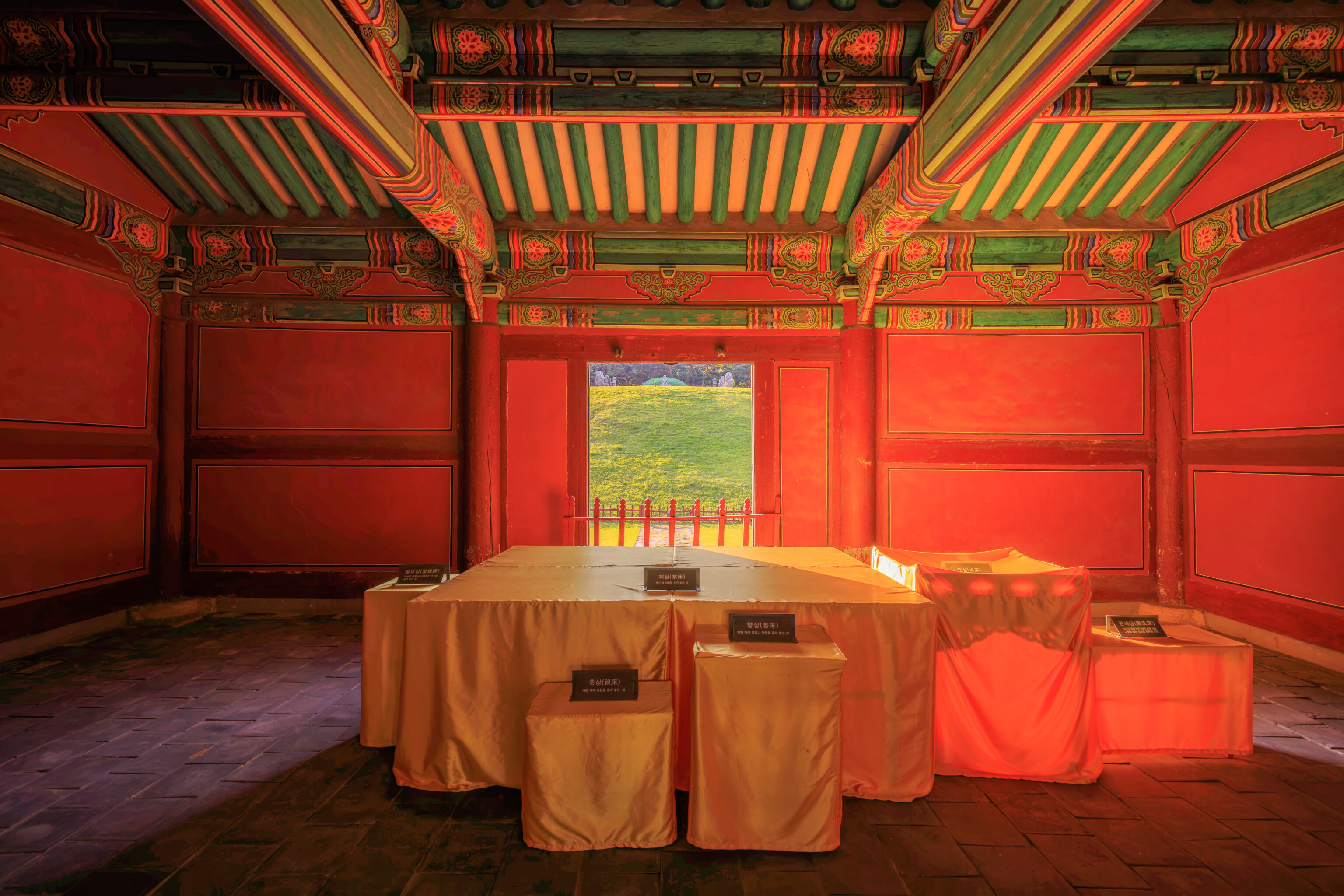
The inside of this T-Shaped Shrine is very similar to the other one.
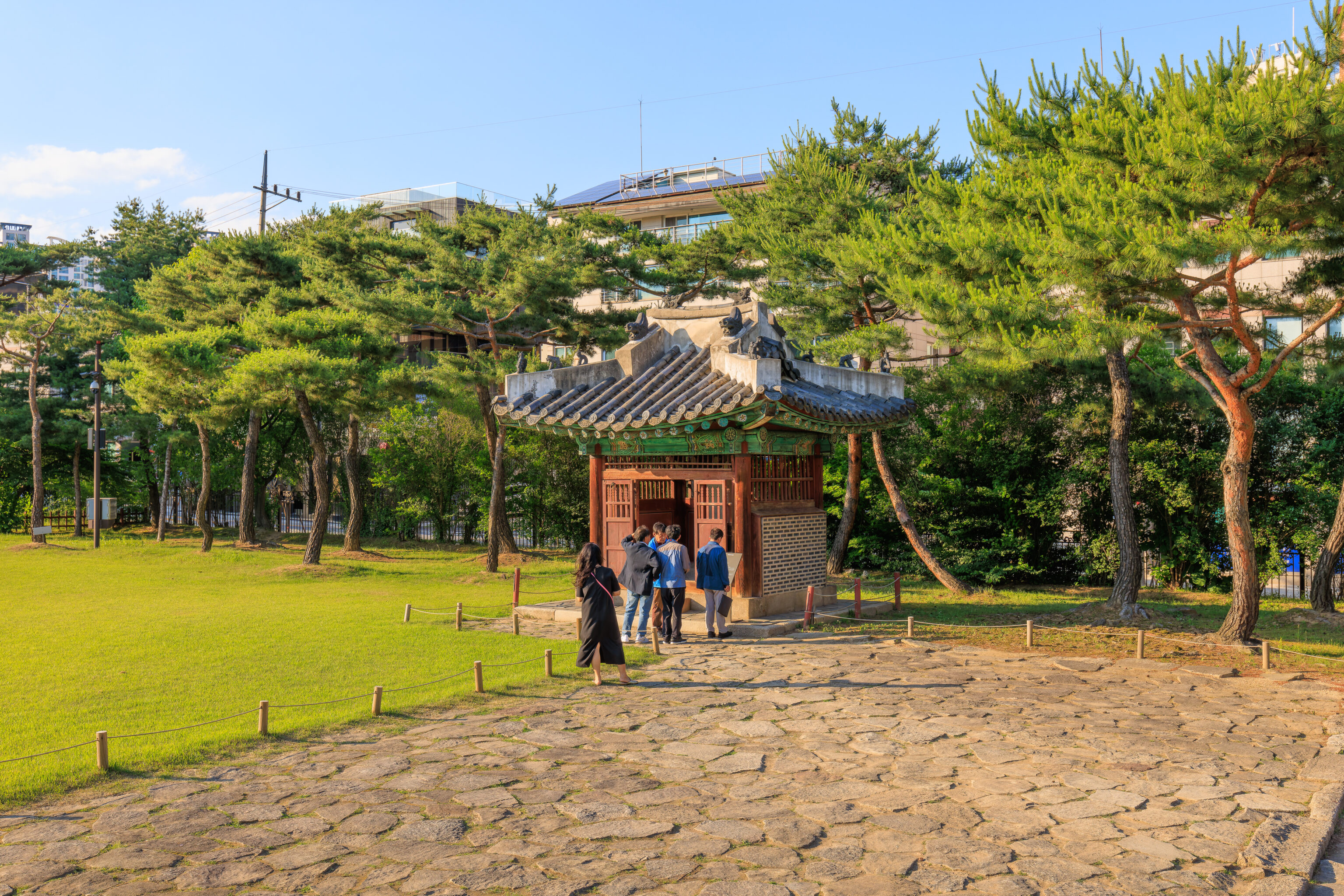
The Stela Shed was much less busy though!
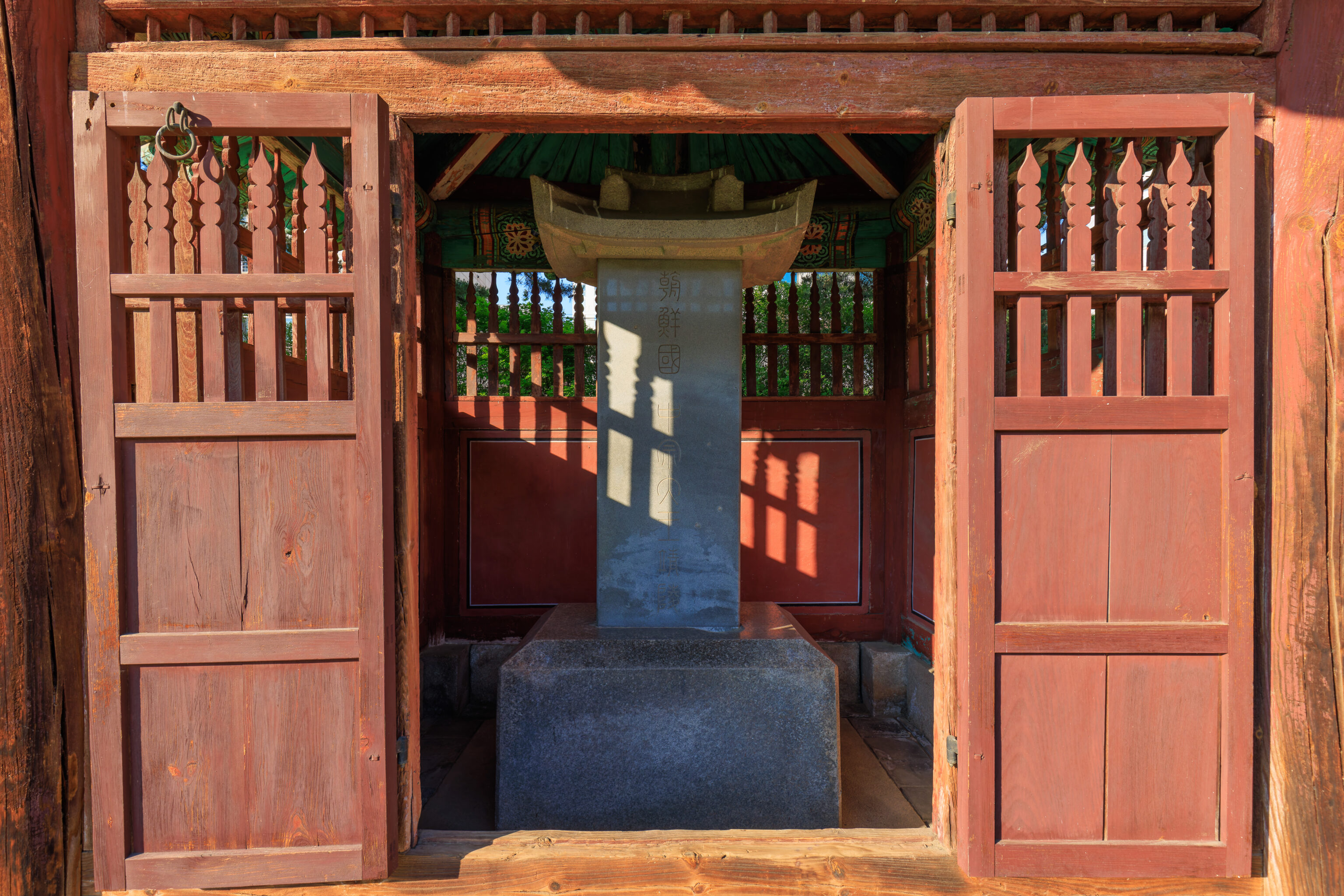
We were able to go take a look at the stela inside.
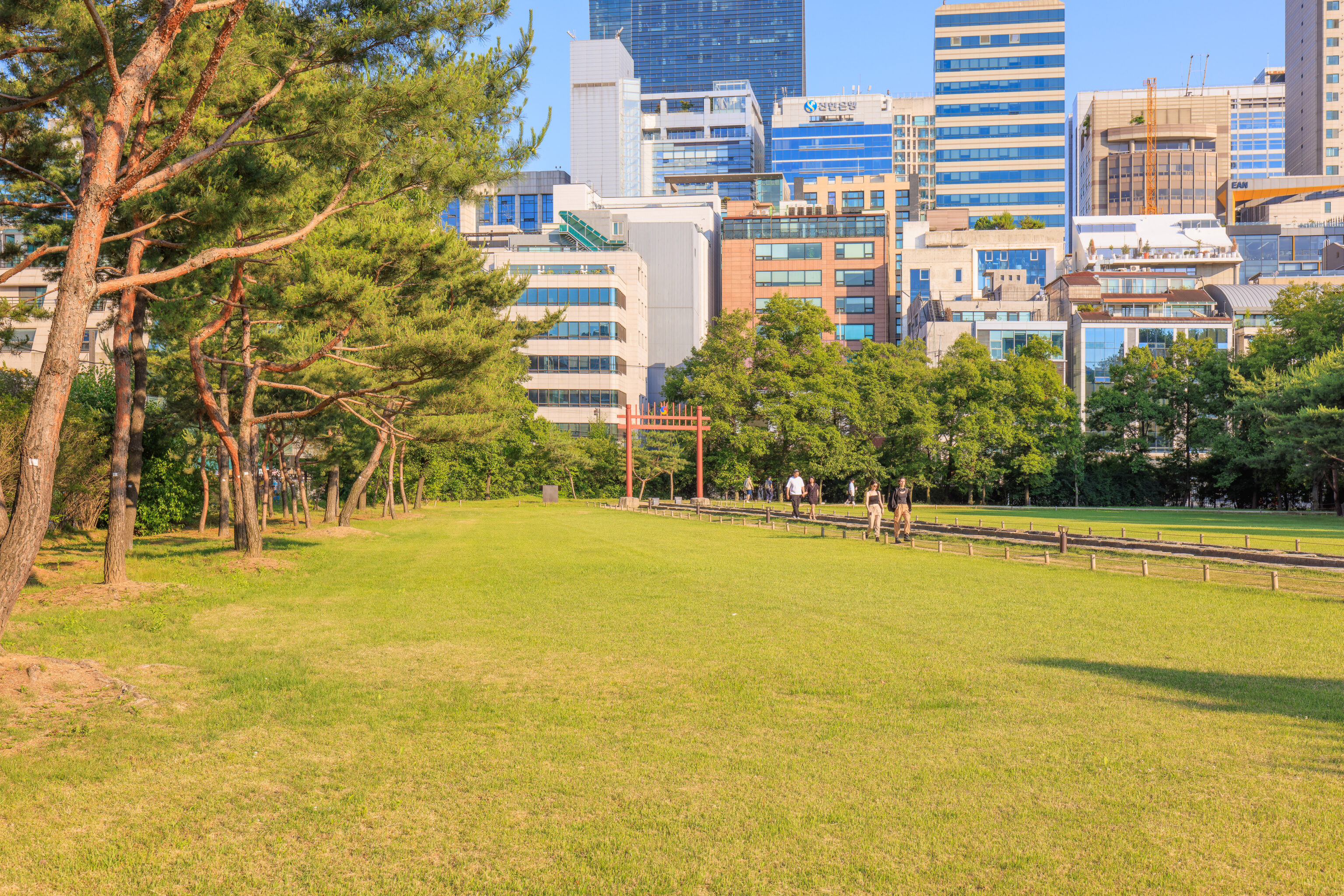
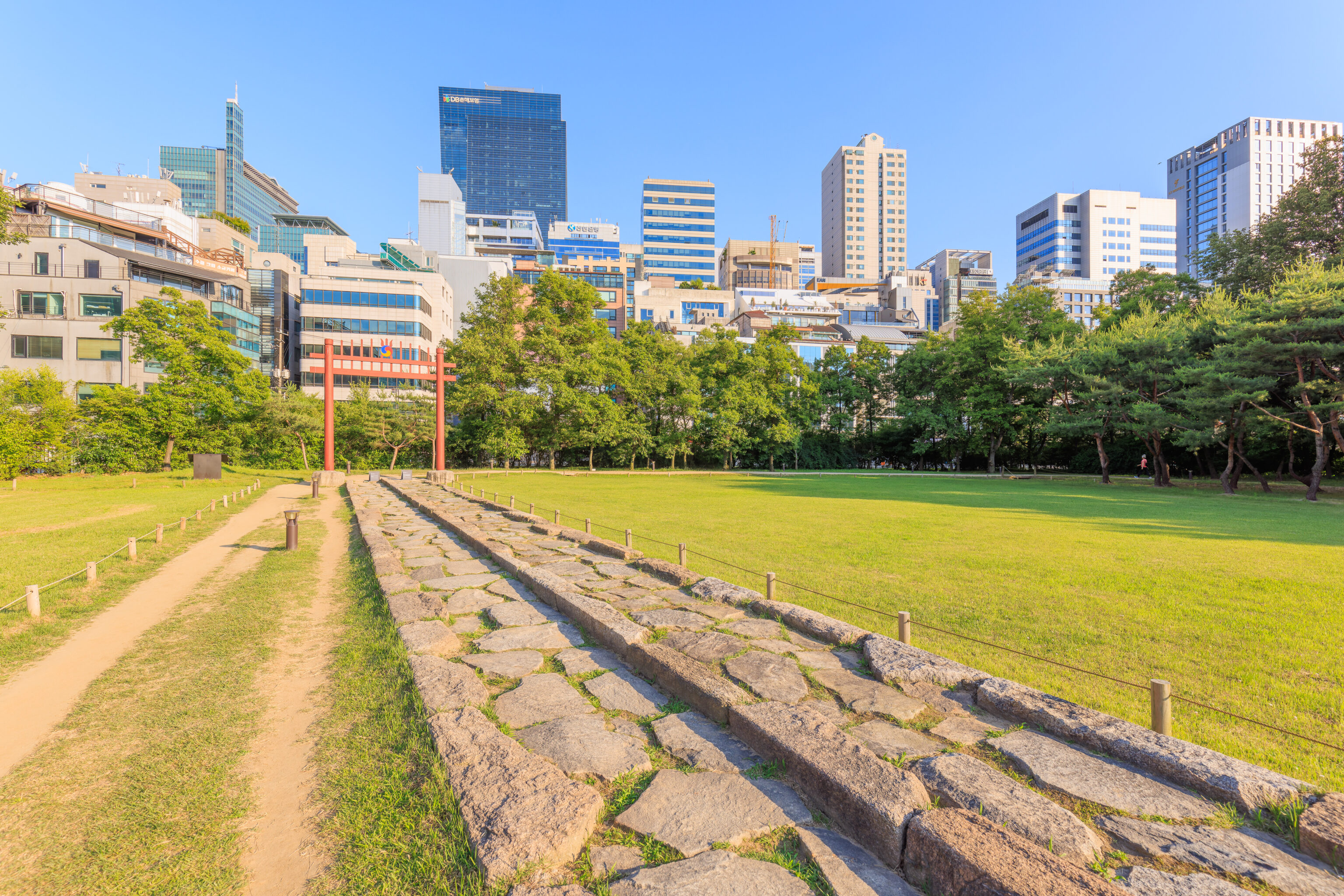
We followed the path to head to the Red Arrow Gate, at the southeast corner of the modern-day tomb grounds.
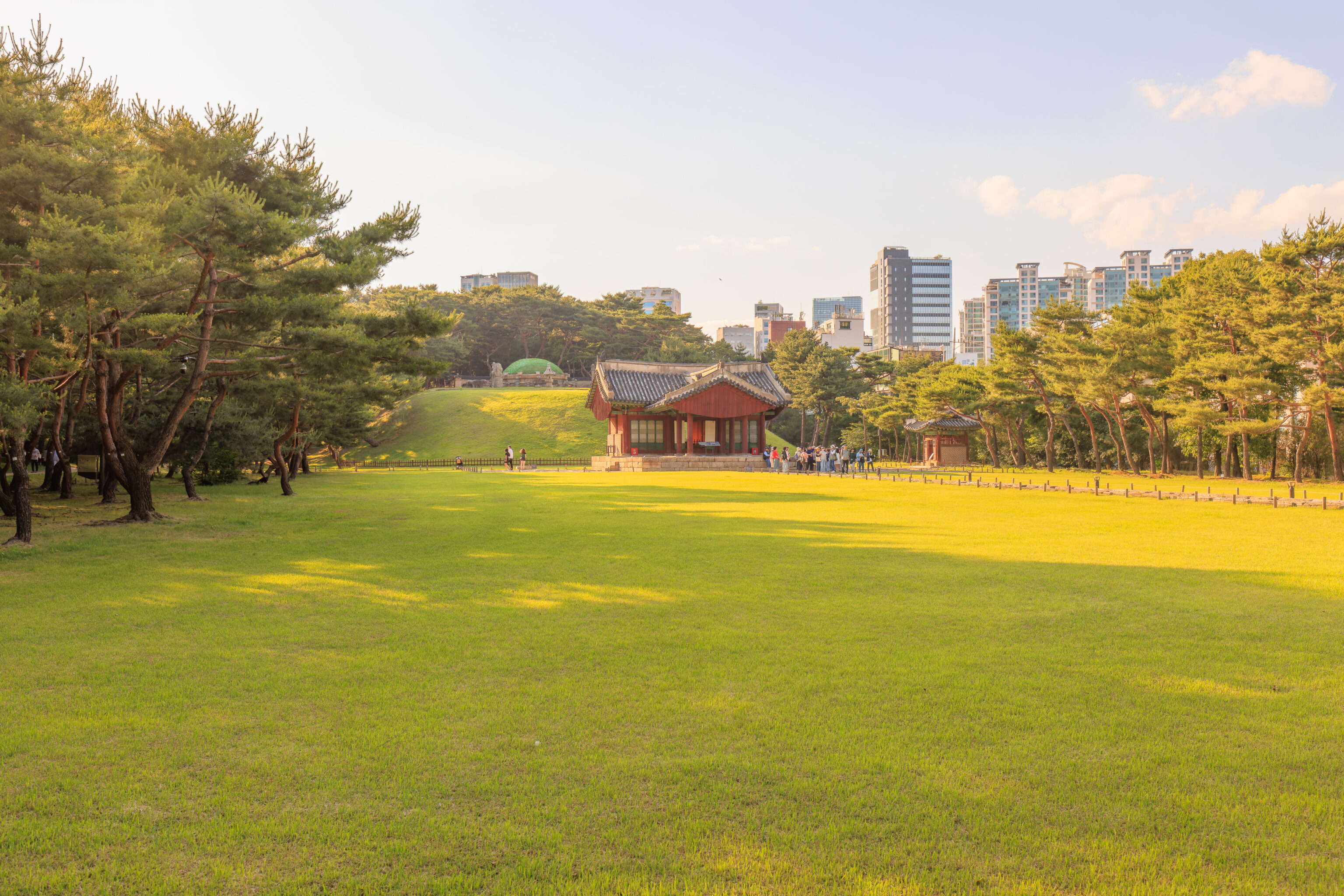
Looking back, we could see the burial mound. It seems to possibly be covered in green protective netting or something similar.
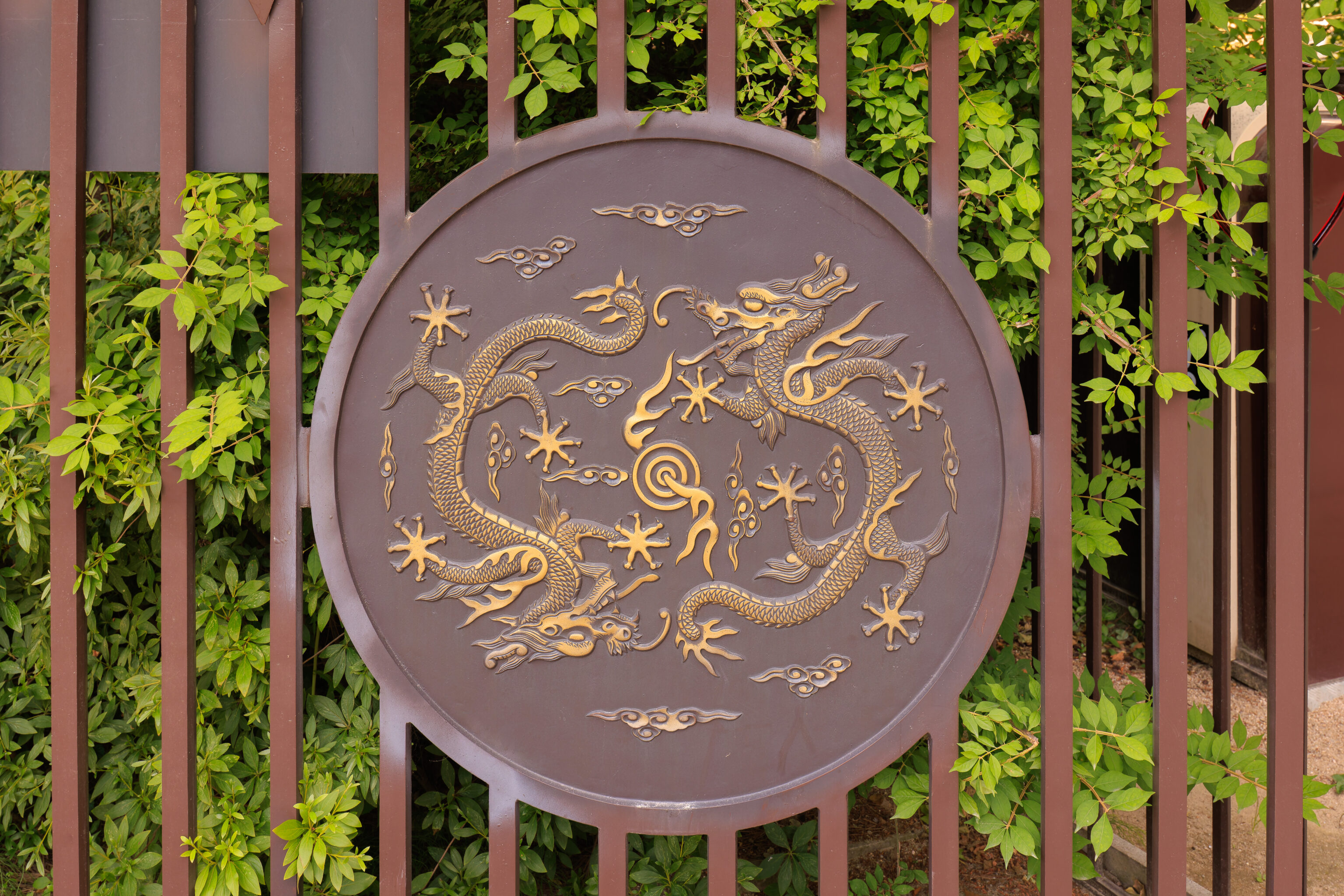
We headed back to the entrance to return to the COEX.
Starfield Library
We wanted to visit the Starfield Library, part of the Starfield COEX Mall. The library is on the south side of the mall. We were approaching above-ground from the west. We had no idea where the best entrance was. We ended up going into a building that served as a bus terminal for the airports before the pandemic. It seems to be mostly closed now but we did find a passageway that led right to the Starfield Library!
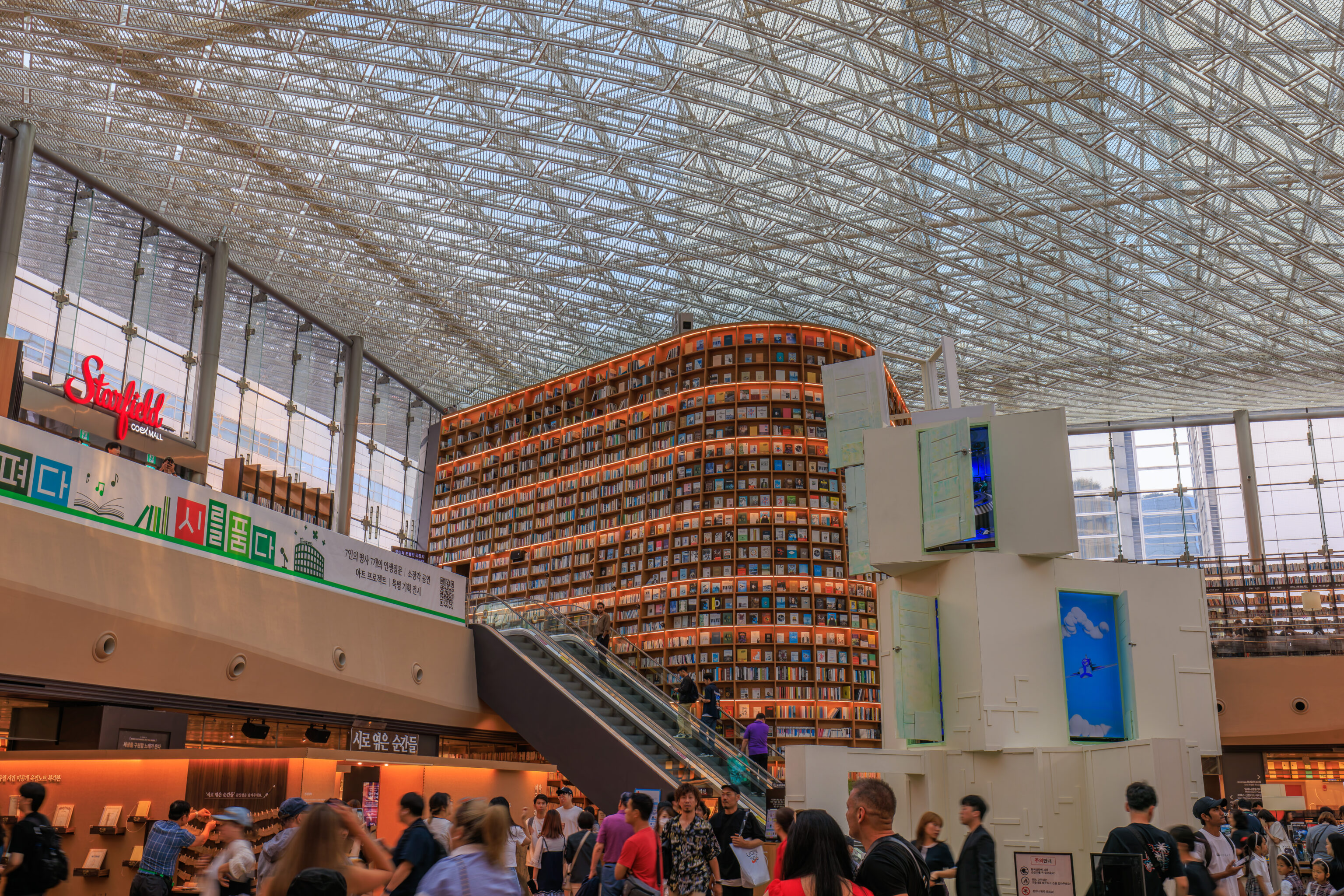
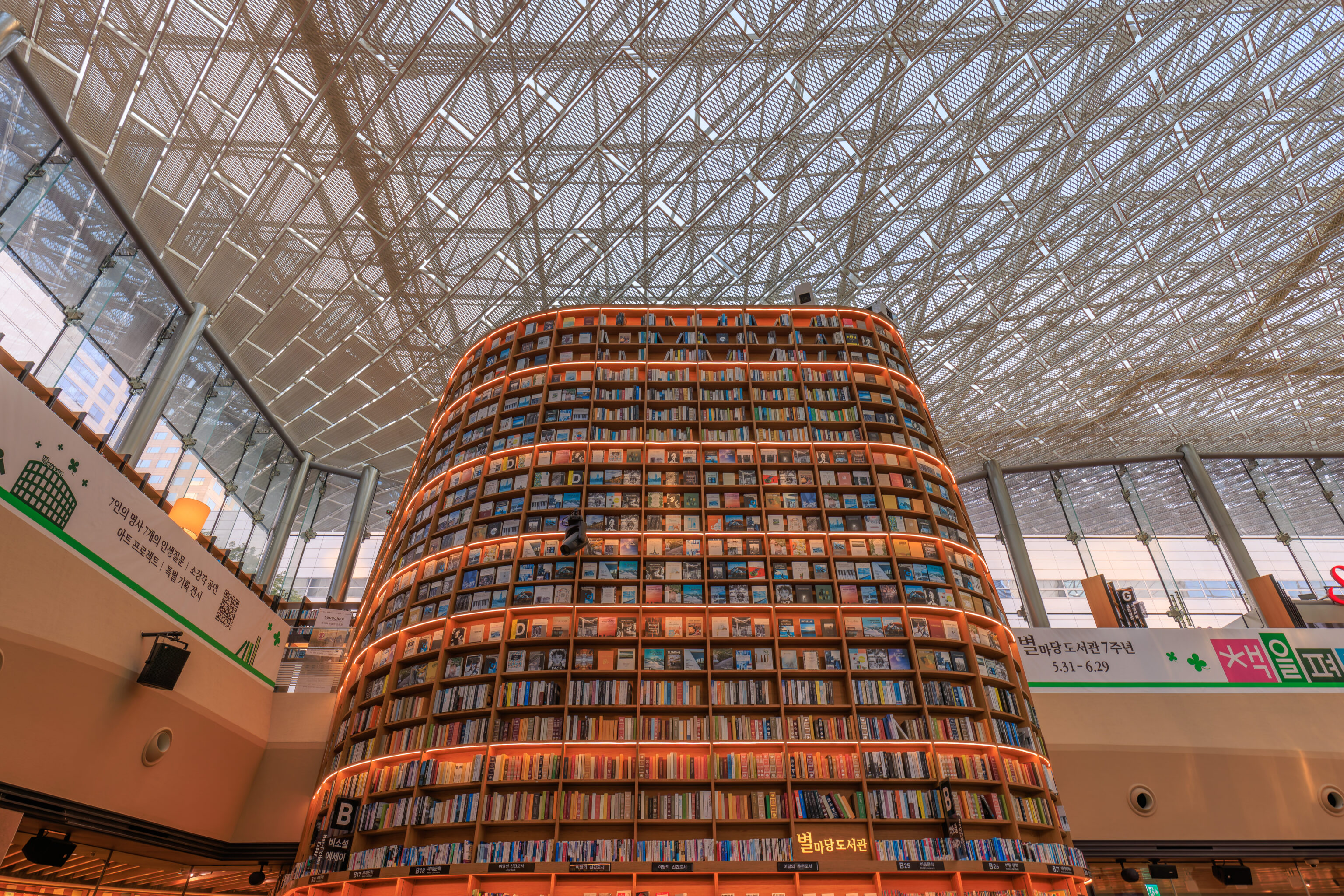
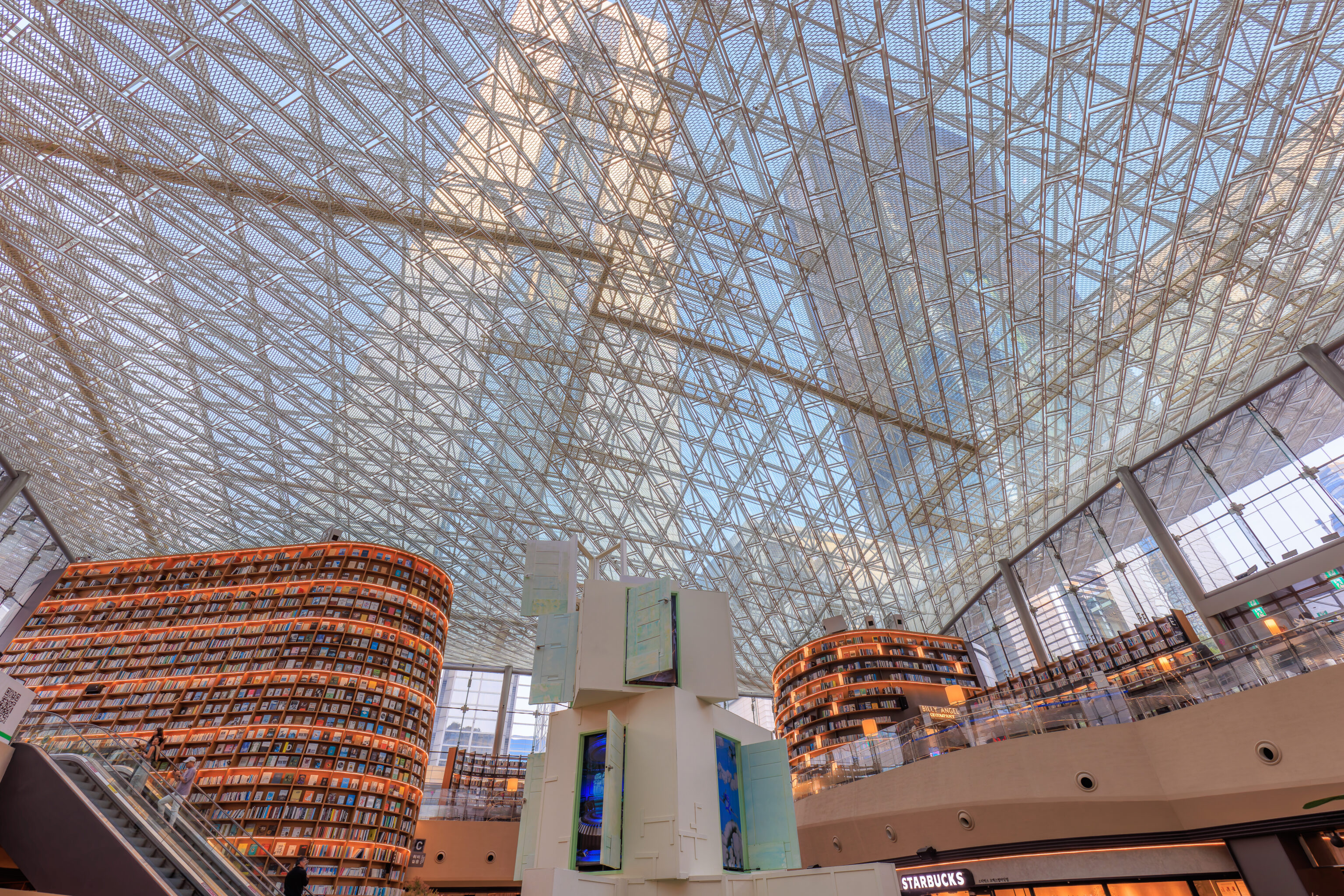
The Starfield Library has a collection of books in an open atrium. It is free to sit down and read any of the books that are available, although it isn’t clear how to access books that are out of reach. It seems to be a library in the sense that it is a collection of books but does not seem to be a lending library where one can borrow books.
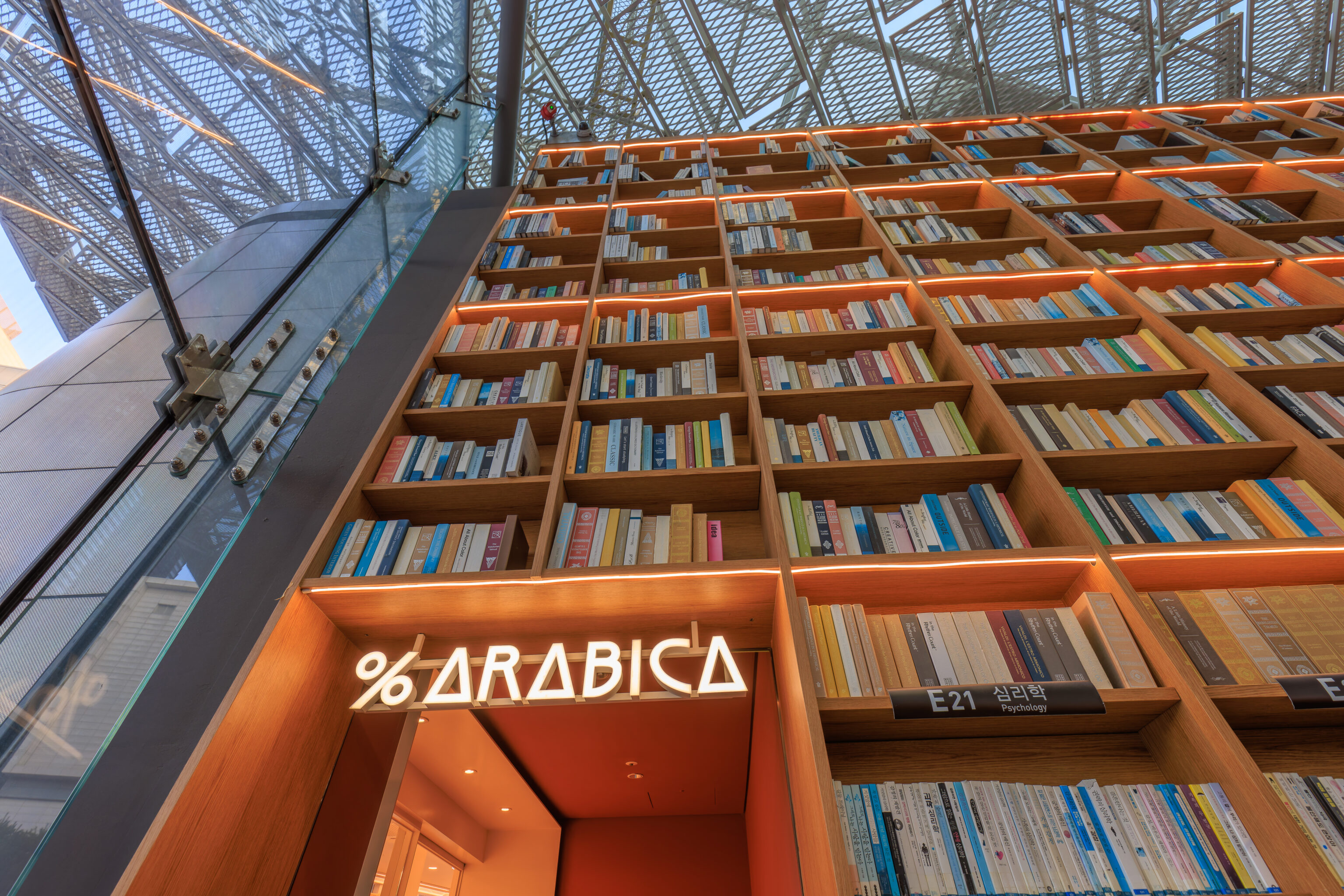
We were a bit surprised to find a % ARABICA (technically, ΔRΔBICΔ) in the library. Our initial exposure to this coffee shop was last year at Arashiyama, Kyoto, Japan. At the end of the day, we walked by a huge queue in front of a tiny coffee shop, % ARABICA. Since then, we’ve found out that it is a highly rated coffee shop with quite a few fans. So, we decided to try it out.
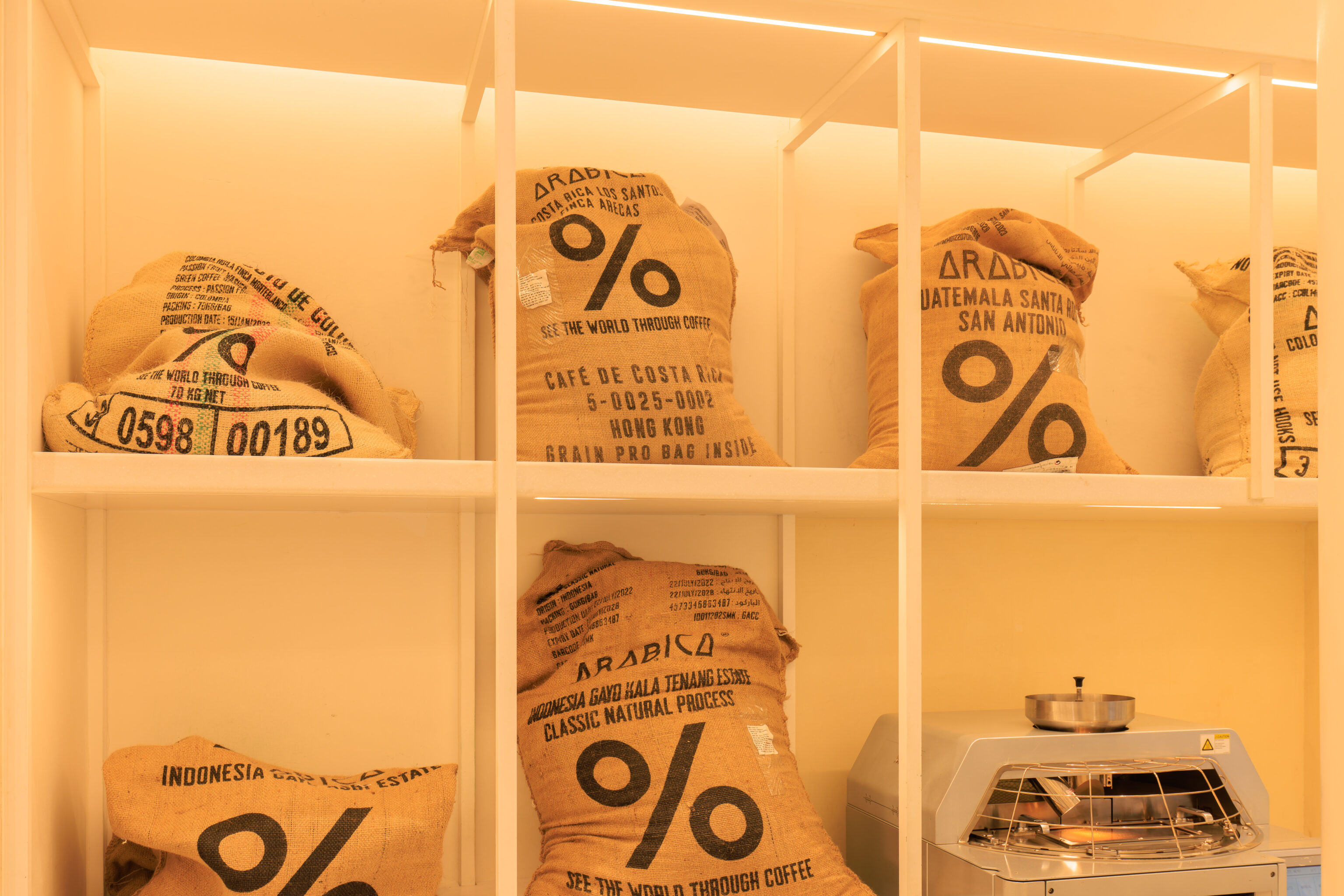
Luckily, it wasn’t busy at all. We ended up getting an ice latte and ice Kyoto latte. It did take a bit of time to get our coffees as while there was no queue, there were orders ahead of us.
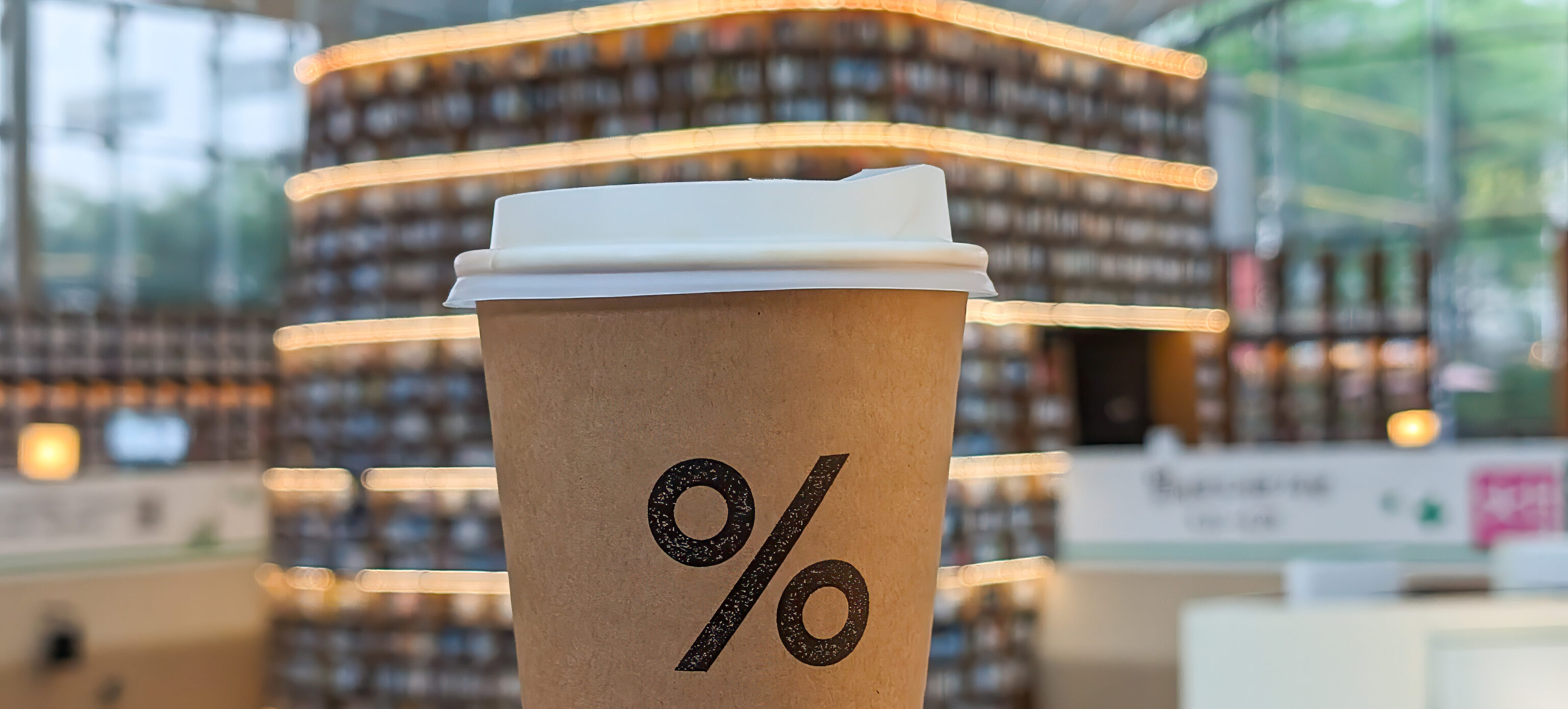
Both were great but one was even better, though we’re not sure which was which! Probably the best coffee we’ve ever had! Does it live up to the hype? It seems so! Though, maybe we just need to visit more boutique coffee shops!
The founder’s story, as described on the coffee shop’s Wikipedia page, is interesting. Kenneth Shoji’s house was destroyed in the Tohoku earthquake and tsunami, the same one that caused the Fukushima nuclear disaster. He moves to Hong Kong and decides to start a coffee business. So, he goes and buys a coffee farm in Hawaii! And then opens his first shop in Hong Kong soon after. The Arashiyama store was the second and is considered to be the flagship store as well as headquarters of the company. The store here is the company’s 125th and was opened two years ago.
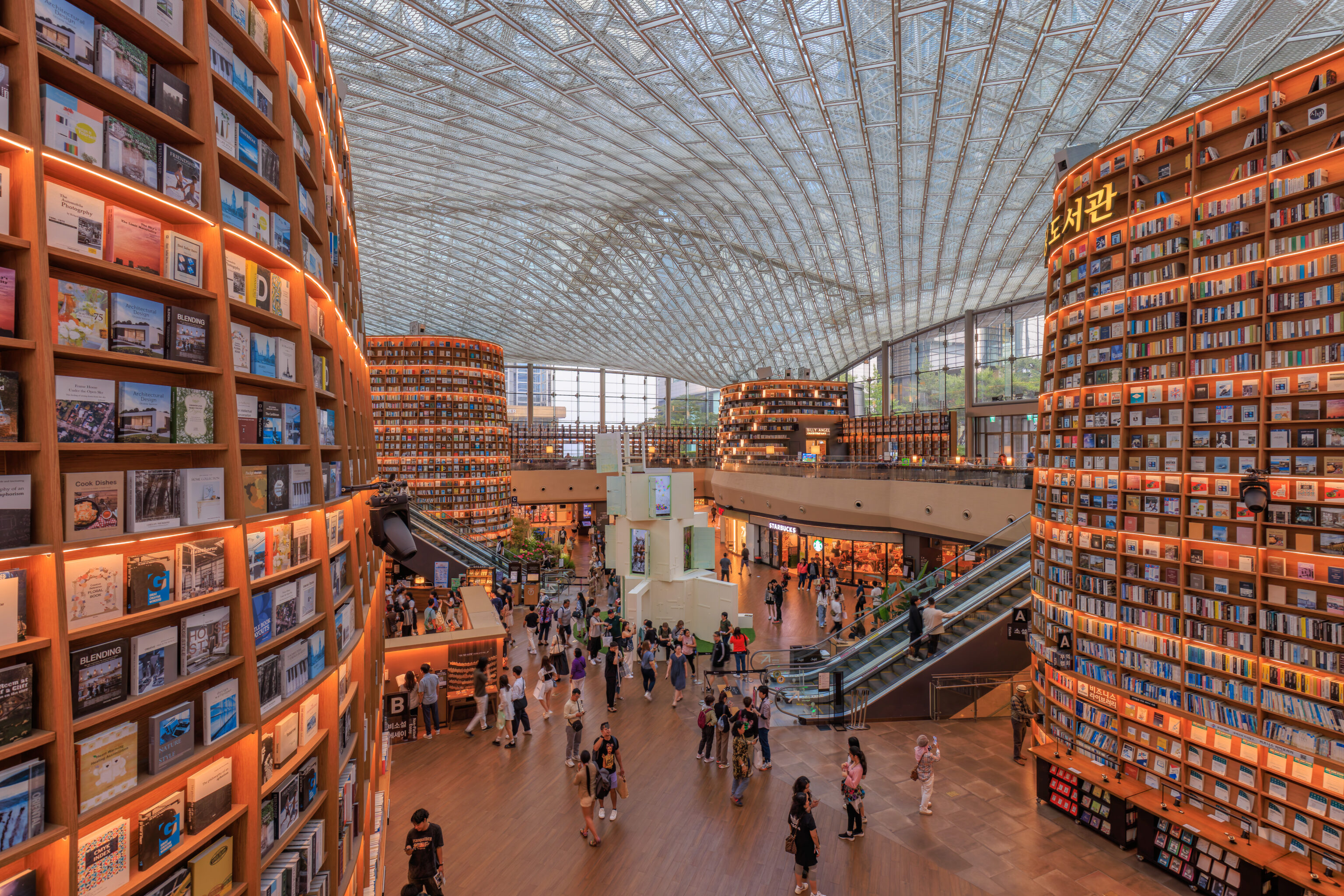
We saw for awhile outside of the coffee shop after finding some seats overlooking the library main floor.
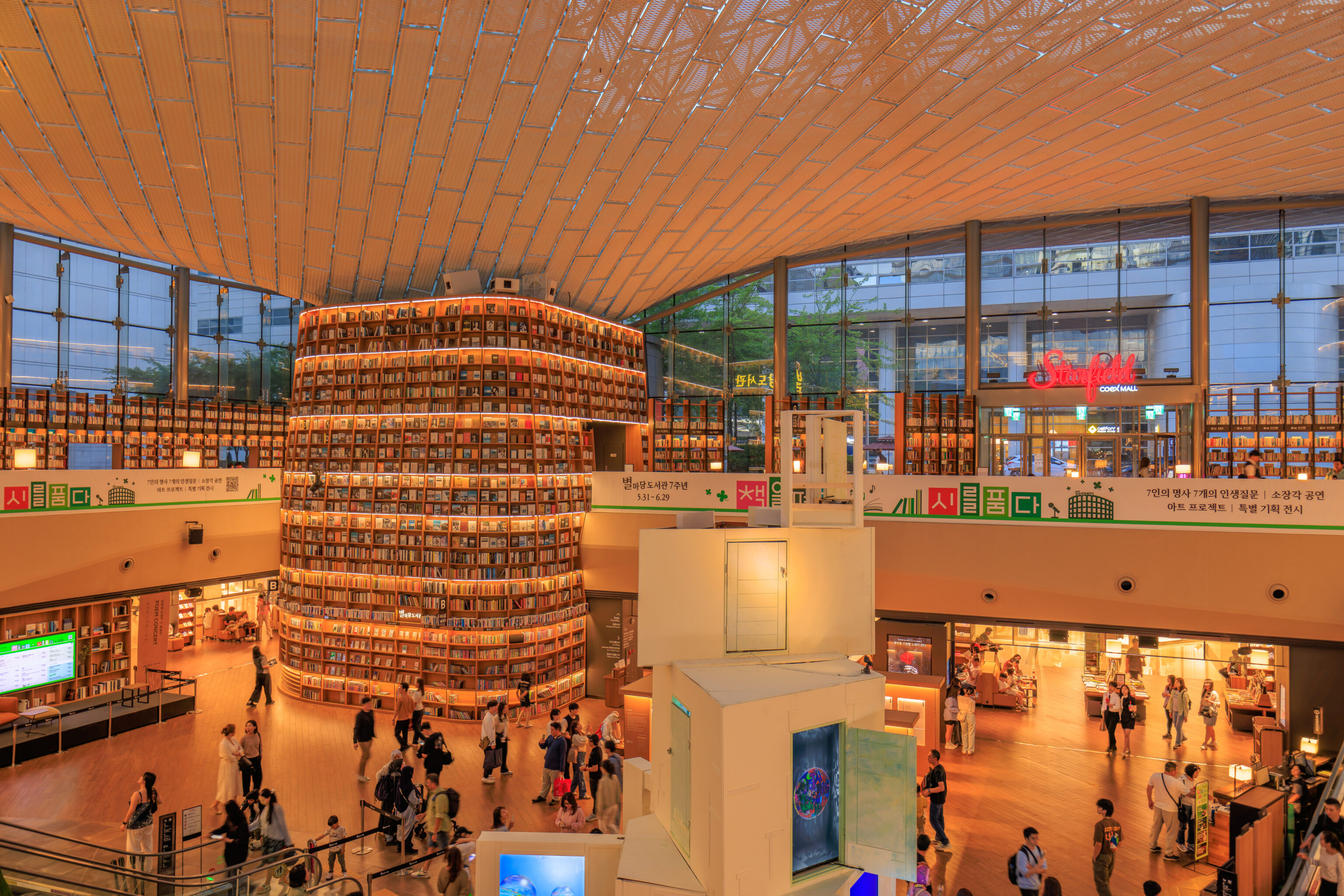
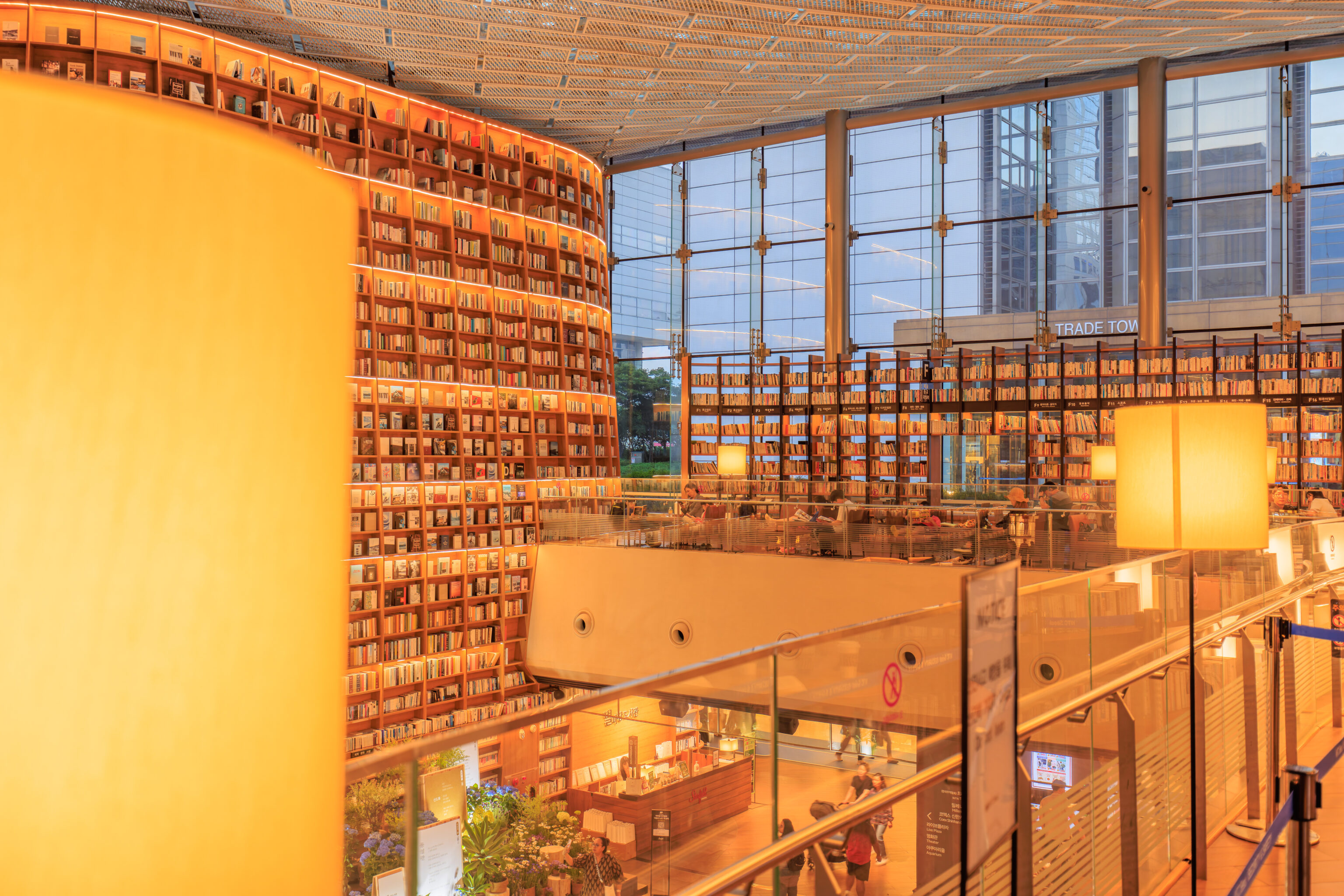
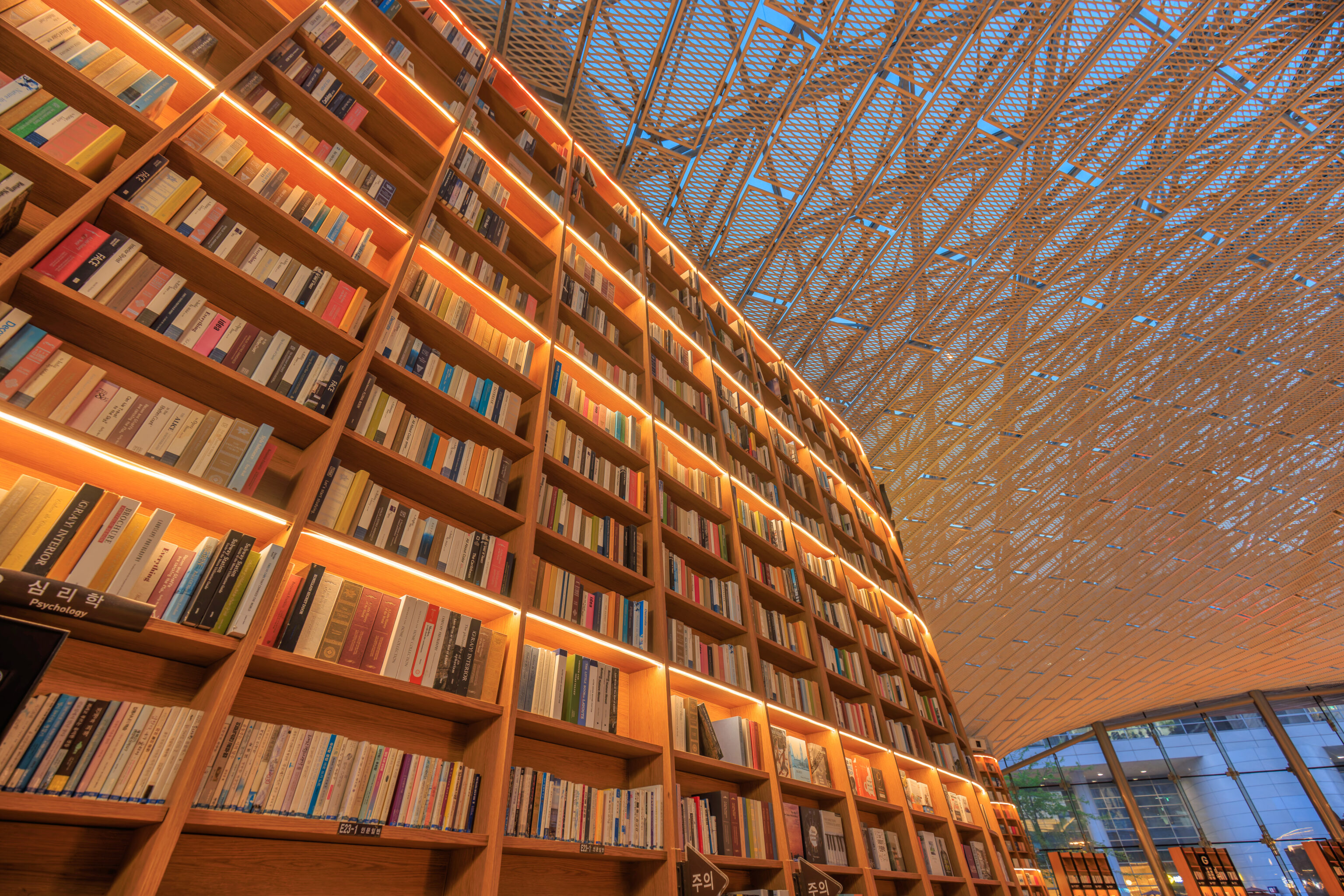
We stayed for awhile as it started to get dark outside. We decided it was time to get dinner. But where? We ultimately chose to return to Hongdae.
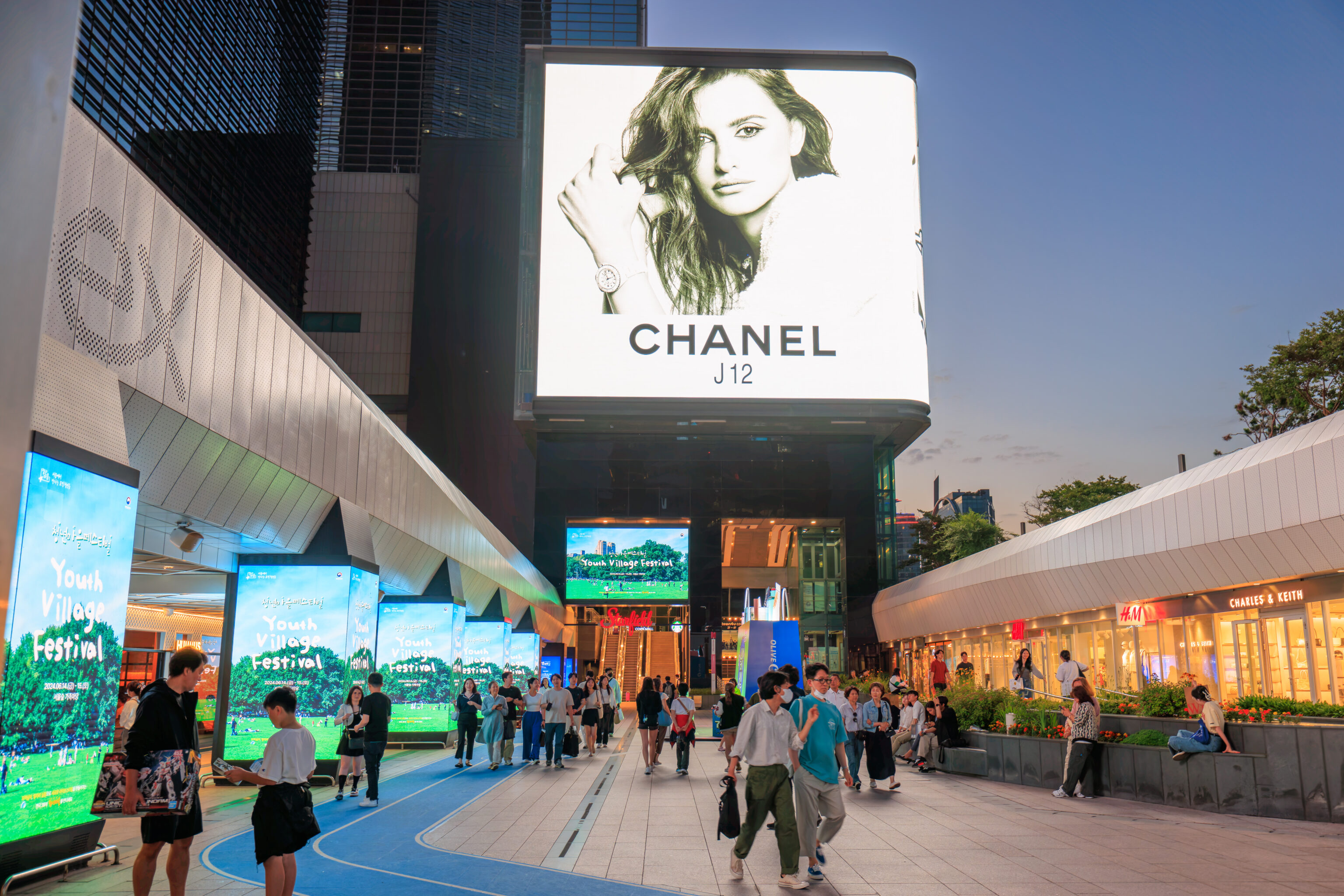
We made our way back to the Samseong subway station. It was much busier here now at 8pm than it was earlier around 11am!
Hongdae
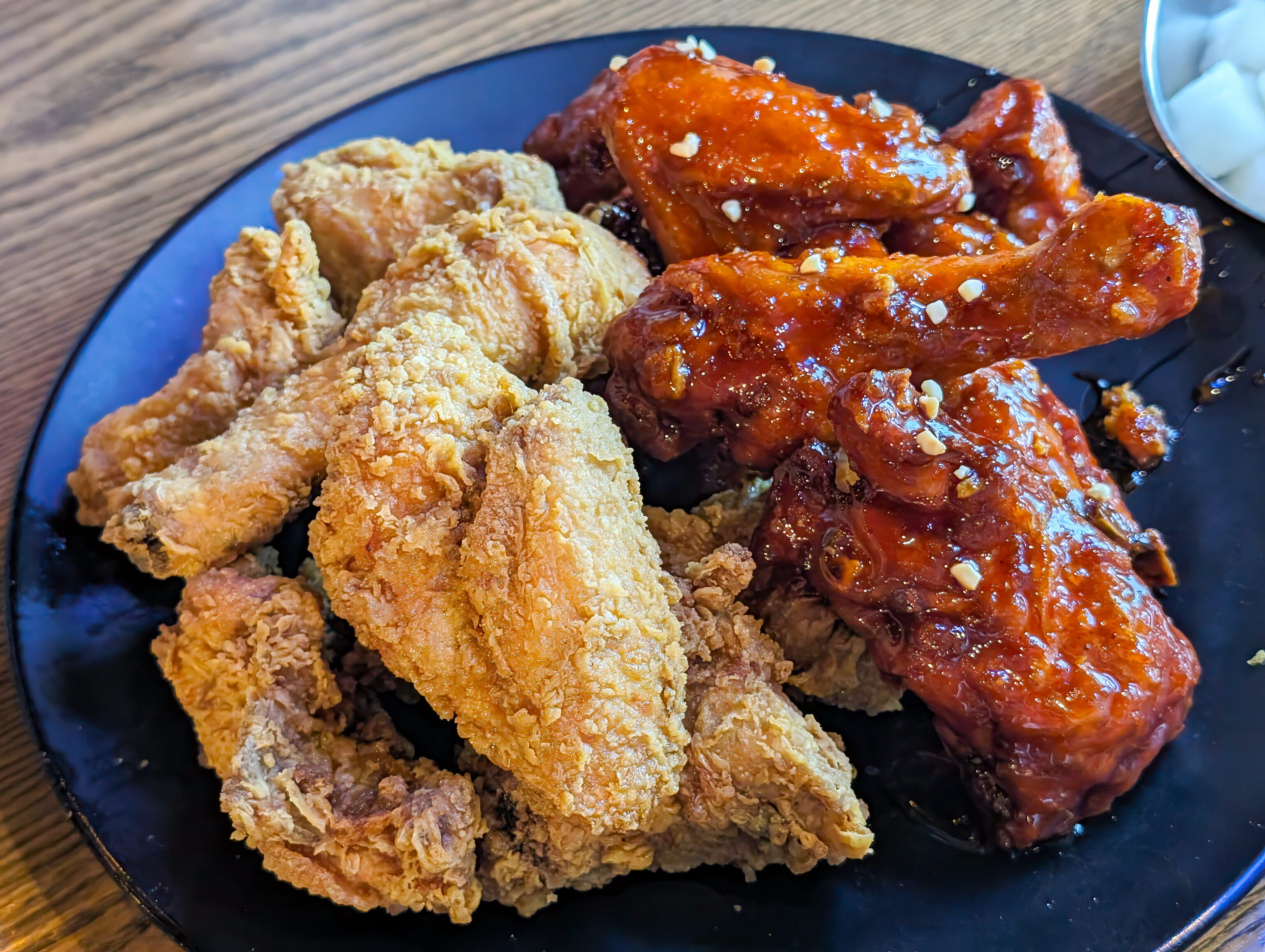
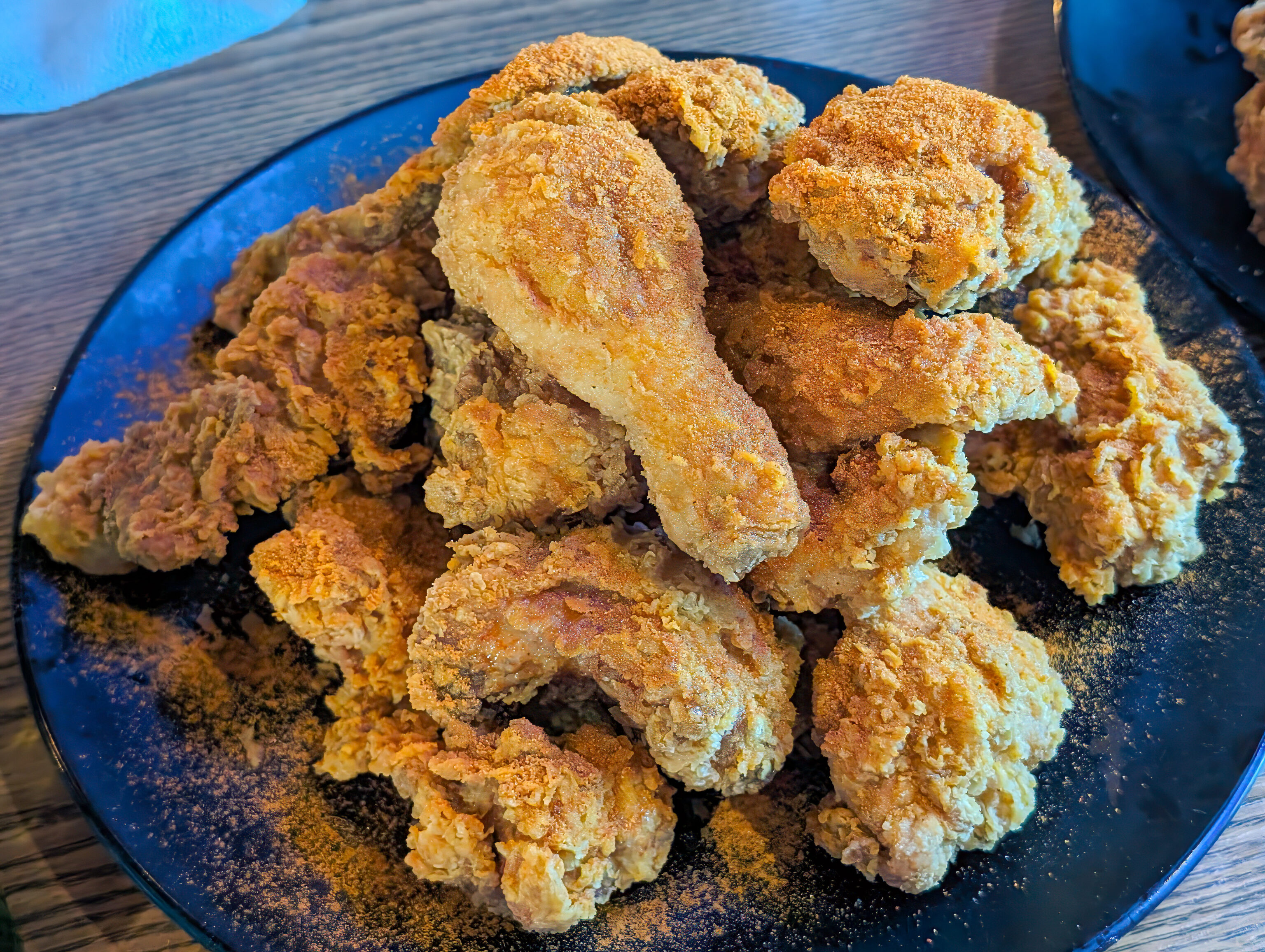
We decided to have dinner at the BBQ Chicken & Beer location near the Hongdae subway station. BBQ Chicken & Beer is a Korean fried chicken chain that we were first familiar with from K-Drama advertising. They do have locations in the US, including in Maryland and Virginia where we live. We found that their sauces were all too sweet, however, we were definitely curious as to what the original Korean locations are like.
The restaurant was actually full when we arrived. We talked to one of the staff and decided to possibly go somewhere else. But then, she came out and got us as a table had opened up!
The chicken here is definitely better than in the US restaurants! We tried a variety of flavors. The one with sauce was thankfully not too sweet at all. So far, the 3 Korean fried chicken restaurants we’ve tried have all been good and definitely had differences in their product. The dry fried chicken here seemed to be the most similar to American fried chicken but well made.
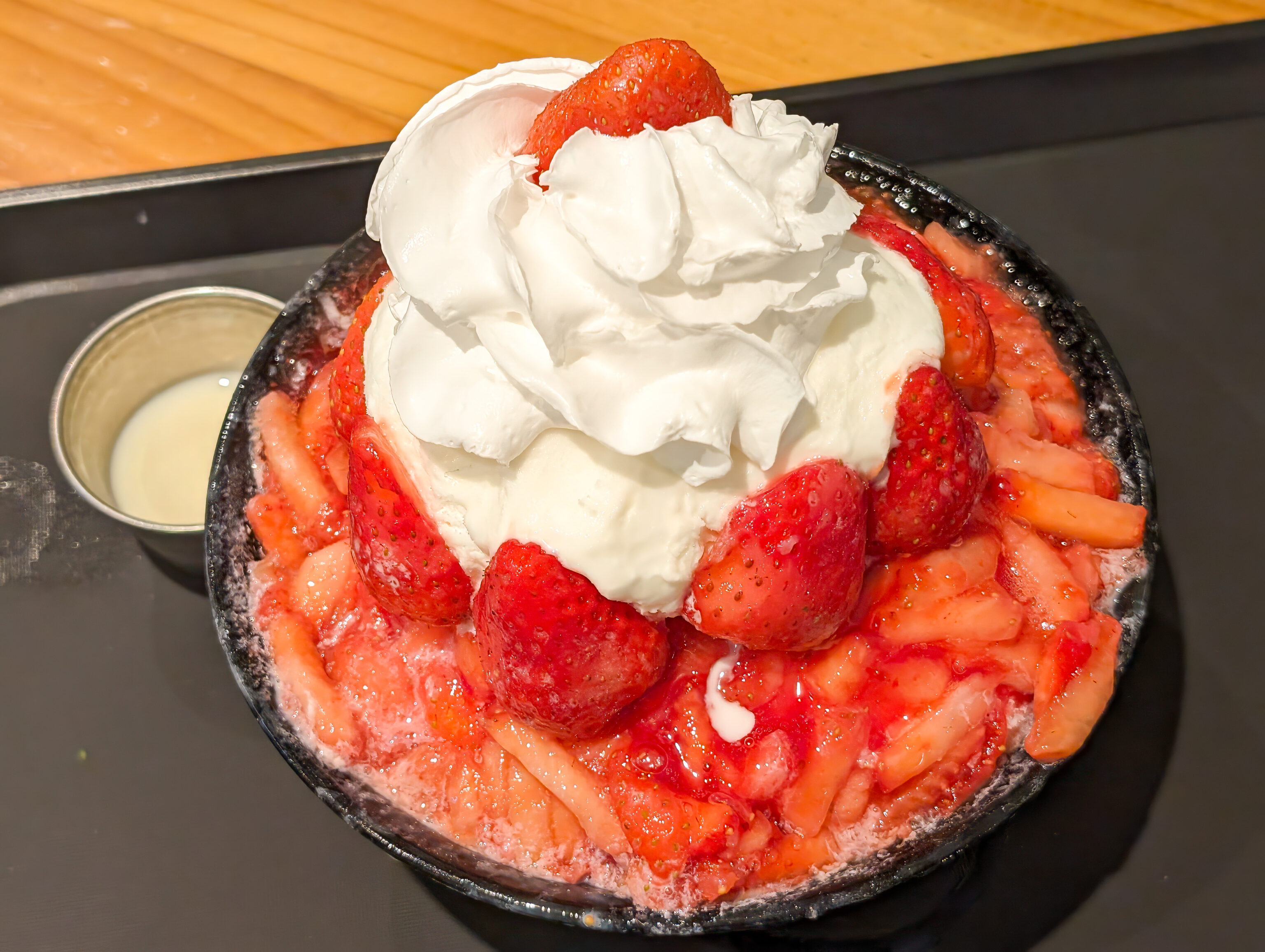
We ended our late evening with bingsoo at Sulbing in Hongdae! This time, we had strawberry and frozen yogurt. An excellent way to end an excellent day!
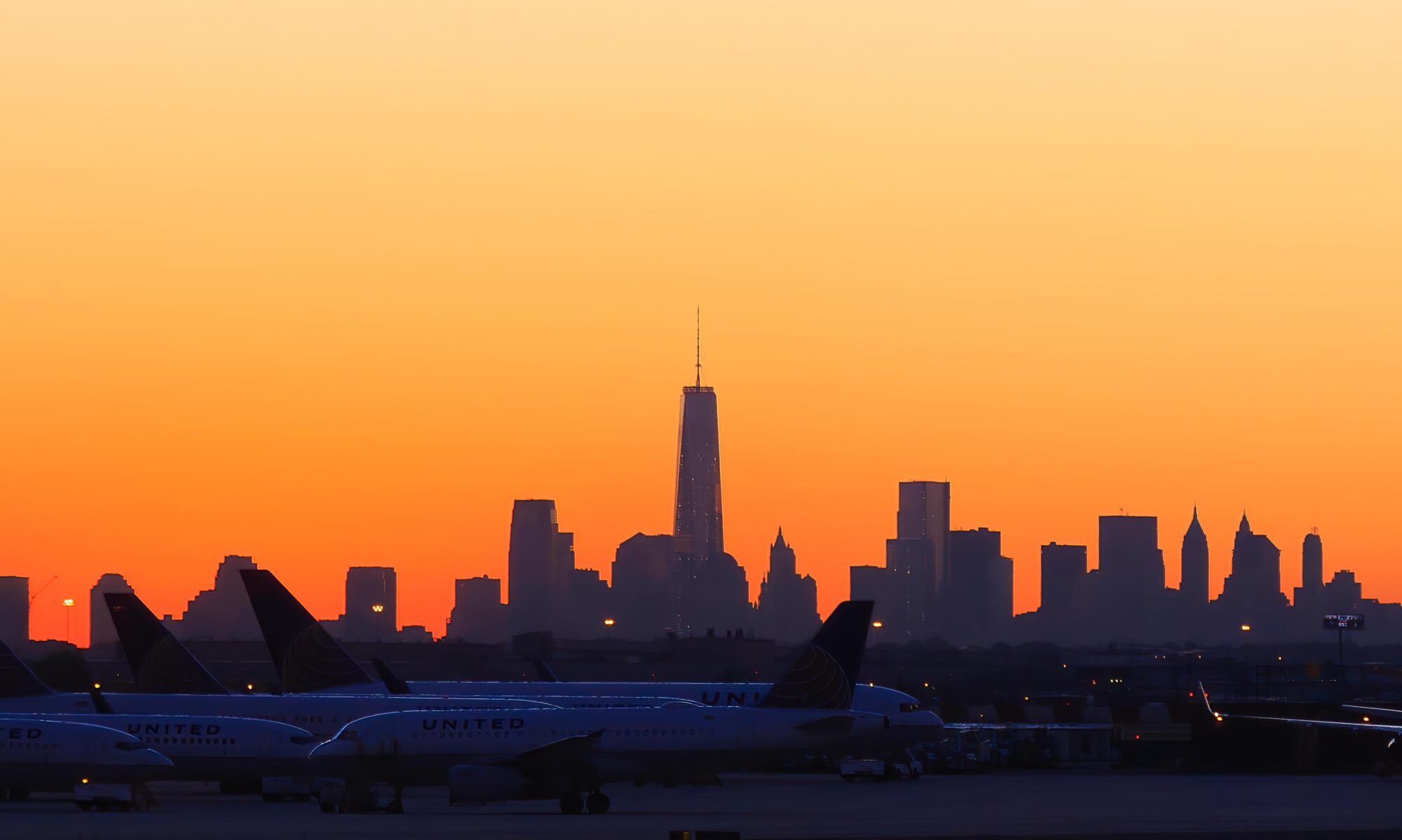
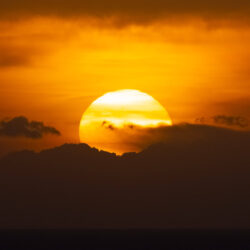
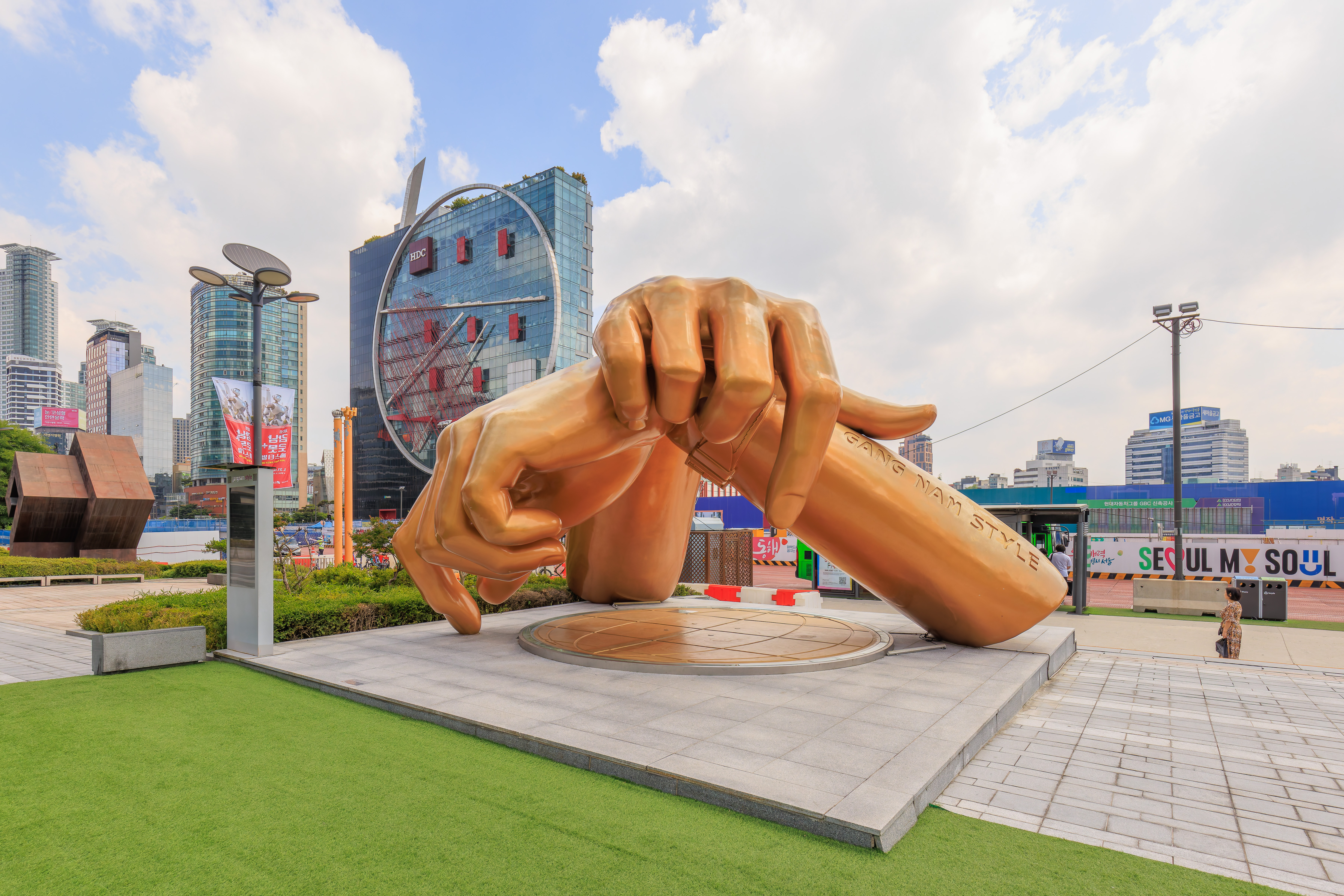
One Reply to “Gangnam Style”